Filed Pursuant to Rule 424(b)(3)
Registration Number 333-179658
PROSPECTUS SUPPLEMENT NO. 1
to Prospectus dated
April 20, 2012
(Registration No. 333-179658)
UNIFIED GROCERS, INC.
This Prospectus Supplement No. 1 supplements our Prospectus dated April 20, 2012. The securities that are the subject of the Prospectus have been registered to permit their sale by us.
This Prospectus Supplement includes the attached Quarterly Report on Form 10-Q for the period ended March 31, 2012 of Unified Grocers, Inc., as filed by us with the Securities and Exchange Commission.
NEITHER THE SECURITIES AND EXCHANGE COMMISSION NOR ANY STATE SECURITIES COMMISSION HAS APPROVED OR DISAPPROVED OF THESE SECURITIES OR PASSED UPON THE ACCURACY OR ADEQUACY OF THIS PROSPECTUS SUPPLEMENT. ANY REPRESENTATION TO THE CONTRARY IS A CRIMINAL OFFENSE.
The date of this Prospectus Supplement is May 18, 2012
UNITED STATES
SECURITIES AND EXCHANGE COMMISSION
Washington, D.C. 20549
FORM 10-Q
(Mark One)
x | | QUARTERLY REPORT PURSUANT TO SECTION 13 OR 15(d) OF THE SECURITIES EXCHANGE ACT OF 1934 |
| | FOR | | THE QUARTERLY PERIOD ENDED MARCH 31, 2012 |
OR
¨ | | TRANSITION REPORT PURSUANT TO SECTION 13 OR 15(d) OF THE SECURITIES EXCHANGE ACT OF 1934 |
| | FOR THE TRANSITION PERIOD FROM TO |
Commission file number: 0-10815
UNIFIED GROCERS, INC.
(Exact name of registrant as specified in its charter)
| | |
| California | | 95-0615250 |
(State or other jurisdiction of incorporation or organization) | | (I.R.S. Employer Identification No.) |
5200 Sheila Street, Commerce, CA 90040
(Address of principal executive offices) (Zip Code)
(323) 264-5200
(Registrant’s telephone number, including area code)
Indicate by check mark whether the registrant (1) has filed all reports required to be filed by Section 13 or 15(d) of the Securities Exchange Act of 1934 during the preceding 12 months (or for such shorter period that the registrant was required to file such reports), and (2) has been subject to such filing requirements for the past 90 days. Yes [X] No [ ]
Indicate by check mark whether the registrant has submitted electronically and posted on its corporate Web site, if any, every Interactive Data File required to be submitted and posted pursuant to Rule 405 of Regulation S-T (§232.405 of this chapter) during the preceding 12 months (or for such shorter period that the registrant was required to submit and post such files). Yes [X] No [ ]
Indicate by check mark whether the registrant is a large accelerated filer, an accelerated filer, a non-accelerated filer or a smaller reporting company. See the definitions of “large accelerated filer,” “accelerated filer” and “smaller reporting company” in Rule 12b-2 of the Exchange Act. (Check one):
| | |
Large accelerated filer [ ] | | Accelerated filer [ ] |
Non-accelerated filer [X] | | Smaller reporting company [ ] |
(Do not check if a smaller reporting company)
Indicate by check mark whether the registrant is a shell company (as defined in Rule 12b-2 of the Exchange Act). Yes [ ] No [X]
Indicate the number of shares outstanding of each of the issuer’s classes of common stock, as of the latest practicable date. As of April 28, 2012, the number of shares outstanding was:
Class A:154,350 shares; Class B:428,715 shares; Class C:15 shares; Class E:251,808 shares
Table of Contents
2
PART I. FINANCIAL INFORMATION
ITEM 1. FINANCIAL STATEMENTS (UNAUDITED)
Unified Grocers, Inc. and Subsidiaries
Consolidated Condensed Balance Sheets – Unaudited
(dollars in thousands)
| | | | | | | | |
| | | March 31,
2012 | | | October 1,
2011 | |
Assets | | | | | | | | |
| | |
Current assets: | | | | | | | | |
Cash and cash equivalents | | $ | 8,019 | | | $ | 5,117 | |
Accounts and current portion of notes receivable, net of allowances of $3,248 and $2,302 at March 31, 2012 and October 1, 2011, respectively | | | 189,565 | | | | 191,684 | |
Inventories | | | 243,196 | | | | 267,745 | |
Prepaid expenses and other current assets | | | 9,508 | | | | 9,118 | |
Deferred income taxes | | | 8,445 | | | | 8,445 | |
| |
Total current assets | | | 458,733 | | | | 482,109 | |
Properties and equipment, net | | | 176,433 | | | | 179,811 | |
Investments | | | 92,216 | | | | 88,599 | |
Notes receivable, less current portion and net of allowances of $73 and $581 at March 31, 2012 and October 1, 2011, respectively | | | 19,639 | | | | 17,809 | |
Goodwill | | | 38,997 | | | | 38,997 | |
Other assets, net | | | 123,676 | | | | 116,353 | |
| |
Total Assets | | $ | 909,694 | | | $ | 923,678 | |
| |
Liabilities and Shareholders’ Equity | | | | | | | | |
| | |
Current liabilities: | | | | | | | | |
Accounts payable | | $ | 193,604 | | | $ | 209,886 | |
Accrued liabilities | | | 62,595 | | | | 62,047 | |
Current portion of notes payable | | | 3,820 | | | | 3,748 | |
Members’ deposits and estimated patronage dividends | | | 10,943 | | | | 13,398 | |
| |
Total current liabilities | | | 270,962 | | | | 289,079 | |
Notes payable, less current portion | | | 224,246 | | | | 226,162 | |
Long-term liabilities, other | | | 225,069 | | | | 221,773 | |
Members and Non-Members’ deposits | | | 9,160 | | | | 5,959 | |
Commitments and contingencies | | | | | | | | |
| | |
Shareholders’ equity: | | | | | | | | |
Class A Shares: 500,000 shares authorized, 154,000 and 158,550 shares outstanding at March 31, 2012 and October 1, 2011, respectively | | | 28,752 | | | | 29,531 | |
Class B Shares: 2,000,000 shares authorized, 428,715 and 440,273 shares outstanding at March 31, 2012 and October 1, 2011, respectively | | | 76,559 | | | | 78,465 | |
Class E Shares: 2,000,000 shares authorized, 251,808 shares outstanding at both March 31, 2012 and October 1, 2011 | | | 25,181 | | | | 25,181 | |
Retained earnings after elimination of accumulated deficit of $26,976 effective September 28, 2002 – allocated | | | 78,078 | | | | 78,183 | |
Retained earnings – non-allocated | | | 6,864 | | | | 6,864 | |
| |
Total retained earnings | | | 84,942 | | | | 85,047 | |
Receivable from sale of Class A Shares to Members | | | (963 | ) | | | (1,179 | ) |
Accumulated other comprehensive loss | | | (34,214 | ) | | | (36,340 | ) |
| |
Total shareholders’ equity | | | 180,257 | | | | 180,705 | |
| |
Total Liabilities and Shareholders’ Equity | | $ | 909,694 | | | $ | 923,678 | |
| |
The accompanying notes are an integral part of these statements.
3
Unified Grocers, Inc. and Subsidiaries
Consolidated Condensed Statements of Earnings (Loss) – Unaudited
(dollars in thousands)
| | | | | | | | | | | | | | | | |
| | | Thirteen Weeks Ended | | | Twenty-Six Weeks Ended | |
| | | March 31,
2012 | | | April 2,
2011 | | | March 31,
2012 | | | April 2, 2011 | |
Net sales | | $ | 923,257 | | | $ | 932,979 | | | $ | 1,914,380 | | | $ | 1,913,254 | |
Cost of sales | | | 846,907 | | | | 849,554 | | | | 1,754,066 | | | | 1,742,182 | |
Distribution, selling and administrative expenses | | | 74,994 | | | | 77,582 | | | | 148,049 | | | | 153,239 | |
| |
Operating income | | | 1,356 | | | | 5,843 | | | | 12,265 | | | | 17,833 | |
Interest expense | | | (3,081 | ) | | | (3,079 | ) | | | (6,155 | ) | | | (6,316 | ) |
| |
Earnings (loss) before estimated patronage dividends and income taxes | | | (1,725 | ) | | | 2,764 | | | | 6,110 | | | | 11,517 | |
Estimated patronage dividends | | | (1,888 | ) | | | 389 | | | | (3,565 | ) | | | (3,017 | ) |
| |
Earnings (loss) before income taxes | | | (3,613 | ) | | | 3,153 | | | | 2,545 | | | | 8,500 | |
Income taxes | | | 1,563 | | | | (891 | ) | | | (470 | ) | | | (2,590 | ) |
| |
Net earnings (loss) | | $ | (2,050 | ) | | $ | 2,262 | | | $ | 2,075 | | | $ | 5,910 | |
| |
The accompanying notes are an integral part of these statements.
4
Unified Grocers, Inc. and Subsidiaries
Consolidated Condensed Statements of Comprehensive Earnings (Loss) – Unaudited
(dollars in thousands)
| | | | | | | | | | | | | | | | |
| | | Thirteen Weeks Ended | | | Twenty-Six Weeks Ended | |
| | | March 31,
2012 | | | April 2,
2011 | | | March 31,
2012 | | | April 2,
2011 | |
Net earnings (loss) | | $ | (2,050 | ) | | $ | 2,262 | | | $ | 2,075 | | | $ | 5,910 | |
Other comprehensive earnings, net of income taxes: | | | | | | | | | | | | | | | | |
Unrealized net holding gain (loss) on investments, net of income tax expense (benefit) of $927 and $(31) for the thirteen weeks ended and $1,258 and $(402) for the twenty-six weeks ended March 31, 2012 and April 2, 2011, respectively | | | 1,514 | | | | (228 | ) | | | 2,126 | | | | (917 | ) |
| |
Comprehensive earnings (loss) | | $ | (536 | ) | | $ | 2,034 | | | $ | 4,201 | | | $ | 4,993 | |
| |
The accompanying notes are an integral part of these statements.
5
Unified Grocers, Inc. and Subsidiaries
Consolidated Condensed Statements of Cash Flows ��� Unaudited
(dollars in thousands)
| | | | | | | | |
| | | Twenty-Six Weeks Ended | |
| | | March 31,
2012 | | | April 2,
2011 | |
Cash flows from operating activities: | | | | | | | | |
Net earnings | | $ | 2,075 | | | $ | 5,910 | |
Adjustments to reconcile net earnings to net cash provided by operating activities: | | | | | | | | |
Depreciation and amortization | | | 12,649 | | | | 12,181 | |
Provision for doubtful accounts | | | 799 | | | | 176 | |
(Gain) loss on sale of properties and equipment | | | (239 | ) | | | 4 | |
Pension contributions | | | (5,128 | ) | | | (3,753 | ) |
(Increase) decrease in assets: | | | | | | | | |
Accounts receivable | | | 1,219 | | | | 13,547 | |
Inventories | | | 24,549 | | | | 1,192 | |
Prepaid expenses and other current assets | | | (390 | ) | | | 115 | |
Increase (decrease) in liabilities: | | | | | | | | |
Accounts payable | | | (16,422 | ) | | | (6,960 | ) |
Accrued liabilities | | | 548 | | | | (2,307 | ) |
Long-term liabilities, other | | | 7,540 | | | | 6,483 | |
| |
Net cash provided by operating activities | | | 27,200 | | | | 26,588 | |
| |
Cash flows from investing activities: | | | | | | | | |
Purchases of properties and equipment | | | (4,543 | ) | | | (5,291 | ) |
Purchases of securities and other investments | | | (13,154 | ) | | | (42,774 | ) |
Proceeds from maturities or sales of securities and other investments | | | 11,078 | | | | 51,778 | |
Origination of notes receivable | | | (3,480 | ) | | | (2,662 | ) |
Collection of notes receivable | | | 1,751 | | | | 3,147 | |
Proceeds from sales of properties and equipment | | | 279 | | | | 30 | |
Increase in other assets | | | (10,482 | ) | | | (9,244 | ) |
| |
Net cash utilized by investing activities | | | (18,551 | ) | | | (5,016 | ) |
| |
Cash flows from financing activities: | | | | | | | | |
Net repayments under secured revolving credit agreements | | | — | | | | (3,500 | ) |
Repayments of notes payable | | | (1,844 | ) | | | (937 | ) |
Payment of deferred financing fees | | | — | | | | (2,602 | ) |
Decrease in Members’ deposits and estimated patronage dividends | | | (2,455 | ) | | | (4,933 | ) |
Increase in Members and Non-Members’ deposits | | | 3,201 | | | | 366 | |
Decrease in receivable from sale of Class A Shares to Members, net | | | 216 | | | | 303 | |
Repurchase of shares from Members | | | (5,193 | ) | | | (8,211 | ) |
Issuance of shares to Members | | | 328 | | | | 123 | |
| |
Net cash utilized by financing activities | | | (5,747 | ) | | | (19,391 | ) |
| |
Net increase in cash and cash equivalents | | | 2,902 | | | | 2,181 | |
Cash and cash equivalents at beginning of period | | | 5,117 | | | | 5,901 | |
| |
Cash and cash equivalents at end of period | | $ | 8,019 | | | $ | 8,082 | |
| |
Supplemental disclosure of cash flow information: | | | | | | | | |
Cash paid during the period for: | | | | | | | | |
Interest | | $ | 5,664 | | | $ | 5,897 | |
Income taxes | | $ | 2,676 | | | $ | 3,297 | |
| |
The accompanying notes are an integral part of these statements.
6
Unified Grocers, Inc. and Subsidiaries
NOTES TO CONSOLIDATED CONDENSED FINANCIAL STATEMENTS – UNAUDITED
1. BASIS OF PRESENTATION
The consolidated condensed financial statements include the accounts of Unified Grocers, Inc. and all its subsidiaries (the “Company” or “Unified”). Inter-company transactions and accounts with subsidiaries have been eliminated. The interim financial statements included herein have been prepared by the Company without audit, pursuant to the rules and regulations promulgated by the Securities and Exchange Commission (the “SEC”). Certain information and note disclosures normally included in financial statements prepared in accordance with accounting principles generally accepted in the United States of America (“U.S. GAAP”) have been omitted pursuant to SEC rules and regulations; nevertheless, management believes that the disclosures are adequate to make the information presented not misleading. These consolidated condensed financial statements should be read in conjunction with the audited financial statements and notes thereto included in the Company’s latest Annual Report on Form 10-K for the year ended October 1, 2011 filed with the SEC. The results of operations for the interim periods are not necessarily indicative of the results for the full year.
The consolidated condensed financial statements reflect all adjustments that, in the opinion of management, are both of a normal and recurring nature and necessary for the fair presentation of the results for the interim periods presented. The preparation of the consolidated condensed financial statements in conformity with U.S. GAAP requires management to make estimates and assumptions that affect the amounts reported in the consolidated condensed financial statements and accompanying notes. As a result, actual results could differ from those estimates.
The Company’s banking arrangements allow the Company to fund outstanding checks when presented for payment to the financial institutions utilized by the Company for disbursements. This cash management practice frequently results in total issued checks exceeding the available cash balance at a single financial institution. The Company’s policy is to record its cash disbursement accounts with a cash book overdraft in accounts payable. At March 31, 2012 and October 1, 2011, the Company had book overdrafts of $48.6 million and $48.0 million, respectively, classified in accounts payable and included in cash provided by operating activities.
Reclassifications – The Company has modified its cash flow presentation to disclose net borrowing activities under secured revolving credit agreements as a separate line item under financing activities. The Company has conformed its presentation for the twenty-six weeks ended April 2, 2011 to be consistent with the current year’s presentation.
2. FAIR VALUE OF FINANCIAL INSTRUMENTS
The Company evaluates the fair value of its assets and liabilities in accordance with the Financial Accounting Standards Board (“FASB”) Accounting Standards Codification (“ASC”) Topic 820, “Fair Value Measurements and Disclosures” (“ASC Topic 820”) and ASC Topic 825, “Financial Instruments.”
ASC Topic 820 establishes a hierarchy for evaluating assets and liabilities valued at fair value as follows:
| | · | | Level 1 – Quoted prices (unadjusted) in active markets for identical assets or liabilities. |
| | · | | Level 2 – Inputs other than quoted prices included in Level 1 that are either directly or indirectly observable. These inputs include quoted prices for similar assets or liabilities other than quoted prices in Level 1, quoted prices in markets that are not active, or other inputs that are observable or can be derived principally from or corroborated by observable market data for substantially the full term of the assets or liabilities. |
| | · | | Level 3 – Unobservable inputs in which little or no market activity exists, therefore requiring an entity to develop its own assumptions about the assumptions that market participants would use in pricing. |
7
The Company records marketable securities at fair value in accordance with ASC Topic 320, “Investments – Debt and Equity Securities.” These assets are held by the Company’s Insurance segment. The Company’s Wholesale Distribution segment holds insurance contracts and mutual funds valued at fair value in support of certain employee benefits. See Note 3 for further discussion on investments.
The following methods and assumptions were used to estimate the fair value of each class of financial instruments for which it is practicable to estimate that value:
Cash and cash equivalents. The carrying amount approximates fair value due to the short maturity of these instruments.
Accounts receivable and current portion of notes receivable. The carrying amount of accounts receivable and the current portion of notes receivable approximates the fair value of net accounts and notes receivable due to their short-term maturity.
Concentration of credit risk. The Company’s largest customer, Smart & Final, Inc., a Non-Member customer, and the ten largest Member and Non-Member customers (including Smart & Final, Inc.) constituted approximately 12% and 46%, respectively, of total net sales for the twenty-six week period ended March 31, 2012, and approximately 11% and 45%, respectively, of total net sales for the twenty-six week period ended April 2, 2011. The Company’s ten customers with the largest accounts receivable balances accounted for approximately 38% and 37% of total accounts receivable at March 31, 2012 and October 1, 2011, respectively. Management believes that receivables are well diversified, and the allowances for doubtful accounts are sufficient to absorb estimated losses.
Investments. Generally, the fair values for investments are readily determinable based on actively traded securities in the marketplace. Investments that are not actively traded are valued based upon inputs including quoted prices for identical or similar assets. Equity securities that do not have readily determinable fair values are accounted for using the cost or equity methods of accounting. The Company regularly evaluates securities carried at cost to determine whether there has been any diminution in value that is deemed to be other than temporary and adjusts the value accordingly.
The following table represents the Company’s financial instruments recorded at fair value and the hierarchy of those assets as of March 31, 2012:
| | | | | | | | | | | | | | | | |
(dollars in thousands) | | | |
| | | Level 1 | | | Level 2 | | | Level 3 | | | Total | |
Money market funds | | $ | 2,456 | | | $ | — | | | $ | — | | | $ | 2,456 | |
Common equity securities | | | 10,988 | | | | — | | | | — | | | | 10,988 | |
Mutual funds | | | 13,451 | | | | — | | | | — | | | | 13,451 | |
Corporate securities | | | — | | | | 27,624 | | | | — | | | | 27,624 | |
Government securities | | | 9,724 | | | | 29,201 | | | | — | | | | 38,925 | |
Municipal securities | | | — | | | | 1,178 | | | | — | | | | 1,178 | |
| |
Total | | $ | 36,619 | | | $ | 58,003 | | | $ | — | | | $ | 94,622 | |
| |
The following table represents the Company’s financial instruments recorded at fair value and the hierarchy of those assets as of October 1, 2011:
| | | | | | | | | | | | | | | | |
(dollars in thousands) | | | |
| | | Level 1 | | | Level 2 | | | Level 3 | | | Total | |
Money market funds | | $ | 1,604 | | | $ | — | | | $ | — | | | $ | 1,604 | |
Common equity securities | | | 8,657 | | | | — | | | | — | | | | 8,657 | |
Mutual funds | | | 10,683 | | | | — | | | | — | | | | 10,683 | |
Corporate securities | | | — | | | | 25,440 | | | | — | | | | 25,440 | |
Government securities | | | 10,637 | | | | 29,456 | | | | — | | | | 40,093 | |
Municipal securities | | | — | | | | 907 | | | | — | | | | 907 | |
| |
Total | | $ | 31,581 | | | $ | 55,803 | | | $ | — | | | $ | 87,384 | |
| |
8
Money market funds are valued based on quoted prices in active markets (Level 1 inputs) and are included in cash and cash equivalents in the Company’s consolidated condensed balance sheets. Common equity securities and mutual funds are valued based on information received from a third party. These assets are valued based on quoted prices in active markets (Level 1 inputs). As of March 31, 2012, $11.0 million of common equity securities are included in investments and $13.5 million of mutual funds are included in other assets in the Company’s consolidated condensed balance sheets. Corporate securities, consisting of high quality investment grade corporate bonds, and government and municipal securities, consisting of obligations of U.S. government corporations and agencies, U.S. government treasury securities and U.S. state and municipal bonds, are held by two of the Company’s insurance subsidiaries to fund loss reserves. These assets are valued based on information received from a third party pricing service. For assets traded in active markets, the assets are valued at quoted bond market prices (Level 1 inputs). For assets traded in inactive markets, the service’s pricing methodology uses observable inputs (such as bid/ask quotes) for identical or similar assets. Assets considered to be similar will have similar characteristics, such as: duration, volatility, prepayment speed, interest rates, yield curves, and/or risk profile and other market corroborated inputs (Level 2 inputs). The Company determines the classification of financial asset groups within the fair value hierarchy based on the lowest level of input into each group’s asset valuation. The financial instruments included in the preceding table, other than money market funds and mutual funds discussed above, are included in investments in the Company’s consolidated condensed balance sheets at March 31, 2012.
The Company did not have any transfers into and out of Levels 1 and 2 during the twenty-six week period ended March 31, 2012. Since the Company does not own any Level 3 financial instruments, the adoption of the requirement pursuant to Accounting Standards Update No. 2010-06,“Improving Disclosures About Fair Value Measurements,” to separate disclosures on a gross basis about purchases, sales, issuances and settlements relating to Level 3 measurements did not have an impact on the Company’s consolidated condensed financial statements.
Notes payable. The fair values of borrowings under the Company’s revolving credit facilities are estimated to approximate their carrying amounts due to the short maturities of those obligations. The fair values for other notes payable are based primarily on rates currently available to the Company for debt with similar terms and remaining maturities.
The fair value of notes payable, excluding capital leases, was $232.8 million and $237.2 million compared to their carrying value of $228.0 million and $229.7 million at March 31, 2012 and October 1, 2011, respectively.
The methods and assumptions used to estimate the fair values of the Company’s financial instruments at March 31, 2012 and October 1, 2011 were based on estimates of market conditions, estimates using present value and risks existing at that time. These values represent an approximation of possible value and may never actually be realized.
3. INVESTMENTS
The amortized cost and fair value of investments are as follows:
| | | | | | | | | | | | | | | | |
(dollars in thousands) | | | | | | | | | | | | |
March 31, 2012 | | Amortized
Cost | | | Gross
Unrealized
Gains | | | Gross
Unrealized
Losses | | | Fair
Value | |
Available for sale securities: | | | | | | | | | | | | | | | | |
Fixed maturity securities: | | | | | | | | | | | | | | | | |
U.S. Treasury securities and obligations of U.S. government corporations and agencies | | $ | 37,355 | | | $ | 1,588 | | | $ | (18 | ) | | $ | 38,925 | |
Municipal securities | | | 1,115 | | | | 63 | | | | — | | | | 1,178 | |
Corporate securities | | | 26,602 | | | | 1,054 | | | | (32 | ) | | | 27,624 | |
| |
Total fixed maturity securities | | | 65,072 | | | | 2,705 | | | | (50 | ) | | | 67,727 | |
Equity securities | | | 11,079 | | | | 298 | | | | (389 | ) | | | 10,988 | |
| |
Total available for sale securities | | $ | 76,151 | | | $ | 3,003 | | | $ | (439 | ) | | | 78,715 | |
| | | | | |
Common stock, at cost | | | | | | | | | | | | | | | 13,501 | |
| |
Total investments | | | | | | | | | | | | | | $ | 92,216 | |
| |
9
| | | | | | | | | | | | | | | | |
(dollars in thousands) | | | | | | | | | | | | |
October 1, 2011 | | Amortized
Cost | | | Gross
Unrealized
Gains | | | Gross
Unrealized
Losses | | | Fair
Value | |
Available for sale securities: | | | | | | | | | | | | | | | | |
Fixed maturity securities: | | | | | | | | | | | | | | | | |
U.S. Treasury securities and obligations of U.S. government corporations and agencies | | $ | 38,239 | | | $ | 1,883 | | | $ | (29 | ) | | $ | 40,093 | |
Municipal securities | | | 870 | | | | 37 | | | | — | | | | 907 | |
Corporate securities | | | 24,954 | | | | 652 | | | | (166 | ) | | | 25,440 | |
| |
Total fixed maturity securities | | | 64,063 | | | | 2,572 | | | | (195 | ) | | | 66,440 | |
Equity securities | | | 10,110 | | | | — | | | | (1,453 | ) | | | 8,657 | |
| |
Total available for sale securities | | $ | 74,173 | | | $ | 2,572 | | | $ | (1,648 | ) | | | 75,097 | |
| | | | | |
Common stock, at cost | | | | | | | | | | | | | | | 13,502 | |
| |
Total investments | | | $ | 88,599 | |
| |
During the interim period ended March 31, 2012 and the fiscal year ended October 1, 2011, the Company did not hold any trading or held-to-maturity securities.
The Company’s insurance subsidiaries invest a significant portion of premiums received in fixed maturity securities and equity securities to fund loss reserves. As a result, the Company’s insurance subsidiaries are subject to both credit and interest rate risk. Management has established guidelines and practices to limit the amount of credit risk through limitation of non-investment grade securities. The Company assesses whether unrealized losses are other-than-temporary. The discussion and table that follow describe the Company’s securities that have unrealized losses.
Unrealized losses on the Company’s investments in fixed maturity securities and equity securities were caused by interest rate increases rather than credit quality. Because the Company’s insurance subsidiaries do not intend to sell, nor do they have or anticipate having a regulatory requirement to sell, these investments until recovery of fair value, which may be upon maturity, the Company does not consider these investments to be other-than-temporarily impaired at March 31, 2012.
The table below illustrates the length of time available for sale fixed maturity securities and equity securities, not deemed to be other-than-temporarily impaired, have been in a continuous unrealized loss position at March 31, 2012:
| | | | | | | | | | | | | | | | | | | | | | | | |
(dollars in thousands) | | Less than 12 Months | | | 12 Months or Greater | | | Total | |
Description of Securities | | Fair
Value | | | Unrealized
Losses | | | Fair
Value | | | Unrealized
Losses | | | Fair
Value | | | Unrealized
Losses | |
U.S. Treasury securities and obligations of U.S. government corporations and agencies | | $ | 5,699 | | | $ | 18 | | | $ | — | | | $ | — | | | $ | 5,699 | | | $ | 18 | |
Corporate debt securities | | | 2,863 | | | | 24 | | | | 210 | | | | 8 | | | | 3,073 | | | | 32 | |
Equity securities | | | 3,723 | | | | 389 | | | | — | | | | — | | | | 3,723 | | | | 389 | |
| |
Total investments | | $ | 12,285 | | | $ | 431 | | | $ | 210 | | | $ | 8 | | | $ | 12,495 | | | $ | 439 | |
| |
The table below illustrates the length of time available for sale fixed maturity securities and equity securities, not deemed to be other-than-temporarily impaired, have been in a continuous unrealized loss position at October 1, 2011:
| | | | | | | | | | | | | | | | | | | | | | | | |
(dollars in thousands) | | Less than 12 Months | | | 12 Months or Greater | | | Total | |
Description of Securities | | Fair
Value | | | Unrealized
Losses | | | Fair
Value | | | Unrealized
Losses | | | Fair
Value | | | Unrealized
Losses | |
U.S. Treasury securities and obligations of U.S. government corporations and agencies | | $ | 5,957 | | | $ | 29 | | | $ | — | | | $ | — | | | $ | 5,957 | | | $ | 29 | |
Corporate debt securities | | | 10,642 | | | | 166 | | | | — | | | | — | | | | 10,642 | | | | 166 | |
Equity securities | | | 8,657 | | | | 1,453 | | | | — | | | | — | | | | 8,657 | | | | 1,453 | |
| |
Total investments | | $ | 25,256 | | | $ | 1,648 | | | $ | — | | | $ | — | | | $ | 25,256 | | | $ | 1,648 | |
| |
10
Available for sale fixed maturity securities are due as follows:
| | | | | | | | |
(dollars in thousands) | | | | | | |
March 31, 2012 | | Amortized
Cost | | | Fair
Value | |
Due in one year or less | | $ | 1,101 | | | $ | 1,102 | |
Due after one year through five years | | | 19,842 | | | | 20,635 | |
Due after five years through ten years | | | 19,217 | | | | 20,127 | |
Due after ten years | | | 24,912 | | | | 25,863 | |
| |
| | $ | 65,072 | | | $ | 67,727 | |
| |
Expected maturities will differ from contractual maturities because borrowers may have the right to call or prepay obligations with or without call or prepayment penalties. Corporate mortgage-backed securities are shown as being due at their average expected maturity dates.
Amounts reported as “due in one year or less” are included in long-term investments, as the Company’s insurance subsidiaries are required to maintain investments in support of regulatory deposit requirements. Hence, investments with maturities less than one year maintained in support of this long-term commitment are generally sold to repurchase investments with longer maturities. As these investments continue to support a long-term commitment obligation related to insurance reserves, the Company classifies such amounts as long-term. At March 31, 2012 and October 1, 2011, the long-term portion of the related insurance reserves of $33.5 million and $33.8 million, respectively, are included in long-term liabilities, other in the Company’s consolidated condensed balance sheets.
Investments carried at fair values of $44.9 million and $42.4 million at March 31, 2012 and October 1, 2011 (which include $0.7 million and $0.5 million recorded in cash and cash equivalents), respectively, are maintained in support of regulatory deposit requirements ($40.9 million and $38.8 million in direct deposit of securities at March 31, 2012 and October 1, 2011, respectively) in compliance with statutory regulations. Investments with fair values of $7.2 million and $7.3 million at March 31, 2012 and October 1, 2011 (which include $0.9 million and $0.1 million recorded in cash and cash equivalents), respectively, are on deposit with regulatory authorities in compliance with statutory regulations. Investments with fair values of $0.9 million at both March 31, 2012 and October 1, 2011 (which include zero recorded in cash and cash equivalents) are on deposit in compliance with collateral requirements on reinsurance arrangements.
Net investment income, which is included in net sales, is summarized as follows:
| | | | | | | | | | | | | | | | |
(dollars in thousands) | | | | | | | |
| | | Thirteen Weeks Ended | | | Twenty-Six Weeks Ended | |
| | | March 31,
2012 | | | April 2,
2011 | | | March 31,
2012 | | | April 2,
2011 | |
Fixed maturity securities | | $ | 570 | | | $ | 769 | | | $ | 1,153 | | | $ | 1,857 | |
Equity securities | | | 26 | | | | 1,111 | | | | 425 | | | | 1,505 | |
Cash and cash equivalents | | | 1 | | | | 1 | | | | 1 | | | | 2 | |
| |
| | | 597 | | | | 1,881 | | | | 1,579 | | | | 3,364 | |
Less: investment expenses | | | (74 | ) | | | (75 | ) | | | (149 | ) | | | (152 | ) |
| |
| | $ | 523 | | | $ | 1,806 | | | $ | 1,430 | | | $ | 3,212 | |
| |
Equity investments held by the Company that do not have readily determinable fair values are accounted for using the cost or equity methods of accounting. The Company evaluated its equity investments for impairment as of March 31, 2012, and the Company did not consider any of these equity investments to be impaired.
The Company held investments in Western Family Holding Company (“Western Family”) common stock of $9.4 million at both March 31, 2012 and October 1, 2011. Western Family is a private cooperative located in Oregon from which the Company purchases food and general merchandise products. The investment represents approximately a 20% ownership interest at both March 31, 2012 and October 1, 2011. The Company’s ownership percentage in Western Family is based, in part, on the volume of purchases transacted with Western Family. The investment is accounted for using the equity method of accounting.
11
The Company’s wholly-owned finance subsidiary, Grocers Capital Company (“GCC”), has an investment in National Consumer Cooperative Bank (“NCB”), which operates as a cooperative and therefore its borrowers are required to own its Class B common stock. The investment in the Class B common stock of NCB aggregated $4.1 million at both March 31, 2012 and October 1, 2011. The Company did not recognize dividend income from NCB in the interim period ended March 31, 2012 or the fiscal year ended October 1, 2011.
4. SEGMENT INFORMATION
Unified is a retailer-owned, grocery wholesale cooperative serving supermarket, specialty and convenience store operators located primarily in the western United States and the Pacific Rim. The Company’s customers range in size from single store operators to regional supermarket chains. The Company sells a wide variety of products typically found in supermarkets. The Company’s customers include its owners (“Members”) and non-owners (“Non-Members”). The Company sells products through Unified or through its specialty food subsidiary (Market Centre) and international sales subsidiary (Unified International, Inc.). The Company reports all product sales in its Wholesale Distribution segment. The Company also provides support services, including insurance and financing, to its customers through the Wholesale Distribution segment and through separate subsidiaries. Insurance activities are reported in Unified’s Insurance segment while finance activities are grouped within Unified’s All Other business activities. The availability of specific products and services may vary by geographic region.
Management identifies segments based on the information monitored by the Company’s chief operating decision makers to manage the business and, accordingly, has identified the following two reportable segments:
| | · | | The Wholesale Distribution segment includes the results of operations from the sale of groceries and general merchandise products to both Members and Non-Members, including a broad range of branded and corporate brand products in nearly all the categories found in a typical supermarket, including dry grocery, frozen food, deli, meat, dairy, eggs, produce, bakery, ethnic, gourmet, specialty foods, natural and organic, general merchandise and health and beauty care products. Support services (other than insurance and financing), including promotional planning, retail technology, equipment purchasing services and real estate services, are reported in the Wholesale Distribution segment. As of, and for the twenty-six weeks ended, March 31, 2012, the Wholesale Distribution segment collectively represented approximately 85% of the Company’s total assets, and 99% of total net sales. |
Non-perishable products consist primarily of dry grocery, frozen food, deli, ethnic, gourmet, specialty foods, natural and organic, general merchandise and health and beauty care products. They also include (1) retail support services and (2) products and shipping services provided to Non-Member customers through Unified International, Inc. Perishable products consist primarily of service deli, service bakery, meat, eggs, produce, bakery and dairy products. Net sales within the Wholesale Distribution segment include $636.0 million and $666.9 million, or 69.2% and 71.8% of total Wholesale Distribution segment net sales, for the thirteen weeks ended March 31, 2012 and April 2, 2011, respectively, attributable to sales of non-perishable products, and $282.7 million and $262.0 million, or 30.8% and 28.2% of total Wholesale Distribution segment net sales, for the thirteen weeks ended March 31, 2012 and April 2, 2011, respectively, attributable to sales of perishable products. Net sales within the Wholesale Distribution segment include $1.321 billion and $1.368 billion, or 69.3% and 71.8% of total Wholesale Distribution segment net sales, for the twenty-six weeks ended March 31, 2012 and April 2, 2011, respectively, attributable to sales of non-perishable products, and $585.2 million and $537.5 million, or 30.7% and 28.2% of total Wholesale Distribution segment net sales, for the twenty-six weeks ended March 31, 2012 and April 2, 2011, respectively, attributable to sales of perishable products. Wholesale Distribution segment net sales also include revenues attributable to the Company’s retail support services, which comprised less than 1% of total Wholesale Distribution segment net sales, for each of the foregoing respective periods.
| | · | | The Insurance segment includes the results of operations for the Company’s three insurance subsidiaries (Unified Grocers Insurance Services, Springfield Insurance Company and Springfield Insurance Company, Limited). These subsidiaries provide insurance and insurance-related products, including workers’ compensation and liability insurance policies, to both the Company and its Member and Non-Member customers. Unified Grocers Insurance Services is an insurance agency that places business with insurance carriers, both non-affiliated and Springfield Insurance Company. Springfield Insurance Company, Limited is a captive re-insurer for Springfield Insurance Company. Unified Grocers Insurance Services is a licensed insurance agency in Alaska, Arizona, California, Idaho, New Mexico, Nevada, Oregon, Texas, Washington and Utah. Springfield Insurance Company is a licensed insurance carrier in Arizona, California, Colorado, Idaho, |
12
| | Montana, New Mexico, Nevada, Oregon, Texas, Washington, Wyoming and Utah. Springfield Insurance Company, Limited is a licensed insurance carrier in the Commonwealth of Bermuda. As of, and for the twenty-six weeks ended, March 31, 2012, the Company’s Insurance segment collectively accounted for approximately 12% of the Company’s total assets, and 1% of total net sales. |
The All Other category includes the results of operations for the Company’s other support businesses, including its finance subsidiary, whose services are provided to a common customer base, none of which individually meets the quantitative thresholds of a reportable segment. As of, and for the twenty-six weeks ended, March 31, 2012, the All Other category collectively accounted for approximately 3% of the Company’s total assets, and less than 1% of total net sales.
Information about the Company’s operating segments is summarized below.
| | | | | | | | | | | | | | | | |
(dollars in thousands) | | | | | | | | | | | | |
| | | Thirteen Weeks Ended | | | Twenty-Six Weeks Ended | |
| | | March 31,
2012 | | | April 2,
2011 | | | March 31,
2012 | | | April 2,
2011 | |
Net sales | | | | | | | | | | | | | | | | |
Wholesale distribution | | $ | 918,694 | | | $ | 928,890 | | | $ | 1,905,655 | | | $ | 1,905,695 | |
Insurance | | | 6,729 | | | | 6,961 | | | | 13,783 | | | | 13,579 | |
All other | | | 329 | | | | 237 | | | | 674 | | | | 479 | |
Inter-segment eliminations | | | (2,495 | ) | | | (3,109 | ) | | | (5,732 | ) | | | (6,499 | ) |
| |
Total net sales | | $ | 923,257 | | | $ | 932,979 | | | $ | 1,914,380 | | | $ | 1,913,254 | |
| |
Operating income (loss) | | | | | | | | | | | | | | | | |
Wholesale distribution | | $ | 1,476 | | | $ | 4,404 | | | $ | 11,632 | | | $ | 15,176 | |
Insurance | | | (228 | ) | | | 1,449 | | | | 410 | | | | 2,677 | |
All other | | | 108 | | | | (10 | ) | | | 223 | | | | (20 | ) |
| |
Total operating income | | | 1,356 | | | | 5,843 | | | | 12,265 | | | | 17,833 | |
| |
Interest expense | | | (3,081 | ) | | | (3,079 | ) | | | (6,155 | ) | | | (6,316 | ) |
Estimated patronage dividends | | | (1,888 | ) | | | 389 | | | | (3,565 | ) | | | (3,017 | ) |
Income taxes | | | 1,563 | | | | (891 | ) | | | (470 | ) | | | (2,590 | ) |
| |
Net earnings (loss) | | $ | (2,050 | ) | | $ | 2,262 | | | $ | 2,075 | | | $ | 5,910 | |
| |
Depreciation and amortization | | | | | | | | | | | | | | | | |
Wholesale distribution | | $ | 6,247 | | | $ | 5,984 | | | $ | 12,452 | | | $ | 11,987 | |
Insurance | | | 85 | | | | 83 | | | | 169 | | | | 163 | |
All other | | | 14 | | | | 16 | | | | 28 | | | | 31 | |
| |
Total depreciation and amortization | | $ | 6,346 | | | $ | 6,083 | | | $ | 12,649 | | | $ | 12,181 | |
| |
Capital expenditures | | | | | | | | | | | | | | | | |
Wholesale distribution | | $ | 2,627 | | | $ | 1,441 | | | $ | 4,531 | | | $ | 5,228 | |
Insurance | | | 7 | | | | 47 | | | | 12 | | | | 63 | |
All other | | | — | | | | — | | | | — | | | | — | |
| |
Total capital expenditures | | $ | 2,634 | | | $ | 1,488 | | | $ | 4,543 | | | $ | 5,291 | |
| |
Identifiable assets at March 31, 2012 and April 2, 2011 | | | | | | | | | | | | | | | | |
Wholesale distribution | | $ | 769,007 | | | $ | 785,133 | | | $ | 769,007 | | | $ | 785,133 | |
Insurance | | | 113,700 | | | | 102,352 | | | | 113,700 | | | | 102,352 | |
All other | | | 26,987 | | | | 22,218 | | | | 26,987 | | | | 22,218 | |
| |
Total identifiable assets | | $ | 909,694 | | | $ | 909,703 | | | $ | 909,694 | | | $ | 909,703 | |
| |
5. SHAREHOLDERS’ EQUITY
During the twenty-six week period ended March 31, 2012, the Company issued 1,050 Class A Shares with an issuance value of $0.3 million and redeemed 5,600 Class A Shares with a redemption value of $1.7 million. The Company also redeemed 11,558 Class B Shares with a redemption value of $3.5 million during the twenty-six week period ended March 31, 2012.
13
6. CONTINGENCIES
The Company is a party to various litigation, claims and disputes, some of which are for substantial amounts, arising in the ordinary course of business. While the ultimate effect of such actions cannot be predicted with certainty, the Company believes the outcome of these matters will not result in a material adverse effect on its financial condition or results of operations.
7. PENSION AND OTHER POSTRETIREMENT BENEFITS
The Company sponsors a cash balance plan (“Unified Cash Balance Plan”). The Unified Cash Balance Plan is a noncontributory defined benefit pension plan covering substantially all employees of the Company who are not subject to a collective bargaining agreement. Benefits under the Unified Cash Balance Plan are provided through a trust.
The Company also sponsors an Executive Salary Protection Plan (“ESPP”) for the executive officers of the Company that provides supplemental post-termination retirement income based on each participant’s salary and years of service as an officer of the Company (see Note 11 of “Notes to Consolidated Financial Statements”in Part II, Item 8.“Financial Statements and Supplementary Data” of the Company’s Annual Report on Form 10-K for the year ended October 1, 2011 for additional discussion). Funds are held in a rabbi trust for the ESPP consisting primarily of life insurance policies reported at cash surrender value and mutual fund assets consisting of various publicly-traded mutual funds reported at estimated fair value based on quoted market prices. In accordance with ASC Topic 710,“Compensation – General,” the assets and liabilities of a rabbi trust must be accounted for as if they are assets and liabilities of the Company. In addition, all earnings and expenses of the rabbi trust are reported in the Company’s consolidated condensed statement of earnings. The cash surrender value of such life insurance policies aggregated $16.9 million and $15.1 million at March 31, 2012 and October 1, 2011, respectively, and are included in other assets in the Company’s consolidated condensed balance sheets. Mutual funds reported at their estimated fair value of $13.5 million and $10.7 million at March 31, 2012 and October 1, 2011, respectively, are included in other assets in the Company’s consolidated condensed balance sheets. The related accrued benefit cost (representing the Company’s benefit obligation to participants) of $40.4 million and $38.5 million at March 31, 2012 and October 1, 2011, respectively, is recorded in long-term liabilities, other in the Company’s consolidated condensed balance sheets. The assets held in the rabbi trust are not available for general corporate purposes. The rabbi trust is subject to creditor claims in the event of insolvency. The trust assets are excluded from ESPP plan assets as they do not qualify as plan assets under ASC Topic 715, “Compensation – Retirement Benefits.”
The Company sponsors other postretirement benefit plans that provide certain medical coverage to retired non-union employees and provide unused sick leave benefits for certain eligible non-union and union employees. Those plans are not funded.
The components of net periodic cost for pension and other postretirement benefits for the respective twenty-six weeks ended March 31, 2012 and April 2, 2011 consist of the following:
| | | | | | | | | | | | | | | | | | | | | | | | | | | | | | | | |
(dollars in thousands) | | | | | | | | | | | | | | | |
| | | Pension Benefits | | | Other Postretirement Benefits | |
| | | Thirteen Weeks
Ended | | | Twenty-Six Weeks
Ended | | | Thirteen Weeks
Ended | | | Twenty-Six Weeks
Ended | |
| | | March 31,
2012 | | | April 2,
2011 | | | March 31,
2012 | | | April 2,
2011 | | | March 31,
2012 | | | April 2,
2011 | | | March 31,
2012 | | | April 2,
2011 | |
Service cost | | $ | 1,942 | | | $ | 1,925 | | | $ | 3,884 | | | $ | 3,850 | | | $ | 381 | | | $ | 470 | | | $ | 762 | | | $ | 940 | |
Interest cost | | | 3,161 | | | | 2,972 | | | | 6,322 | | | | 5,944 | | | | 630 | | | | 639 | | | | 1,260 | | | | 1,277 | |
Expected return on plan assets | | | (3,168 | ) | | | (3,100 | ) | | | (6,336 | ) | | | (6,200 | ) | | | — | | | | — | | | | — | | | | — | |
Amortization of prior service cost (credit) | | | 3 | | | | 55 | | | | 6 | | | | 111 | | | | (247 | ) | | | (118 | ) | | | (494 | ) | | | (236 | ) |
Recognized actuarial loss (gain) | | | 1,303 | | | | 996 | | | | 2,606 | | | | 1,991 | | | | (77 | ) | | | (34 | ) | | | (154 | ) | | | (67 | ) |
| |
Net periodic cost | | $ | 3,241 | | | $ | 2,848 | | | $ | 6,482 | | | $ | 5,696 | | | $ | 687 | | | $ | 957 | | | $ | 1,374 | | | $ | 1,914 | |
| |
14
The Company’s funding policy is to make contributions to the Unified Cash Balance Plan in amounts that are at least sufficient to meet the minimum funding requirements of applicable laws and regulations, but no more than amounts deductible for federal income tax purposes. The Company expects to make estimated contributions to the Unified Cash Balance Plan totaling $12.9 million during fiscal 2012, which is comprised of $5.8 million for the 2012 plan year and $7.1 million for the 2011 plan year. At its discretion, the Company may contribute in excess of these amounts. Additional contributions, if any, will be based, in part, on future actuarial funding calculations and the performance of plan investments. The Company contributed $0 million and $5.1 million to the Unified Cash Balance Plan during the twenty-six weeks ended March 31, 2012 for the 2012 and 2011 plan years, respectively. The Company is scheduled to make the initial quarterly contribution for the 2012 plan year at the beginning of the third quarter of fiscal 2012.
Additionally, the Company expects to contribute $0.7 million to the ESPP to fund projected benefit payments to participants for the 2012 plan year. The Company contributed $0.5 million to the ESPP during the twenty-six weeks ended March 31, 2012 to fund benefit payments to participants for the 2012 plan year.
During fiscal year 2010, comprehensive health care reform legislation under thePatient Protection and Affordable Care Act (HR 3590) and theHealth Care Education and Affordability Reconciliation Act (HR 4872) (collectively, the “Acts”) was passed and signed into law. The Acts contain provisions that could impact the Company’s accounting for retiree medical benefits in future periods. However, the extent of that impact, if any, cannot be determined until regulations are promulgated under the Acts and additional interpretations of the Acts become available. Elements of the Acts, the impact of which are currently not determinable, include the elimination of lifetime limits on retiree medical coverage and reduction of the existing insurance coverage gap for prescription drug benefits that are actuarially equivalent to benefits available to retirees under theMedicare Prescription Drug, Improvement and Modernization Act of 2003. The Company will continue to assess the accounting implications of the Acts as related regulations and interpretations of the Acts become available. In addition, the Company may consider plan amendments in future periods that may have accounting implications.
8. RELATED PARTY TRANSACTIONS
Members affiliated with directors of the Company make purchases of merchandise from the Company and also may receive benefits and services that are of the type generally offered by the Company to similarly situated eligible Members. Management believes such transactions are on terms that are generally consistent with terms available to other Members similarly situated.
During the course of its business, the Company enters into individually negotiated supply agreements with its Members. These agreements require the Member to purchase certain agreed amounts of its merchandise requirements from the Company and obligate the Company to supply such merchandise under agreed terms and conditions relating to such matters as pricing and delivery.
A supply agreement with Super Center, Inc., a Member affiliated with Mimi Song, a director of the Company, became effective in February 2012. The agreement will expire in the Company’s fiscal year 2016.
As of the date of this report, other than noted above, there have been no material changes to the related party transactions disclosed in Note 17 to“Notes to Consolidated Financial Statements” in Part II, Item 8.“Financial Statements and Supplementary Data”of the Company’s Annual Report on Form 10-K for the year ended October 1, 2011.
9. RECENTLY ADOPTED AND RECENTLY ISSUED AUTHORITATIVE ACCOUNTING GUIDANCE
In September 2011, the FASB issued Accounting Standards Update (“ASU”) No. 2011-09,“Compensation—Retirement Benefits – Multiemployer Plans (Subtopic 220): Disclosures about an Employer’s Participation in a Multiemployer Plan” (“ASU No. 2011-09”). ASU No. 2011-09 creates greater transparency in financial reporting by requiring additional disclosures about an employer’s participation in a multiemployer pension plan and multiemployer other postretirement benefit plans. The additional disclosures will increase awareness about the commitments that an employer has made to a multiemployer pension plan and multiemployer other postretirement benefit plans and the potential future cash flow implications of an employer’s participation in the plans. ASU No. 2011-09 is effective for annual periods for fiscal years ending after December 15, 2011; however, disclosure requirements should be applied retrospectively for all prior periods presented. Early adoption is permitted. Accordingly, the Company will adopt ASU No. 2011-09 for fiscal year end 2012. Other than enhanced disclosure, the adoption of ASU No. 2011-09 is not expected to have an impact on the Company’s consolidated condensed financial statements.
15
In June 2011, the FASB and the International Accounting Standards Board (“IASB”) issued ASU No. 2011-05,“Comprehensive Income (Topic 220): Presentation of Comprehensive Income” (“ASU No. 2011-05”). ASU No. 2011-05 addresses concerns about how other comprehensive income is reported under U.S. GAAP and International Financial Reporting Standards (“IFRSs”) and increases the prominence of other comprehensive income in the financial statements. ASU No. 2011-05 allows for the option of presenting either one continuous statement of net income and other comprehensive income or two consecutive statements. Further, an entity will be required to present on the face of the financial statements reclassification adjustments for items that are reclassified from other comprehensive income to net income in the statement(s) where the components of net income and the components of other comprehensive income are presented for both interim and annual periods. The standard does not change the items which must be reported in other comprehensive income, how such items are measured or when they must be reclassified to net income. ASU No. 2011-05 is effective for fiscal years, and interim periods within those years, beginning after December 15, 2011. Early adoption is permitted. In December 2011, the FASB issued ASU No. 2011-12,“Deferral of the Effective Date for Amendments to the Presentation of Reclassifications Out of Accumulated Other Comprehensive Income in ASU No. 2011-05” (“ASU No. 2011-12”). ASU No. 2011-12 indefinitely defers only the specific provision requiring companies to present reclassification adjustments out of accumulated other comprehensive income by component in both the statement where net income is presented and the statement where other comprehensive income is presented.
The Company will formally adopt ASU No. 2011-05 commencing in the first quarter of fiscal 2013, except for the requirement to present reclassification adjustments out of accumulated other comprehensive income by component, which has been indefinitely deferred by ASU No. 2011-12. However, since the Company currently presents the consolidated condensed statements of earnings and the consolidated condensed statements of comprehensive earnings as two consecutive statements, the Company does not expect the adoption of this portion of ASU No. 2011-05 to have an impact on the consolidated condensed financial statements.
In May 2011, the FASB and the IASB issued ASU No. 2011-04,“Fair Value Measurement (Topic 820): Amendments to Achieve Common Fair Value Measurement and Disclosure Requirements in U.S. GAAP and IFRSs” (“ASU No. 2011-04”). ASU No. 2011-04 does not extend the use of fair value accounting, but provides guidance on how it should be applied where its use is already required or permitted by other standards within U.S. GAAP or IFRSs. The amendments in ASU No. 2011-04 change the wording used to describe many of the requirements in U.S. GAAP for measuring fair value and for disclosing information about fair value measurements. Amendments in ASU No. 2011-04 include those that: (1) clarify the FASB’s intent about the application of existing fair value measurement and disclosure requirements; and (2) change a particular principle or requirement for measuring fair value or for disclosing information about fair value measurements. For many of the requirements, the FASB does not intend for the amendments in ASU No. 2011-04 to result in a change in the application of the requirements in Topic 820. ASU No. 2011-04 is effective during interim and annual periods beginning after December 15, 2011. Accordingly, the Company adopted ASU No. 2011-04 commencing in the second quarter of fiscal 2012. The adoption of ASU No. 2011-04 did not have an impact on the Company’s consolidated condensed financial statements.
In October 2010, the FASB issued ASU No. 2010-26,“Financial Services – Insurance (Topic 944): Accounting for Costs Associated with Acquiring or Renewing Insurance Contracts (a consensus of the FASB Emerging Issues Task Force)” (“ASU No. 2010-26”). ASU No. 2010-26 addresses the diversity in practice regarding the interpretation of which costs relating to the acquisition of new or renewal insurance contracts qualify for deferral. ASU No. 2010-26 is effective for fiscal years, and interim periods within those fiscal years, beginning after December 15, 2011. The amendments in ASU No. 2010-26 are to be applied prospectively upon adoption. Retrospective application to all prior periods presented upon the date of adoption also is permitted, but not required. Accordingly, the Company will adopt ASU No. 2010-26 commencing in the first quarter of fiscal 2013. The adoption of ASU No. 2010-26 is expected to have an insignificant impact on the Company’s consolidated condensed financial statements.
In January 2010, the FASB issued ASU No. 2010-06,“Improving Disclosures About Fair Value Measurements”(“ASU No. 2010-06”), an amendment to ASC Topic 820. ASU No. 2010-06 amends ASC Topic 820 to add new requirements for: (1) disclosures about transfers of assets and liabilities measured at fair value into and out of Levels 1 and 2 of the fair value measurement hierarchy; and (2) separate disclosures on a gross basis about purchases, sales, issuances and settlements relating to Level 3 measurements. It also clarifies existing fair value disclosures about the level of disaggregation and about inputs and valuation techniques used to measure fair
16
value. ASU No. 2010-06 also amends guidance on employers’ disclosures about postretirement benefit plan assets under ASC Topic 715,“Compensation – Retirement Benefits – Defined Benefits Plans – General – Disclosure,”to require that disclosures be provided by classes of assets instead of by major categories of assets. The guidance in ASU No. 2010-06 is effective for the first reporting period (including interim periods) beginning after December 15, 2009, except for the requirement to provide the Level 3 activity of purchases, sales, issuances and settlements on a gross basis, which is effective for fiscal years beginning after December 15, 2010, and for interim periods within those fiscal years. In the period of initial adoption, entities will not be required to provide the amended disclosures for any previous periods presented for comparative purposes. However, those disclosures are required for periods ending after initial adoption.
The Company adopted ASU No. 2010-06 in its second quarter of fiscal year end 2010, except for the requirement to provide separate disclosures about purchases, sales, issuances and settlements relating to Level 3 measurements, which the Company adopted in its first quarter of fiscal year end 2012. Since the Company continues to have no transfers into and out of Levels 1 and 2, the requirements of ASU No. 2010-06 did not have an impact on the Company’s consolidated condensed financial statements. Similarly, since the Company does not own any Level 3 financial instruments, the adoption of this portion of ASU No. 2010-06 did not have an impact on the Company’s consolidated condensed financial statements.
10. SUBSEQUENT EVENTS
Subsequent events have been evaluated by the Company through the date the financial statements were issued.
17
ITEM 2. | MANAGEMENT’S DISCUSSION AND ANALYSIS OF FINANCIAL CONDITION AND RESULTS OF OPERATIONS |
FORWARD-LOOKING INFORMATION
This report contains “forward-looking statements” within the meaning of the Private Securities Litigation Reform Act of 1995. These statements relate to expectations concerning matters that (a) are not historical facts, (b) predict or forecast future events or results, or (c) embody assumptions that may prove to have been inaccurate. These forward-looking statements involve risks, uncertainties and assumptions. When we use words such as “believe,” “expect,” “anticipate” or similar expressions, we are making forward-looking statements. Although we believe that the expectations reflected in such forward-looking statements are reasonable, we cannot give readers any assurance that such expectations will prove correct. The actual results may differ materially from those anticipated in the forward-looking statements as a result of numerous factors, many of which are beyond our control. Important factors that could cause actual results to differ materially from our expectations include, but are not limited to, the factors discussed in the sections entitled “Risk Factors” and “Critical Accounting Policies and Estimates” within “Management’s Discussion and Analysis of Financial Condition and Results of Operations.” All forward-looking statements attributable to us are expressly qualified in their entirety by the factors that may cause actual results to differ materially from anticipated results. Readers are cautioned not to place undue reliance on these forward-looking statements, which reflect management’s opinion only as of the date hereof. We undertake no duty or obligation to revise or publicly release the results of any revision to these forward-looking statements. Readers should carefully review the risk factors described in this document as well as in other documents we file from time to time with the Securities and Exchange Commission (the “SEC”).
COMPANY OVERVIEW
General
Unified Grocers, Inc. (referred to in this Form 10-Q, together with its consolidated subsidiaries, as “Unified,” “the Company,” “we,” “us” or “our”), a California corporation organized in 1922 and incorporated in 1925, is a retailer-owned, grocery wholesale cooperative serving supermarket, specialty and convenience store operators located primarily in the western United States and the Pacific Rim. We operate our business in two reportable business segments: (1) Wholesale Distribution; and (2) Insurance. All remaining business activities are grouped into All Other (see Note 4 of“Notes to Consolidated Condensed Financial Statements – Unaudited” in Part I, Item 1.“Financial Statements (Unaudited)”of this Quarterly Report on Form 10-Q for additional discussion).
We sell a wide variety of products typically found in supermarkets, as well as a variety of specialty products, through the Cooperative and Dairy Divisions of Unified, our specialty food subsidiary (Market Centre) and our international sales subsidiary (Unified International, Inc.). We report all product sales and results from certain of our support services to customers, including promotional planning, retail technology, equipment purchasing and real estate services, in our Wholesale Distribution segment, which represents approximately 99% of our total net sales. We also provide insurance and financing to our customers through separate subsidiaries, the results of which are reported in our Insurance segment and All Other business activities, respectively. Insurance activities account for approximately 1% of total net sales. The availability of specific products and services may vary by geographic region. We have three separate geographical and marketing regions: Southern California, Northern California and the Pacific Northwest.
Our customers include our owners (“Members”) and non-owners (“Non-Members”). We do business primarily with those customers that have been accepted as Members. Our Members operate supermarket companies that range in size from single store operators to regional supermarket chains. Members are required to meet specific requirements, which include ownership of our capital shares and may include required cash deposits. Customers who purchase less than $1 million annually from us would not generally be considered for membership, while customers who purchase over $3 million annually are typically required to become Members. See Part I, Item 1.“Business – Member Requirements,” Part I, Item 1.“Business – Capital Shares” and Part I, Item 1.“Business – Customer Deposits” of our Annual Report on Form 10-K for the year ended October 1, 2011 for additional information. Additionally, see“DESCRIPTION OF DEPOSIT ACCOUNTS” in our Amendment No. 2 to Registration Statement on Form S-1 filed on April 19, 2012, with respect to our offering of Partially Subordinated Patrons’ Deposit Accounts for further information. The membership requirements, including purchase and capitalization requirements, may be modified at any time at the discretion of our Board of Directors (the “Board”).
18
We distribute the earnings from patronage activities conducted by us, excluding our subsidiaries, with our Members (“Patronage Business”) in the form of patronage dividends. The Board approves the payment of patronage dividends and the form of such payment for our three patronage earnings divisions: the Cooperative Division, the Southern California Dairy Division and the Pacific Northwest Dairy Division. See Part I, Item 1.“Business – Company Structure and Organization – Wholesale Business – Wholesale Distribution”of our Annual Report on Form 10-K for the year ended October 1, 2011 for additional discussion. An entity that does not meet Member purchase requirements may conduct business with us as a Non-Member customer. We may also grant an entity that meets our Member purchase requirements the ability to conduct business with us as a Non-Member customer. We retain the earnings from our subsidiaries and from business conducted with Non-Members (collectively, “Non-Patronage Business”).
Facilities and Transportation
We operate various warehouse and office facilities that are located in Commerce, Los Angeles, Santa Fe Springs, Stockton and Fresno, California, Milwaukie, Oregon and Seattle, Washington. We also operate a bakery manufacturing facility and a milk, water and juice processing plant in Los Angeles, which primarily serve the Southern California region.
We believe our properties are generally in good condition, well maintained and suitable and adequate to carry on our business as presently conducted.
Our customers may choose either of two delivery options for the distribution of our products: have us deliver orders to their stores or warehouses or pick-up their orders from our distribution centers. For delivered orders, we primarily utilize our fleet of tractors and trailers.
INDUSTRY OVERVIEW AND THE COMPANY’S OPERATING ENVIRONMENT
Competition
We compete in the wholesale grocery industry with regional and national food wholesalers such as C&S Wholesale and Supervalu Inc., as well as other local wholesalers and distributors that provide a more limited range of products and services to their customers. We also compete with many local and regional meat, produce, grocery, specialty, general food, bakery and dairy wholesalers and distributors. Our customers compete directly with vertically integrated regional and national chains. The growth or loss in market share of our customers could also impact our sales and earnings. For more information about the competitive environment we and our customers face, please refer to “Risk Factors.”
The marketplace in which we operate continues to evolve and present challenges both to our customers and us. The continued expansion of alternative grocery and food store formats into the marketplace may present challenges for some of the retail grocery stores owned by our customers. In addition, non-traditional formats such as club stores, supercenters, discount, drug, natural and organic and convenience stores continue to expand their offering of products that are a core part of the conventional grocery store offering, thereby creating additional competition for our customers.
Our strategy to help our customers effectively compete in the marketplace includes a focus on helping our customers understand consumer trends. The ongoing challenging economic climate continues to cause consumers to place a higher emphasis on lower prices. Job losses have also caused a significant shift in consumers’ eating and living habits. To effectively adjust to these conditions, many of our customers have focused on, among other things, enhancing their corporate brand offerings to give consumers a lower-priced alternative to nationally branded products. This includes a corporate brand health and wellness offering to satisfy consumers’ desire for products that support a healthy lifestyle but at a lower price. Differentiation strategies in specialty and ethnic products and items on the perimeter of the store such as produce, service deli, service bakery and meat categories also continue to be an important part of our strategy.
One of our sales initiatives is to continue our development of programs and services designed with consumers in mind. The retail store is becoming a more important source of information for consumers about the products that are available to them. To provide this information, we are offering more in-store literature to educate consumers about the products we offer, particularly to promote value and savings through event marketing and everyday low price campaigns.
19
Economic Factors
Economic factors such as low consumer confidence and high unemployment continue to persist in certain of our operating markets. Higher food price inflation and fuel costs during calendar 2011 placed more pressure on consumer discretionary income, and these trends have continued during 2012. Consumers continue to be highly price sensitive and seek lower cost alternatives in their grocery purchases, continuing to put pressure on profit margins in an industry already characterized by low profit margins. Job losses have also caused greater demographic shifts that can change the composition of consumers and their related product focus in a given marketplace.
We are impacted by changes in the overall economic environment. An inflationary or deflationary economic period could impact our operating income in a variety of areas, including, but not limited to, sales, cost of sales, employee wages and benefits, workers’ compensation insurance and energy and fuel costs. We typically experience significant volatility in the cost of certain commodities, the cost of ingredients for our manufactured breads and processed fluid milk and the cost of packaged goods purchased from other manufacturers. Our operating programs are designed to give us the flexibility to pass on these costs to our customers; however, we may not always be able to pass on such changes to customers on a timely basis. Any delay may result in our recovering less than all of a price increase. It is also difficult to predict the effect that possible future purchased or manufactured product cost decreases might have on our profitability. The effect of deflation in purchased or manufactured product costs would depend on the extent to which we had to lower selling prices of our products to respond to sales price competition in the market. Consequently, it is difficult for us to accurately predict the impact that inflation or deflation might have on our operations.
External factors continue to drive volatility in our costs associated with fuel. Our pricing includes a fuel surcharge on product shipments to recover fuel costs over a specified index. When fuel costs differ from a specified index, pricing adjustments are passed on to our customers. The surcharge is reviewed monthly and adjusted when appropriate.
Additionally, wage increases occur as a result of negotiated labor contracts and adjustments for non-represented employees. Wage increases primarily occur in September for negotiated labor contracts. Wage increases for non-represented employees typically occur in December. We continually focus attention on initiatives aimed at improving operating efficiencies throughout the organization to offset the impact of these wage increases.
Our insurance subsidiaries invest a significant portion of premiums received in fixed maturity securities and equity securities to fund loss reserves. As a result, our operating performance may be impacted by the performance of these investments. The majority of our investments (approximately 86%) are held by two of our insurance subsidiaries, and include obligations of U.S. government corporations and agencies, high quality investment grade corporate bonds, U.S. government treasury securities, U.S. state and municipal securities and common equity securities. The investments held by our insurance subsidiaries, excluding the common equity securities, are generally not actively traded and are valued based upon inputs including quoted prices for identical or similar assets. Collectively, the estimated fair value or market value of these investments continued to exceed their cost during the twenty-six weeks ended March 31, 2012. Approximately 10% of our investments are held by our Wholesale Distribution segment, which consists primarily of Western Family Holding Company (“Western Family”) common stock. Western Family is a private cooperative located in Oregon from which we purchase food and general merchandise products. Approximately 4% of our investments are held by our other support businesses and consist of an investment by our wholly-owned finance subsidiary in National Consumer Cooperative Bank (“NCB”). NCB operates as a cooperative and therefore its borrowers are required to own its Class B common stock.
We invest in life insurance policies (reported at cash surrender value) and various publicly-traded mutual funds (reported at estimated fair value based on quoted market prices) to fund obligations pursuant to our Executive Salary Protection Plan and deferred compensation plan (see Note 7 of “Notes to Consolidated Condensed Financial Statements – Unaudited”in Part I, Item 1.“Financial Statements (Unaudited)” of this Quarterly Report on Form 10-Q for additional discussion). Life insurance and mutual fund assets with values tied to the equity markets are impacted by overall market conditions. During the twenty-six weeks ended March 31, 2012, net earnings and net comprehensive earnings experienced an increase corresponding to the increase in life insurance and mutual fund assets, respectively.
20
Technology
Technological improvements have been an important part of our strategy to improve service to our customers and lower costs. As supermarket chains increase in size and alternative format grocery stores gain market share, independent grocers are further challenged to compete. Our customers benefit from our substantial investment in supply-chain technology, including improvements in our vendor management activities through new item introductions, promotions and payment support activities.
Technological improvements in our distribution systems have been an area of concentration. Over the past several years, we have continued to upgrade our warehouse and enterprise reporting systems to improve efficiency, order fulfillment accuracy and internal management reporting capabilities. This process has been instrumental in helping drive labor efficiency. We are realizing the expected improvements from each facility’s upgrade.
We are in the process of implementing a proof of delivery application throughout our private transportation fleet. The new mobile application is expected to improve the accuracy of the delivery process. At the heart of the application is a mobile hand-held computer that tracks customer shipments. This fully electronic solution replaces the need for existing paper documents and provides real time information on service level and delivery performance.
We provide our customers with network connectivity, data exchange and a portfolio of retail automation applications. We continue to enhance these products and services to allow the retailer to easily and efficiently strengthen their business application functionality and comply with new regulations. Most of these offerings are provided under a subscription model allowing our retailers to utilize these systems without high up-front costs. We fully support these products, eliminating the need for our customers to manage these systems. In the difficult business environment and economic conditions our retailers have been facing, this approach has been helpful in promoting their success. During fiscal 2011, we continued to improve cardholder security on our ReadyPay® system, which allows the retailer to accept and process all forms of electronic payment. The improvements include moving to a web-based service model that removes cardholder data access from the retailer and makes Payment Card Industry compliance more easily achievable. We continue to invest in technology solutions that offer value to the supply chain and bring our customers closer to the consumer.
RESULTS OF OPERATIONS
The following discussion of our financial condition and results of operations should be read in conjunction with the consolidated condensed financial statements and notes to the consolidated condensed financial statements, specifically Note 4 of “Notes to Consolidated Condensed Financial Statements – Unaudited,” “Segment Information,” included in Part I, Item 1. “Financial Statements (Unaudited)” of this report. Certain statements in the following discussion are not historical in nature and should be considered to be forward-looking statements that are inherently uncertain.
The following table sets forth our selected consolidated financial data expressed as a percentage of net sales for the periods indicated and the percentage increase or decrease in such items over the prior year period.
| | | | | | | | | | | | | | | | | | | | | | | | |
| | | Thirteen Weeks
Ended | | | % Change | | | Twenty-Six Weeks
Ended | | | % Change | |
Fiscal Period Ended | | March 31,
2012 | | | April 2,
2011 | | | Thirteen
Weeks | | | March 31,
2012 | | | April 2,
2011 | | | Twenty-Six
Weeks | |
Net sales | | | 100.0 | % | | | 100.0 | % | | | (1.0 | )% | | | 100.0 | % | | | 100.0 | % | | | 0.1 | % |
Cost of sales | | | 91.7 | | | | 91.1 | | | | (0.3 | ) | | | 91.6 | | | | 91.1 | | | | 0.7 | |
Distribution, selling and administrative expenses | | | 8.1 | | | | 8.3 | | | | (3.3 | ) | | | 7.7 | | | | 8.0 | | | | (3.4 | ) |
Operating income | | | 0.2 | | | | 0.6 | | | | (76.8 | ) | | | 0.7 | | | | 0.9 | | | | (31.2 | ) |
Interest expense | | | (0.3 | ) | | | (0.3 | ) | | | 0.1 | | | | (0.3 | ) | | | (0.3 | ) | | | (2.5 | ) |
Estimated patronage dividends | | | (0.2 | ) | | | — | | | | (585.3 | ) | | | (0.2 | ) | | | (0.2 | ) | | | 18.2 | |
Income taxes | | | 0.2 | | | | (0.1 | ) | | | (275.4 | ) | | | — | | | | (0.1 | ) | | | (81.9 | ) |
Net earnings (loss) | | | (0.1 | )% | | | 0.2 | % | | | (190.6 | )% | | | 0.2 | % | | | 0.3 | % | | | (64.9 | )% |
| |
21
THIRTEEN WEEK PERIOD ENDED MARCH 31, 2012 (“2012 PERIOD”) COMPARED TO THE THIRTEEN WEEK PERIOD ENDED APRIL 2, 2011 (“2011 PERIOD”)
Overview of the 2012 Period.We experienced an overall net sales decrease of $9.7 million, or 1.0%, to $923.3 million for the 2012 Period as compared to $933.0 million for the 2011 Period. Our net sales for the Wholesale Distribution segment decreased $10.2 million, or 1.1%, for the comparable 2012 and 2011 Periods. We achieved higher sales to our continuing customers; however, they were exceeded by the loss of sales due to lost customers, including the loss of one of our top ten customers in the third quarter of fiscal 2011, and store closures. Net sales in our Insurance segment and our All Other business activities increased $0.4 million and $0.1 million, respectively, for the comparable thirteen week periods.
Our consolidated operating income decreased $4.5 million to $1.3 million in the 2012 Period compared to $5.8 million in the 2011 Period.
The overall decrease in operating income is summarized in our operating segments and other business activities as follows:
| | · | | Wholesale Distribution Segment: The Wholesale Distribution segment’s operating income decreased $2.9 million to $1.5 million in the 2012 Period compared to $4.4 million in the 2011 Period. This decrease in earnings was primarily due to a change in sales mix towards lower margin products and lower net sales, partially offset by a decline in distribution, selling and administrative expenses. |
| | · | | Insurance Segment: Operating income decreased $1.7 million in our Insurance segment to a loss of $0.2 million in the 2012 Period compared to earnings of $1.5 million in the 2011 Period. This decrease was primarily due to a reduction in investment income. |
| | · | | All Other: Operating income increased $0.1 million in our All Other business activities to $0.1 million in the 2012 Period compared to an insignificant loss in the 2011 Period. All Other business activities primarily consist of activities conducted through our finance subsidiary. |
The following tables summarize the performance of each business segment for the 2012 and 2011 Periods.
Wholesale Distribution Segment
(dollars in thousands)
| | | | | | | | | | | | | | | | | | | | |
| | | Thirteen Weeks Ended March 31, 2012 | | | Thirteen Weeks Ended April 2, 2011 | | | | |
| | | Amounts in
000’s | | | Percent to
Net Sales | | | Amounts in
000’s | | | Percent to
Net Sales | | | Difference | |
Gross sales | | $ | 918,694 | | | | — | | | $ | 928,890 | | | | — | | | $ | (10,196 | ) |
Inter-segment eliminations | | | — | | | | — | | | | — | | | | — | | | | — | |
| |
Net sales | | | 918,694 | | | | 100.0 | % | | | 928,890 | | | | 100.0 | % | | | (10,196 | ) |
Cost of sales | | | 844,312 | | | | 91.9 | | | | 848,961 | | | | 91.4 | | | | (4,649 | ) |
Distribution, selling and administrative expenses | | | 72,906 | | | | 7.9 | | | | 75,525 | | | | 8.1 | | | | (2,619 | ) |
| |
Operating income | | $ | 1,476 | | | | 0.2 | % | | $ | 4,404 | | | | 0.5 | % | | $ | (2,928 | ) |
| |
22
Insurance Segment
(dollars in thousands)
| | | | | | | | | | | | | | | | | | | | |
| | | Thirteen Weeks Ended March 31, 2012 | | | Thirteen Weeks Ended April 2, 2011 | | | | |
| | | Amounts in
000’s | | | Percent to
Net Sales | | | Amounts in
000’s | | | Percent to
Net Sales | | | Difference | |
Gross sales – premiums earned and investment income | | $ | 6,729 | | | | — | | | $ | 6,961 | | | | — | | | $ | (232 | ) |
Inter-segment eliminations | | | (2,461 | ) | | | — | | | | (3,049 | ) | | | — | | | | 588 | |
| |
Net sales – premiums earned and investment income | | | 4,268 | | | | 100.0 | % | | | 3,912 | | | | 100.0 | % | | | 356 | |
Cost of sales – underwriting expenses | | | 2,595 | | | | 60.8 | | | | 593 | | | | 15.2 | | | | 2,002 | |
Selling and administrative expenses | | | 1,901 | | | | 44.5 | | | | 1,870 | | | | 47.8 | | | | 31 | |
| |
Operating (loss) income | | $ | (228 | ) | | | (5.3 | )% | | $ | 1,449 | | | | 37.0 | % | | $ | (1,677 | ) |
| |
All Other
(dollars in thousands)
| | | | | | | | | | | | | | | | | | |
| | | Thirteen Weeks Ended March 31, 2012 | | | Thirteen Weeks Ended April 2, 2011 | | | |
| | | Amounts in
000’s | | | Percent to
Net Sales | | | Amounts in
000’s | | | Percent to
Net Sales | | | Difference |
Gross sales | | $ | 329 | | | | — | | | $ | 237 | | | | — | | | $ 92 |
Inter-segment eliminations | | | (34 | ) | | | — | | | | (60 | ) | | | — | | | 26 |
|
Net sales | | | 295 | | | | 100.0 | % | | | 177 | | | | 100.0 | % | | 118 |
Selling and administrative expenses | | | 187 | | | | 63.4 | | | | 187 | | | | 105.6 | | | — |
|
Operating income (loss) | | $ | 108 | | | | 36.6 | % | | $ | (10 | ) | | | (5.6 | )% | | $118 |
|
Net sales. Consolidated net sales decreased $9.7 million, or 1.0%, to $923.3 million in the 2012 Period compared to $933.0 million for the 2011 Period. Factors impacting net sales are as follows:
| | · | | Wholesale Distribution Segment: Wholesale Distribution net sales decreased $10.2 million to $918.7 million in the 2012 Period compared to $928.9 million for the 2011 Period. Significant components of this decrease are summarized below. |
| | | | |
(dollars in millions) | | | | |
Key Net Sales Changes | | Increase (Decrease) | |
Increase in net sales to continuing customers | | $ | 36.5 | |
Lost customers | | | (4.6 | ) |
Loss of significant Member in May 2011 | | | (33.7 | ) |
Store closures | | | (8.4 | ) |
| |
Change in net sales | | $ | (10.2 | ) |
| |
| | · | | Insurance Segment: Net sales, consisting principally of premium revenues and investment income, increased $0.4 million to $4.3 million in the 2012 Period compared to $3.9 million for the 2011 Period. The increase is primarily due to an increase in workers’ compensation premium revenue resulting from the addition of new policyholders, partially offset by a reduction in investment income. |
| | · | | All Other: Net sales increased $0.1 million to $0.3 million in the 2012 Period compared to $0.2 million in the 2011 Period. |
Cost of sales (including underwriting expenses). Consolidated cost of sales was $846.9 million for the 2012 Period and $849.6 million for the 2011 Period and comprised 91.7% and 91.1% of consolidated net sales for the 2012 and 2011 Periods, respectively. Factors impacting cost of sales are as follows:
| | · | | Wholesale Distribution Segment: Cost of sales decreased by $4.7 million to $844.3 million in the 2012 Period compared to $849.0 million in the 2011 Period. As a percentage of Wholesale Distribution net sales, cost of sales was 91.9% and 91.4% for the 2012 and 2011 Periods, respectively. |
23
| | · | | The change in product and customer sales mix resulted in a 0.5% increase in cost of sales as a percent of Wholesale Distribution net sales in the 2012 Period compared to the 2011 Period. |
| | · | | Vendor related activity resulted in no change in cost of sales as a percent of Wholesale Distribution net sales in the 2012 Period compared to the 2011 Period. This was comprised of declines in inventory holding gains (realized upon sale) offset by changes in vendor marketing activity. |
| | · | | Insurance Segment: Cost of sales primarily consists of claims loss and loss adjustment expenses, underwriting expenses, commissions, premium taxes and regulatory fees. Cost of sales increased $2.0 million to $2.6 million in the 2012 Period compared to $0.6 million in the 2011 Period. The increase is primarily due to additional claims exposure related to new workers’ compensation policies written during the 2012 Period. The cost of insurance and the adequacy of loss reserves are impacted by actuarial estimates based on a detailed analysis of health care cost trends, claims history, demographics and industry trends. As a result, the amount of loss reserves and future expenses is significantly affected by these variables and may significantly change, depending on the cost of providing benefits and the results of further legislative action. See additional discussion related to insurance reserves under“Risk Factors –Our insurance reserves may be inadequate if unexpected losses occur.” |
Distribution, selling and administrative expenses. Consolidated distribution, selling and administrative expenses were $75.0 million in the 2012 Period compared to $77.6 million in the 2011 Period, reflecting a decrease of $2.6 million, and comprised 8.1% and 8.3% of net sales for the 2012 and 2011 Periods, respectively. Factors impacting distribution, selling and administrative expenses are as follows:
| | · | | Wholesale Distribution Segment: Distribution, selling and administrative expenses decreased $2.6 million to $72.9 million in the 2012 Period compared to $75.5 million in the 2011 Period, and comprised 7.9% and 8.1% of Wholesale Distribution net sales for the 2012 and 2011 Periods, respectively. |
| | · | | Officers’ Life Insurance: During the 2012 Period, we experienced net insurance expense decreases of $0.9 million, or 0.1% as a percent of Wholesale Distribution net sales. This decrease in expense is primarily due to the increase in the cash surrender value of our life insurance policy assets, which are held in a rabbi trust to support post-termination retirement benefits and are not available for general corporate purposes. The changes in our policy assets are a result of changes in the fair value of the underlying securities, which are highly concentrated in U.S. equity markets and priced based on readily determinable market values. |
| | · | | General Expenses: General expenses decreased $1.7 million, or 0.1% as a percent of Wholesale Distribution net sales, due primarily to our continued focus on cost containment, including employee-related expenses. |
| | · | | Insurance Segment: Selling and administrative expenses for the Insurance segment were consistent at $1.9 million for both the 2012 and 2011 Periods. |
| | · | | All Other: Selling and administrative expenses for our All Other business activities were $0.2 million in both the 2012 and 2011 Periods. |
Interest. Interest expense was $3.1 million and comprised 0.3% of consolidated net sales for both the 2012 and 2011 Periods. Factors impacting interest expense are as follows:
| | · | | Interest expense on our primary debt instruments (as described below) increased $0.1 million to $2.9 million in the 2012 Period compared to $2.8 million in the 2011 Period. |
| | · | | Weighted Average Borrowings: Interest expense increased $0.1 million from the 2011 Period as a result of higher outstanding debt. Weighted average borrowings increased by $8.3 million primarily due to increased working capital requirements during the 2012 Period as compared to the 2011 Period. |
| | · | | Interest Rates: Interest expense decreased marginally from the 2011 Period. Our effective borrowing rate for the combined primary debt, made up of the revolving lines of credit for Unified and Grocers Capital Company, and senior secured notes, was 4.5% and 4.6% for the 2012 and 2011 Periods, respectively. The rate decrease was due to a lower proportion of the senior secured notes in the primary debt. |
Borrowings on Unified’s revolving credit agreement are subject to market rate fluctuations. A 25 basis point change in the market rate of interest over the period would have resulted in a $0.1 million increase or decrease in corresponding interest expense.
| | · | | Interest expense on our other debt instruments decreased $0.1 million to $0.2 million for the 2012 Period compared to $0.3 million for the 2011 Period. |
24
Estimated patronage dividends. Estimated patronage dividends for the 2012 Period were $1.9 million, compared to estimated patronage losses of $0.4 million in the 2011 Period. Patronage dividends for the 2012 and 2011 Periods consisted of the patronage activities from our three patronage earnings divisions: the Southern California Dairy Division, the Pacific Northwest Dairy Division and the Cooperative Division. For the 2012 and 2011 Periods, respectively, we had patronage earnings of $2.5 million and $2.7 million in the Southern California Dairy Division and $0.3 million and $0.4 million in the Pacific Northwest Dairy Division. We incurred losses in the Cooperative Division in the 2012 and 2011 Periods. Estimated patronage dividends for the Cooperative Division reflect an expected recovery of $0.9 million and $3.5 million of these losses in the second half of fiscal 2012 and fiscal 2011, respectively. Patronage dividends produced by the Cooperative Division are distributed annually, historically in cash, Class B and Class E Shares (see Part I, Item 1.“Business – Patronage Dividends”of our Annual Report on Form 10-K for the year ended October 1, 2011 for additional information), while patronage dividends produced by the dairy divisions are paid quarterly, historically in cash.
Income taxes. Our effective income tax rate was 43.3% for the 2012 Period compared to 28.3% for the 2011 Period. The higher rate for the 2012 Period is due to lower book income and higher favorable returns on our corporate-owned life insurance policies for the 2012 Period as compared to the 2011 Period. Gains and losses in the value of corporate-owned life insurance are included in net earnings, but are not subject to income taxes.
TWENTY-SIX WEEK PERIOD ENDED MARCH 31, 2012 (“2012 PERIOD”) COMPARED TO THE TWENTY-SIX WEEK PERIOD ENDED APRIL 2, 2011 (“2011 PERIOD”)
Overview of the 2012 Period.We experienced an overall net sales increase of $1.1 million, or 0.1%, to $1.914 billion for the 2012 Period as compared to $1.913 billion for the 2011 Period. Our net sales for the Wholesale Distribution segment were comparable for the 2012 and 2011 Periods due to higher sales to continuing customers, offset by the loss of sales due to lost customers, including the loss of one of our top ten customers in the third quarter of fiscal 2011, and store closures. Net sales in our Insurance segment and our All Other business activities increased $0.9 million and $0.2 million, respectively, for the comparable twenty-six week periods.
Our consolidated operating income decreased $5.6 million to $12.2 million in the 2012 Period compared to $17.8 million in the 2011 Period.
The overall decrease in operating income is summarized in our operating segments and other business activities as follows:
| | · | | Wholesale Distribution Segment: The Wholesale Distribution segment’s operating income decreased $3.5 million to $11.6 million in the 2012 Period compared to $15.1 million in the 2011 Period. This decrease in earnings was primarily due to a change in sales mix towards lower margin products, partially offset by a decline in distribution, selling and administrative expenses. |
| | · | | Insurance Segment: Operating income decreased $2.3 million in our Insurance segment to $0.4 million in the 2012 Period compared to $2.7 million in the 2011 Period. This decrease was primarily due to a reduction in investment income. |
| | · | | All Other: Operating income increased $0.2 million in our All Other business activities to $0.2 million in the 2012 Period compared to an insignificant loss in the 2011 Period. All Other business activities primarily consist of activities conducted through our finance subsidiary. |
25
The following tables summarize the performance of each business segment for the 2012 and 2011 Periods.
| | | | | | | | | | | | | | | | | | | | |
Wholesale Distribution Segment (dollars in thousands) | | | | | | | | | |
| | | Twenty-Six Weeks Ended March 31, 2012 | | | Twenty-Six Weeks Ended April 2, 2011 | | | | |
| | | Amounts in
000’s | | | Percent to
Net Sales | | | Amounts in
000’s | | | Percent to
Net Sales | | | Difference | |
Gross sales | | $ | 1,905,655 | | | | — | | | $ | 1,905,695 | | | | — | | | $ | (40 | ) |
Inter-segment eliminations | | | — | | | | — | | | | — | | | | — | | | | — | |
| |
Net sales | | | 1,905,655 | | | | 100.0 | % | | | 1,905,695 | | | | 100.0 | % | | | (40 | ) |
Cost of sales | | | 1,750,102 | | | | 91.8 | | | | 1,741,319 | | | | 91.4 | | | | 8,783 | |
Distribution, selling and administrative expenses | | | 143,921 | | | | 7.6 | | | | 149,200 | | | | 7.8 | | | | (5,279 | ) |
| |
Operating income | | $ | 11,632 | | | | 0.6 | % | | $ | 15,176 | | | | 0.8 | % | | $ | (3,544 | ) |
| |
| | | | | | | | | | | | | | | | | | | | |
Insurance Segment (dollars in thousands) | | | | | | | | | |
| | | Twenty-Six Weeks Ended March 31, 2012 | | | Twenty-Six Weeks Ended April 2, 2011 | | | | |
| | | Amounts in
000’s | | | Percent to
Net Sales | | | Amounts in
000’s | | | Percent to
Net Sales | | | Difference | |
Gross sales – premiums earned and investment income | | $ | 13,783 | | | | — | | | $ | 13,579 | | | | — | | | $ | 204 | |
Inter-segment eliminations | | | (5,667 | ) | | | — | | | | (6,375 | ) | | | — | | | | 708 | |
| |
Net sales – premiums earned and investment income | | | 8,116 | | | | 100.0 | % | | | 7,204 | | | | 100.0 | % | | | 912 | |
Cost of sales – underwriting expenses | | | 3,964 | | | | 48.8 | | | | 863 | | | | 12.0 | | | | 3,101 | |
Selling and administrative expenses | | | 3,742 | | | | 46.1 | | | | 3,664 | | | | 50.9 | | | | 78 | |
| |
Operating income | | $ | 410 | | | | 5.1 | % | | $ | 2,677 | | | | 37.1 | % | | $ | (2,267 | ) |
| |
| | | | | | | | | | | | | | | | | | | | |
All Other (dollars in thousands) | | | | | | | | | | | | | | | |
| | | Twenty-Six Weeks Ended March 31, 2012 | | | Twenty-Six Weeks Ended April 2, 2011 | | | | |
| | | Amounts in
000’s | | | Percent to
Net Sales | | | Amounts in
000’s | | | Percent to
Net Sales | | | Difference | |
Gross sales | | $ | 674 | | | | — | | | $ | 479 | | | | — | | | $ | 195 | |
Inter-segment eliminations | | | (65 | ) | | | — | | | | (124 | ) | | | — | | | | 59 | |
| |
Net sales | | | 609 | | | | 100.0 | % | | | 355 | | | | 100.0 | % | | | 254 | |
Selling and administrative expenses | | | 386 | | | | 63.4 | | | | 375 | | | | 105.6 | | | | 11 | |
| |
Operating income (loss) | | $ | 223 | | | | 36.6 | % | | $ | (20 | ) | | | (5.6 | )% | | $ | 243 | |
| |
Net sales. Consolidated net sales increased $1.1 million, or 0.1%, to $1.914 billion in the 2012 Period compared to $1.913 billion for the 2011 Period. Factors impacting net sales are as follows:
| | · | | Wholesale Distribution Segment: Wholesale Distribution net sales had no significant change and were $1.906 billion for the 2012 and 2011 Periods. Significant movements are summarized below. |
| | | | |
(dollars in millions) | | | |
Key Net Sales Changes | | Increase (Decrease) | |
Increase in net sales to continuing customers | | $ | 98.3 | |
Lost customers | | | (7.8 | ) |
Loss of significant Member in May 2011 | | | (70.2 | ) |
Store closures | | | (20.3 | ) |
| |
Change in net sales | | $ | 0.0 | |
| |
26
| | · | | Insurance Segment: Net sales, consisting principally of premium revenues and investment income, increased $0.9 million to $8.1 million in the 2012 Period compared to $7.2 million for the 2011 Period. The increase is primarily due to an increase in workers’ compensation premium revenue resulting from the addition of new policyholders, partially offset by a reduction in investment income. |
| | · | | All Other: Net sales increased $0.2 million to $0.6 million in the 2012 Period compared to $0.4 million in the 2011 Period. |
Cost of sales (including underwriting expenses). Consolidated cost of sales was $1.754 billion for the 2012 Period and $1.742 billion for the 2011 Period and comprised 91.6% and 91.1% of consolidated net sales for the 2012 and 2011 Periods, respectively. Factors impacting cost of sales are as follows:
| | · | | Wholesale Distribution Segment: Cost of sales increased by $8.8 million to $1.750 billion in the 2012 Period compared to $1.741 billion in the 2011 Period. As a percentage of Wholesale Distribution net sales, cost of sales was 91.8% and 91.4% for the 2012 and 2011 Periods, respectively. |
| | · | | The change in product and customer sales mix resulted in a 0.5% increase in cost of sales as a percent of Wholesale Distribution net sales in the 2012 Period compared to the 2011 Period. |
| | · | | Vendor related activity contributed to a 0.1% decrease in cost of sales as a percent of Wholesale Distribution net sales in the 2012 Period compared to the 2011 Period. This change was driven by an increase in inventory holding gains (realized upon sale) due to vendor price increases as well as changes in vendor marketing activity. |
| | · | | Insurance Segment: Cost of sales primarily consists of claims loss and loss adjustment expenses, underwriting expenses, commissions, premium taxes and regulatory fees. Cost of sales increased $3.1 million to $4.0 million in the 2012 Period compared to $0.9 million in the 2011 Period. The increase is primarily due to additional claims exposure related to new workers’ compensation policies written during the 2012 Period. The cost of insurance and the adequacy of loss reserves are impacted by actuarial estimates based on a detailed analysis of health care cost trends, claims history, demographics and industry trends. As a result, the amount of loss reserves and future expenses is significantly affected by these variables and may significantly change, depending on the cost of providing benefits and the results of further legislative action. See additional discussion related to insurance reserves under“Risk Factors –Our insurance reserves may be inadequate if unexpected losses occur.” |
Distribution, selling and administrative expenses. Consolidated distribution, selling and administrative expenses were $148.0 million in the 2012 Period compared to $153.2 million in the 2011 Period, reflecting a decrease of $5.2 million, and comprised 7.7% and 8.0% of net sales for the 2012 and 2011 Periods, respectively. Factors impacting distribution, selling and administrative expenses are as follows:
| | · | | Wholesale Distribution Segment: Distribution, selling and administrative expenses decreased $5.3 million to $143.9 million in the 2012 Period compared to $149.2 million in the 2011 Period, and comprised 7.6% and 7.8% of Wholesale Distribution net sales for the 2012 and 2011 Periods, respectively. General expenses decreased $5.3 million due primarily to our continued focus on cost containment, including employee-related expenses. Sales growth combined with our focus on cost containment resulted in a 0.2% decline as a percent of Wholesale Distribution net sales. |
| | · | | Insurance Segment: Selling and administrative expenses for the Insurance segment increased $0.1 million to $3.7 million for the 2012 Period compared to $3.6 million for the 2011 Period. |
| | · | | All Other: Selling and administrative expenses for our All Other business activities were $0.4 million in both the 2012 and 2011 Periods. |
Interest. Interest expense decreased $0.1 million to $6.2 million in the 2012 Period compared to $6.3 million in the 2011 Period and comprised 0.3% of consolidated net sales for both the 2012 and 2011 Periods. Factors impacting interest expense are as follows:
| | · | | Interest expense on our primary debt instruments (as described below) was $5.7 million for both the 2012 and 2011 Periods. |
| | · | | Weighted Average Borrowings: Interest expense increased $0.3 million from the 2011 Period as a result of higher outstanding debt. Weighted average borrowings increased by $13.4 million primarily due to increased inventory levels during the 2012 Period as compared to the 2011 Period. |
27
| | · | | Interest Rates: Interest expense decreased $0.3 million from the 2011 Period due to a decrease in our effective borrowing rate. Our effective borrowing rate for the combined primary debt, made up of the revolving lines of credit for Unified and Grocers Capital Company, and senior secured notes, was 4.3% and 4.5% for the 2012 and 2011 Periods, respectively. The rate decrease was due to a lower proportion of the senior secured notes in the primary debt and a lower effective rate on Unified’s revolving line of credit. |
Borrowings on Unified’s revolving credit agreement are subject to market rate fluctuations. A 25 basis point change in the market rate of interest over the period would have resulted in a $0.2 million increase or decrease in corresponding interest expense.
| | · | | Interest expense on our other debt instruments decreased $0.1 million to $0.5 million for the 2012 Period compared to $0.6 million for the 2011 Period. |
Estimated patronage dividends. Estimated patronage dividends for the 2012 Period were $3.6 million, compared to $3.0 million in the 2011 Period. Patronage dividends for the 2012 and 2011 Periods consisted of the patronage activities from our three patronage earnings divisions: the Southern California Dairy Division, the Pacific Northwest Dairy Division and the Cooperative Division. For the 2012 and 2011 Periods, respectively, we had patronage earnings of $5.0 million and $5.6 million in the Southern California Dairy Division and $0.6 million and $0.8 million in the Pacific Northwest Dairy Division. We incurred losses in the Cooperative Division in the 2012 and 2011 Periods. Estimated patronage dividends for the Cooperative Division reflect an expected recovery of $2.0 million and $3.4 million of these losses in the second half of fiscal 2012 and fiscal 2011, respectively. Patronage dividends produced by the Cooperative Division are distributed annually, historically in cash, Class B and Class E Shares (see Part I, Item 1.“Business – Patronage Dividends”of our Annual Report on Form 10-K for the year ended October 1, 2011 for additional information), while patronage dividends produced by the dairy divisions are paid quarterly, historically in cash.
Income taxes. Our effective income tax rate was 18.5% for the 2012 Period compared to 30.5% for the 2011 Period. The lower rate for the 2012 Period is due to lower book income and higher favorable returns on our corporate-owned life insurance policies for the 2012 Period as compared to the 2011 Period. Gains and losses in the value of corporate-owned life insurance are included in net earnings, but are not subject to income taxes.
LIQUIDITY AND CAPITAL RESOURCES
We finance our capital needs through a combination of internal and external sources. These sources include cash flows from operations, Member capital and other Member investments, bank borrowings, various types of long-term debt and lease financing.
The acquisition, holding and redemption of our capital shares and making of deposits by our Members, and our policies with respect to such matters, can significantly affect our liquidity and capital resources. Our Bylaws, which may be changed by the Board at its discretion, currently require that each Member own 350 Class A Shares. In addition, we currently require each Member to own such amount of Class B Shares as may be established by the Board. This requirement to own Class B Shares is referred to as the “Class B Share Requirement.” Members who do not satisfy the Class B Share Requirement solely from their holdings of Class B Shares are generally required to make a subordinated deposit (a “Required Deposit”) with us. Member and Non-Member customers may be required to provide us a Credit Deposit in order to purchase products on credit terms established by us. “Credit Deposit” means any non-subordinated deposit that is required to be maintained by a Member or Non-Member customer in accordance with levels established by our credit office from time to time in excess of the amount of the Required Deposit set by the Board. We do not pay interest on Required Deposits or Credit Deposits; however, interest is paid at the prime rate for deposits in excess of a Member’s Required Deposit or Credit Deposit (an “Excess Deposit”). See Part I, Item 1.“Business – Capital Shares,”Part I, Item 1.“Business – Customer Deposits”and Part I, Item 1.“Business – Pledge of Shares and Guarantees”of our Annual Report on Form 10-K for the year ended October 1, 2011 for additional information. Additionally, see“DESCRIPTION OF DEPOSIT ACCOUNTS” in our Amendment No. 2 to Registration Statement on Form S-1 filed on April 19, 2012, with respect to our offering of Partially Subordinated Patrons’ Deposit Accounts and see“OFFERING OF CLASS A, CLASS B AND CLASS E SHARES” in our Amendment No. 2 to Registration Statement on Form S-1 filed on April 19, 2012, with respect to our offering of Class A, Class B and Class E Shares for further information.
28
At March 31, 2012, we had $0.2 million of tendered Class A Shares and $17.3 million of tendered Class B Shares pending redemption, whose redemption is subject to final approval by the Board, and in the case of Class B Shares, subject to the 5% limitation on redemptions contained in our redemption policy (see“DESCRIPTION OF CAPTIAL STOCK – Redemption Policy”in our Amendment No. 2 to Registration Statement on Form S-1 filed on April 19, 2012, with respect to our offering of Class A, Class B and Class E Shares for further information). Our obligations to repay a Member’s Required Deposit on termination of Member status (once the Member’s obligations to us have been satisfied) is reported as a long-term liability within “Members and Non-Members’ deposits” on our consolidated condensed balance sheets. Excess Deposits are not subordinated to our other obligations and are reported as short-term liabilities within “Members’ deposits and estimated patronage dividends” on our consolidated condensed balance sheets. At March 31, 2012 and October 1, 2011, we had $9.2 million and $6.0 million, respectively, in “Members and Non-Members’ deposits” and $10.9 million and $13.4 million, respectively, in “Members’ deposits and estimated patronage dividends” (of which $11.5 million and $10.8 million, respectively, represented Excess Deposits).
We believe that the combination of cash flows from operations, current cash balances and available lines of credit will be sufficient to service our debt, redeem Members’ capital shares, make income tax payments and meet our anticipated needs for working capital and capital expenditures through at least the next three fiscal years.
CASH FLOW
We generated positive cash flow from operating activities during the twenty-six week 2012 Period. Cash from operations was used for investing and financing activities, including investing in our infrastructure. We also reinvested proceeds from maturing investments. Cash was also used for certain financing activities, including redemption of Members’ capital shares.
As a result of these activities, net cash, consisting of cash and cash equivalents, increased by $2.9 million to $8.0 million as of March 31, 2012 compared to $5.1 million as of October 1, 2011.
The following table summarizes the impact of operating, investing and financing activities on our cash flows for the twenty-six week 2012 and 2011 Periods:
| | | | | | | | | | | | |
(dollars in thousands) | | | | | | | | | |
Summary of Net Increase in Total Cash | | 2012 | | | 2011 | | | Difference | |
Cash provided by operating activities | | $ | 27,200 | | | $ | 26,588 | | | $ | 612 | |
Cash utilized by investing activities | | | (18,551 | ) | | | (5,016 | ) | | | (13,535 | ) |
Cash utilized by financing activities | | | (5,747 | ) | | | (19,391 | ) | | | 13,644 | |
| |
Total increase in cash | | $ | 2,902 | | | $ | 2,181 | | | $ | 721 | |
| |
Net cash flows from operating, investing and financing activities increased by $0.7 million, resulting in a $2.9 million increase in cash for the 2012 Period compared to an increase of $2.2 million in cash for the 2011 Period. The increase in net cash flow for the 2012 Period consisted of cash provided by operating activities of $27.2 million, offset by cash used in investing activities of $18.5 million and financing activities of $5.8 million. The primary factors contributing to the changes in cash flow are discussed below. At March 31, 2012 and October 1, 2011, working capital was $187.8 million and $193.0 million, respectively, and the current ratio was 1.7 for each respective period-end date.
Operating Activities: Net cash provided by operating activities increased by $0.6 million to $27.2 million provided in the 2012 Period compared to $26.6 million provided in the 2011 Period. The increase in cash provided by operating activities compared to the 2011 Period was attributable to (1) an increase between the periods in net cash flows related to decreased inventories of $23.4 million and (2) an increase in long-term liabilities, other between the periods of $1.0 million primarily attributable to an increase in pension and postretirement liabilities. The foregoing increases of $24.4 million in cash provided were partially offset by (1) a smaller decrease in accounts receivable during the 2012 Period compared to the 2011 Period, resulting in a decrease in cash provided between the periods of $12.3 million, (2) an increase between the periods in cash used to fund pension plan contributions of $1.4 million, (3) an increase between the periods related to prepaid expenses of $0.5 million, (4) an increase between the periods in cash used to pay accounts payable and accrued liabilities of $6.6 million and (5) an increase between the periods in net cash used by other operating activities of $3.0 million.
29
Investing Activities: Net cash utilized by investing activities increased by $13.5 million to $18.5 million for the 2012 Period compared to $5.0 million in the 2011 Period. The increase in cash utilized by investing activities during the 2012 Period as compared to the 2011 Period was due mainly to (1) an increase of $11.1 million in net investment activities by our insurance subsidiaries, consisting of the purchase and sale of securities to replace maturing investments in their portfolios, (2) an increase in cash used for net notes receivable activities of $2.2 million, reflecting normal fluctuation in loan activity to Members for their inventory and equipment financing, and (3) an increase in other assets between the periods of $0.9 million, primarily related to the changes in value between the periods of our mutual fund and life insurance policy assets. The foregoing increases of $14.2 million in cash used were offset by a decrease in capital expenditures between the periods of $0.7 million. Spending on investing activities is expected to be funded by existing cash balances, cash generated from operations or additional borrowings.
Financing Activities: Net cash utilized by financing activities was $5.8 million for the 2012 Period compared to $19.4 million in the 2011 Period. The net decrease of $13.6 million in cash utilized by financing activities for the 2012 Period as compared to the 2011 Period was due to decreased cash utilized by Member investment and share activity of $8.4 million and a decrease in cash utilized of $5.2 million related to changes in our long-term and short-term notes payable and deferred financing fees. See“Outstanding Debt and Other Financing Arrangements” for further discussion regarding our credit facilities and financing arrangements. Future cash used by financing activities to meet capital spending requirements is expected to be funded by our continuing operating cash flow or additional borrowings.
OFF-BALANCE SHEET ARRANGEMENTS
As of the date of this report, we do not participate in transactions that generate relationships with unconsolidated entities or financial partnerships, such as entities often referred to as structured finance or special purpose entities, which would have been established for the purpose of facilitating off-balance sheet arrangements or other contractually, narrow or limited purposes.
CONTRACTUAL OBLIGATIONS AND COMMERCIAL COMMITMENTS
There have been no material changes in our contractual obligations and commercial commitments outside the ordinary course of our business during the twenty-six week period ended March 31, 2012. See“Contractual Obligations and Commercial Commitments” discussed in Part II, Item 7.“Management’s Discussion and Analysis of Financial Condition and Results of Operations”of our Annual Report on Form 10-K for the year ended October 1, 2011 for additional information.
OUTSTANDING DEBT AND OTHER FINANCING ARRANGEMENTS
There have been no material changes in our outstanding debt and other financing arrangements outside the ordinary course of our business during the twenty-six week period ended March 31, 2012. Amounts outstanding related to our secured revolving credit agreement, senior secured notes and Member financing arrangement are disclosed below. See“Outstanding Debt and Other Financing Arrangements” discussed in Part II, Item 7.“Management’s Discussion and Analysis of Financial Condition and Results of Operations” and Note 5“Notes Payable” of“Notes to Consolidated Financial Statements” in Part II, Item 8.“Financial Statements and Supplementary Data” of our Annual Report on Form 10-K for the year ended October 1, 2011 for additional information.
Secured Revolving Credit Agreement
In fiscal 2011, we entered into a Credit Agreement (the “Agreement”) with the lenders party thereto and Wells Fargo Bank, National Association, as Administrative Agent. The Agreement replaced our previous revolving credit agreement, with substantially the same parties, terms and conditions. The Agreement expires on October 8, 2015, and refinanced existing indebtedness and finances capital expenditures, working capital needs, potential acquisitions and general corporate purposes.
Outstanding borrowings under the Agreement decreased to $106.3 million at March 31, 2012 (Eurodollar and Base Rate Loans at a blended average rate of 2.26% per annum) from $108.3 million at October 1, 2011 (Eurodollar and Base Rate Loans at a blended average rate of 1.89% per annum), with access to approximately $168.7 million of additional capital available under the Agreement to fund our continuing operations and capital spending requirements for the foreseeable future.
30
Senior Secured Notes
At March 31, 2012 and October 1, 2011, respectively, we had a total of $106.7 million and $108.5 million outstanding in senior secured notes to certain insurance companies and pension funds (referred to collectively as “John Hancock Life Insurance Company” or “Hancock”) under a note purchase agreement dated September 29, 1999 (as amended, the “Senior Note Agreement”) as amended and restated effective January 6, 2006 and further amended on November 3, 2009.
Member Financing Arrangement
In fiscal 2010, our wholly-owned finance subsidiary, Grocers Capital Company (“GCC”), entered into a Loan and Security Agreement (the “GCC Loan Agreement”), by and among GCC, the lenders signatory thereto and California Bank & Trust, as Arranger and Administrative Agent. The GCC Loan Agreement matures on September 24, 2013, and the proceeds therefrom will be used to fund loans to our customers and for GCC’s general corporate purposes, including customary financing and operating activities. The GCC Loan Agreement provides for revolving loans and term loans. GCC had revolving loan borrowings of $15.0 million and $13.0 million, both bearing an interest rate of 4.00% (3.25% prime plus 0.75% interest rate margin), outstanding at March 31, 2012 and October 1, 2011, respectively. There were no term loan borrowings outstanding at March 31, 2012 and October 1, 2011.
REDEMPTION OF CAPITAL STOCK
Our Articles of Incorporation and Bylaws provide that the Board has the absolute discretion to repurchase, or not repurchase, any Class A, Class B or Class E Shares of any outgoing Member regardless of when the membership terminated, and any Class B Shares in excess of the Class B Share Requirement held by a current Member, whether or not the shares have been tendered for repurchase and regardless of when the shares were tendered. The Board considers the redemption of eligible Class A Shares at each board meeting. All other shares eligible for redemption are considered by the Board on an annual basis, usually in December. Class E Shares will only be redeemed upon approval of the Board or upon sale or liquidation of the Company. The Class E Shares, when redeemed, will be redeemed at their stated value of $100 per share. The following table presents our redemption of Class A and Class B Shares during the twenty-six weeks ended March 31, 2012:
| | | | | | |
| Share Class | | Date of Redemption | | Number of Shares
Redeemed | | Approximate Value of Shares
Redeemed |
Class A | | October 10, 2011 | | 2,800 | | $ 0.9 million |
Class A | | December 29, 2011 | | 700 | | $ 0.2 million |
Class B | | December 27, 2011 | | 10,658 | | $ 3.2 million |
Class B | | January 17, 2012 | | 16 | | $ 5 thousand |
Class B | | January 30, 2012 | | 207 | | $ 0.1 million |
Class A | | February 24, 2012 | | 2,100 | | $ 0.6 million |
Class B | | March 08, 2012 | | 677 | | $ 0.2 million |
|
See Part I, Item 1.“Business – Capital Shares – Classes of Shares” and Part I, Item 1.“Business – Capital Shares – Redemption of Class A, Class B and Class E Shares”of our Annual Report on Form 10-K for the year ended October 1, 2011 for additional information.
PENSION AND POSTRETIREMENT BENEFIT PLANS
We sponsor a cash balance plan (“Unified Cash Balance Plan”). The Unified Cash Balance Plan is a noncontributory defined benefit pension plan covering substantially all of our employees who are not subject to a collective bargaining agreement. Under the Unified Cash Balance Plan, participants are credited with an annual accrual based on their years of service with us. Our funding policy is to make contributions to the Unified Cash Balance Plan in amounts that are at least sufficient to meet the minimum funding requirements of applicable laws and regulations, but no more than amounts deductible for federal income tax purposes. All of our qualifying employees not subject to a collective bargaining agreement accrue benefits pursuant to the Unified Cash Balance Plan. We also sponsor an Executive Salary Protection Plan (“ESPP”) for our executive officers that provides supplemental post-termination retirement income based on each participant’s salary and years of service as an officer with us. Funds are held in a rabbi trust for the ESPP consisting primarily of life insurance policies tied to underlying investments in the equity market (reported at cash surrender value) and mutual fund assets consisting of various publicly-traded mutual funds (reported at estimated fair value based on quoted market prices).
31
We sponsor other postretirement benefit plans that provide certain medical coverage to retired non-union employees and provide unused sick leave benefits for certain eligible non-union and union employees. Those plans are not funded.
Our net periodic benefit cost for our combined pension and other postretirement benefits was approximately $7.9 million and $7.6 million for the twenty-six weeks ended March 31, 2012 and April 2, 2011, respectively.
We expect to make estimated contributions to the Unified Cash Balance Plan totaling $12.9 million during fiscal 2012, which is comprised of $5.8 million for the 2012 plan year and $7.1 million for the 2011 plan year. At our discretion, we may contribute in excess of these amounts. Additional contributions, if any, will be based, in part, on future actuarial funding calculations and the performance of plan investments. We contributed $0 million and $5.1 million to the Unified Cash Balance Plan during the twenty-six weeks ended March 31, 2012 for the 2012 and 2011 plan years, respectively. The Company is scheduled to make the initial quarterly contribution for the 2012 plan year at the beginning of the third quarter of fiscal 2012.
Additionally, we expect to contribute $0.7 million to the ESPP to fund projected benefit payments to participants for the 2012 plan year. We contributed $0.5 million to the ESPP during the twenty-six weeks ended March 31, 2012 to fund benefit payments to participants for the 2012 plan year.
During fiscal year 2010, comprehensive health care reform legislation under thePatient Protection and Affordable Care Act (HR 3590) and theHealth Care Education and Affordability Reconciliation Act (HR 4872) (collectively, the “Acts”) was passed and signed into law. The Acts contain provisions that could impact our accounting for retiree medical benefits in future periods. However, the extent of that impact, if any, cannot be determined until regulations are promulgated under the Acts and additional interpretations of the Acts become available. We will continue to assess the accounting implications of the Acts as related regulations and interpretations of the Acts become available. In addition, we may consider plan amendments in future periods that may have accounting implications. See Note 7 of“Notes to Consolidated Condensed Financial Statements – Unaudited” in Part I, Item 1.“Financial Statements (Unaudited)”of this Quarterly Report on Form 10-Q for additional discussion.
RISK FACTORS
The risks and uncertainties described below are those that we believe are the material risks related to our business. If any of the following risks occur, our business, prospects, financial condition, operating results and cash flows could be adversely affected in amounts that could be material.
The markets in which we operate are highly competitive; characterized by high volume and low profit margins, customer incentives (including pricing, variety and delivery) and industry consolidation. The shifting of market share among competitors is typical of the wholesale food business as competitors attempt to increase sales in various markets. A significant portion of our sales are made at low margins. As a result, our profit levels may be negatively impacted if we are forced to respond to competitive pressure by reducing prices.
Increased competition has caused the industry to undergo changes as participants seek to lower costs, further increasing pressure on the industry’s already low profit margins. In addition to price competition, food wholesalers also compete with regard to quality, variety and availability of products offered, strength of corporate label brands offered, schedules and reliability of deliveries and the range and quality of services provided.
Continued consolidation in the industry, new entrants and trends toward vertical integration could create additional competitive pressures that reduce margins and adversely affect our business, financial condition and results of operations.
We may experience reduced sales if Members lose market share to fully integrated chain stores, warehouse stores and supercenters that have continued to gain increased market share. These supercenters have benefited from concentrated buying power and low-cost distribution technology, and have increasingly gained market share at the expense of traditional supermarket operators, including some independent operators, many of whom are our customers. The market share of such alternative format stores may grow in the future, potentially resulting in a loss of sales volume for us. A loss of sales volume could potentially cause patronage dividends to be reduced and/or the Exchange Value Per Share (see Part I, Item 1.“Business – Capital Shares – Ownership and Exchange of Shares”of our Annual Report on Form 10-K for the year ended October 1, 2011) of our Class A and Class B Shares to decrease.
32
We will continue to be subject to the risk of loss of Member and Non-Member customer volume, including the potential concentration of credit risk. Our operating results are highly dependent upon maintaining or growing our distribution volume to our customers. Our largest customer, Smart & Final, Inc., a Non-Member customer, and our ten largest Member and Non-Member customers (including Smart & Final, Inc.) constituted approximately 12% and 46%, respectively, of our total net sales for the twenty-six week period ended March 31, 2012. A significant loss in membership or volume could adversely affect our operating results. We will continue to be subject to the risks associated with consolidation within the grocery industry. When independent retailers are acquired by large chains with self-distribution capacity, are driven from business by larger grocery chains, or become large enough to develop their own self-distribution system, we will lose distribution volume. Members may also select other wholesale providers. Reduced volume is normally injurious to profitable operations since fixed costs must be spread over a lower sales volume if the volume cannot be replaced.
In addition, we are exposed to concentrations of credit risk related primarily to trade receivables, notes receivable and lease guarantees for certain Members. Our ten customers with the largest accounts receivable balances accounted for approximately 38% and 37% of total accounts receivable at March 31, 2012 and October 1, 2011, respectively. These concentrations of credit risk may be affected by changes in economic or other conditions affecting the western United States, particularly Arizona, California, Nevada, Oregon and Washington. Management believes that receivables are well diversified, and the allowances for doubtful accounts are sufficient to absorb estimated losses. Further, obligations of Members to the Company, including lease guarantees, are generally supported by our right of offset, upon default, against the Members’ cash deposits and shareholdings, as well as personal guarantees and reimbursement and indemnification agreements. Nevertheless, we could still suffer losses as a result of our concentrated credit risk in the event of a significant adverse change in economic or other conditions.
We may experience reduced sales if Members purchase directly from manufacturers. Increased industry competitive pressure is causing some of our Members that can qualify to purchase directly from manufacturers to increase their level of direct purchases from manufacturers and expand their self-distribution activities. Our operating results could be adversely affected if a significant reduction in distribution volume occurred in the future as a result of such a shift to direct purchases by our customers.
We are vulnerable to changes in general economic conditions. We are affected by certain economic factors that are beyond our control, including changes in the overall economic environment. In recent periods, we have experienced significant volatility in the cost of certain commodities, the cost of ingredients for our manufactured breads and processed fluid milk and the cost of packaged goods purchased from other manufacturers. An inflationary economic period could impact our operating expenses in a variety of areas, including, but not limited to, employee wages and benefits, workers’ compensation insurance and energy and fuel costs. A portion of the risk related to employee wages and benefits is mitigated by bargaining agreements that contractually determine the amount of inflationary increases. General economic conditions also impact our pension plan liabilities, as the assets funding or supporting these liabilities are invested in securities that are subject to interest rate and stock market fluctuations. A portion of our debt is at floating interest rates and an inflationary economic cycle typically results in higher interest costs. We operate in a highly competitive marketplace and passing on such cost increases to customers could be difficult. It is also difficult to predict the effect that possible future purchased or manufactured product cost decreases might have on our profitability. The effect of deflation in purchased or manufactured product costs would depend on the extent to which we had to lower selling prices of our products to respond to sales price competition in the market. Consequently, it is difficult for us to accurately predict the impact that inflation or deflation might have on our operations. To the extent we are unable to mitigate increasing costs, or retain the benefits from decreases in costs, patronage dividends may be reduced and/or the Exchange Value Per Share of our Class A and Class B Shares may decrease.
Changes in the economic environment could adversely affect our customers’ ability to meet certain obligations to us or leave us exposed for obligations we have guaranteed. Loans to Members, trade receivables and lease guarantees could be at risk in a sustained economic downturn. We establish reserves for notes receivable, trade receivables and lease commitments for which the customer may be at risk for default. Under certain circumstances, we would be required to foreclose on assets provided as collateral or assume payments for leased locations for which we have guaranteed payment. Although we believe our reserves to be adequate, our operating results could be adversely affected in the event that actual losses exceed available reserves.
33
We may on occasion hold investments in the common and/or preferred stock of Members and suppliers. These investments are generally held at cost or the equity method and are periodically evaluated for impairment. As a result, changes in the economic environment that adversely affect the business of these Members and suppliers could result in the write-down of these investments. This risk is unique to a cooperative form of business in that investments are made to support Members’ businesses, and those economic conditions that adversely affect the Members can also reduce the value of our investment, and hence the Exchange Value Per Share of our Class A and Class B Shares. We do not currently hold any equity investments in our Members.
The United States economy and financial markets have declined and experienced volatility due to uncertainties related to energy prices, availability of credit, difficulties in the banking and financial services sectors, the decline in the housing market, diminished market liquidity, falling consumer confidence and high unemployment rates. As a result, consumers may be more cautious. This may lead to additional reductions in consumer spending, to consumers trading down to a less expensive mix of products or to consumers trading down to discounters for grocery and non-food items, all of which may affect our financial condition and results of operations. We are unable to predict when the economy will improve. If the economy does not improve, our business, results of operations and financial condition may be adversely affected.
Litigation could lead to unexpected losses. During the normal course of carrying out our business, we may become involved in litigation. In the event that management determines that the likelihood of an adverse judgment in a pending litigation is probable and that the exposure can be reasonably estimated, appropriate reserves are recorded at that time pursuant to FASB’s Accounting Standards Codification Topic 450, “Contingencies.” The final outcome of any litigation could adversely affect operating results if the actual settlement amount exceeds established reserves and insurance coverage.
We are subject to environmental laws and regulations. We own and operate various facilities for the manufacture, warehousing and distribution of products to our customers. Accordingly, we are subject to increasingly stringent federal, state and local laws, regulations and ordinances that (i) govern activities or operations that may have adverse environmental effects, such as discharges to air and water, as well as handling and disposal practices for solid and hazardous wastes and (ii) impose liability for the costs of cleaning up, and certain damages resulting from, past or present spills, disposals or other releases of hazardous materials. In particular, under applicable environmental laws, we may be responsible for remediation of environmental conditions and may be subject to associated liabilities (including liabilities resulting from lawsuits brought by private litigants) relating to our facilities and the land on which our facilities are situated, regardless of whether we lease or own the facilities or land in question and regardless of whether such environmental conditions were created by us or by a prior owner or tenant. In addition, we may be subject to pending federal and state legislation that if ultimately passed, may require us to incur costs to improve facilities and equipment to reduce emissions in order to comply with regulatory limits or to mitigate the financial consequences of a “cap and trade” regime. We are unable to predict the ultimate outcome of such legislation; however, should such legislation require us to incur significant expenditures, our business, results of operations and financial condition may be adversely affected.
We are exposed to potential product liability claims and potential negative publicity surrounding any assertion that our products caused illness or injury. The packaging, marketing and distribution of food products purchased from others involve an inherent risk of product liability, product recall and adverse publicity. Such products may contain contaminants that may be inadvertently redistributed by us. These contaminants may result in illness, injury or death if such contaminants are not eliminated. Accordingly, we maintain stringent quality standards on the products we purchase from suppliers, as well as products manufactured by us. We generally seek contractual indemnification and insurance coverage from parties supplying products to us and rigorously test our corporate brands and manufactured products to ensure our quality standards are met. Product liability claims in excess of insurance coverage, as well as the negative publicity surrounding any assertion that our products caused illness, injury or death could have a material adverse effect on our reputation, business, financial condition and results of operations.
Our insurance reserves may be inadequate if unexpected losses occur. Our insurance subsidiaries are regulated by the State of California and are subject to the rules and regulations promulgated by the appropriate regulatory agencies. Insurance reserves are recorded based on estimates made by management and validated by third party actuaries to ensure such estimates are within acceptable ranges. Actuarial estimates are based on detailed
34
analyses of health care cost trends, claims history, demographics, industry trends and federal and state law. As a result, the amount of reserve and related expense is significantly affected by the outcome of these studies. Significant and adverse changes in the experience of claims settlement and other underlying assumptions could negatively impact our operating results.
We may not have adequate resources to fund our operations. We rely primarily upon cash flow from our operations and Member investments to fund our operating activities. In the event that these sources of cash are not sufficient to meet our requirements, additional sources of cash are expected to be obtained from our credit facilities to fund our daily operating activities. Our revolving credit agreement, which expires on October 8, 2015, requires compliance with certain financial covenants, including minimum tangible net worth, fixed charge coverage ratio and total funded debt to earnings before interest, taxes, depreciation, amortization and patronage dividends (“EBITDAP”). See Note 5 of “Notes to Consolidated Financial Statements”in Part II, Item 8.“Financial Statements and Supplementary Data” of our Annual Report on Form 10-K for the year ended October 1, 2011 for additional information. While we are currently in compliance with all required covenants and expect to remain in compliance, this does not guarantee we will remain in compliance in future periods.
As of March 31, 2012, we believe we have sufficient cash flow from operations and availability under the revolving credit agreement to meet our operating needs, capital spending requirements and required debt repayments through October 8, 2015. However, if access to operating cash or to the revolving credit agreement becomes restricted, we may be compelled to seek alternate sources of cash. We cannot assure that alternate sources will provide cash on terms favorable to us. Consequently, the inability to access alternate sources of cash on terms similar to our existing agreement could adversely affect our operations.
The value of our benefit plan assets and liabilities is based on estimates and assumptions, which may prove inaccurate. Our non-union employees participate in a Company sponsored defined benefit pension plan and Company sponsored postretirement benefit plans. Certain eligible union and non-union employees participate in separate plans providing payouts for unused sick leave. Our officers also participate in a Company sponsored Executive Salary Protection Plan (“ESPP”), which provides additional post-termination retirement income based on each participant’s salary and years of service as an officer of the Company. The postretirement plans provide medical benefits for retired non-union employees, life insurance benefits for retired non-union employees for which active non-union employees are no longer eligible and lump-sum payouts for unused sick days covering certain eligible union and non-union employees. Liabilities for the ESPP and postretirement plans are not funded. We account for these benefit plans in accordance with ASC Topic 715, “Compensation – Retirement Benefits” and ASC Topic 712, “Compensation – Nonretirement Postemployment Benefits,” which require us to make actuarial assumptions that are used to calculate the carrying value of the related assets, where applicable, and liabilities and the amount of expenses to be recorded in our consolidated financial statements. Assumptions include the expected return on plan assets, discount rates, health care cost trend rate, projected life expectancies of plan participants and anticipated salary increases. While we believe the underlying assumptions are appropriate, the carrying value of the related assets and liabilities and the amount of expenses recorded in the consolidated financial statements could differ if other assumptions are used. See Note 11 of “Notes to Consolidated Financial Statements”in Part II, Item 8.“Financial Statements and Supplementary Data” of our Annual Report on Form 10-K for the year ended October 1, 2011 for additional information.
The credit and liquidity crisis in the United States and throughout the global financial system triggered substantial volatility in the world financial markets and banking system. As a result, the investment portfolio of the Unified Cash Balance Plan incurred a significant decline in fair value during fiscal 2008. While the values of the investment portfolios of our defined benefit pension plans increased during fiscal 2009 and 2010, they declined in fiscal 2011 and reflected improvement for the twenty-six weeks ended March 31, 2012, as the values of the plans’ individual investments have and will fluctuate in response to changing market conditions, and the amount of gains or losses that will be recognized in subsequent periods, if any, cannot be determined.
Authoritative accounting guidance may necessitate companies who issue and redeem shares based on book value to redefine the method used to value their shares. Authoritative accounting guidance that requires adjustments to shareholders’ equity has the potential to impact companies whose equity securities are issued and redeemed at book value (“book value companies”) disproportionately more than companies whose share values are market-based (“publicly traded”). While valuations of publicly traded companies are primarily driven by their
35
income statement and cash flows, the traded value of the shares of book value companies, however, may be immediately impacted by adjustments affecting shareholders’ equity upon implementation. Therefore, such guidance may necessitate companies who issue and redeem shares based on book value to redefine the method used to value their shares. As such, we modified our Exchange Value Per Share calculation to exclude accumulated other comprehensive earnings (loss) from Book Value (see Part II, Item 6.“Selected Financial Data”of our Annual Report on Form 10-K for the year ended October 1, 2011 for additional information on the calculation of the Exchange Value Per Share), thereby excluding the potentially volatile impact that (1) ASC Topic 715-20, “Compensation – Retirement Benefits – Defined Benefit Plans – General” and (2) changes in unrealized gains and losses, net of taxes, on available for sale investments would have on shareholders’ equity and Exchange Value Per Share.
A system failure or breach of system or network security could delay or interrupt services to our customers or subject us to significant liability. We have implemented security measures such as firewalls, virus protection, intrusion detection and access controls to address the risk of computer viruses and unauthorized access. A business continuity plan has been developed focusing on the offsite restoration of computer hardware and software applications. We have also developed business resumption plans which include procedures to ensure the continuation of business operations in response to the risk of damage from energy blackouts, natural disasters, terrorism, war and telecommunication failures, and we have implemented change management procedures and quality assurance controls designed to ensure that new or upgraded business management systems operate as intended. However, there can be no assurances that any of these efforts will be adequate to prevent a system failure, accident or security breach, any of which could result in a material disruption to our business. In addition, substantial costs may be incurred to remedy the damages caused by any such disruptions.
Our success depends on our retention of our executive officers and senior management, and our ability to hire and retain additional key personnel. Our success depends on the skills, experience and performance of our executive officers, senior management and other key personnel. The loss of service of one or more of our executive officers, senior management or other key employees could have a material adverse effect on our business, prospects, financial condition, operating results and cash flows. Our future success also depends on our continuing ability to attract and retain highly qualified technical, sales and managerial personnel. Competition for these personnel is intense, and there can be no assurance that we can retain our key employees or that we can attract, assimilate or retain other highly qualified technical, sales and managerial personnel in the future.
We depend on third parties for the supply of products and raw materials and for marketing and promotional programs. We depend upon third parties for the supply of products, including corporate brand products, and raw materials. Any disruption in the services provided by any of these suppliers, or any failure by them to handle current or higher volumes of activity, could have a material adverse effect on our business, prospects, financial condition, operating results and cash flows.
We participate in various marketing and promotional programs to increase sales volume and reduce merchandise costs. Failure to continue these relationships on terms that are acceptable to us, or to obtain adequate marketing relationships, could have a material adverse effect on our business, prospects, financial condition, operating results and cash flows.
Increased electricity, diesel fuel and gasoline costs could reduce our profitability. Our operations require and are dependent upon the continued availability of substantial amounts of electricity, diesel fuel and gasoline to manufacture, store and transport products. Our trucking operations are extensive and diesel fuel storage capacity represents approximately two weeks average usage. The prices of electricity, diesel fuel and gasoline fluctuate significantly over time. Given the competitive nature of the grocery industry, we may not be able to pass on increased costs of production, storage and transportation to our customers. As a result, either a shortage or significant increase in the cost of electricity, diesel fuel or gasoline could disrupt distribution activities and negatively impact our business and results of operations.
A strike or work stoppage by employees could disrupt our business and/or we could face increased operating costs from higher wages or benefits we must pay our employees. Approximately 58% of our employees are covered by collective bargaining agreements, which have various expiration dates ranging from 2012 through 2015. If we are unable to negotiate acceptable contracts with labor unions representing our unionized employees, we may be subject to a strike or work stoppage that disrupts our business and/or increased operating costs resulting from higher wages or benefits paid to union members or replacement workers. Any such outcome could have a material adverse effect on our operations and financial results.
36
If we fail to maintain an effective system of internal controls, we may not be able to detect fraud or report our financial results accurately, which could harm our business and subject us to regulatory scrutiny. Pursuant to Section 404 of theSarbanes-Oxley Act of 2002, we perform an annual evaluation of our internal controls over financial reporting. In July 2010, theDodd-Frank Wall Street Reform and Consumer Protection Act (the “Reform Act”) became law. The Reform Act includes a provision that indefinitely exempts companies that qualify as either a non-accelerated filer or smaller reporting company from the auditor attestation requirement of Section 404(b) of theSarbanes-Oxley Act of 2002. For fiscal 2012 and subsequent foreseeable fiscal years, we expect to be exempt from such requirement. Although we believe our internal controls are operating effectively, we cannot guarantee that we will not have any material weaknesses in the future. In addition, any failure to implement required new or improved controls, or difficulties encountered in their implementation, could harm our operating results or cause us to fail to meet our reporting obligations.
A loss of our cooperative tax status could increase tax liability. Subchapter T of the Internal Revenue Code sets forth rules for the tax treatment of cooperatives. As a cooperative, we are allowed to offset patronage earnings with patronage dividends that are paid in cash or through qualified written notices of allocation. However, we are taxed as a typical corporation on the remainder of our earnings from our Member business and on earnings from our Non-Member business. If we are not entitled to be taxed as a cooperative under Subchapter T, our revenues would be taxed when earned by us and the Members would be taxed when dividends are distributed. The Internal Revenue Service can challenge the tax status of cooperatives. The Internal Revenue Service has not challenged our tax status, and we would vigorously defend any such challenge. However, if we were not entitled to be taxed as a cooperative, taxation at both the Company and the Member level could have a material, adverse impact on us and our Members.
Each method used to meet the Class B Share Requirement has its own tax consequences. Class B Shares required to be held by a new Member may be purchased directly at the time of admission as a Member or may be acquired over the five consecutive fiscal years commencing with the first year after admission as a Member at the rate of 20% per year. In addition, certain Members, including former shareholders of United Grocers, Inc. or Associated Grocers, Incorporated, may elect to satisfy their Class B Share Requirement only with respect to stores owned at the time of admission as a Member solely from their patronage dividend distributions. Each of these purchase alternatives may have tax consequences which are different from those applicable to other purchase alternatives. Members and prospective Members are urged to consult their tax advisers with respect to the application of U.S. federal income, state or local tax rules to the purchase method selected.
Members’ Class A, Class B and Class E Shares are subject to risk of loss. Class A and Class B Shares are purchased and sold at purchase prices equal to the Exchange Value Per Share at the close of the last fiscal year end prior to the date the shares are purchased or tendered for redemption. Class E Shares are purchased and sold at a value of $100 per share. If a Member were to sell shares at a price that is less than the price at which the shares were purchased, the Member would lose all or a portion of its investment in the Class A, Class B or Class E Shares. See “OFFERING OF CLASS A, CLASS B AND CLASS E SHARES” in our Amendment No. 2 to Registration Statement on Form S-1 filed on April 19, 2012, with respect to our offering of Class A, Class B and Class E Shares for further information.
If the Board decides in any year to retain a portion of our earnings from our Non-Patronage Business, and not to allocate those earnings to the Exchange Value Per Share, the redemption price of Class A and Class B Shares that are repurchased in the year of such retention and in future years will be reduced.
The requirement that Members invest in our shares and/or make Required Deposits, and the lack of liquidity with respect to such investments and Required Deposits, may make attracting new Members difficult and may cause existing Members to withdraw from membership. Members are required to meet specific requirements, which include ownership of our capital shares and may include required cash deposits. These investments by Members are a principal source of our capital, and for the twenty-six weeks ended March 31, 2012, approximately 88% of our net sales were to Members. We compete with other wholesale suppliers who are not structured as cooperatives and therefore have no investment requirements for customers. Our requirements to purchase shares or maintain cash deposits may become an obstacle to retaining existing business and attracting new business. For a discussion of required Member equity investments and deposits, see Part I, Item 1.“Business – Capital Shares” and Part I, Item 1.“Business – Customer Deposits” of our Annual Report on Form 10-K for the year ended October 1, 2011.
37
Our Bylaws give the Board complete discretion with respect to the redemption of the shares held by terminated Members and excess shares held by Members. Our redemption policy currently provides that the number of Class B Shares that we may redeem in any fiscal year is limited to no more than 5% of the outstanding Class B Shares (after patronage dividends payable in Class B Shares). In fiscal 2012, we redeemed 11,558 Class B Shares, leaving 57,712 Class B Shares that have been tendered for redemption but not yet redeemed. See Part II, Item 8.“Financial Statements and Supplementary Data – Notes 10 and 18” of our Annual Report on Form 10-K for the year ended October 1, 2011 for recent redemption activity and the number of outstanding shares tendered for redemption but which have not yet been redeemed. Furthermore, required cash deposits are contractually subordinated and subject to the prior payment in full of our senior indebtedness. For a discussion of the limitations on the redemption of capital shares and the subordination of cash deposits, see Part I, Item 1.“Business – Capital Shares – Redemption of Class A, Class B and Class E Shares,” Part I, Item 1.“Business – Customer Deposits” and Part I, Item 1.“Business – Pledge of Shares and Guarantees” of our Annual Report on Form 10-K for the year ended October 1, 2011. These limitations on our obligation to redeem capital shares or repay the cash deposits of Members may cause Members to withdraw from membership or potential Members to not become Members.
Severe weather, natural disasters and adverse climate changes may adversely affect our financial condition and results of operations. Severe weather conditions, such as hurricanes or tornadoes, or natural disasters, such as earthquakes or fires, in areas in which we have distribution facilities in which customers’ stores are located or from which we obtain products may adversely affect our results of operations. Such conditions may cause physical damage to our properties, closure of one or more of our distribution facilities, closure of customers’ stores, lack of an adequate work force in a market, temporary disruption in the supply of products, disruption in the transport of goods, delays in the delivery of goods to our distribution centers or customer stores or a reduction in the availability of products we offer. In addition, adverse climate conditions and adverse weather patterns, such as droughts and floods, which impact growing conditions and the quantity and quality of crops yielded by food producers, may adversely affect the availability or cost of certain products within the grocery supply chain. Our business resumption plans may not be effective in a timely manner and a significant disruption to our business could occur in the event of a natural disaster, terrorism or war. In addition, while we carry insurance to cover business interruption and damage to buildings and equipment, some of the insurance carries high deductibles. Any of these factors may disrupt our business and adversely affect our financial condition and results of operations.
CRITICAL ACCOUNTING POLICIES AND ESTIMATES
The preparation of our consolidated condensed financial statements in conformity with accounting principles generally accepted in the United States of America requires us to make estimates, assumptions and judgments that affect the amount of assets and liabilities reported in the consolidated condensed financial statements, the disclosure of contingent assets and liabilities as of the date of the consolidated condensed financial statements and reported amounts of revenues and expenses during the year. We believe our estimates and assumptions to be reasonable; however, future results could differ from those estimates under different assumptions or conditions.
Our discussion and analysis of our financial condition and results of operations are based upon our consolidated condensed financial statements. On an ongoing basis, we evaluate our estimates, including those related to allowances for doubtful accounts, lease loss reserves, investments, goodwill and intangible assets, long-lived assets, income taxes, insurance reserves, pension and postretirement benefits and contingencies and litigation. We base our estimates on historical experience and on various other assumptions and factors that we believe to be reasonable under the circumstances. Based on our ongoing review, we make adjustments we consider appropriate under the facts and circumstances. The accompanying consolidated condensed financial statements are prepared using the same critical accounting policies and estimates discussed in Part II, Item 7.“Management’s Discussion and Analysis of Financial Condition and Results of Operations”of our Annual Report on Form 10-K for the fiscal year ended October 1, 2011.
RECENTLY ADOPTED AND RECENTLY ISSUED AUTHORITATIVE ACCOUNTING GUIDANCE
Refer to Note 9 of“Notes to Consolidated Condensed Financial Statements – Unaudited” in Part I, Item 1.“Financial Statements (Unaudited)”of this Quarterly Report on Form 10-Q for management’s discussion of recently adopted and recently issued authoritative accounting guidance and their expected impact, if any, on our consolidated condensed financial statements.
38
AVAILABILITY OF SEC FILINGS
We make available, free of charge, through our website (http://www.unifiedgrocers.com) our Forms 10-K, 10-Q and 8-K, as well as our registration statements, proxy statements and all amendments to those reports, as soon as reasonably practicable after those reports are electronically filed with the SEC. A copy of any of the reports filed with the SEC can be obtained from the SEC’s Public Reference Room at 100 F Street, N.E., Washington, D.C. 20549. A copy may also be obtained by calling the SEC at 1-800-SEC-0330. All reports filed electronically with the SEC are available on the SEC’s web site athttp://www.sec.gov.
ITEM 3. | QUANTITATIVE AND QUALITATIVE DISCLOSURES ABOUT MARKET RISK |
The following discussion of the market risks we face contains forward-looking statements. Forward-looking statements are subject to risks and uncertainties. Actual results could differ materially from those discussed in the forward-looking statements. See “Quantitative and Qualitative Disclosures About Market Risk” discussed in Part II, Item 7A of our Annual Report on Form 10-K for the year ended October 1, 2011 for additional information.
We are subject to interest rate changes on certain of our notes payable under our credit agreements that may affect the fair value of the notes payable, as well as cash flow and earnings. Based on the notes payable outstanding at March 31, 2012 and the current market condition, a one percent change in the applicable interest rates would impact our annual cash flow and pretax earnings by approximately $1.2 million. See Note 2 of “Notes to Consolidated Condensed Financial Statements – Unaudited” in Part I, Item 1. “Financial Statements (Unaudited)” for additional discussion regarding the fair value of notes payable.
We are exposed to credit risk on accounts receivable through the ordinary course of business and we perform ongoing credit evaluations. Concentration of credit risk with respect to accounts receivable is limited due to the nature of our customer base (i.e., primarily Members). We currently believe our allowance for doubtful accounts is sufficient to cover customer credit risks.
The majority of our investments are held primarily by two of our insurance subsidiaries, and includes obligations of U.S. government corporations and agencies, high quality investment grade corporate bonds, U.S. government treasury securities, U.S. state and municipal securities and common equity securities. The investments held by our insurance subsidiaries, excluding the common equity securities, are generally not actively traded and are valued based upon inputs including quoted prices for identical or similar assets. Collectively, the estimated fair value or market value of these investments continued to exceed their cost during the twenty-six weeks ended March 31, 2012.
Life insurance and mutual fund assets with values tied to the equity markets are impacted by overall market conditions. During the twenty-six weeks ended March 31, 2012, net earnings and net comprehensive earnings experienced an increase corresponding to the increase in life insurance and mutual fund assets, respectively.
ITEM 4. | CONTROLS AND PROCEDURES |
Disclosure controls and procedures. Disclosure controls are controls and procedures designed to reasonably assure that information required to be disclosed in our reports filed under the Securities Exchange Act of 1934, such as this Quarterly Report, is recorded, processed, summarized and reported within the time periods specified in the SEC’s rules and forms. Disclosure controls are also designed to reasonably assure that such information is accumulated and communicated to our management, including the Chief Executive Officer (“CEO”) and Chief Financial Officer (“CFO”), as appropriate, to allow timely decisions regarding required disclosure. Disclosure controls and procedures, no matter how well designed and implemented, can provide only reasonable assurance of achieving an entity’s disclosure objectives. The likelihood of achieving such objectives is affected by limitations inherent in disclosure controls and procedures. These include the fact that human judgment in decision-making can be faulty and that breakdowns in internal control can occur because of human failures such as simple errors, mistakes or intentional circumvention of the established processes.
At the end of the period covered by this report, our management, with the participation of our CEO and CFO, carried out an evaluation of the effectiveness of our disclosure controls and procedures (as defined in Rule 13a-15(e) and 15d-15(e) under the Securities Exchange Act of 1934). Our CEO and CFO concluded that these disclosure controls and procedures were effective at the reasonable assurance level described above as of the end of the period covered in this report.
39
Changes in internal controls over financial reporting. Our management, with the participation of our CEO and CFO, has evaluated any changes in our internal control over financial reporting that occurred during the most recent fiscal quarter. Based on that evaluation, our management concluded that no change in our internal control over financial reporting (as defined in Rule 13a-15(f) under the Securities Exchange Act of 1934) occurred during the quarter ended March 31, 2012 that has materially affected, or is reasonably likely to materially affect, our internal control over financial reporting.
40
PART II. OTHER INFORMATION
We are a party to various litigation, claims and disputes, some of which are for substantial amounts, arising in the ordinary course of business. While the ultimate effect of such actions cannot be predicted with certainty, we believe the outcome of these matters will not have a material adverse effect on our financial condition or results of operations.
There are no material changes from risk factors as previously disclosed in our Annual Report on Form 10-K for the fiscal year ended October 1, 2011, filed on December 9, 2011. Refer to “Risk Factors” in Part I, Item 2 of this Quarterly Report on Form 10-Q for discussion of our risk factors.
ITEM 2. | UNREGISTERED SALES OF EQUITY SECURITIES AND USE OF PROCEEDS |
COMPANY PURCHASES OF EQUITY SECURITIES
| | | | | | |
Period | | Total Number of
Shares Purchased | | | Average Price Paid
Per Share |
January 1, 2012 – January 28, 2012 | | | 16 Class B Shares | | | $304.48 |
January 29, 2012 – February 28, 2012 | | | 207 Class B Shares | | | $304.48 |
January 29, 2012 – February 28, 2012 | | | 2,100 Class A Shares | | | $312.31 |
February 29, 2012 – March 31, 2012 | | | 677 Class B Shares | | | $304.48 |
|
Total | | | 3,000 Shares | | | $309.96 |
|
Refer to “Redemption of Capital Stock” in Part I, Item 2 of this Quarterly Report on Form 10-Q for discussion of our share redemptions.
ITEM 3. | DEFAULTS UPON SENIOR SECURITIES |
None.
ITEM 4. | MINE SAFETY DISCLOSURES |
Not applicable.
On May 15, 2012, we entered into a fifth amendment to the employment agreement between the Company and Mr. Alfred A. Plamann, our chief executive officer, which updates the agreement to reflect his title of Chief Executive Officer. This fifth amendment is filed as Exhibit 10.6 to this Quarterly Report on Form 10-Q.
Also on May 15, 2012, we entered into an amended and restated severance agreement with Mr. Robert M. Ling, Jr., our president, general counsel and secretary, which updates the agreement to reflect his title of President. This amendment and restatement is filed as Exhibit 10.7 to this Quarterly Report on Form 10-Q.
The above descriptions are qualified in their entirety by reference to the relevant exhibits filed herewith, which exhibits are incorporated herein by reference.
41
| | |
| |
(a) | | Exhibits |
| |
10.1 | | First Amendment to Lease, dated January 4, 2005, between iStar HQ 1, L.P. (successor-in-interest landlord) and the Registrant. |
| |
10.2 | | Third Amendment to Industrial Real Estate Lease, dated September 14, 2011, between 3301 South Norfolk, LLC. and the Registrant. |
| |
10.3 | | Fourth Amendment to Industrial Real Estate Lease, dated February 8, 2012, between 3301 South Norfolk, LLC. and the Registrant. |
| |
10.4 | | Commercial Lease-Net, dated March 1, 2005, between Atlantic and Sheila, L.P. and the Registrant. |
| |
10.4.1 | | Addendum to Commercial Lease-Net, dated March 1, 2005, between Atlantic and Sheila, L.P. and the Registrant. |
| |
10.5 | | Standard Industrial Lease, dated May 23, 2002, among Dermody Properties, Dermody Family Limited Partnership II and the Registrant. |
| |
10.5.1 | | Lease Amendment and Extension Agreement, dated September 20, 2011, between Endsley Fresno Properties, L.P., successor to Dermody Properties, and the Registrant. |
| |
10.6 | | Fifth Amendment to Employment Agreement dated as of May 15, 2012, between Registrant and Alfred A. Plamann. |
| |
10.7 | | Amended and Restated Severance Agreement for the Company President dated as of May 15, 2012, between Registrant and Robert M. Ling, Jr. |
| |
31.1 | | Chief Executive Officer Certification pursuant to Section 302 of the Sarbanes-Oxley Act of 2002. |
| |
31.2 | | Chief Financial Officer Certification pursuant to Section 302 of the Sarbanes-Oxley Act of 2002. |
| |
32.1 | | Chief Executive Officer Certification pursuant to Section 906 of the Sarbanes-Oxley Act of 2002. |
| |
32.2 | | Chief Financial Officer Certification pursuant to Section 906 of the Sarbanes-Oxley Act of 2002. |
| |
101.INS* | | XBRL Instance Document. |
| |
101.SCH* | | XBRL Taxonomy Extension Schema Document. |
| |
101.CAL* | | XBRL Taxonomy Extension Calculation Linkbase Document. |
| |
101.DEF* | | XBRL Taxonomy Extension Definition Linkbase Document. |
| |
101.LAB* | | XBRL Taxonomy Extension Label Linkbase Document. |
| |
101.PRE* | | XBRL Taxonomy Extension Presentation Linkbase Document. |
* | | Pursuant to Rule 406T of Regulation S-T, the Interactive Data Files on Exhibit 101 hereto, formatted in XBRL (eXtensible Business Reporting Language), are deemed not filed or part of a registration statement or prospectus for purposes of Sections 11 or 12 of the Securities Act of 1933, as amended, are deemed not filed for purposes of Section 18 of the Securities Exchange Act of 1934, as amended, and otherwise are not subject to liability under those sections. |
42
SIGNATURES
Pursuant to the requirements of Section 13 or 15(d) of the Securities Exchange Act of 1934, the registrant has duly caused this report to be signed on its behalf by the undersigned, thereunto duly authorized.
| | |
UNIFIED GROCERS, INC. |
| |
By | | /s/ Alfred A. Plamann |
| | Alfred A. Plamann Chief Executive Officer (Principal Executive Officer) |
| |
By | | /s/ Richard J. Martin |
| | Richard J. Martin Executive Vice President, Finance &
Administration and Chief Financial Officer
(Principal Financial and Accounting Officer) |
| |
By | | /s/ Randall G. Scoville |
| | Randall G. Scoville Senior Vice President, Accounting and Chief Accounting Officer |
Dated: May 15, 2012
43
Exhibit 10.1
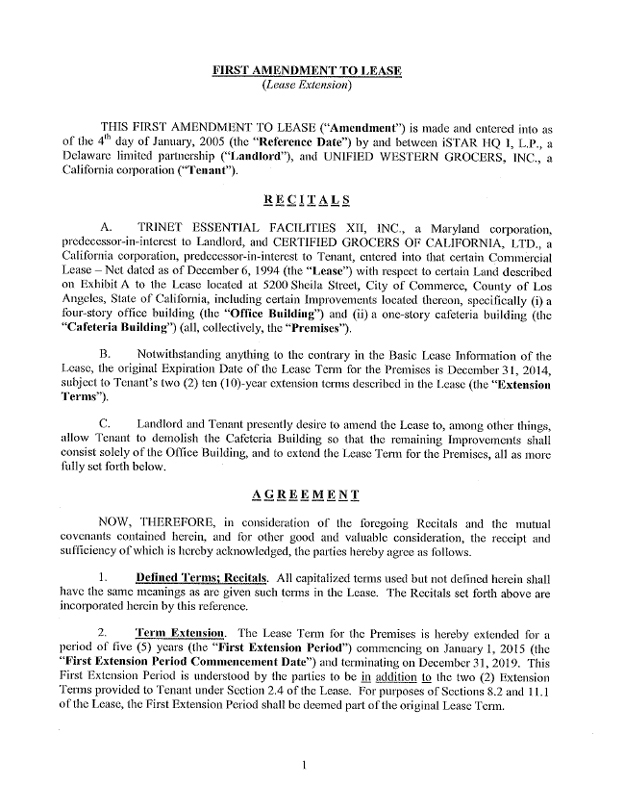
FIRST AMENDMENT TO LEASE
(Lease Extension)
THIS FIRST AMENDMENT TO LEASE (“Amendment”) is made and entered into as of the 4th day of January, 2005 (the “Reference Date”) by and between iSTAR HQ 1, L.P., a Delaware limited partnership (“Landlord”), and UNIFIED WESTERN GROCERS, INC., a California corporation (“Tenant”).
RECITALS
A. TRINET ESSENTIAL FACILITIES XII, INC., a Maryland corporation, predecessor-in-interest to Landlord, and CERTIFIED GROCERS OF CALIFORNIA, LTD., a California corporation, predecessor-in-interest to Tenant, entered into that certain Commercial Lease – Net dated as of December 6, 1994 (the “Lease”) with respect to certain Land described on Exhibit A to the Lease located at 5200 Sheila Street, City of Commerce, County of Los Angeles, State of California, including certain Improvements located thereon, specifically (i) a four-story office building (the “Office Building”) and (ii) a one-story cafeteria building (the “Cafeteria Building”) (all, collectively, the “Premises”).
B. Notwithstanding anything to the contrary in the Basic Lease Information of the Lease, the original Expiration Date of the Lease Term for the Premises is December 31, 2014, subject to Tenant’s two (2) ten (10)-year extension terms described in the Lease (the “Extension Terms”).
C. Landlord and Tenant presently desire to amend the Lease to, among other things, allow Tenant to demolish the Cafeteria Building so that the remaining Improvements shall consist solely of the Office Building, and to extend the Lease Term for the Premises, all as more fully set forth below.
AGREEMENT
NOW, THEREFORE, in consideration of the foregoing Recitals and the mutual covenants contained herein, and for other good and valuable consideration, the receipt and sufficiency of which is hereby acknowledged, the parties hereby agree as follows.
1. Defined Terms; Recitals. All capitalized terms used but not defined herein shall have the same meanings as are given such terms in the Lease. The Recitals set forth above are incorporated herein by this reference.
2. Term Extension. The Lease Term for the Premises is hereby extended for a period of five (5) years (the “First Extension Period”) commencing on January 1, 2015 (the “First Extension Period Commencement Date”) and terminating on December 31, 2019. This First Extension Period is understood by the parties to be in addition to the two (2) Extension Terms provided to Tenant under Section 2.4 of the Lease. For purposes of Sections 8.2 and 11.1 of the Lease, the First Extension Period shall be deemed part of the original Lease Term.
1
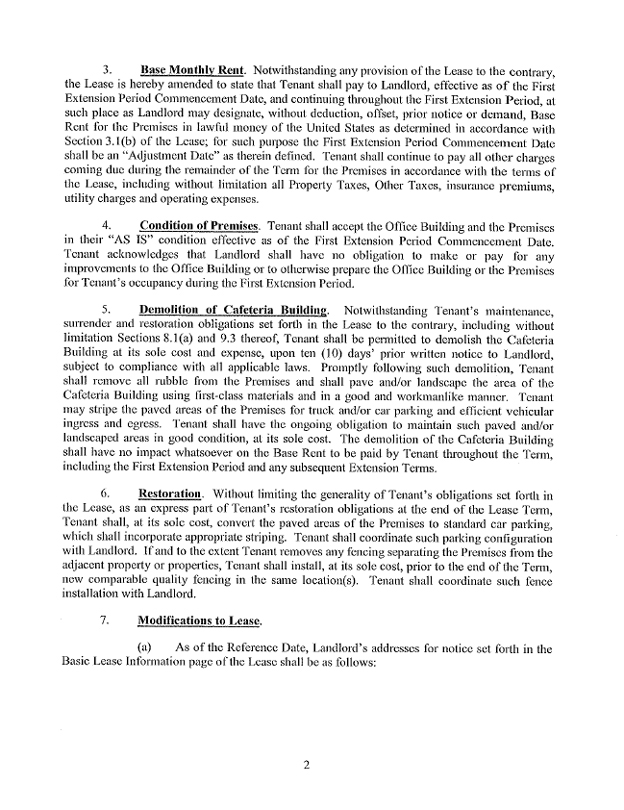
3. Base Monthly Rent. Notwithstanding any provision of the Lease to the contrary, the Lease is hereby amended to state that Tenant shall pay to Landlord, effective as of the First Extension Period Commencement Date, and continuing throughout the First Extension Period, at such place as Landlord may designate, without deduction, offset, prior notice or demand, Base Rent for the Premises in lawful money of the United States as determined in accordance with Section 3.1(b) of the Lease; for such purpose the First Extension Period Commencement Date shall be an “Adjustment Date” as therein defined. Tenant shall continue to pay all other charges coming due during the remainder of the Term for the Premises in accordance with the terms of the Lease, including without limitation all Property Taxes, Other Taxes, insurance premiums, utility charges and operating expenses.
4. Condition of Premises. Tenant shall accept the Office Building and the Premises in their “AS IS” condition effective as of the First Extension Period Commencement Date. Tenant acknowledges that Landlord shall have no obligation to make or pay for any improvements to the Office Building or to otherwise prepare the Office Building or the Premises for Tenant’s occupancy during the First Extension Period.
5. Demolition of Cafeteria Building. Notwithstanding Tenant’s maintenance, surrender and restoration obligations set forth in the Lease to the contrary, including without limitation Sections 8.1(a) and 9.3 thereof, Tenant shall be permitted to demolish the Cafeteria Building at its sole cost and expense, upon ten (10) days’ prior written notice to Landlord, subject to compliance with all applicable laws. Promptly following such demolition, Tenant shall remove all rubble from the Premises and shall pave and/or landscape the area of the Cafeteria Building using first-class materials and in a good and workmanlike manner. Tenant may stripe the paved areas of the Premises for truck and/or car parking and efficient vehicular ingress and egress. Tenant shall have the ongoing obligation to maintain such paved and/or landscaped areas in good condition, at its sole cost. The demolition of the Cafeteria Building shall have no impact whatsoever on the Base Rent to be paid by Tenant throughout the Term, including the First Extension Period and any subsequent Extension Terms.
6. Restoration. Without limiting the generality of Tenant’s obligations set forth in the Lease, as an express part of Tenant’s restoration obligations at the end of the Lease Term, Tenant shall, at its sole cost, convert the paved areas of the Premises to standard car parking, which shall incorporate appropriate striping. Tenant shall coordinate such parking configuration with Landlord. If and to the extent Tenant removes any fencing separating the Premises from the adjacent property or properties, Tenant shall install, at its sole cost, prior to the end of the Term, new comparable quality fencing in the same location(s). Tenant shall coordinate such fence installation with Landlord.
7. Modifications to Lease.
(a) As of the Reference Date, Landlord’s addresses for notice set forth in the Basic Lease Information page of the Lease shall be as follows:
2
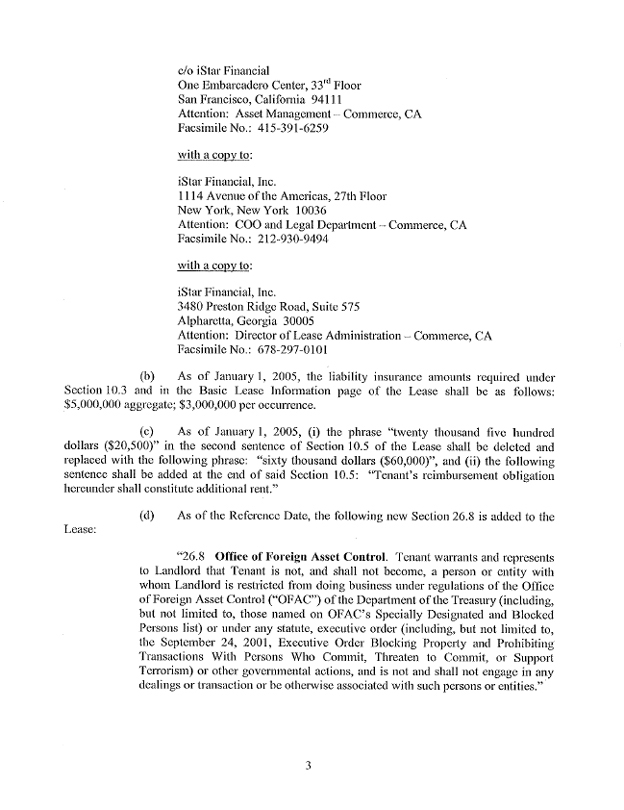
c/o iStar Financial
One Embarcadero Center, 33rd Floor San Francisco, California 94111 Attention: Asset Management – Commerce, CA Facsimile No.: 415-391-6259
with a copy to:
iStar Financial, Inc.
1114 Avenue of the Americas, 27th Floor New York, New York 10036
Attention: COO and Legal Department – Commerce, CA Facsimile No.: 212-930-9494
with a copy to:
iStar Financial, Inc.
3480 Preston Ridge Road, Suite 575 Alpharetta, Georgia 30005
Attention: Director of Lease Administration – Commerce, CA Facsimile No.: 678-297-0101
(b) As of January 1, 2005, the liability insurance amounts required under Section 10.3 and in the Basic Lease Information page of the Lease shall be as follows: $5,000,000 aggregate; $3,000,000 per occurrence.
(c) As of January 1, 2005, (i) the phrase “twenty thousand five hundred dollars ($20,500)” in the second sentence of Section 10.5 of the Lease shall be deleted and replaced with the following phrase: “sixty thousand dollars ($60,000)”, and (ii) the following sentence shall be added at the end of said Section 10.5: “Tenant’s reimbursement obligation hereunder shall constitute additional rent.”
(d) As of the Reference Date, the following new Section 26.8 is added to the
Lease:
“26.8 Office of Foreign Asset Control. Tenant warrants and represents to Landlord that Tenant is not, and shall not become, a person or entity with whom Landlord is restricted from doing business under regulations of the Office of Foreign Asset Control (“OFAC”) of the Department of the Treasury (including, but not limited to, those named on OFAC’s Specially Designated and Blocked Persons list) or under any statute, executive order (including, but not limited to, the September 24, 2001, Executive Order Blocking Property and Prohibiting Transactions With Persons Who Commit, Threaten to Commit, or Support Terrorism) or other governmental actions, and is not and shall not engage in any dealings or transaction or be otherwise associated with such persons or entities.”
3
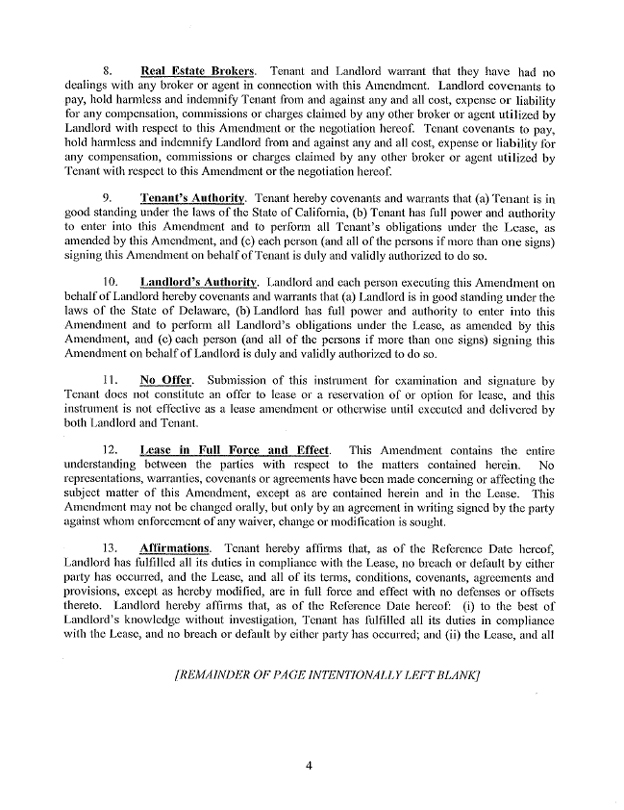
8. Real Estate Brokers. Tenant and Landlord warrant that they have had no dealings with any broker or agent in connection with this Amendment. Landlord covenants to pay, hold harmless and indemnify Tenant from and against any and all cost, expense or liability for any compensation, commissions or charges claimed by any other broker or agent utilized by Landlord with respect to this Amendment or the negotiation hereof. Tenant covenants to pay, hold harmless and indemnify Landlord from and against any and all cost, expense or liability for any compensation, commissions or charges claimed by any other broker or agent utilized by Tenant with respect to this Amendment or the negotiation hereof.
9. Tenant’s Authority. Tenant hereby covenants and warrants that (a) Tenant is in good standing under the laws of the State of California, (b) Tenant has full power and authority to enter into this Amendment and to perform all Tenant’s obligations under the Lease, as amended by this Amendment, and (c) each person (and all of the persons if more than one signs) signing this Amendment on behalf of Tenant is duly and validly authorized to do so.
10. Landlord’s Authority. Landlord and each person executing this Amendment on behalf of Landlord hereby covenants and warrants that (a) Landlord is in good standing under the laws of the State of Delaware, (b) Landlord has full power and authority to enter into this Amendment and to perform all Landlord’s obligations under the Lease, as amended by this Amendment, and (c) each person (and all of the persons if more than one signs) signing this Amendment on behalf of Landlord is duly and validly authorized to do so.
11. No Offer. Submission of this instrument for examination and signature by Tenant does not constitute an offer to lease or a reservation of or option for lease, and this instrument is not effective as a lease amendment or otherwise until executed and delivered by both Landlord and Tenant.
12. Lease in Full Force and Effect. This Amendment contains the entire understanding between the parties with respect to the matters contained herein. No representations, warranties, covenants or agreements have been made concerning or affecting the subject matter of this Amendment, except as are contained herein and in the Lease. This Amendment may not be changed orally, but only by an agreement in writing signed by the party against whom enforcement of any waiver, change or modification is sought.
13. Affirmations. Tenant hereby affirms that, as of the Reference Date hereof, Landlord has fulfilled all its duties in compliance with the Lease, no breach or default by either party has occurred, and the Lease, and all of its terms, conditions, covenants, agreements and provisions, except as hereby modified, are in full force and effect with no defenses or offsets thereto. Landlord hereby affirms that, as of the Reference Date hereof: (i) to the best of Landlord’s knowledge without investigation, Tenant has fulfilled all its duties in compliance with the Lease, and no breach or default by either party has occurred; and (ii) the Lease, and all
[REMAINDER OF PAGE INTENTIONALLY LEFT BLANK]
4
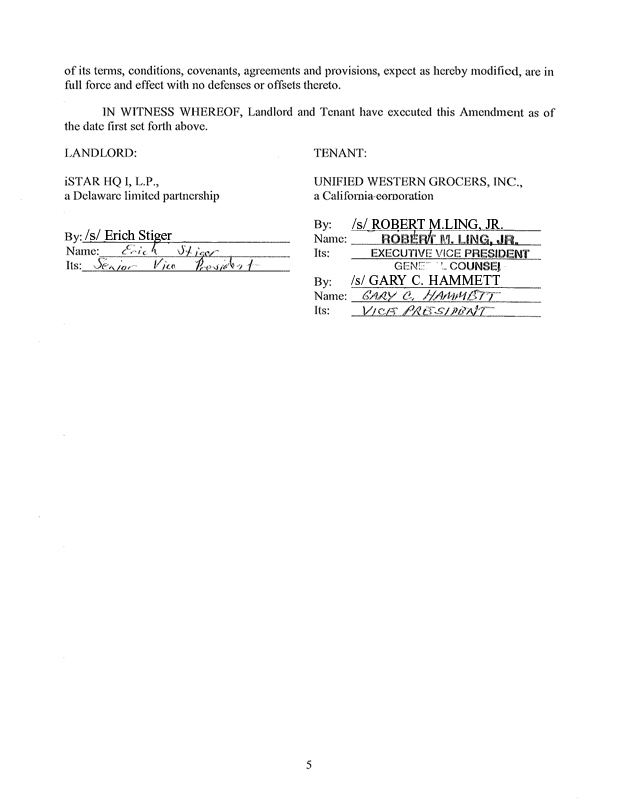
of its terms, conditions, covenants, agreements and provisions, expect as hereby modified, are in full force and effect with no defenses or offsets thereto.
IN WITNESS WHEREOF, Landlord and Tenant have executed this Amendment as of the date first set forth above.
LANDLORD:
iSTAR HQ I, L.P.,
a Delaware limited partnership
By: /s/ Erich Stiger
Name: Erich Stiger
Its: Senior Vice President
TENANT:
UNIFIED WESTERN GROCERS, INC., a California corporation
By: /s/ ROBERT M. LING, JR.
Name: ROBERT M. LING, JR.
Its: EXECUTIVE VICE PRESIDENT
GENERAL COUNSEL
By: /s/ Gary C. Hammett
Name: Gary C. Hammett
Its: VICE PRESIDENT
5
Exhibit 10.2
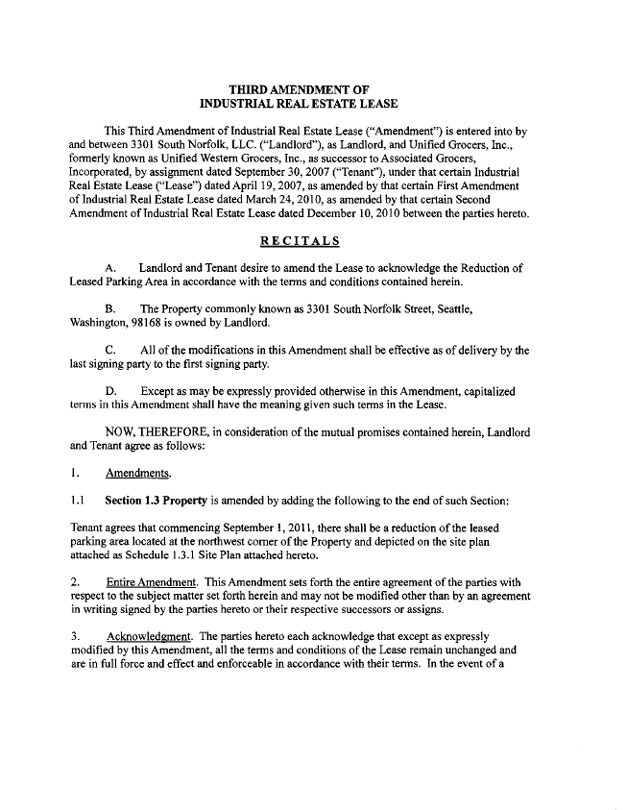
THIRD AMENDMENT OF INDUSTRIAL REAL ESTATE LEASE
This Third Amendment of Industrial Real Estate Lease (“Amendment”) is entered into by and between 3301 South Norfolk, LLC. (“Landlord”), as Landlord, and Unified Grocers, Inc., formerly known as Unified Western Grocers, Inc., as successor to Associated Grocers, Incorporated, by assignment dated September 30, 2007 (“Tenant”), under that certain Industrial Real Estate Lease (“Lease”) dated April 19, 2007, as amended by that certain First Amendment of Industrial Real Estate Lease dated March 24, 2010, as amended by that certain Second Amendment of Industrial Real Estate Lease dated December 10, 2010 between the parties hereto.
RECITALS
A. Landlord and Tenant desire to amend the Lease to acknowledge the Reduction of Leased Parking Area in accordance with the terms and conditions contained herein.
B. The Property commonly known as 3301 South Norfolk Street, Seattle,
Washington, 98168 is owned by Landlord.
C. All of the modifications in this Amendment shall be effective as of delivery by the last signing party to the first signing party.
D. Except as may be expressly provided otherwise in this Amendment, capitalized terms in this Amendment shall have the meaning given such terms in the Lease.
NOW, THEREFORE, in consideration of the mutual promises contained herein, Landlord and Tenant agree as follows:
1. Amendments.
1.1 Section 1.3 Property is amended by adding the following to the end of such Section:
Tenant agrees that commencing September 1, 2011, there shall be a reduction of the leased parking area located at the northwest comer of the Property and depicted on the site plan attached as Schedule 1.3.1 Site Plan attached hereto.
2. Entire Amendment. This Amendment sets forth the entire agreement of the parties with respect to the subject matter set forth herein and may not be modified other than by an agreement in writing signed by the parties hereto or their respective successors or assigns.
3. Acknowledgment. The parties hereto each acknowledge that except as expressly modified by this Amendment, all the terms and conditions of the Lease remain unchanged and are in full force and effect and enforceable in accordance with their terms. In the event of a
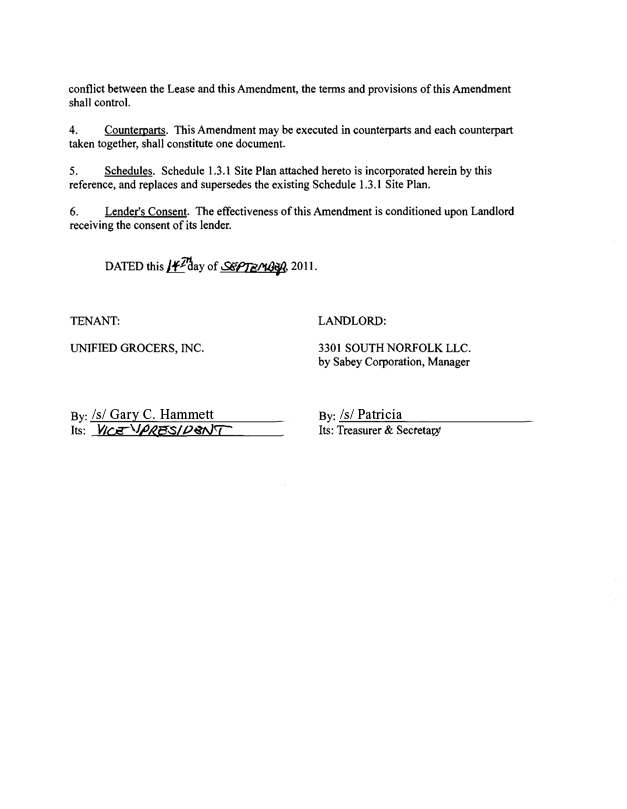
conflict between the Lease and this Amendment, the terms and provisions of this Amendment shall control.
4. Counterparts. This Amendment may be executed in counterparts and each counterpart taken together, shall constitute one document.
5. Schedules. Schedule 1.3.1 Site Plan attached hereto is incorporated herein by this reference, and replaces and supersedes the existing Schedule 1.3.1 Site Plan.
6. Lender’s Consent. The effectiveness of this Amendment is conditioned upon Landlord receiving the consent of its lender.
DATED this 14TH day of SEPTEMBER, 2011.
TENANT:
UNIFIED GROCERS, INC.
By: /s/ Gary C. Hammett
Its: VICE PRESIDENT
LANDLORD:
3301 SOUTH NORFOLK LLC. by Sabey Corporation, Manager
By: /s/ Patricia
Its: Treasurer & Secretary
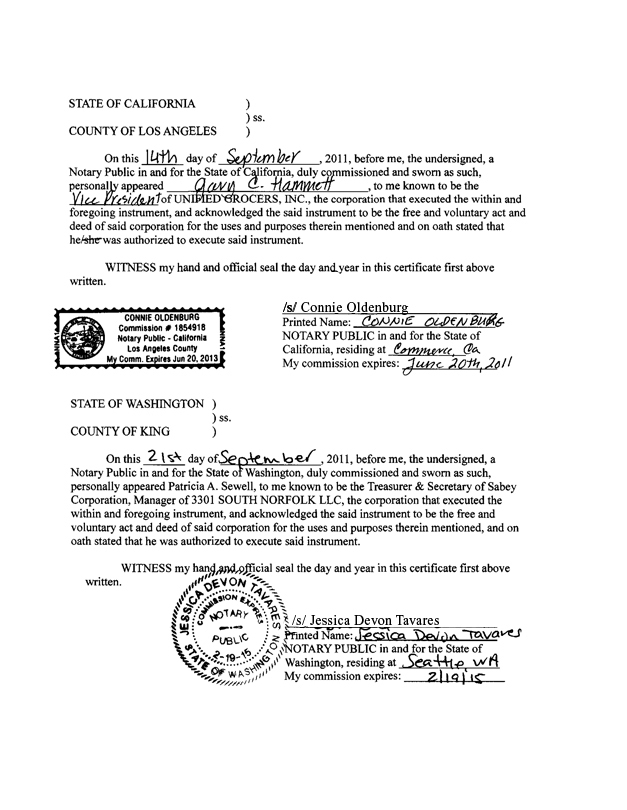
STATE OF CALIFORNIA )
) ss.
COUNTY OF LOS ANGELES )
On this 14th day of September, 2011, before me, the undersigned, a Notary Public in and for the State of California, duly commissioned and sworn as such,
personally appeared Gary C. Hammett, to me known to be the Vice President of UNIFIED GROCERS, INC., the corporation that executed the within and foregoing instrument, and acknowledged the said instrument to be the free and voluntary act and deed of said corporation for the uses and purposes therein mentioned and on oath stated that he/she was authorized to execute said instrument.
WITNESS my hand and official seal the day and year in this certificate first above
written.
/s/ CONNIE OLDENBURG
Printed Name: CONNIE OLDENBURG
NOTARY PUBLIC in and for the State of
California, residing at Commerce, Ca
My commission expires: June 20th, 2011
CONNIE OLDENBURG
Commission # 1854918
Notary Public - California
Los Angeles County
My Comm. Expires Jun 20, 2013
STATE OF WASHINGTON )
) ss.
COUNTY OF KING )
On this 21st day of September, 2011, before me, the undersigned, a Notary Public in and for the State of Washington, duly commissioned and sworn as such, personally appeared Patricia A. Sewell, to me known to be the Treasurer & Secretary of Sabey Corporation, Manager of 3301 SOUTH NORFOLK LLC, the corporation that executed the within and foregoing instrument, and acknowledged the said instrument to be the free and voluntary act and deed of said corporation for the uses and purposes therein mentioned, and on oath stated that he was authorized to execute said instrument.
WITNESS my hand and official seal the day and year in this certificate first above written.
JESSICA DEVON TAVARES COMMISSION EXPIRES NOTARY PUBLIC 2-19-15 STATE OF WASHINGTON
/s/ Jessica Devon Tavares
Printed Name: Jessica Devon Tavares
NOTARY PUBLIC in and for the State of
Washington, residing at Seattle, WA
My commission expires: 2/19/15
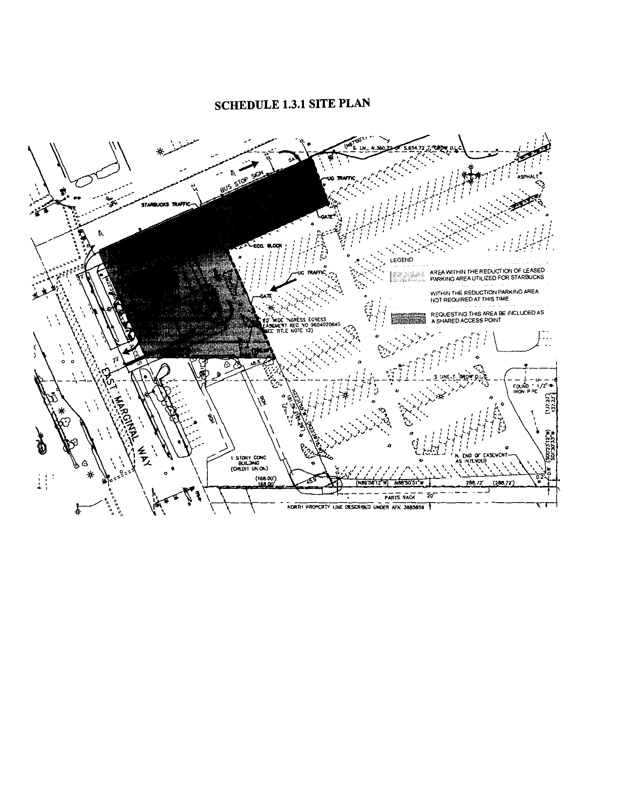
SCHEDULE 1.3.1 SITE PLAN
LEGEND
AREA WITHIN THE REDUCTION OF LEASED PARKING AREA UTILIZED FOR STARBUCKS
WITHIN THE REDUCTION PARKING AREA NOT REQUIRED AT THIS TIME
REQUESTING THIS AREA BE INCLUDED AS A SHARED ACCESS POINT
EAST MARGINAL WAY
Exhibit 10.3
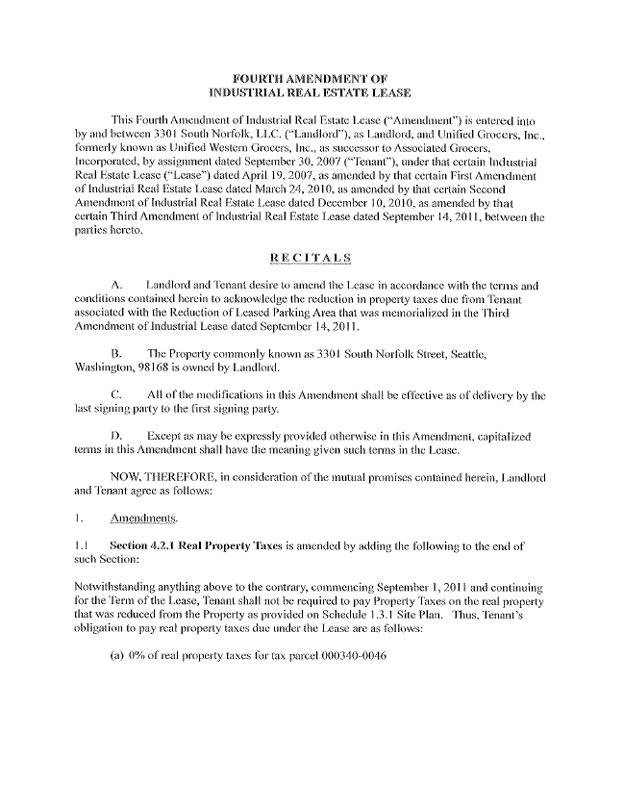
FOURTH AMENDMENT OF INDUSTRIAL REAL ESTATE LEASE
This Fourth Amendment of Industrial Real Estate Lease (“Amendment”) is entered into by and between 3301 South Norfolk, LLC. (“Landlord”), as Landlord, and Unified Grocers, Inc., formerly known as Unified Western Grocers, Inc., as successor to Associated Grocers, Incorporated, by assignment dated September 30, 2007 (“Tenant”), under that certain Industrial Real Estate Lease (“Lease”) dated April 19, 2007, as amended by that certain First Amendment of Industrial Real Estate Lease dated March 24, 2010, as amended by that certain Second Amendment of Industrial Real Estate Lease dated December 10, 2010, as amended by that certain Third Amendment of Industrial Real Estate Lease dated September 14, 2011, between the parties hereto.
RECITALS
A. Landlord and Tenant desire to amend the Lease in accordance with the terms and conditions contained herein to acknowledge the reduction in property taxes due from Tenant associated with the Reduction of Leased Parking Area that was memorialized in the Third Amendment of Industrial Lease dated September 14, 2011.
B. The Property commonly known as 3301 South Norfolk Street, Seattle,
Washington, 98168 is owned by Landlord.
C. All of the modifications in this Amendment shall be effective as of delivery by the last signing party to the first signing party.
D. Except as may be expressly provided otherwise in this Amendment, capitalized terms in this Amendment shall have the meaning given such terms in the Lease.
NOW, THEREFORE, in consideration of the mutual promises contained herein, Landlord and Tenant agree as follows:
1. Amendments.
1.1 Section 4.2.1 Real Property Taxes is amended by adding the following to the end of such Section:
Notwithstanding anything above to the contrary, commencing September 1, 2011 and continuing for the Term of the Lease, Tenant shall not be required to pay Property Taxes on the real property that was reduced from the Property as provided on Schedule 1.3.1 Site Plan. Thus, Tenant’s obligation to pay real property taxes due under the Lease are as follows:
(a) 0% of real property taxes for tax parcel 000340-0046
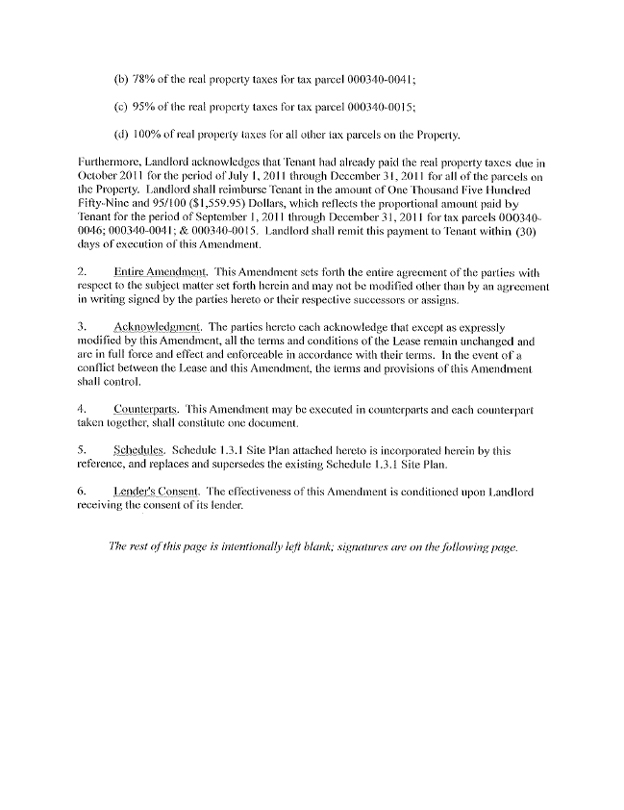
(b) 78% of the real property taxes for tax parcel 000340-0041;
(c) 95% of the real property taxes for tax parcel 000340-0015;
(d) 100% of real property taxes for all other tax parcels on the Property.
Furthermore, Landlord acknowledges that Tenant had already paid the real property taxes due in October 2011 for the period of July 1, 2011 through December 31, 2011 for all of the parcels on the Property. Landlord shall reimburse Tenant in the amount of One Thousand Five Hundred Fifty-Nine and 95/100 ($1,559.95) Dollars, which reflects the proportional amount paid by Tenant for the period of September 1, 2011 through December 31, 2011 for tax parcels 000340-0046; 000340-0041; & 000340-0015. Landlord shall remit this payment to Tenant within (30) days of execution of this Amendment.
2. Entire Amendment. This Amendment sets forth the entire agreement of the parties with respect to the subject matter set forth herein and may not be modified other than by an agreement in writing signed by the parties hereto or their respective successors or assigns.
3. Acknowledgment. The parties hereto each acknowledge that except as expressly modified by this Amendment, all the terms and conditions of the Lease remain unchanged and are in full force and effect and enforceable in accordance with their terms. In the event of a conflict between the Lease and this Amendment, the terms and provisions of this Amendment shall control.
4. Counterparts. This Amendment may be executed in counterparts and each counterpart taken together, shall constitute one document.
5. Schedules. Schedule 1.3.1 Site Plan attached hereto is incorporated herein by this reference, and replaces and supersedes the existing Schedule 1.3.1 Site Plan.
6. Lender’s Consent. The effectiveness of this Amendment is conditioned upon Landlord, receiving the consent of its lender.
The rest of this page is intentionally left blank; signatures are on the following page.
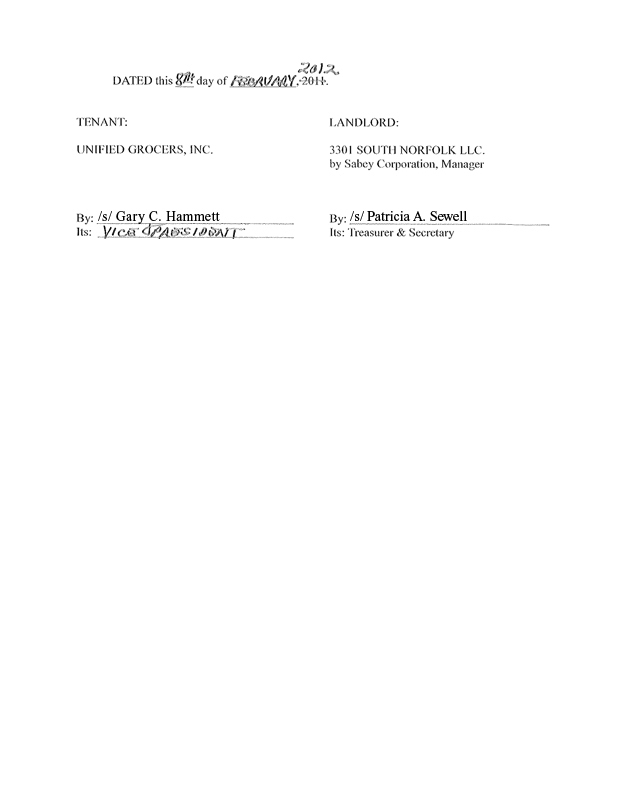
DATED this 8TH day of FEBRUARY, 2011. 2012
TENANT:
UNIFIED GROCERS, INC.
By: /s/ Gary C. Hammett
Its: VICE PRESIDENT
LANDLORD:
3301 SOUTH NORFOLK LLC. by Sabey Corporation, Manager
By: /s/ Patricia A. Sewell
Its: Treasurer & Secretary
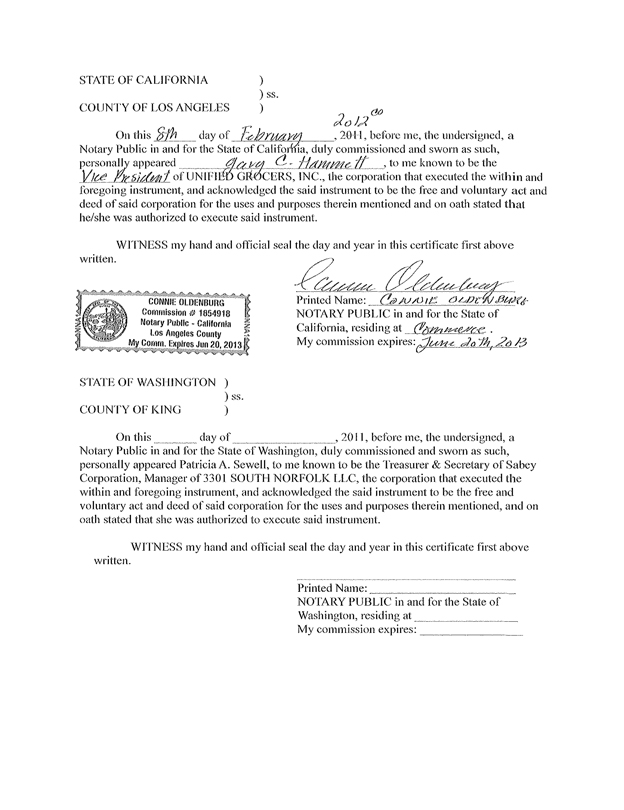
STATE OF CALIFORNIA )
) ss.
COUNTY OF LOS ANGELES )
On this 8th day of February, 2011, 2012co before me, the undersigned, a
Notary Public in and for the State of California, duly commissioned and sworn as such,
personally appeared Gary C. Hammett, to me known to be the
Vice President of UNIFIED GROCERS, INC., the corporation that executed the within and
foregoing instrument, and acknowledged the said instrument to be the free and voluntary act and deed of said corporation for the uses and purposes therein mentioned and on oath stated that he/she was authorized to execute said instrument.
WITNESS my hand and official seal the day and year in this certificate first above written.
CONNIE OLDENBURG Commission # 1854918 Notary Public - California Los Angeles County My Comm. Expires Jun 20, 2013
Printed Name: CONNIE OLDENBURG
NOTARY PUBLIC in and for the State of
California, residing at Commerce.
My commission expires: June 20th, 2013
STATE OF WASHINGTON )
)ss.
COUNTY OF KING )
On this day of, 2011, before me, the undersigned, a
Notary Public in and for the State of Washington, duly commissioned and sworn as such, personally appeared Patricia A. Sewell, to me known to be the Treasurer & Secretary of Sabey Corporation, Manager of 3301 SOUTH NORFOLK LLC, the corporation that executed the within and foregoing instrument, and acknowledged the said instrument to be the free and voluntary act and deed of said corporation for the uses and purposes therein mentioned, and on oath stated that she was authorized to execute said instrument.
WITNESS my hand and official seal the day and year in this certificate first above
written.
Printed Name:
NOTARY PUBLIC in and for the State of
Washington, residing at
My commission expires:
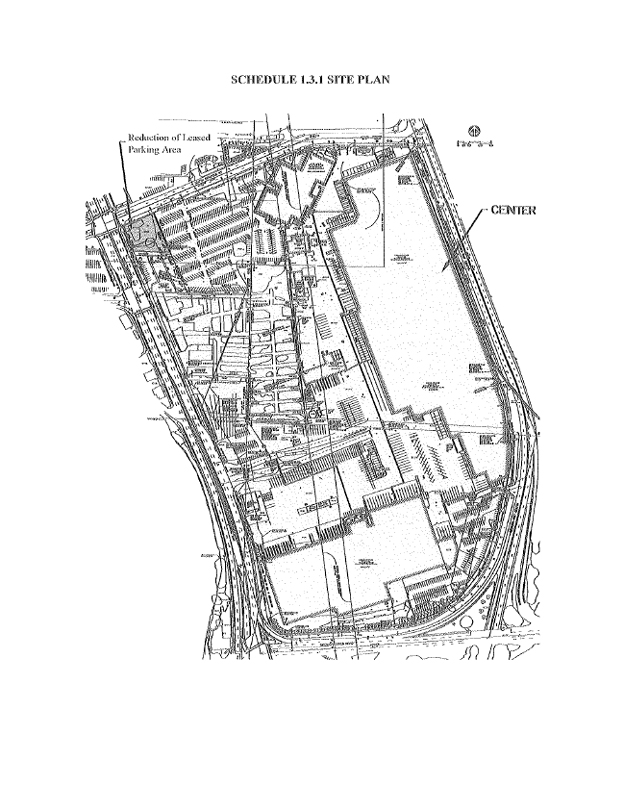
SCHEDULE 1.3.1 SITE PLAN
Reduction of Leased
Parking Area
CENTER
Exhibit 10.4
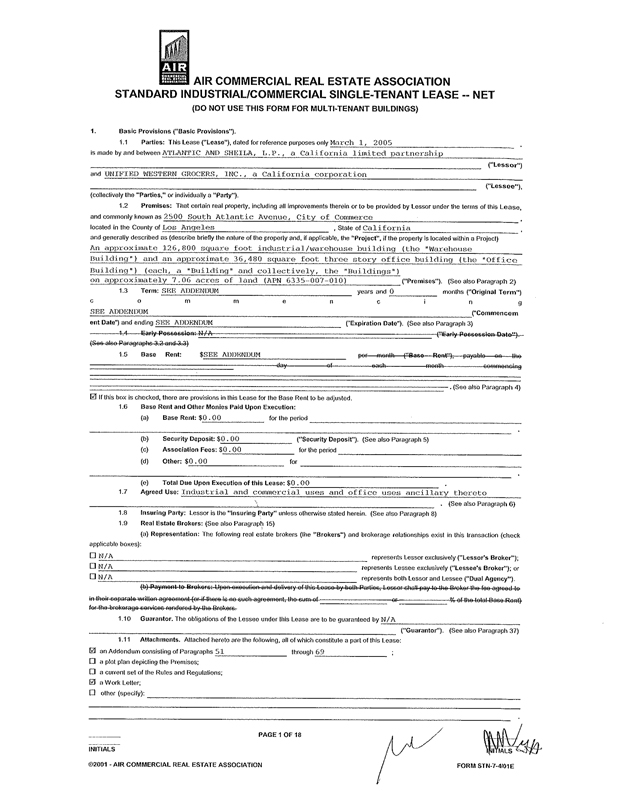
AIR COMMERCIAL REAL ESTATE ASSOCIATION
AIR COMMERCIAL REAL ESTATE ASSOCIATION
STANDARD INDUSTRIAL/COMMERCIAL SINGLE-TENANT LEASE — NET
(DO NOT USE THIS FORM FOR MULTI-TENANT BUILDINGS)
1. Basic Provisions (“Basic Provisions”).
1.1 Parties: This Lease (“Lease”), dated for reference purposes only March 1, 2005,
is made by and between ATLANTIC AND SHEILA, L.P., a California limited partnership
(“Lessor”)
and UNIFIED WESTERN GROCERS, INC., a California corporation
(“Lessee”),
(collectively the “Parties,” or individually a “Party”).
1.2 Premises: That certain real properly, including all improvements therein or to be provided by Lessor under the terms of this Lease,
and commonly known as 2500 South Atlantic Avenue, City of Commerce,
located in the County of Los Angeles, State of California,
and generally described as (describe briefly the nature of the property and, if applicable, the “Project”, if the property is located within a Project)
An approximate 126,800 square foot industrial/warehouse building (the “Warehouse
Building”) and an approximate 36,480 square foot three story office building (the “Office Building”) (each, a “Building” and collectively, the “Buildings”)
on approximately 7.06 acres of land (APN 6335-007-010) (“Premises”). (See also Paragraph 2)
1.3 Term: SEE ADDENDUM years and 0 months (“Original Term”)
commencing
SEE ADDENDUM (“Commencement Date”) and ending SEE ADDENDUM (“Expiration Date”). (See also Paragraph 3)
1.4 Early Possession: N/A (“Early Possession Date”).
(See also Paragraphs 3.2 and 3.3)
1.5 Base Rent: $SEE ADDENDUM per month (“Base Rent”), payable on the day of each month commencing.
(See also Paragraph 4)
If this box is checked, there are provisions in this Lease for the Base Rent to be adjusted.
1.6 Base Rent and Other Monies Paid Upon Execution:
(a) Base Rent: $0.00 for the period.
(b) Security Deposit: $0.00 (“Security Deposit”). (See also Paragraph 5)
(c) Association Fees: $0.00 for the period
(d) Other: $0.00 for.
(e) Total Due Upon Execution of this Lease: $0.00.
1.7 Agreed Use: Industrial and commercial uses and office uses ancillary thereto. (See also Paragraph 6)
1.8 Insuring Party: Lessor is the “Insuring Party” unless otherwise stated herein. (See also Paragraph 8)
1.9 Real Estate Brokers: (See also Paragraph 15)
(a) Representation: The following real estate brokers (the “Brokers”) and brokerage relationships exist in this transaction (check applicable boxes):
N/A represents Lessor exclusively (“Lessor’s Broker”);
N/A represents Lessee exclusively (“Lessee’s Broker”); or
N/A represents both Lessor and Lessee (“Dual Agency”).
(b) Payment to Brokers: Upon execution and delivery of this Lease by both Parties, Lessor shall pay to the Broker the fee agreed to in their separate written agreement (or if there is no such agreement, the sum of or % of the total Base Rent) for the brokerage services rendered by the Brokers.
1.10 Guarantor. The obligations of the Lessee under this Lease are to be guaranteed by N/A
(“Guarantor”). (See also Paragraph 37)
1.11 Attachments. Attached hereto are the following, all of which constitute a part of this Lease:
an Addendum consisting of Paragraphs 51 through 69;
a plot plan depicting the Premises;
a current set of the Rules and Regulations;
a Work Letter;
other (specify):
PAGE 1 OF 18
INITIALS
©2001 - AIR COMMERCIAL REAL ESTATE ASSOCIATION
INITIALS
FORM STN-7-4/01E
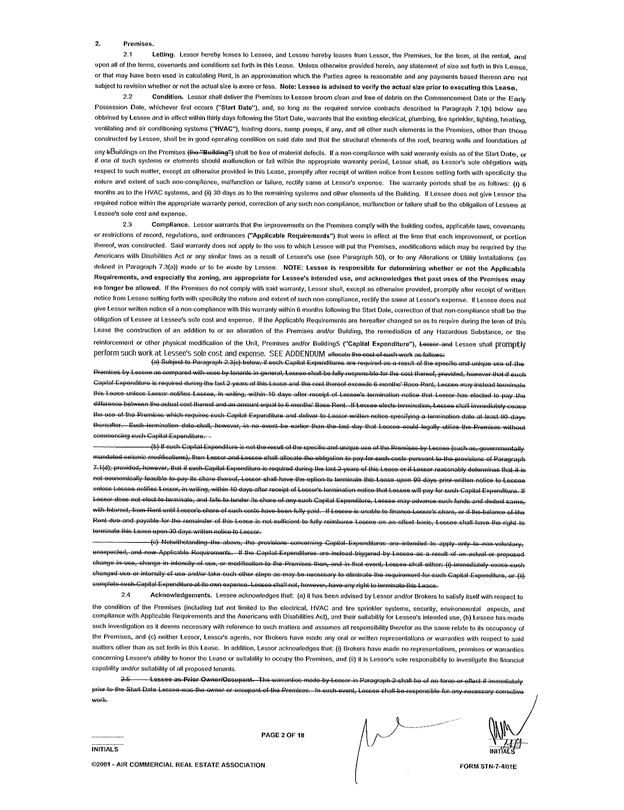
2. Premises.
2.1 Letting. Lessor hereby leases to Lessee, and Lessee hereby leases from Lessor, the Premises, for the term, at the rental, and upon all of the terms, covenants and conditions set forth in this Lease. Unless otherwise provided herein, any statement of size set forth in this Lease, or that may have been used in calculating Rent, is an approximation which the Parties agree is reasonable and any payments based thereon are not subject to revision whether or not the actual size is more or less. Note: Lessee is advised to verify the actual size prior to executing this Lease.
2.2 Condition. Lessor shall deliver the Premises to Lessee broom clean and free of debris on the Commencement Date or the Early Possession Date, whichever first occurs (“Start Date”), and, so long as the required service contracts described in Paragraph 7.1(b) below are obtained by Lessee and in effect within thirty days following the Start Date, warrants that the existing electrical, plumbing, fire sprinkler, lighting, heating, ventilating and air conditioning systems (“HVAC”), loading doors, sump pumps, if any, and all other such elements in the Premises, other than those constructed by Lessee, shall be in good operating condition on said date and that the structural elements of the roof, bearing walls and foundation of any bBuildings on the Premises (the “Building”) shall be free of material defects. If a non-compliance with said warranty exists as of the Start Date, or if one of such systems or elements should malfunction or fail within the appropriate warranty period, Lessor shall, as Lessor’s sole obligation with respect to such matter, except as otherwise provided in this Lease, promptly after receipt of written notice from Lessee setting forth with specificity the nature and extent of such non-compliance, malfunction or failure, rectify same at Lessor’s expense. The warranty periods shall be as follows: (i) 6 months as to the HVAC systems, and (ii) 30 days as to the remaining systems and other elements of the Building. If Lessee does not give Lessor the required notice within the appropriate warranty period, correction of any such non-compliance, malfunction or failure shall be the obligation of Lessee at Lessee’s sole cost and expense.
2.3 Compliance. Lessor warrants that the improvements on the Premises comply with the building codes, applicable laws, covenants or restrictions of record, regulations, and ordinances (“Applicable Requirements”) that were in effect at the time that each improvement, or portion thereof, was constructed. Said warranty does not apply to the use to which Lessee will put the Premises, modifications which may be required by the Americans with Disabilities Act or any similar laws as a result of Lessee’s use (see Paragraph 50), or to any Alterations or Utility Installations (as defined in Paragraph 7.3(a)) made or to be made by Lessee. NOTE: Lessee is responsible for determining whether or not the Applicable Requirements, and especially the zoning, are appropriate for Lessee’s intended use, and acknowledges that past uses of the Premises may no longer be allowed. If the Premises do not comply with said warranty, Lessor shall, except as otherwise provided, promptly after receipt of written notice from Lessee setting forth with specificity the nature and extent of such non-compliance, rectify the same at Lessor’s expense. If Lessee does not give Lessor written notice of a non-compliance with this warranty within 6 months following the Start Date, correction of that non-compliance shall be the obligation of Lessee at Lessee’s sole cost and expense. If the Applicable Requirements are hereafter changed so as to require during the term of this Lease the construction of an addition to or an alteration of the Premises and/or Building, the remediation of any Hazardous Substance, or the reinforcement or other physical modification of the Unit, Premises and/or Buildings (“Capital Expenditure”), Lessor and Lessee shall promptly perform such work at Lessee’s sole cost and expense. SEE ADDENDUM allocate the cost of such work as follows:
(a) Subject to Paragraph 2.3(c) below, if such Capital Expenditures are required as a result of the specific and unique use of the
Premises by Lessee as compared with uses by tenants in general, Lessee shall be fully responsible for the cost thereof, provided, however that if such Capital Expenditure is required during the last 2 years of this Lessee shall be fully responsible for the cost thereof, provided, however that if such Capital Expenditure is required during the last 2 years of this Lease and the cost thereof exceeds 6 months’ Base Rent, Lessee many instead terminate this Lease unless Lessor notifies Lessee, in writing, within 10 days receipt of Lessee’s termination notice that Lessor has elected to pay the difference between the actual cost thereof and an amount equal to 6 months’ Base Rent. If Lessee electe termination, Lessee shall immediately cease the use of the Premises which requires such Capital Expenditure and deliver to Lessor written notice specifying a termination date at least 90 days thereafter. Such termination date shall, however, in no event be earlier than the last day that Lessee could legally utilize the Premises without commencing such Capital Expenditure.
(b) If such Capital Expenditure is not the result of the specific and unique use of the Premises by Lessee (such as, governmentally mandated seismic modifications), then Lessor and Lessee shall allocate obligation to pay for such costs pursuant to the provisions of Paragraph 7.1(d); provided, however, that if such Capital Expenditure is required during the last 2 years of this Lessee or if Lessor reasonably determines that it is not economically feasible to pay its share thereof, Lessor shall have the option to terminate this Lease upon 90 days prior written notice to Lessee unless Lessee notifies Lessor, in writing, within 10 days after receipt of Lessor’s termination notice that Lessee will pay for such Capital Expenditure. If Lessor does not elect to terminate, and fails to tender its share of any such Capital Expenditure, Lessee may advance such funds and deduct same, with Interest, from Rent until Lessor’s share of such costs have been fully paid. If Lessee is unable to finance Lessor’s share, or if the balance of the Rent due and payable for the remainder of this Lease is not sufficient to fully reimburse Lessee on an offset basis, Lessee shall have the right to terminate this Lease upon 30 days written notice to Lessor.
(c) Notwithstanding the above, the provisions concerning Capital Expenditures are intend to apply only to non voluntary, unexpected, and new Applicable Requirements. If the Capital Expenditures are instead triggered by Lessee as a result of an actual or proposed change in use, change in intensity of use, or modification to the Premises then, and in that event, Lessee shall either: (i) immediately cease such changed use or intensity of use and/or take such other steps as may be necessary to eliminate the requirement for such Capital Expenditure, or (ii) complete such Capital Expenditure at its own expense. Lessee shall not, however, have any right to terminate this Lease.
2.4 Acknowledgements. Lessee acknowledges that: (a) it has been advised by Lessor and/or Brokers to satisfy itself with respect to the condition of the Premises (including but not limited to the electrical, HVAC and fire sprinkler systems, security, environmental aspects, and compliance with Applicable Requirements and the Americans with Disabilities Act), and their suitability for Lessee’s intended use, (b) Lessee has made such investigation as it deems necessary with reference to such mallers and assumes all responsibility therefor as the same relate to its occupancy of the Premises, and (c) neither Lessor, Lessor’s agents, nor Brokers have made any oral or written representations or warranties with respect to said matters other than as set forth in this Lease. In addition, Lessor acknowledges that; (i) Brokers have made no representations, promises or warranties concerning Lessee’s ability to honor the Lease or suitability to occupy the Premises, and (ii) it is Lessor’s sole responsibility to investigate the financial capability and/or suitability of all proposed tenants.
2.5 Lessee as Prior Owner/Occupant. The warranties made by Lessor in Paragraph 2 shall be of no force or effect if immediately prior to the Start Date Lessee was the owner or occupant of the Premises. In such event, Lessee shall be responsible for any necessary corrective work.
PAGE 2 OF 18
INITIALS INITIALS
©2001 - AIR COMMERCIAL REAL ESTATE ASSOCIATION
FORM STN-7-4/01E
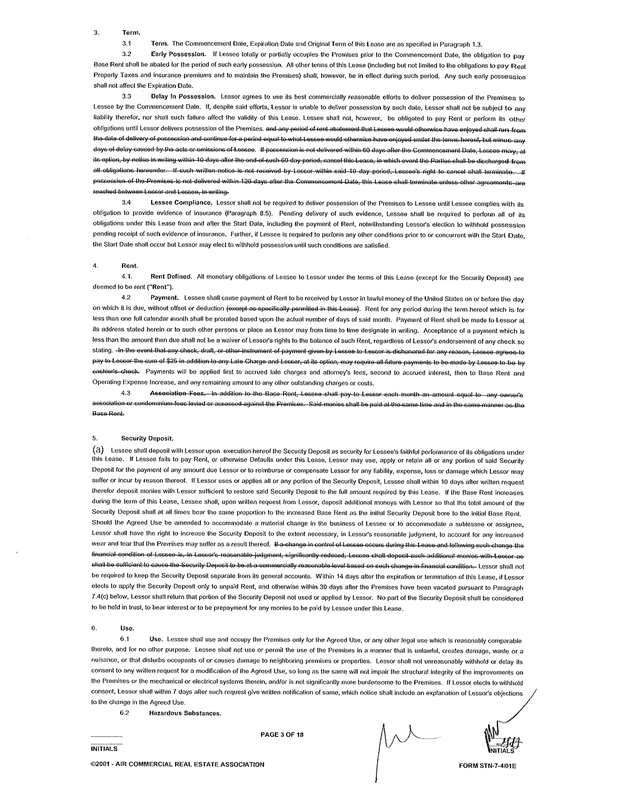
3. Term.
3.1 Term. The Commencement Date, Expiration Date and Original Term of this Lease are as specified in Paragraph 1.3.
3.2 Early Possession. If Lessee totally or partially occupies the Premises prior to the Commencement Date, the obligation to pay Base Rent shall be abated for the period of such early possession. All other terms of this Lease (including but not limited to the obligations to pay Real Property Taxes and insurance premiums and to maintain the Premises) shall, however, be in effect during such period. Any such early possession shall not affect the Expiration Date.
3.3 Delay In Possession. Lessor agrees to use its best commercially reasonable efforts to deliver possession of the Premises to Lessee by the Commencement Date. If, despite said efforts, Lessor is unable to deliver possession by such date, Lessor shall not be subject to any liability therefor, nor shall such failure affect the validity of this Lease. Lessee shall not, however, be obligated to pay Rent or perform its other obligations until Lessor delivers possession of the Premises. and any period of rent abatement that Lessee would otherwise have enjoyed shall run from the date of delivery of possession and continue for a period equal to what Lessee would otherwise have enjoyed under the terms hereof, but minus any days of delay caused by the acts or omissions of Lessee. If possession is not delivered within 60 days after the Commencement Date, Lessee may, at its option, by notice in writing within 10 days after the end of such 60 day period, cancel this Lease, in which event the Parties shall be discharged from all obligations hereunder. If such written notice is not received by Lessor within said 10 day period, Lessee’s right to cancel shall terminate. If possession of the Premises is not delivered within 120 days after the Commencement Date, this Lease shall terminate unless other agreements are reached between Lessor and Lessee, in writing.
3.4 Lessee Compliance. Lessor shall not be required to deliver possession of the Premises to Lessee until Lessee complies with its obligation to provide evidence of insurance (Paragraph 8.5). Pending delivery of such evidence, Lessee shall be required to perform all of its obligations under this Lease from and after the Start Date, including the payment of Rent, notwithstanding Lessor’s election to withhold possession pending receipt of such evidence of insurance. Further, if Lessee is required to perform any other conditions prior to or concurrent with the Start Date, the Start Date shall occur but Lessor may elect to withhold possession until such conditions are satisfied.
4. Rent.
4.1. Rent Defined. All monetary obligations of Lessee to Lessor under the terms of this Lease (except for the Security Deposit) are deemed to be rent (“Rent”).
4.2 Payment. Lessee shall cause payment of Rent to be received by Lessor in lawful money of the United States on or before the day on which it is due, without offset or deduction (except as specifically permitted in this Lease). Rent for any period during the term hereof which is for less than one full calendar month shall be prorated based upon the actual number of days of said month. Payment of Rent shall be made to Lessor at its address stated herein or to such other persons or place as Lessor may from time to time designate in writing. Acceptance of a payment which is less than the amount then due shall not be a waiver of Lessor’s rights to the balance of such Rent, regardless of Lessor’s endorsement of any check so stating. In the event that any check, draft, or other instrument of payment given by Lessee to Lessor is dishonored for any reason, Lessee agree to pay to Lessor the sum of $25 in addition to any Late Charge and Lessor, at its option, may require all future payments to be made by Lessee to be by cashier’s check. Payments will be applied first to accrued late charges and attorney’s fees, second to accrued interest, then to Base Rent and Operating Expense increase, and any remaining amount to any other outstanding charges or costs.
4.3 Association Fees. In addition to the Base Rent, Lessee shall pay to Lessor each month an amount equal to any owner’s association or condominium fees levied or assessed against the Premises. Said monies shall be paid at the same time and in the same manner as the Base Rent.
5. Security Deposit.
(a) Lessee shall deposit with Lessor upon execution hereof the Security Deposit as security for Lessee’s faithful performance of its obligations under this Lease. If Lessee fails to pay Rent, or otherwise Defaults under this Lease, Lessor may use, apply or retain all or any portion of said Security Deposit for the payment of any amount due Lessor or to reimburse or compensate Lessor for any liability, expense, loss or damage which Lessor may suffer or incur by reason thereof. If Lessor uses or applies all or any portion of the Security Deposit, Lessee shall within 10 days after written request therefor deposit monies with Lessor sufficient to restore said Security Deposit to the full amount required by this Lease. If the Base Rent increases during the term of this Lease, Lessee shall, upon written request from Lessor, deposit additional moneys with Lessor so that the total amount of the Security Deposit shall at all times bear the same proportion to the increased Base Rent as the initial Security Deposit bore to the initial Base Rent. Should the Agreed Use be amended to accommodate a material change in the business of Lessee or to accommodate a sublessee or assignee, Lessor shall have the right to increase the Security Deposit to the extent necessary, in Lessor’s reasonable judgment, to account for any increased wear and tear that the Premises may suffer as a result thereof. If a change in control of Lessee occurs during this Lease and following such change the financial condition of Lessee is, in Lessor’s reasonable judgment, significantly reduced, Lessee shall deposit such additional monies will Lessor as shall be sufficient to cause the Security Deposit to be at a commercially reasonable level based on such change in financial condition. Lessor shall not be required to keep the Security Deposit separate from its general accounts. Within 14 days after the expiration or termination of this Lease, if Lessor elects to apply the Security Deposit only to unpaid Rent, and otherwise within 30 days after the Premises have been vacated pursuant to Paragraph 7.4(c) below, Lessor shall return that portion of the Security Deposit not used or applied by Lessor. No part of the Security Deposit shall be considered to be held in trust, to bear interest or to be prepayment for any monies to be paid by Lessee under this Lease.
6. Use.
6.1 Use. Lessee shall use and occupy the Premises only for the Agreed Use, or any other legal use which is reasonably comparable thereto, and for no other purpose. Lessee shall not use or permit the use of the Premises in a manner that is unlawful, creates damage, waste or a nuisance, or that disturbs occupants of or causes damage to neighboring premises or properties. Lessor shall not unreasonably withhold or delay its consent to any written request for a modification of the Agreed Use, so long as the same will not impair the structural integrity of the improvements on the Premises or the mechanical or electrical systems therein, and/or is not significantly more burdensome to the Premises. If Lessor elects to withhold consent, Lessor shall within 7 days after such request give written notification of same, which notice shall include an explanation of Lessor’s objections to the change in the Agreed Use.
6.2 Hazardous Substances.
PAGE 3 OF 18
INITIALS
©2001 - AIR COMMERCIAL REAL ESTATE ASSOCIATION
INITIALS
FORM STN-7-4/01E
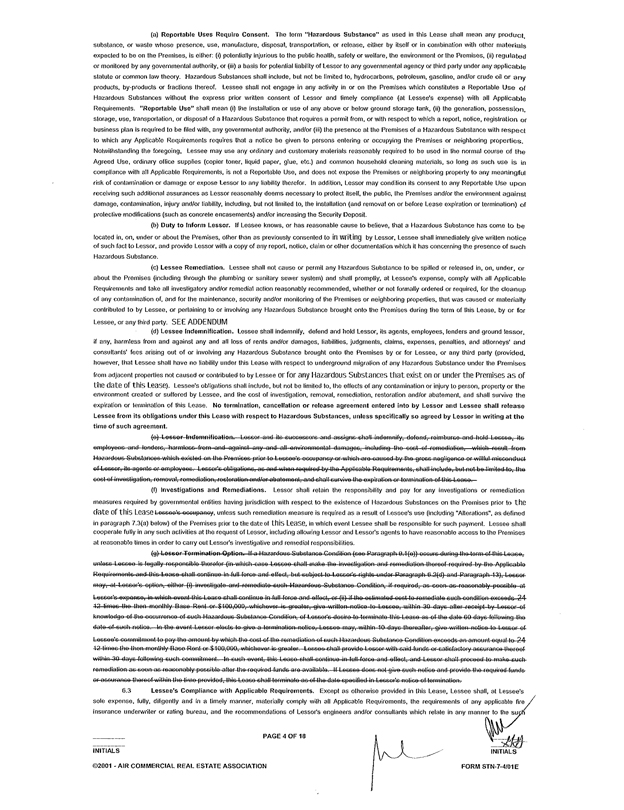
(a) Reportable Uses Require Consent. The term “Hazardous Substance” as used in this Lease shall mean any product, substance, or waste whose presence, use, manufacture, disposal, transportation, or release, either by itself or in combination with other materials expected to be on the Premises, is either: (i) potentially injurious to the public health, safety or welfare, the environment or the Premises, (ii) regulated or monitored by any governmental authority, or (iii) a basis for potential liability of Lessor to any governmental agency or third party under any applicable statute or common law theory. Hazardous Substances shall include, but not be limited to, hydrocarbons, petroleum, gasoline, and/or crude oil or any products, by-products or fractions thereof. Lessee shall not engage in any activity in or on the Premises which constitutes a Reportable Use of Hazardous Substances without the express prior written consent of Lessor and timely compliance (at Lessee’s expense) with all Applicable Requirements. “Reportable Use” shall mean (i) the installation or use of any above or below ground storage tank, (ii) the generation, possession, storage, use, transportation, or disposal of a Hazardous Substance that requires a permit from, or with respect to which a report, notice, registration or business plan is required to be filed with, any governmental authority, and/or (iii) the presence at the Premises of a Hazardous Substance with respect to which any Applicable Requirements requires that a notice be given to persons entering or occupying the Premises or neighboring properties. Notwithstanding the foregoing. Lessee may use any ordinary and customary materials reasonably required to be used in the normal course of the Agreed Use, ordinary office supplies (copier toner, liquid paper, glue, etc.) and common household cleaning materials, so long as such use is in compliance with all Applicable Requirements, is not a Reportable Use, and does not expose the Premises or neighboring properly to any meaningful risk of contamination or damage or expose Lessor to any liability therefor. In addition, Lessor may condition its consent to any Reportable Use upon receiving such additional assurances as Lessor reasonably deems necessary to protect itself, the public, the Premises and/or the environment against damage, contamination, injury and/or liability, including, but not limited to, the installation (and removal on or before Lease expiration or termination) of protective modifications (such as concrete encasements) and/or increasing the Security Deposit.
(b) Duty to Inform Lessor. If Lessee knows, or has reasonable cause to believe, that a Hazardous Substance has come to be located in, on, under or about the Premises, other than as previously consented to in writing by Lessor, Lessee shall immediately give written notice of such fact to Lessor, and provide Lessor with a copy of any report, notice, claim or other documentation which it has concerning the presence of such Hazardous Substance.
(c) Lessee Remediation. Lessee shall not cause or permit any Hazardous Substance to be spilled or released in, on, under, or about the Premises (including through the plumbing or sanitary sewer system) and shall promptly, at Lessee’s expense, comply with all Applicable Requirements and take all investigatory and/or remedial action reasonably recommended, whether or not formally ordered or required, for the cleanup of any contamination of, and for the maintenance, security and/or monitoring of the Premises or neighboring properties, that was caused or materially contributed to by Lessee, or pertaining to or involving any Hazardous Substance brought onto the Premises during the term of this Lease, by or for Lessee, or any third party. SEE ADDENDUM
(d) Lessee Indemnification. Lessee shall indemnify, defend and hold Lessor, its agents, employees, lenders and ground lessor, if any, harmless from and against any and all loss of rents and/or damages, liabilities, judgments, claims, expenses, penalties, and attorneys’ and consultants’ fees arising out of or involving any Hazardous Substance brought onto the Premises by or for Lessee, or any third party (provided, however, that Lessee shall have no liability under this Lease with respect to underground migration of any Hazardous Substance under the Premises from adjacent properties not caused or contributed to by Lessee or for any Hazardous Substances that exist on or under the Premises as of the date of this Lease). Lessee’s obligations shall include, but not be limited to, the effects of any contamination or injury to person, property or the environment created or suffered by Lessee, and the cost of investigation, removal, remediation, restoration and/or abatement, and shall survive the expiration or termination of this Lease. No termination, cancellation or release agreement entered into by Lessor and Lessee shall release Lessee from its obligations under this Lease with respect to Hazardous Substances, unless specifically so agreed by Lessor in writing at the time of such agreement.
(e) Lesser Indemnification. Lesser and its successors and assigns shall indemnify, defend, reimburse and hold Lessee, its employees and lenders, harmless from and against any and all environmental damages, including the cost of remediation, which result from Hazardous Substances which existed on the Premises prior to Lessee’s occupancy or which are caused by the gross negligence or willful misconduct of Lessor, its agents or employees, Lessor’s obligations, as and when required by the Applicable Requirements shall include, but not be limited to, the cost of investigation, removal; remediation, restoration and/or abatement, and shall survive the expiration or termination of this Lease.
(f) Investigations and Remediations. Lessor shall retain the responsibility and pay for any investigations or remediation measures required by governmental entities having jurisdiction with respect to the existence of Hazardous Substances on the Promises prior to the date of this Lease Lessee’s occupancy, unless such remediation measure is required as a result of Lessee’s use (including “Alterations”, as defined in paragraph 7.3(a) below) of the Premises prior to the date of this Lease, in which event Lessee shall be responsible for such payment. Lessee shall cooperate fully in any such activities at the request of Lessor, including allowing Lessor and Lessor’s agents to have reasonable access to the Premises at reasonable times in order to carry out Lessor’s investigative and remedial responsibilities.
(g) Lesser Termination Option. If a Hazardous Substance Condition (see Paragraph 9.1(e)) occurs during the term of this Lease, unless Lessee is legally responsible therefor (in which case Lessee shall make the investigation and remediation thereof required by the Applicable Requirements and this Lease shall continue in full force and effect, but subject to Lesser’s right under Paragraph 6.2(d) and Paragraph 13), Lessor may, at Lessor’s option; either (i) investigate and remediate such Hazardous Substance Condition, if required, as soon as reasonably possible at Lessor’s expense, in which event this Lease shall continue in full force and effect; or (ii) if the estimated cost to remediate such condition exceeds 24 12 times the then monthly Base Rent or $100,000, whichever is greater, give written notice to Lessee, within 30 days after receipt by Lessor of knowledge of the occurrence of such Hazardous Substance Condition, of Lessor’s desire to terminate this Lease as of the date 60 days following the date of such notice. In the event Lessor elects to give a termination notice, Lessee may, within 10 days thereafter, give written notice to Lessor of Lessee’s commitment to pay the amount by which the cost of the remediation of such Hazardous Substance Condition exceeds an amount equal to 24 12 times the then monthly Base Rent or $100,000, whichever is greater. Lessee shall provide Lessor which said funds of satisfactory assurance thereof within 30 days following such commitment. In such event, this Lease shall continue in full force and effect; and Lessor shall proceed to make such remediation as soon as reasonably possible after the required funds are available. If Lessee does not give such notice and provide the required funds or assurance thereof within the time provided, this Lease shall terminate as of the date specified in Lesser’s notice of termination.
6.3 Lessee’s Compliance with Applicable Requirements. Except as otherwise provided in this Lease, Lessee shall, at Lessee’s sole expense, fully, diligently and in a timely manner, materially comply with all Applicable Requirements, the requirements of any applicable fire insurance underwriter or rating bureau, and the recommendations of Lessor’s engineers and/or consultants which relate in any manner to the such
PAGE 4 OF 18
INITIALS
©2001 - AIR COMMERCIAL REAL ESTATE ASSOCIATION
INITIALS
FORM STN-7-4/01E
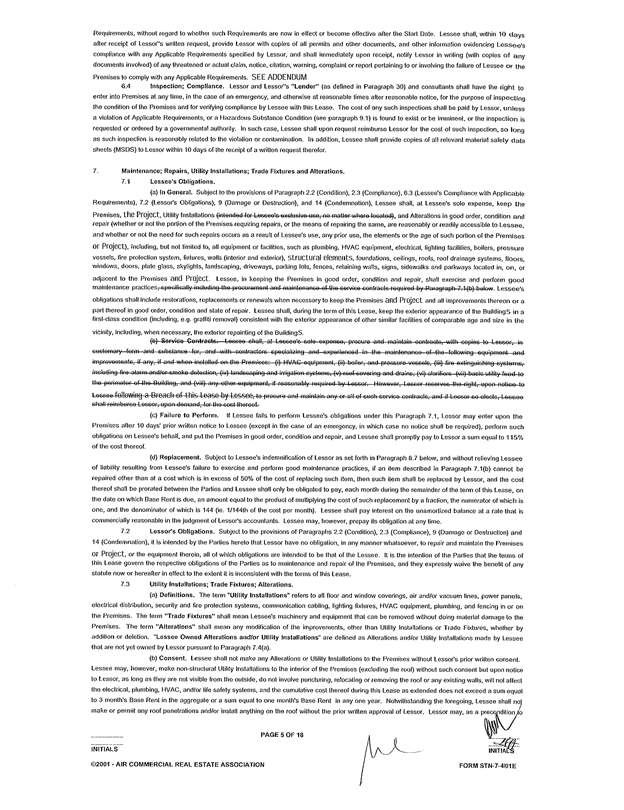
Requirements, without regard to whether such Requirements are now in effect or become effective after the Start Date. Lessee shall, within 10 days after receipt of Lessor’s written request, provide Lessor with copies of all permits and other documents, and other information evidencing Lessee’s compliance with any Applicable Requirements specified by Lessor, and shall immediately upon receipt, notify Lessor in writing (with copies of any documents involved) of any threatened or actual claim, notice, citation, warning, complaint or report pertaining to or involving the failure of Lessee or the Premises to comply with any Applicable Requirements. SEE ADDENDUM
6.4 Inspection; Compliance. Lessor and Lessor’s “Lender” (as defined in Paragraph 30) and consultants shall have the right to enter into Premises at any time, in the case of an emergency, and otherwise at reasonable times after reasonable notice, for the purpose of inspecting the condition of the Premises and for verifying compliance by Lessee with this Lease. The cost of any such inspections shall be paid by Lessor, unless a violation of Applicable Requirements, or a Hazardous Substance Condition (see paragraph 9.1) is found to exist or be imminent, or the inspection is requested or ordered by a governmental authority. In such case, Lessee shall upon request reimburse Lessor for the cost of such inspection, so long as such inspection is reasonably related to the violation or contamination. In addition, Lessee shall provide copies of all relevant material safety data sheets (MSDS) to Lessor within 10 days of the receipt of a written request therefor.
7. Maintenance; Repairs, Utility Installations; Trade Fixtures and Alterations.
7.1 Lessee’s Obligations.
(a) In General. Subject to the provisions of Paragraph 2.2 (Condition), 2.3 (Compliance), 6.3 (Lessee’s Compliance with Applicable Requirements), 7.2 (Lessor’s Obligations), 9 (Damage or Destruction), and 14 (Condemnation), Lessee shall, at Lessee’s sole expense, keep the Premises, the Project, Utility Installations (intended for Lessee’s exclusive use, no matter where located), and Alterations in good order, condition and repair (whether or not the portion of the Premises requiring repairs, or the means of repairing the same, are reasonably or readily accessible to Lessee, and whether or not the need for such repairs occurs as a result of Lessee’s use, any prior use, the elements or the age of such portion of the Premises or Project), including, but not limited to, all equipment or facilities, such as plumbing, HVAC equipment, electrical, lighting facilities, boilers, pressure vessels, fire protection system, fixtures, walls (interior and exterior), structural elements, foundations, ceilings, roofs, roof drainage systems, floors, windows, doors, plate glass, skylights, landscaping, driveways, parking lots, fences, retaining walls, signs, sidewalks and parkways located in, on, or adjacent to the Premises and Project. Lessee, in keeping the Premises in good order, condition and repair, shall exercise and perform good maintenance practices, specifically including the procurement and maintenance of the service contracts required by Paragraph 7.1(b) below. Lessee’s obligations shall include restorations, replacements or renewals when necessary to keep the Premises and Project and all improvements thereon or a part thereof in good order, condition and state of repair. Lessee shall, during the term of this Lease, keep the exterior appearance of the BuildingS in a first-class condition (including, e.g. graffiti removal) consistent with the exterior appearance of other similar facilities of comparable age and size in the vicinity, including, when necessary, the exterior repainting of the BuildingS.
(b) Service Contracts. Lessee shall, at Lessee’s sole expense, procure and maintain contracts, with copies to Lessor, in customary form and substance for, and with contractors specializing and experienced in the maintenance of the following equipment and improvements, if any, if and when installed on the Premises: (i) HVAC equipment, (ii) boiler, and pressure vessels, (iii) fire extinguishing systems, including fire alarm and/or smoke detection, (iv) landscaping and irrigation systems, (v) roof covering and drains, (vi) clarifiers (vii) basic utility food to the perimeter of the Building and, (viii) any other equipment, if reasonably required by Lessor. However, Lessor reserves the right, upon notice to Lessee following a Breach of this lease by Lessee, to procure and maintain any or all of such service contracts, and if Lessor so elects, Lessee shall reimburse Lessor, upon demand, for the cost thereof.
(c) Failure to Perform. If Lessee fails to perform Lessee’s obligations under this Paragraph 7.1, Lessor may enter upon the Premises after 10 days’ prior written notice to Lessee (except in the case of an emergency, in which case no notice shall be required), perform such obligations on Lessee’s behalf, and put the Premises in good order, condition and repair, and Lessee shall promptly pay to Lessor a sum equal to 115% of the cost thereof.
(d) Replacement. Subject to Lessee’s indemnification of Lessor as set forth in Paragraph 8.7 below, and without relieving Lessee of liability resulting from Lessee’s failure to exercise and perform good maintenance practices, if an item described in Paragraph 7.1(b) cannot be repaired other than at a cost which is in excess of 50% of the cost of replacing such item, then such item shall be replaced by Lessor, and the cost thereof shall be prorated between the Parties and Lessee shall only be obligated to pay, each month during the remainder of the term of this Lease, on the date on which Base Rent is due, an amount equal to the product of multiplying the cost of such replacement by a fraction, the numerator of which is one, and the denominator of which is 144 (ie. 1/144th of the cost per month). Lessee shall pay interest on the unamortized balance at a rate that is commercially reasonable in the judgment of Lessor’s accountants. Lessee may, however, prepay its obligation at any time.
7.2 Lessor’s Obligations. Subject to the provisions of Paragraphs 2.2 (Condition), 2.3 (Compliance), 9 (Damage or Destruction) and 14 (Condemnation), it is intended by the Parties hereto that Lessor have no obligation, in any manner whatsoever, to repair and maintain the Premises
or Project, or the equipment therein, all of which obligations are intended to be that of the Lessee. It is the intention of the Parties that the terms of this Lease govern the respective obligations of the Parties as to maintenance and repair of the Premises, and they expressly waive the benefit of any statute now or hereafter in effect to the extent it is inconsistent with the terms of this Lease.
7.3 Utility Installations; Trade Fixtures; Alterations.
(a) Definitions. The term “Utility Installations” refers to all floor and window coverings, air and/or vacuum lines, power panels, electrical distribution, security and fire protection systems, communication cabling, lighting fixtures, HVAC equipment, plumbing, and fencing in or on the Premises. The term “Trade Fixtures” shall mean Lessee’s machinery and equipment that can be removed without doing material damage to the Premises. The term “Alterations” shall mean any modification of the improvements, other than Utility Installations or Trade Fixtures, whether by addition or deletion. “Lessee Owned Alterations and/or Utility Installations” are defined as Alterations and/or Utility Installations made by Lessee that are not yet owned by Lessor pursuant to Paragraph 7.4(a).
(b) Consent. Lessee shall not make any Alterations or Utility Installations to the Premises without Lessor’s prior written consent. Lessee may, however, make non-structural Utility installations to the interior of the Premises (excluding the roof) without such consent but upon notice to Lessor, as long as they are not visible from the outside, do not involve puncturing, relocating or removing the roof or any existing walls, will not affect the electrical, plumbing, HVAC, and/or life safely systems, and the cumulative cost thereof during this Lease as extended does not exceed a sum equal to 3 month’s Base Rent in the aggregate or a sum equal to one month’s Base Rent in any one year. Notwithstanding the foregoing, Lessee shall not make or permit any roof penetrations and/or install anything on the roof without the prior written approval of Lessor. Lessor may, as a precondition to
PAGE 5 OF 18
INITIALS
©2001 - AIR COMMERCIAL REAL ESTATE ASSOCIATION
INITIALS
FORM STN-7-4/01E
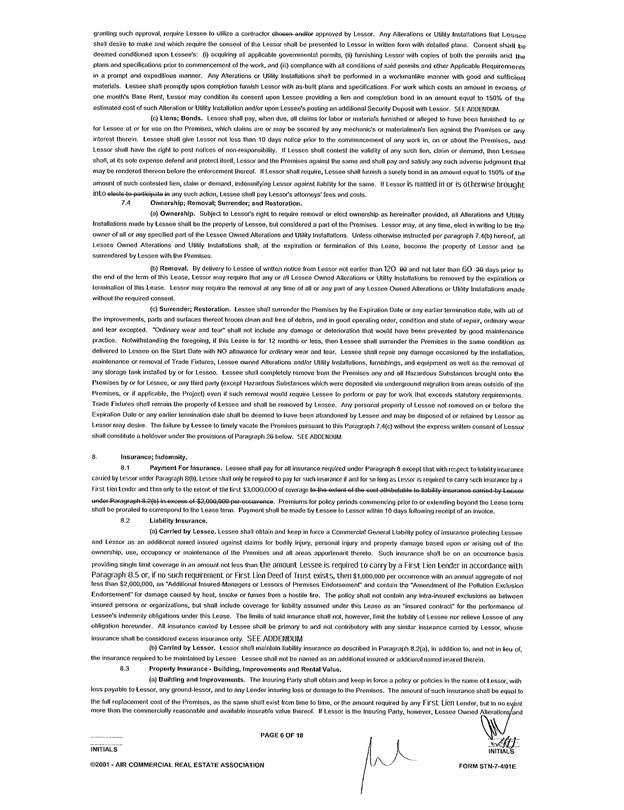
granting such approval, require Lessee to utilize a contractor chosen and/or approved by Lessor. Any Alterations or Utility Installations that Lessee shall desire to make and which require the consent of the Lessor shall be presented to Lessor in written form with detailed plans. Consent shall be deemed conditioned upon Lessee’s: (i) acquiring all applicable governmental permits, (ii) furnishing Lessor with copies of both the permits and the plans and specifications prior to commencement of the work, and (iii) compliance with all conditions of said permits and other Applicable Requirements in a prompt and expeditious manner. Any Alterations or Utility Installations shall be performed in a workmanlike manner with good and sufficient materials. Lessee shall promptly upon completion furnish Lessor with as-built plans and specifications. For work which costs an amount in excess of one month’s Base Rent, Lessor may condition its consent upon Lessee providing a lien and completion bond in an amount equal to 150% of the estimated cost of such Alteration or Utility Installation and/or upon Lessee’s posting an additional Security Deposit with Lessor. SEE ADDENDUM.
(c) Liens; Bonds. Lessee shall pay, when due, all claims for labor or materials furnished or alleged to have been furnished to or for Lessee at or for use on the Premises, which claims are or may be secured by any mechanic’s or materialmen’s lien against the Premises or any interest therein. Lessee shall give Lessor not less than 10 days notice prior to the commencement of any work in, on or about the Premises, and Lessor shall have the right to post notices of non-responsibility. If Lessee shall contest the validity of any such lien, claim or demand, then Lessee shall, at its sole expense defend and protect itself, Lessor and the Premises against the same and shall pay and satisfy any such adverse judgment that may be rendered thereon before the enforcement thereof. If Lessor shall require, Lessee shall furnish a surely bond in an amount equal to 150% of the amount of such contested lien, claim or demand, indemnifying Lessor against liability for the same. If Lessor is named in or is otherwise brought into elects to participate in any such action, Lessee shall pay Lessor’s attorneys’ fees and costs.
7.4 Ownership; Removal; Surrender; and Restoration.
(a) Ownership. Subject to Lessor’s right to require removal or elect ownership as hereinafter provided, all Alterations and Utility Installations made by Lessee shall be the property of Lessee, but considered a part of the Premises. Lessor may, at any time, elect in writing to be the owner of all or any specified part of the Lessee Owned Alterations and Utility Installations. Unless otherwise instructed per paragraph 7.4(b) hereof, all Lessee Owned Alterations and Utility installations shall, at the expiration or termination of this Lease, become the property of Lessor and be surrendered by Lessee with the Premises.
(b) Removal. By delivery to Lessee of written notice from Lessor not earlier than 120 90 and not later than 60 30 days prior to the end of the term of this Lease, Lessor may require that any or all Lessee Owned Alterations or Utility Installations be removed by the expiration or termination of this Lease. Lessor may require the removal at any time of all or any part of any Lessee Owned Alterations or Utility Installations made without the required consent.
(c) Surrender; Restoration. Lessee shall surrender the Premises by the Expiration Date or any earlier termination date, with all of the improvements, parts and surfaces thereof broom clean and free of debris, and in good operating order, condition and state of repair, ordinary wear and tear excepted. “Ordinary wear and tear” shall not include any damage or deterioration that would have been prevented by good maintenance practice. Notwithstanding the foregoing, if this Lease is for 12 months or less, then Lessee shall surrender the Premises in the same condition as delivered to Lessee on the Start Date with NO allowance for ordinary wear and tear. Lessee shall repair any damage occasioned by the installation, maintenance or removal of Trade Fixtures, Lessee owned Alterations and/or Utility Installations, furnishings, and equipment as well as the removal of any storage tank installed by or for Lessee. Lessee shall completely remove from the Premises any and all Hazardous Substances brought onto the Premises by or for Lessee, or any third party (except Hazardous Substances which were deposited via underground migration from areas outside of the Premises, or if applicable, the Project) even if such removal would require Lessee to perform or pay for work that exceeds statutory requirements. Trade Fixtures shall remain the property of Lessee and shall be removed by Lessee. Any personal property of Lessee not removed on or before the Expiration Date or any earlier termination date shall be deemed to have been abandoned by Lessee and may be disposed of or retained by Lessor as Lessor may desire. The failure by Lessee to timely vacate the Premises pursuant to this Paragraph 7.4(c) without the express written consent of Lessor shall constitute a holdover under the provisions of Paragraph 26 below. SEE ADDENDUM.
8. Insurance; Indemnity.
8.1 Payment For Insurance. Lessee shall pay for all insurance required under Paragraph 8 except that with respect to liability insurance carried by Lessor under Paragraph 8(b), Lessee shall only be required to pay for such insurance if and for so long as Lessor is required to carry such insurance by a First Lien Lender and then only to the extent of the first $3,000,000 of coverage to the extent of the cost attributable to liability insurance carried by Lessor under Paragraph 8.2(b) in excess of $2,000,000 per occurrence, Premiums for policy periods commencing prior to or extending beyond the Lease term shall be prorated to correspond to the Lease term. Payment shall be made by Lessee to Lessor within 10 days following receipt of an invoice.
8.2 Liability Insurance.
(a) Carried by Lessee. Lessee shall obtain and keep in force a Commercial General Liability policy of insurance protecting Lessee and Lessor as an additional named insured against claims for bodily injury, personal injury and properly damage based upon or arising out of the ownership, use, occupancy or maintenance of the Premises and all areas appurtenant thereto. Such insurance shall be on an occurrence basis providing single limit coverage in an amount not less than the amount Lessee is required to carry by a First Lien Lender in accordance with Paragraph 8.5 or, if no such requirement or First Lien Deed of Trust exists, then $1,000,000 per occurrence with an annual aggregate of not less than $2,000,000, an “Additional Insured-Managers or Lessors of Premises Endorsement” and contain the “Amendment of the Pollution Exclusion Endorsement” for damage caused by heat, smoke or fumes from a hostile fire. The policy shall not contain any intra-insured exclusions as between insured persons or organizations, but shall include coverage for liability assumed under this Lease as an “insured contract” for the performance of Lessee’s Indemnity obligations under this Lease. The limits of said insurance shall not, however, limit the liability of Lessee nor relieve Lessee of any obligation hereunder. All insurance carried by Lessee shall be primary to and not contributory with any similar insurance carried by Lessor, whose insurance shall be considered excess insurance only. SEE ADDENDUM
(b) Carried by Lessor. Lessor shall maintain liability insurance as described in Paragraph 8.2(a), in addition to, and not in lieu of, the insurance required to be maintained by Lessee. Lessee shall not be named as an additional insured or additional named insured therein.
8.3 Property Insurance - Building, Improvements and Rental Value.
(a) Building and Improvements. The Insuring Party shall obtain and keep in force a policy or policies in the name of Lessor, with loss payable to Lessor, any ground-lessor, and to any Lender insuring loss or damage to the Premises. The amount of such insurance shall be equal to the full replacement cost of the Premises, as the same shall exist from time to time, or the amount required by any First Lien Lender, but in no event more than the commercially reasonable and available insurable value thereof. If Lessor is the Insuring Party, however, Lessee Owned Alterations/and
PAGE 6 OF 18
INITIALS
©2001 - AIR COMMERCIAL REAL ESTATE ASSOCIATION
INITIALS
FORM STN-7-4/01E
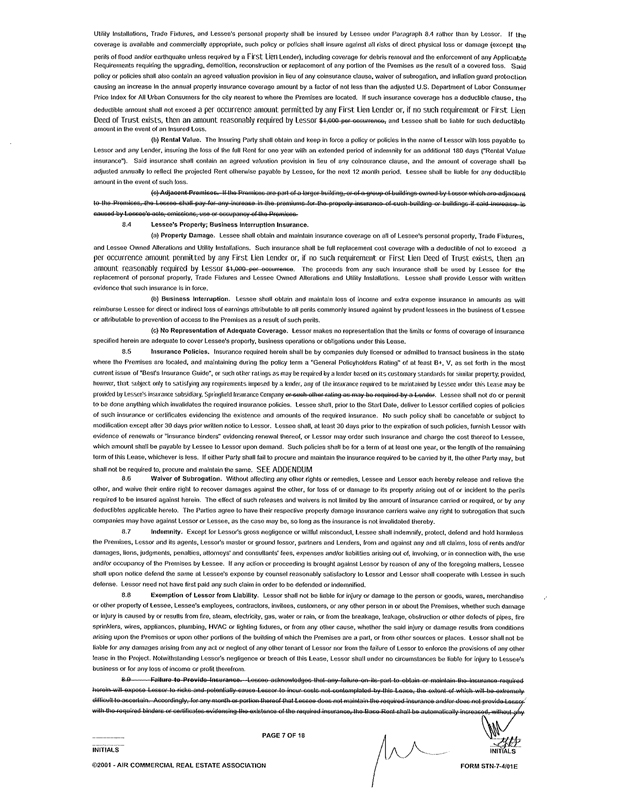
Utility Installations, Trade Fixtures, and Lessee’s personal property shall be insured by Lessee under Paragraph 8.4 rather than by Lessor. If the coverage is available and commercially appropriate, such policy or policies shall insure against all risks of direct physical loss or damage (except the perils of flood and/or earthquake unless required by a First Lien Lender), including coverage for debris removal and the enforcement of any Applicable Requirements requiring the upgrading, demolition, reconstruction or replacement of any portion of the Premises as the result of a covered loss. Said policy or policies shall also contain an agreed valuation provision in lieu of any coinsurance clause, waiver of subrogation, and inflation guard protection causing an increase in the annual property insurance coverage amount by a factor of not less than the adjusted U.S. Department of Labor Consumer Price Index for All Urban Consumers for the city nearest to where the Premises are located. If such insurance coverage has a deductible clause, the deductible amount shall not exceed a per occurrence amount: permitted by any First Lien Lender or, if no such requirement or First Lien Deed of Trust exists, then an amount reasonably required by Lessor $1,000 per occurrence, and Lessee shall be liable for such deductible amount in the event of an Insured Loss.
(b) Rental Value. The Insuring Party shall obtain and keep in force a policy or policies in the name of Lessor with loss payable to Lessor and any Lender, insuring the loss of the full Rent for one year with an extended period of indemnity for an additional 180 days (“Rental Value insurance”). Said insurance shall contain an agreed valuation provision in lieu of any coinsurance clause, and the amount of coverage shall be adjusted annually to reflect the projected Rent otherwise payable by Lessee, for the next 12 month period. Lessee shall be liable for any deductible amount in the event of such loss.
(c) Adjacent Premises. If the Premises are part of a larger building, or of a group of buildings owned by Lessor which are adjacent to the Premises, the Lessee shall pay for any increase in the premiums for the property insurance of such building or buildings if said increase is caused by Lessee’s acts, omissions, use or occupancy of the Premises.
8.4 Lessee’s Property; Business Interruption Insurance.
(a) Property Damage. Lessee shall obtain and maintain insurance coverage on all of Lessee’s personal property, Trade Fixtures, and Lessee Owned Alterations and Utility Installations. Such insurance shall be full replacement cost coverage with a deductible of not to exceed a per occurrence amount permitted by any First Lien Lender or, if no such requirement or First Lien Deed of Trust exists, then an amount reasonably required by Lessor $1,000 per occurrence. The proceeds from any such insurance shall be used by Lessee for the replacement of personal property, Trade Fixtures and Lessee Owned Alterations and Utility Installations. Lessee shall provide Lessor with written evidence that such insurance is in force.
(b) Business Interruption. Lessee shall obtain and maintain loss of income and extra expense insurance in amounts as will reimburse Lessee for direct or indirect loss of earnings attributable to all perils commonly insured against by prudent lessees in the business of Lessee or attributable to prevention of access to the Premises as a result of such perils.
(c) No Representation of Adequate Coverage. Lessor makes no representation that the limits or forms of coverage of insurance specified herein are adequate to cover Lessee’s property, business operations or obligations under this Lease.
8.5 Insurance Policies. Insurance required herein shall be by companies duly licensed or admitted to transact business in the state where the Premises are located, and maintaining during the policy term a “General Policyholders Rating” of at least B+, V, as set forth in the most current issue of “Best’s Insurance Guide”, or such other ratings as may be required by a lender based on its customary standards for similar property; provided, however, that subject only to satisfying any requirements imposed by a lender, any of the insurance required to be maintained by lessee under this Lease may be provided by Lessee’s insurance subsidiary, Springfield Insurance Company or such other rating as may be required by a Lender. Lessee shall not do or permit to be done anything which invalidates the required insurance policies. Lessee shall, prior to the Start Date, deliver to Lessor certified copies of policies of such insurance or certificates evidencing the existence and amounts of the required insurance. No such policy shall be cancelable or subject to modification except after 30 days prior written notice to Lessor. Lessee shall, at least 30 days prior to the expiration of such policies, furnish Lessor with evidence of renewals or “insurance binders” evidencing renewal thereof, or Lessor may order such insurance and charge the cost thereof to Lessee, which amount shall be payable by Lessee to Lessor upon demand. Such policies shall be for a term of at least one year, or the length of the remaining term of this Lease, whichever is less. If either Party shall fail to procure and maintain the insurance required to be carried by it, the other Party may, but shall not be required to, procure and maintain the same. SEE ADDENDUM
8.6 Waiver of Subrogation. Without affecting any other rights or remedies, Lessee and Lessor each hereby release and relieve the other, and waive their entire right to recover damages against the other, for loss of or damage to its property arising out of or incident to the perils required to be insured against herein. The effect of such releases and waivers is not limited by the amount of insurance carried or required, or by any deductibles applicable hereto. The Parties agree to have their respective property damage insurance carriers waive any right to subrogation that such companies may have against Lessor or Lessee, as the case may be, so long as the insurance is not invalidated thereby.
8.7 Indemnity. Except for Lessor’s gross negligence or willful misconduct, Lessee shall indemnify, protect, defend and hold harmless the Premises, Lessor and its agents, Lessor’s master or ground lessor, partners and Lenders, from and against any and all claims, loss of rents and/or damages, liens, judgments, penalties, attorneys’ and consultants’ fees, expenses and/or liabilities arising out of, involving, or in connection with, the use and/or occupancy of the Premises by Lessee. If any action or proceeding is brought against Lessor by reason of any of the foregoing matters, Lessee shall upon notice defend the same at Lessee’s expense by counsel reasonably satisfactory to Lessor and Lessor shall cooperate with Lessee in such defense. Lessor need not have first paid any such claim in order to be defended or indemnified.
8.8 Exemption of Lessor from Liability. Lessor shall not be liable for injury or damage to the person or goods, wares, merchandise or other property of Lessee, Lessee’s employees, contractors, invitees, customers, or any other person in or about the Premises, whether such damage or injury is caused by or results from fire, steam, electricity, gas, water or rain, or from the breakage, leakage, obstruction or other defects of pipes, fire sprinklers, wires, appliances, plumbing, HVAC or lighting fixtures, or from any other cause, whether the said injury or damage results from conditions arising upon the Premises or upon other portions of the building of which the Premises are a part, or from other sources or places. Lessor shall not be liable for any damages arising from any act or neglect of any other tenant of Lessor nor from the failure of Lessor to enforce the provisions of any other lease in the Project. Notwithstanding Lessor’s negligence or breach of this Lease, Lessor shall under no circumstances be liable for injury to Lessee’s business or for any loss of income or profit therefrom.
8.9 Failure to Provide Insurance. Lessee acknowledges that any failure on its part to obtain or maintain the insurance required herein will expose Lessor to risks and potentially cause Lessor to incur costs not contemplated by this Lease, the extent of which will be extremely difficult to ascertain. Accordingly, for any month or portion thereof that Lessee does not maintain the required insurance and/or does not provide Lessor with the required binders or certificates evidencing the existence of the required insurance, the Base Rent shall be automatically increased, without any
PAGE 7 OF 18
INITIALS
INITIALS
©2001 - AIR COMMERCIAL REAL ESTATE ASSOCIATION
FORM STN-7-4/01E
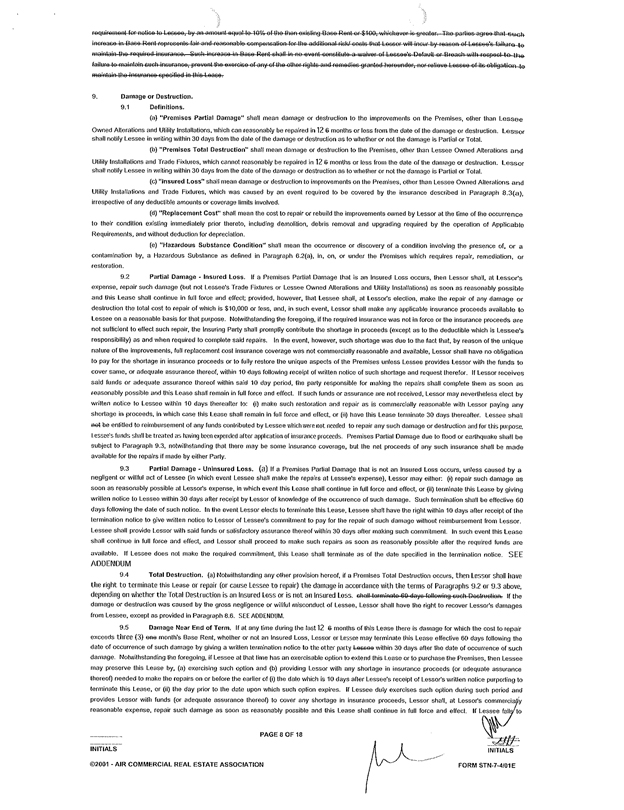
requirement for notice to Lessee, by an amount equal to 10% of the then existing Base Rent or $100, whichever is greater. The parties agree that such increase in Base Rent represents fair and reasonable compensation for the additional risk/ costs that Lessor will incur by reason of Lessee’s failure to maintain the required insurance. Such increase in Base Rent shall in no event constitute a waiver of Lessee’s Default or Breach with respect to the failure to maintain such insurance, prevent the exercise of any of the other rights and remedies granted hereunder, nor relieve Lessee of its obligation to maintain the insurance specified in this Lease.
9. Damage or Destruction.
9.1 Definitions.
(a) “Premises Partial Damage” shall mean damage or destruction to the improvements on the Premises, other than Lessee
Owned Alterations and Utility Installations, which can reasonably be repaired in 12 6 months or less from the date of the damage or destruction. Lessor shall notify Lessee in writing within 30 days from the date of the damage or destruction as to whether or not the damage is Partial or Total.
(b) “Premises Total Destruction” shall mean damage or destruction to the Premises, other than Lessee Owned Alterations and
Utility Installations and Trade Fixtures, which cannot reasonably be repaired in 12 6 months or less from the date of the damage or destruction. Lessor shall notify Lessee in writing within 30 days from the date of the damage or destruction as to whether or not the damage is Partial or Total.
(c) “Insured Loss” shall mean damage or destruction to improvements on the Premises, other than Lessee Owned Alterations and Utility Installations and Trade Fixtures, which was caused by an event required to be covered by the insurance described in Paragraph 8.3(a), irrespective of any deductible amounts or coverage limits involved.
(d) “Replacement Cost” shall mean the cost to repair or rebuild the improvements owned by Lessor at the time of the occurrence to their condition existing immediately prior thereto, including demolition, debris removal and upgrading required by the operation of Applicable Requirements, and without deduction for depreciation.
(e) “Hazardous Substance Condition” shall mean the occurrence or discovery of a condition involving the presence of, or a contamination by, a Hazardous Substance as defined in Paragraph 6.2(a). In, on, or under the Premises which requires repair, remediation, or restoration.
9.2 Partial Damage - Insured Loss. If a Premises Partial Damage that is an Insured Loss occurs, then Lessor shall, at Lessor’s expense, repair such damage (but not Lessee’s Trade Fixtures or Lessee Owned Alterations and Utility Installations) as soon as reasonably possible and this Lease shall continue in full force and effect; provided, however, that Lessee shall, at Lessor’s election, make the repair of any damage or destruction the total cost to repair of which is $10,000 or less, and, in such event, Lessor shall make any applicable insurance proceeds available to Lessee on a reasonable basis for that purpose. Notwithstanding the foregoing, if the required insurance was not in force or the insurance proceeds are not sufficient to effect such repair, the Insuring Party shall promptly contribute the shortage in proceeds (except as to the deductible which is Lessee’s responsibility) as and when required to complete said repairs. In the event, however, such shortage was due to the fact that, by reason of the unique nature of the improvements, full replacement cost insurance coverage was not commercially reasonable and available, Lessor shall have no obligation to pay for the shortage in insurance proceeds or to fully restore the unique aspects of the Premises unless Lessee provides Lessor with the funds to cover same, or adequate assurance thereof, within 10 days following receipt of written notice of such shortage and request therefor. If Lessor receives said funds or adequate assurance thereof within said 10 day period, the party responsible for making the repairs shall complete them as soon as reasonably possible and this Lease shall remain in full force and effect. If such funds or assurance are not received, Lessor may nevertheless elect by written notice to Lessee within 10 days thereafter to: (i) make such restoration and repair as is commercially reasonable with Lessor paying any shortage in proceeds, in which case this Lease shall remain in full force and effect, or (ii) have this Lease terminate 30 days thereafter. Lessee shall not be entitled to reimbursement of any funds contributed by Lessee which were not needed to repair any such damage or destruction and for this purpose. Lessee’s funds shall be treated as having been expended after application of insurance proceeds. Premises Partial Damage due to flood or earthquake shall be subject to Paragraph 9.3, notwithstanding that there may be some insurance coverage, but the net proceeds of any such insurance shall be made available for the repairs if made by either Party.
9.3 Partial Damage - Uninsured Loss. (a) If a Premises Partial Damage that is not an Insured Loss occurs, unless caused by a negligent or willful act of Lessee (in which event Lessee shall make the repairs at Lessee’s expense), Lessor may either: (i) repair such damage as soon as reasonably possible at Lessor’s expense, in which event this Lease shall continue in full force and effect, or (ii) terminate this Lease by giving written notice to Lessee within 30 days after receipt by Lessor of knowledge of the occurrence of such damage. Such termination shall be effective 60 days following the date of such notice. In the event Lessor elects to terminate this Lease, Lessee shall have the right within 10 days after receipt of the termination notice to give written notice to Lessor of Lessee’s commitment to pay for the repair of such damage without reimbursement from Lessor. Lessee shall provide Lessor with said funds or satisfactory assurance thereof within 30 days after making such commitment. In such event this Lease shall continue in full force and effect, and Lessor shall proceed to make such repairs as soon as reasonably possible after the required funds are available. If Lessee does not make the required commitment, this Lease shall terminate as of the date specified in the termination notice. SEE
ADDENDUM
9.4 Total Destruction. (a) Notwithstanding any other provision hereof, if a Premises Total Destruction occurs, then Lessor shall have the right to terminate this Lease or repair (or cause Lessee to repair) the damage in accordance with the terms of Paragraphs 9.2 or 9.3 above, depending on whether the Total Destruction is an Insured Loss or is not an Insured Loss. shall terminate 60 days following such Destruction. If the damage or destruction was caused by the gross negligence or willful misconduct of Lessee, Lessor shall have the right to recover Lessor’s damages from Lessee, except as provided in Paragraph 8.6. SEE ADDENDUM.
9.5 Damage Near End of Term. If at any time during the last 12 6 months of this Lease there is damage for which the cost to repair exceeds three (3) one month’s Base Rent, whether or not an Insured Loss, Lessor or Lessee may terminate this Lease effective 60 days following the date of occurrence of such damage by giving a written termination notice to the other party Lessee within 30 days after the date of occurrence of such damage. Notwithstanding the foregoing, if Lessee at that time has an exercisable option to extend this Lease or to purchase the Premises, then Lessee may preserve this Lease by, (a) exercising such option and (b) providing Lessor with any shortage in insurance proceeds (or adequate assurance thereof) needed to make the repairs on or before the earlier of (i) the date which is 10 days after Lessee’s receipt of Lessor’s written notice purporting to terminate this Lease, or (ii) the day prior to the date upon which such option expires. If Lessee duly exercises such option during such period and provides Lessor with funds (or adequate assurance thereof) to cover any shortage in insurance proceeds, Lessor shall, at Lessor’s commercially reasonable expense, repair such damage as soon as reasonably possible and this Lease shall continue in full force and effect. If Lessee fails to
PAGE 8 OF 18
INITIALS INITIALS
©2001 - AIR COMMERCIAL REAL ESTATE ASSOCIATION FORM STN-7-4/01E
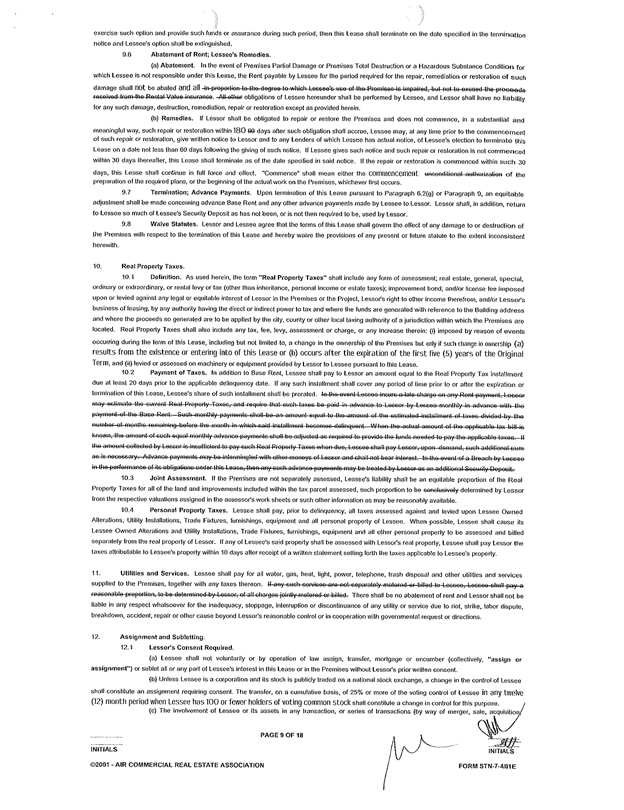
exercise such option and provide such funds or assurance during such period, then this Lease shall terminate on the date specified in the termination notice and Lessee’s option shall be extinguished.
9.6 Abatement of Rent; Lessee’s Remedies.
(a) Abatement. In the event of Premises Partial Damage or Premises Total Destruction or a Hazardous Substance Condition for which Lessee is not responsible under this Lease, the Rent payable by Lessee for the period required for the repair, remediation or restoration of such damage shall not be abated and all in proportion to the degree to which Lessee’s use of the Premises is impaired, but not to exceed the proceeds received from the Rental Value insurance. All other obligations of Lessee hereunder shall be performed by Lessee, and Lessor shall have no liability for any such damage, destruction, remediation, repair or restoration except as provided herein.
(b) Remedies. If Lessor shall be obligated to repair or restore the Premises and does not commence, in a substantial and
meaningful way, such repair or restoration within 180 90 days after such obligation shall accrue, Lessee may, at any time prior to the commencement of such repair or restoration, give written notice to Lessor and to any Lenders of which Lessee has actual notice, of Lessee’s election to terminate this Lease on a date not less than 60 days following the giving of such notice. If Lessee gives such notice and such repair or restoration is not commenced within 30 days thereafter, this Lease shall terminate as of the date specified in said notice. If the repair or restoration is commenced within such 30 days, this Lease shall continue in full force and effect. “Commence” shall mean either the commencement unconditional authorization of the preparation of the required plans, or the beginning of the actual work on the Premises, whichever first occurs.
9.7 Termination; Advance Payments. Upon termination of this Lease pursuant to Paragraph 6.2(g) or Paragraph 9, an equitable adjustment shall be made concerning advance Base Rent and any other advance payments made by Lessee to Lessor. Lessor shall, in addition, return to Lessee so much of Lessee’s Security Deposit as has not been, or is not then required to be, used by Lessor.
9.8 Waive Statutes. Lessor and Lessee agree that the terms of this Lease shall govern the effect of any damage to or destruction of the Premises with respect to the termination of this Lease and hereby waive the provisions of any present or future statute to the extent inconsistent herewith.
10. Real Property Taxes.
10.1 Definition. As used herein, the term “Real Property Taxes” shall include any form of assessment; real estate, general, special, ordinary or extraordinary, or rental levy or tax (other than inheritance, personal income or estate taxes); improvement bond; and/or license fee imposed upon or levied against any legal or equitable interest of Lessor in the Premises or the Project, Lessor’s right to other income therefrom, and/or Lessor’s business of leasing, by any authority having the direct or indirect power to tax and where the funds are generated with reference to the Building address and where the proceeds so generated are to be applied by the city, county or other local taxing authority of a jurisdiction within which the Premises are located. Real Property Taxes shall also include any tax, fee, levy, assessment or charge, or any increase therein: (i) imposed by reason of events occurring during the term of this Lease, including but not limited to, a change in the ownership of the Premises but only if such change in ownership (a)
results from the existence or entering into of this Lease or (b) occurs after the expiration of the first five (5) years of the Original
Term, and (ii) levied or assessed on machinery or equipment provided by Lessor to Lessee pursuant to this Lease.
10.2 Payment of Taxes. In addition to Base Rent, Lessee shall pay to Lessor an amount equal to the Real Property Tax installment due at least 20 days prior to the applicable delinquency date. If any such installment shall cover any period of time prior to or after the expiration or termination of this Lease, Lessee’s share of such installment shall be prorated. In the event Lessee incurs a late charge on any Rent payment, Lessor may estimate the current Real Property Taxes, and require that such taxes be paid in advance to Lessor by Lessee monthly in advance with the payment of the Base Rent. Such monthly payments shall be an amount equal to the amount of the estimated installment of taxes divided by the number of months remaining before the month in which said installment becomes delinquent. When the actual amount of the applicable tax bill is known, the amount of such equal monthly advance payments shall be adjusted as required to provide the funds needed to pay the applicable taxes. If the amount collected by Lessor is insufficient to pay such Real Property Taxes when due, Lessee shall pay Lessor, upon demand, such additional sum as is necessary. Advance payments may be intermingled with other moneys of Lessor and shall not bear interest. In the event of a Breach by Lessee in the performance of its obligations under this Lease, then any such advance payments may be treated by Lessor as an additional Security Deposit.
10.3 Joint Assessment. If the Premises are not separately assessed, Lessee’s liability shall be an equitable proportion of the Real Property Taxes for all of the land and improvements included within the tax parcel assessed, such proportion to be conclusively determined by Lessor from the respective valuations assigned in the assessor’s work sheets or such other information as may be reasonably available.
10.4 Personal Property Taxes. Lessee shall pay, prior to delinquency, all taxes assessed against and levied upon Lessee Owned Alterations, Utility Installations, Trade Fixtures, furnishings, equipment and all personal property of Lessee. When possible, Lessee shall cause its Lessee Owned Alterations and Utility Installations, Trade Fixtures, furnishings, equipment and all other personal property to be assessed and billed separately from the real property of Lessor. If any of Lessee’s said property shall be assessed with Lessor’s real property, Lessee shall pay Lessor the taxes attributable to Lessee’s property within 10 days after receipt of a written statement setting forth the taxes applicable to Lessee’s property.
11. Utilities and Services. Lessee shall pay for all water, gas, heat, light, power, telephone, trash disposal and other utilities and services supplied to the Premises, together with any taxes thereon. If any such services are not separately metered or billed to Lessee, Lessee shall pay a reasonable proportion, to be determined by Lessor, of all charges jointly metered or billed. There shall be no abatement of rent and Lessor shall not be liable in any respect whatsoever for the inadequacy, stoppage, interruption or discontinuance of any utility or service due to riot, strike, labor dispute, breakdown, accident, repair or other cause beyond Lessor’s reasonable control or in cooperation with governmental request or directions.
12. Assignment and Subletting.
12.1 Lessor’s Consent Required.
(a) Lessee shall not voluntarily or by operation of law assign, transfer, mortgage or encumber (collectively, “assign or assignment”) or sublet all or any part of Lessee’s interest in this Lease or in the Premises without Lessor’s prior written consent.
(b) Unless Lessee is a corporation and its stock is publicly traded on a national stock exchange, a change in the control of Lessee shall constitute an assignment requiring consent. The transfer, on a cumulative basis, of 25% or more of the voting control of Lessee in any twelve (12) month period when Lessee has 100 or fewer holders of voting common stock shall constitute a change in control for this purpose.
(c) The involvement of Lessee or its assets in any transaction, or series of transactions (by way of merger, sale, acquisition,
PAGE 9 OF 18
INITIALS INITIALS
©2001 - AIR COMMERCIAL REAL ESTATE ASSOCIATION FORM STN-7-4/01E
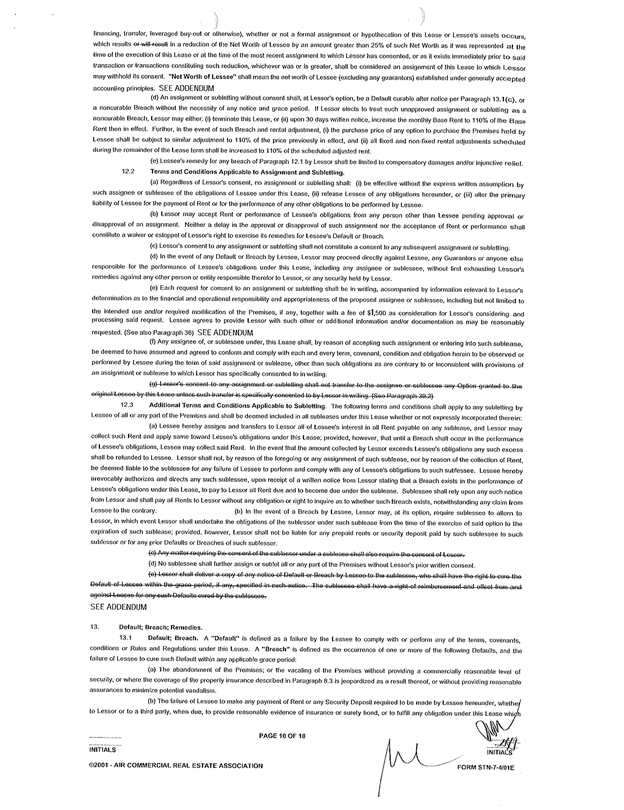
financing, transfer, leveraged buy-out or otherwise), whether or not a formal assignment or hypothecation of this Lease or Lessee’s assets occurs, which results or will result in a reduction of the Net Worth of Lessee by an amount greater than 25% of such Net Worth as it was represented at the time of the execution of this Lease or at the time of the most recent assignment to which Lessor has consented, or as it exists immediately prior to said transaction or transactions constituting such reduction, whichever was or is greater, shall be considered an assignment of this Lease to which Lessor may withhold its consent. “Net Worth of Lessee” shall mean the net worth of Lessee (excluding any guarantors) established under generally accepted accounting principles. SEE ADDENDUM
(d) An assignment or subletting without consent shall, at Lessor’s option, be a Default curable after notice per Paragraph 13.1(c), or a noncurable Breach without the necessity of any notice and grace period. If Lessor elects to treat such unapproved assignment or subletting as a noncurable Breach, Lessor may either: (i) terminate this Lease, or (ii) upon 30 days written notice, increase the monthly Base Rent to 110% of the Base Rent then in effect. Further, in the event of such Breach and rental adjustment, (i) the purchase price of any option to purchase the Premises held by Lessee shall be subject to similar adjustment to 110% of the price previously in effect, and (ii) all fixed and non-fixed rental adjustments scheduled during the remainder of the Lease term shall be increased to 110% of the scheduled adjusted rent.
(e) Lessee’s remedy for any breach of Paragraph 12.1 by Lessor shall be limited to compensatory damages and/or injunctive relief.
12.2 Terms and Conditions Applicable to Assignment and Subletting.
(a) Regardless of Lessor’s consent, no assignment or subletting shall: (i) be effective without the express written assumption by such assignee or sublessee of the obligations of Lessee under this Lease, (ii) release Lessee of any obligations hereunder, or (iii) alter the primary liability of Lessee for the payment of Rent or for the performance of any other obligations to be performed by Lessee.
(b) Lessor may accept Rent or performance of Lessee’s obligations from any person other than Lessee pending approval or disapproval of an assignment. Neither a delay in the approval or disapproval of such assignment nor the acceptance of Rent or performance shall constitute a waiver or estoppel of Lessor’s right to exercise its remedies for Lessee’s Default or Breach.
(c) Lessor’s consent to any assignment or subletting shall not constitute a consent to any subsequent assignment or subletting.
(d) In the event of any Default or Breach by Lessee, Lessor may proceed directly against Lessee, any Guarantors or anyone else responsible for the performance of Lessee’s obligations under this Lease, including any assignee or sublessee, without first exhausting Lessor’s remedies against any other person or entity responsible therefor to Lessor, or any security held by Lessor.
(e) Each request for consent to an assignment or subletting shall be in writing, accompanied by information relevant to Lessor’s determination as to the financial and operational responsibility and appropriateness of the proposed assignee or sublessee, including but not limited to the intended use and/or required modification of the Premises, if any, together with a fee of $1,500 as consideration for Lessor’s considering and processing said request. Lessee agrees to provide Lessor with such other or additional information and/or documentation as may be reasonably requested. (See also Paragraph 36) SEE ADDENDUM
(f) Any assignee of, or sublessee under, this Lease shall, by reason of accepting such assignment or entering into such sublease, be deemed to have assumed and agreed to conform and comply with each and every term, covenant, condition and obligation herein to be observed or performed by Lessee during the term of said assignment or sublease, other than such obligations as are contrary to or inconsistent with provisions of an assignment or sublease to which Lessor has specifically consented to in writing.
(g) Lesser’s consent to any assignment or subletting shall not transfer to the assignee or sublessee any Option granted to the original Lessee by this Lease unless such transfer is specifically consented to by Lesser in writing. (See Paragraph 39.2)
12.3 Additional Terms and Conditions Applicable to Subletting. The following terms and conditions shall apply to any subletting by Lessee of all or any part of the Premises and shall be deemed included in all subleases under this Lease whether or not expressly incorporated therein:
(a) Lessee hereby assigns and transfers to Lessor all of Lessee’s interest in all Rent payable on any sublease, and Lessor may collect such Rent and apply same toward Lessee’s obligations under this Lease; provided, however, that until a Breach shall occur in the performance of Lessee’s obligations, Lessee may collect said Rent. In the event that the amount collected by Lessor exceeds Lessee’s obligations any such excess shall be refunded to Lessee. Lessor shall not, by reason of the foregoing or any assignment of such sublease, nor by reason of the collection of Rent, be deemed liable to the sublessee for any failure of Lessee to perform and comply with any of Lessee’s obligations to such sublessee. Lessee hereby irrevocably authorizes and directs any such sublessee, upon receipt of a written notice from Lessor stating that a Breach exists in the performance of Lessee’s obligations under this Lease, to pay to Lessor all Rent due and to become due under the sublease. Sublessee shall rely upon any such notice from Lessor and shall pay all Rents to Lessor without any obligation or right to inquire as to whether such Breach exists, notwithstanding any claim from Lessee to the contrary. (b) In the event of a Breach by Lessee, Lessor may, at its option, require sublessee to attorn to Lessor, in which event Lessor shall undertake the obligations of the sublessor under such sublease from the time of the exercise of said option to the expiration of such sublease; provided, however, Lessor shall not be liable for any prepaid rents or security deposit paid by such sublessee to such sublessor or for any prior Defaults or Breaches of such sublessor.
(c) Any matter requiring the consent of the sublesser under a sublease shall also require the consent of Lesser.
(d) No sublessee shall further assign or sublet all or any part of the Premises without Lessor’s prior written consent.
(e) Lesser shall deliver a copy of any notice of Default or Breach by Lessee to the sublessee, who shall have the right to cure the Default of Lessee within the grace period, if any, specified in such notice. The sublessee shall have a right of reimbursement and offset from and against Lessee for any such Defaults cured by the sublessee.
SEE ADDENDUM
13. Default; Breach; Remedies.
13.1 Default; Breach. A “Default” is defined as a failure by the Lessee to comply with or perform any of the terms, covenants, conditions or Rules and Regulations under this Lease. A “Breach” is defined as the occurrence of one or more of the following Defaults, and the failure of Lessee to cure such Default within any applicable grace period:
(a) The abandonment of the Premises; or the vacating of the Premises without providing a commercially reasonable level of security, or where the coverage of the properly insurance described in Paragraph 8.3 is jeopardized as a result thereof, or without providing reasonable assurances to minimize potential vandalism.
(b) The failure of Lessee to make any payment of Rent or any Security Deposit required to be made by Lessee hereunder, whether to Lessor or to a third party, when due, to provide reasonable evidence of insurance or surety bond, or to fulfill any obligation under this Lease which
PAGE 10 OF 18
INITIALS INITIALS ©2001 - AIR COMMERCIAL REAL ESTATE ASSOCIATION FORM STN-7-4/01E
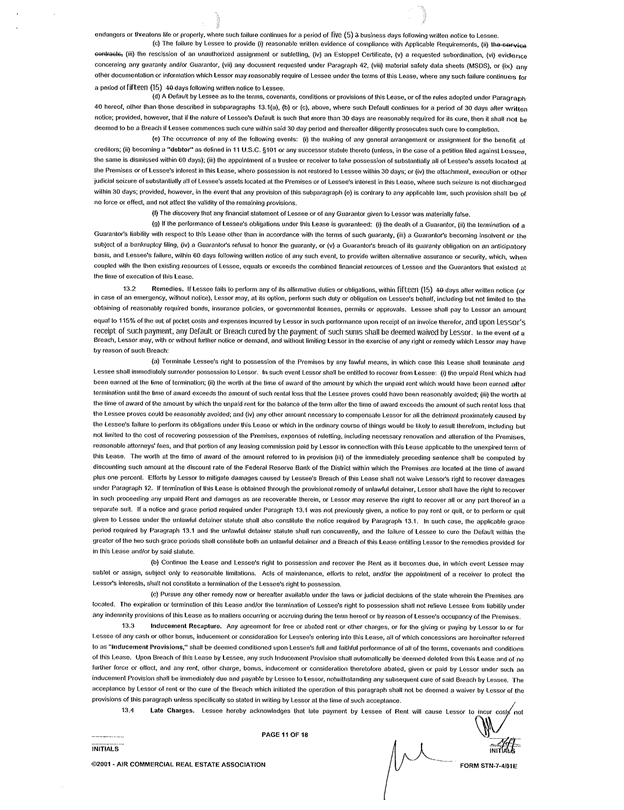
endangers or threatens life or property, where such failure continues for a period of five (5) 3 business days following written notice to Lessee.
(c) The failure by Lessee to provide (i) reasonable written evidence of compliance with Applicable Requirements, (ii) the service contracts, (iii) the rescission of an unauthorized assignment or subletting, (iv) an Estoppel Certificate, (v) a requested subordination, (vi) evidence concerning any guaranty and/or Guarantor, (vii) any document requested under Paragraph 42, (viii) material safety data sheets (MSDS), or (ix) any other documentation or information which Lessor may reasonably require of Lessee under the terms of this Lease, where any such failure continues for a period of fifteen (15) 10 days following written notice to Lessee.
(d) A Default by Lessee as to the terms, covenants, conditions or provisions of this Lease, or of the rules adopted under Paragraph 40 hereof, other than those described in subparagraphs 13.1(a), (b) or (c), above, where such Default continues for a period of 30 days after written notice; provided, however, that if the nature of Lessee’s Default is such that more than 30 days are reasonably required for its cure, then it shall not be deemed to be a Breach if Lessee commences such cure within said 30 day period and thereafter diligently prosecutes such cure to completion.
(e) The occurrence of any of the following events: (i) the making of any general arrangement or assignment for the benefit of creditors; (ii) becoming a “debtor” as defined in 11 U.S.C. §101 or any successor statute thereto (unless, in the case of a petition filed against Lessee, the same is dismissed within 60 days); (iii) the appointment of a trustee or receiver to take possession of substantially all of Lessee’s assets located at the Premises or of Lessee’s interest in this Lease, where possession is not restored to Lessee within 30 days; or (iv) the attachment, execution or other judicial seizure of substantially all of Lessee’s assets located at the Premises or of Lessee’s interest in this Lease, where such seizure is not discharged within 30 days; provided, however, in the event that any provision of this subparagraph (e) is contrary to any applicable law, such provision shall be of no force or effect, and not affect the validity of the remaining provisions.
(f) The discovery that any financial statement of Lessee or of any Guarantor given to Lessor was materially false.
(g) If the performance of Lessee’s obligations under this Lease is guaranteed: (i) the death of a Guarantor, (ii) the termination of a Guarantor’s liability with respect to this Lease other than in accordance with the terms of such guaranty, (iii) a Guarantor’s becoming insolvent or the subject of a bankruptcy filing, (iv) a Guarantor’s refusal to honor the guaranty, or (v) a Guarantor’s breach of its guaranty obligation on an anticipatory basis, and Lessee’s failure, within 60 days following written notice of any such event, to provide written alternative assurance or security, which, when coupled with the then existing resources of Lessee, equals or exceeds the combined financial resources of Lessee and the Guarantors that existed at the time of execution of this Lease.
13.2 Remedies. If Lessee fails to perform any of its affirmative duties or obligations, within fifteen (15) 10 days after written notice (or in case of an emergency, without notice), Lessor may, at its option, perform such duty or obligation on Lessee’s behalf, including but not limited to the obtaining of reasonably required bonds, insurance policies, or governmental licenses, permits or approvals. Lessee shall pay to Lessor an amount equal to 115% of the out of pocket costs and expenses incurred by Lessor in such performance upon receipt of an invoice therefor, and upon Lessor’s receipt of such payment, any Default or Breach cured by the payment of such sums shall be deemed waived by Lessor. In the event of a Breach, Lessor may, with or without further notice or demand, and without limiting Lessor in the exercise of any right or remedy which Lessor may have by reason of such Breach:
(a) Terminate Lessee’s right to possession of the Premises by any lawful means, in which case this Lease shall terminate and Lessee shall immediately surrender possession to Lessor. In such event Lessor shall be entitled to recover from Lessee: (i) the unpaid Rent which had been earned at the time of termination; (ii) the worth at the time of award of the amount by which the unpaid rent which would have been earned after termination until the time of award exceeds the amount of such rental loss that the Lessee proves could have been reasonably avoided; (iii) the worth at the time of award of the amount by which the unpaid rent for the balance of the term after the time of award exceeds the amount of such rental loss that the Lessee proves could be reasonably avoided; and (iv) any other amount necessary to compensate Lessor for all the detriment proximately caused by the Lessee’s failure to perform its obligations under this Lease or which in the ordinary course of things would be likely to result therefrom, including but not limited to the cost of recovering possession of the Premises, expenses of reletting, including necessary renovation and alteration of the Premises, reasonable attorneys’ fees, and that portion of any leasing commission paid by Lessor in connection with this Lease applicable to the unexpired term of this Lease. The worth at the time of award of the amount referred to in provision (iii) of the immediately preceding sentence shall be computed by discounting such amount at the discount rate of the Federal Reserve Bank of the District within which the Premises are located at the time of award plus one percent. Efforts by Lessor to mitigate damages caused by Lessee’s Breach of this Lease shall not waive Lessor’s right to recover damages under Paragraph 12. If termination of this Lease is obtained through the provisional remedy of unlawful detainer, Lessor shall have the right to recover in such proceeding any unpaid Rent and damages as are recoverable therein, or Lessor may reserve the right to recover all or any part thereof in a separate suit. If a notice and grace period required under Paragraph 13.1 was not previously given, a notice to pay rent or quit, or to perform or quit given to Lessee under the unlawful detainer statute shall also constitute the notice required by Paragraph 13.1. In such case, the applicable grace period required by Paragraph 13.1 and the unlawful detainer statute shall run concurrently, and the failure of Lessee to cure the Default within the greater of the two such grace periods shall constitute both an unlawful detainer and a Breach of this Lease entitling Lessor to the remedies provided for in this Lease and/or by said statute.
(b) Continue the Lease and Lessee’s right to possession and recover the Rent as it becomes due, in which event Lessee may sublet or assign, subject only to reasonable limitations. Acts of maintenance, efforts to relet, and/or the appointment of a receiver to protect the Lessor’s interests, shall not constitute a termination of the Lessee’s right to possession.
(c) Pursue any other remedy now or hereafter available under the laws or judicial decisions of the state wherein the Premises are located. The expiration or termination of this Lease and/or the termination of Lessee’s right to possession shall not relieve Lessee from liability under any indemnity provisions of this Lease as to matters occurring or accruing during the term hereof or by reason of Lessee’s occupancy of the Premises.
13.3 Inducement Recapture. Any agreement for free or abated rent or other charges, or for the giving or paying by Lessor to or for Lessee of any cash or other bonus, inducement or consideration for Lessee’s entering into this Lease, all of which concessions are hereinafter referred to as “Inducement Provisions,” shall be deemed conditioned upon Lessee’s full and faithful performance of all of the terms, covenants and conditions of this Lease. Upon Breach of this Lease by Lessee, any such Inducement Provision shall automatically be deemed deleted from this Lease and of no further force or effect, and any rent, other charge, bonus, inducement or consideration theretofore abated, given or paid by Lessor under such an inducement Provision shall be immediately due and payable by Lessee to Lessor, notwithstanding any subsequent cure of said Breach by Lessee. The acceptance by Lessor of rent or the cure of the Breach which initiated the operation of this paragraph shall not be deemed a waiver by Lessor of the provisions of this paragraph unless specifically so stated in writing by Lessor at the time of such acceptance.
13.4 Late Charges. Lessee hereby acknowledges that late payment by Lessee of Rent will cause Lessor to incur costs not
PAGE 11 OF 18
INITIALS INITIALS
©2001 - AIR COMMERCIAL REAL ESTATE ASSOCIATION FORM STN-7-4/01E
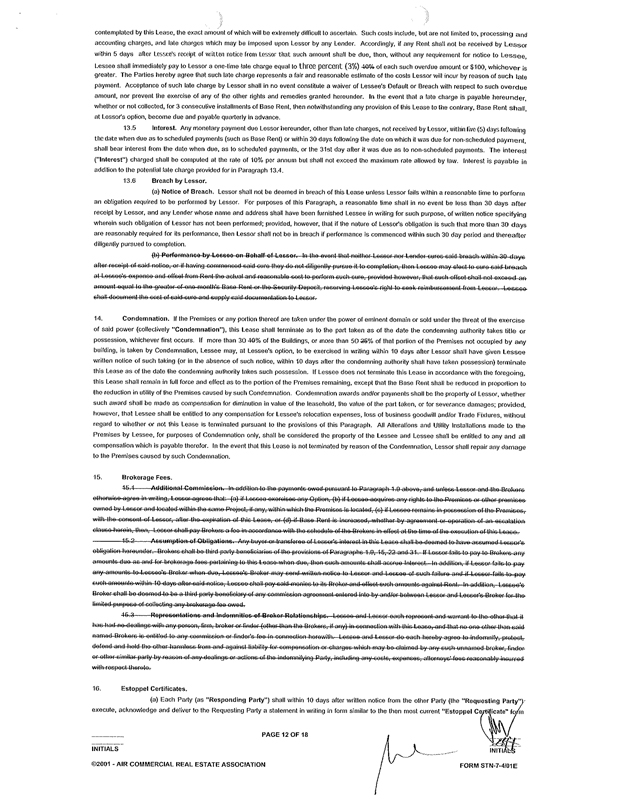
contemplated by this Lease, the exact amount of which will be extremely difficult to ascertain. Such costs include, but are not limited to, processing and accounting charges, and late charges which may be imposed upon Lessor by any Lender. Accordingly, if any Rent shall not be received by Lessor within 5 days after Lessee’s receipt of written notice from Lessor that such amount shall be due, then, without any requirement for notice to Lessee, Lessee shall immediately pay to Lessor a one-time late charge equal to three percent (3%) 10% of each such overdue amount or $100, whichever is greater. The Parties hereby agree that such late charge represents a fair and reasonable estimate of the costs Lessor will incur by reason of such late payment. Acceptance of such late charge by Lessor shall in no event constitute a waiver of Lessee’s Default or Breach with respect to such overdue amount, nor prevent the exercise of any of the other rights and remedies granted hereunder. In the event that a late charge is payable hereunder, whether or not collected, for 3 consecutive installments of Base Rent, then notwithstanding any provision of this Lease to the contrary. Base Rent shall, at Lessor’s option, become due and payable quarterly in advance.
13.5 Interest. Any monetary payment due Lessor hereunder, other than late charges, not received by Lessor, within five (5) days following the date when due as to scheduled payments (such as Base Rent) or within 30 days following the date on which it was due for non-scheduled payment, shall bear interest from the date when due, as to scheduled payments, or the 31st day after it was due as to non-scheduled payments. The interest (“Interest”) charged shall be computed at the rate of 10% per annum but shall not exceed the maximum rate allowed by law. Interest is payable in addition to the potential late charge provided for in Paragraph 13.4.
13.6 Breach by Lessor.
(a) Notice of Breach. Lessor shall not be deemed in breach of this Lease unless Lessor fails within a reasonable time to perform an obligation required to be performed by Lessor. For purposes of this Paragraph, a reasonable time shall in no event be less than 30 days after receipt by Lessor, and any Lender whose name and address shall have been furnished Lessee in writing for such purpose, of written notice specifying wherein such obligation of Lessor has not been performed; provided, however, that if the nature of Lessor’s obligation is such that more than 30 days are reasonably required for its performance, then Lessor shall not be in breach if performance is commenced within such 30 day period and thereafter diligently pursued to completion.
(b) Performance by Lessee on Behalf of Lesser, In the event that neither Lesser nor Lender cures said breach within 30 days after receipt of said notice, or if having commenced said cure they do not diligently pursue it to completion, then Lessee may elect to cure said breach at Lessee’s expense and offset from Rent the actual and reasonable cost to perform such cure, provided however, that such offset shall not exceed an amount equal to the greater of one month’s Base Rent or the Security Deposit, reserving Lessee’s right to seek reimbursement from Lesser, Lessee shall document the cost of said cure and supply said documentation to Lessor.
14. Condemnation. If the Premises or any portion thereof are taken under the power of eminent domain or sold under the threat of the exercise of said power (collectively “Condemnation”), this Lease shall terminate as to the part taken as of the date the condemning authority takes little or possession, whichever first occurs. If more than 30 10% of the Buildings, or more than 5025% of that portion of the Premises not occupied by any building, is taken by Condemnation, Lessee may, at Lessee’s option, to be exercised in writing within 10 days after Lessor shall have given Lessee written notice of such taking (or in the absence of such notice, within 10 days after the condemning authority shall have taken possession) terminate this Lease as of the date the condemning authority takes such possession. If Lessee does not terminate this Lease in accordance with the foregoing, this Lease shall remain in full force and effect as to the portion of the Premises remaining, except that the Base Rent shall be reduced in proportion to the reduction in utility of the Premises caused by such Condemnation. Condemnation awards and/or payments shall be the property of Lessor, whether such award shall be made as compensation for diminution in value of the leasehold, the value of the part taken, or for severance damages; provided, however, that Lessee shall be entitled to any compensation for Lessee’s relocation expenses, loss of business goodwill and/or Trade Fixtures, without regard to whether or not this Lease is terminated pursuant to the provisions of this Paragraph. All Alterations and Utility Installations made to the Premises by Lessee, for purposes of Condemnation only, shall be considered the property of the Lessee and Lessee shall be entitled to any and all compensation which is payable therefor. In the event that this Lease is not terminated by reason of the Condemnation, Lessor shall repair any damage to the Premises caused by such Condemnation.
15. Brokerage Fees.
15.1 Additional Commission. In addition to the payments owed pursuant to Paragraph 1.0 above, and unless Lessor and the Brokers otherwise agree in writing, Lessor agrees that: (a) if Lessee exercises any Option, (b) if Lessee acquires any rights to the Premises or other premises owned by Lessor and located within the same Project, if any, within which the Premises is located, (c) if Lessee remains in possession of the Premises, with the consent of Lessor, after the expiration of this Lease, or (d) if Base Rent is increased, whether by agreement or operation of an escalation clause herein, then, Lessor shall pay Brokers a fee in accordance with the schedule of the Brokers in effect at the time of the execution of this Lease.
15.2 Assumption of Obligations. Any buyer of transferee or Lessor’s interest in this Lease shall be deemed to have assumed Lessor’s obligations hereunder. Brokers shall be third party beneficiaries of the provisions of Paragraph 1.0, 15, 22 and 31. If Lessor fails to pay to Brokers any amount due as and for brokerage fees pertaining to this Lease when due, then such amount shall accrue Interest. In addition, if Lessor fails to pay any amount to Lessee’s Broker when due, Lessee’s Broker may send written notice to Lessor and Lessee of such failure and if Lessor fails to pay such amount within 10 days after said notice, Lessee shall pay said monies to its Broker and effect such amount against Rent. In addition, Lessee’s Broker shall be deemed to be a third party beneficiary of any commission agreement entered into by and/or between Lessor and Lessor’s Broker for the limited purpose of collecting any brokerage fee owed.
15.3 Representation and Indemnities of Broker Relationship. Lessee and Lessor each represent and warrant to the other that it has had no dealings with any person, firm, broker or finder (other than the Brokers, if any) in connection with this Lease, and that no one other than said named Brokers is entitled to any commission or finder’s fee in connection herewith. Lessee and Lessor do each hereby agree to indemnify, protect, depend and hold the other harmless from and against liability for compensation or charges which may be claimed by any such unnamed broker, finder or other similar party by reason of any dealings or actions of the indemnifying Party, including any costs, expenses attorneys’ fees reasonably incurred with respect thereto.
16. Estoppel Certificates.
(a) Each Party (as “Responding Party”) shall within 10 days after written notice from the other Party (the “Requesting Party”) execute, acknowledge and deliver to the Requesting Party a statement in writing in form similar to the then most current “Estoppel Certificate” form
PAGE 12 OF 18
INITIALS INITIALS
©2001 - AIR COMMERCIAL REAL ESTATE ASSOCIATION FORM STN-7-4/01E
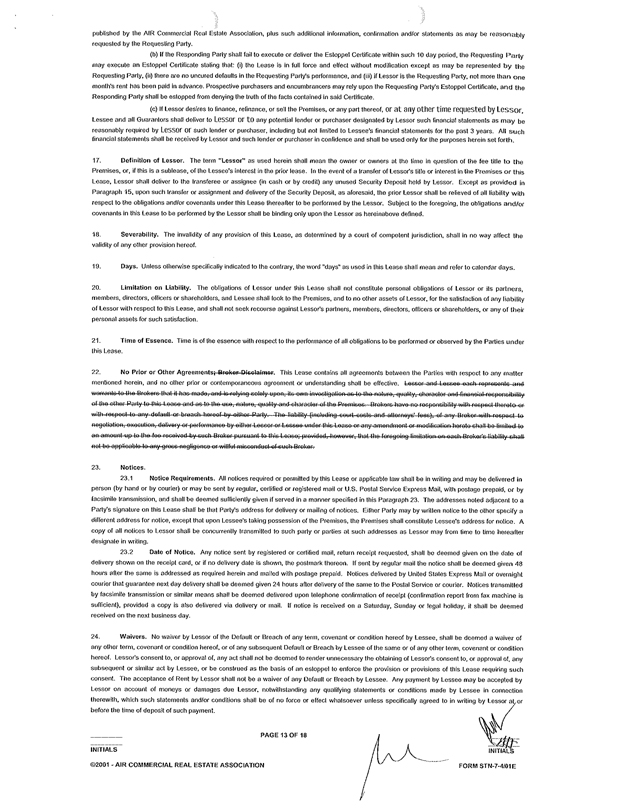
published by the AIR Commercial Real Estate Association, plus such additional information, confirmation and/or statements as may be reasonably requested by the Requesting Party.
(b) if the Responding Party shall fail to execute or deliver the Estoppel Certificate within such 10 day period, the Requesting Party may execute an Estoppel Certificate stating that: (i) the Lease is in full force and effect without modification except as may be represented by the Requesting Party, (ii) there are no uncured defaults in the Requesting Party’s performance, and (iii) if Lessor is the Requesting Party, not more than one month’s rent has been paid in advance. Prospective purchasers and encumbrancers may rely upon the Requesting Party’s Estoppel Certificate, and the Responding Party shall be estopped from denying the truth of the facts contained in said Certificate.
(c) If Lessor desires to finance, refinance, or sell the Premises, or any part thereof, or at any other time requested by Lessor, Lessee and all Guarantors shall deliver to Lessor or to any potential lender or purchaser designated by Lessor such financial statements as may be reasonably required by Lessor or such lender or purchaser, including but not limited to Lessee’s financial statements for the past 3 years. All such financial statements shall be received by Lessor and such lender or purchaser in confidence and shall be used only for the purposes herein set forth.
17. Definition of Lessor. The term “Lessor” as used herein shall mean the owner or owners at the time in question of the fee title to the Premises, or, if this is a sublease, of the Lessee’s interest in the prior lease. In the event of a transfer of Lessor’s title or interest in the Premises or this Lease, Lessor shall deliver to the transferee or assignee (in cash or by credit) any unused Security Deposit held by Lessor. Except as provided in Paragraph 15, upon such transfer or assignment and delivery of the Security Deposit, as aforesaid, the prior Lessor shall be relieved of all liability with respect to the obligations and/or covenants under this Lease thereafter to be performed by the Lessor. Subject to the foregoing, the obligations and/or covenants in this Lease to be performed by the Lessor shall be binding only upon the Lessor as hereinabove defined.
18. Severability. The invalidity of any provision of this Lease, as determined by a court of competent jurisdiction, shall in no way affect the validity of any other provision hereof.
19. Days. Unless otherwise specifically indicated to the contrary, the word “days” as used in this Lease shall mean and refer to calendar days.
20. Limitation on Liability. The obligations of Lessor under this Lease shall not constitute personal obligations of Lessor or its partners, members, directors, officers or shareholders, and Lessee shall look to the Premises, and to no other assets of Lessor, for the satisfaction of any liability of Lessor with respect to this Lease, and shall not seek recourse against Lessor’s partners, members, directors, officers or shareholders, or any of their personal assets for such satisfaction.
21. Time of Essence. Time is of the essence with respect to the performance of all obligations to be performed or observed by the Parties under this Lease.
22. No Prior or Other Agreements; Broker Disclaimer. This Lease contains all agreements between the Parties with respect to any matter mentioned herein, and no other prior or contemporaneous agreement or understanding shall be effective. Lessor and Lessee each represents and warrants to the Brokers that it has made, and is relying solely upon, its own investigation as to the nature, quality, character and financial responsibility of the other Party to this Lease and as to the use, nature, quality and character of the Premises. Brokers have no responsibility with respect thereto or with respect to any default or breach hereof by either Party. The liability (including court costs and attorneys’ fees), of any Broker with respect to negotiation, execution, delivery or performance by either Lessor or Lessee under this Lease or any amendment or modification hereto shall be limited to an amount up to the fee received by such Broker pursuant to this Lease; provided, however, that the foregoing limitation on each Broker’s liability shall not be applicable to any gross negligence or willful misconduct of such Broker.
23. Notices.
23.1 Notice Requirements. All notices required or permitted by this Lease or applicable law shall be in writing and may be delivered in person (by hand or by courier) or may be sent by regular, certified or registered mail or U.S. Postal Service Express Mail, with postage prepaid, or by facsimile transmission, and shall be deemed sufficiently given if served in a manner specified in this Paragraph 23. The addresses noted adjacent to a Party’s signature on this Lease shall be that Party’s address for delivery or mailing of notices. Either Party may by written notice to the other specify a different address for notice, except that upon Lessee’s taking possession of the Premises, the Premises shall constitute Lessee’s address for notice. A copy of all notices to Lessor shall be concurrently transmitted to such party or parties at such addresses as Lessor may from time to time hereafter designate in writing.
23.2 Date of Notice. Any notice sent by registered or certified mail, return receipt requested, shall be deemed given on the date of delivery shown on the receipt card, or if no delivery date is shown, the postmark thereon. If sent by regular mail the notice shall be deemed given 48 hours after the same is addressed as required herein and mailed with postage prepaid. Notices delivered by United States Express Mail or overnight courier that guarantee next day delivery shall be deemed given 24 hours after delivery of the same to the Postal Service or courier. Notices transmitted by facsimile transmission or similar means shall be deemed delivered upon telephone confirmation of receipt (confirmation report from fax machine is sufficient), provided a copy is also delivered via delivery or mail. If notice is received on a Saturday, Sunday or legal holiday, it shall be deemed received on the next business day.
24. Waivers. No waiver by Lessor of the Default or Breach of any term, covenant or condition hereof by Lessee, shall be deemed a waiver of any other term, covenant or condition hereof, or of any subsequent Default or Breach by Lessee of the same or of any other term, covenant or condition hereof. Lessor’s consent to, or approval of, any act shall not be deemed to render unnecessary the obtaining of Lessor’s consent to, or approval of, any subsequent or similar act by Lessee, or be construed as the basis of an estoppel to enforce the provision or provisions of this Lease requiring such consent. The acceptance of Rent by Lessor shall not be a waiver of any Default or Breach by Lessee. Any payment by Lessee may be accepted by Lessor on account of moneys or damages due Lessor, notwithstanding any qualifying statements or conditions made by Lessee in connection therewith, which such statements and/or conditions shall be of no force or effect whatsoever unless specifically agreed to in writing by Lessor at or before the time of deposit of such payment.
PAGE 13 OF 18
INITIALS INITIALS
©2001 - AIR COMMERCIAL REAL ESTATE ASSOCIATION FORM STN-7-4/01E
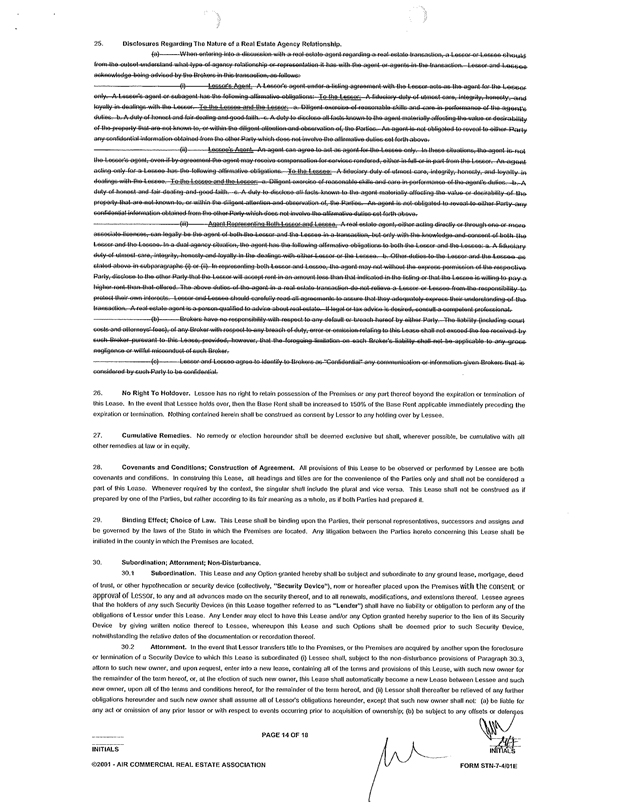
25. Disclosures Regarding The Nature of a Real Estate Agency Relationship.
(a) When entering into a discussion with a real estate agent regarding a real estate transaction, a Lessor or Lessee should from the outset understand what type of agency relationship of representation it has with the agent or agents in the transaction. Lessor and Lessee acknowledge being advised by the Brokers in this transaction, as follows:
(i) Lessor’s Agent. A Lessor’s agent under a listing agreement with the Lessor acts as the agent for the Lessor
only. A Lessor’s agent or subagent has the following affirmative obligations; To the Lessor: A fiduciary duty of utmost care, integrity, honesty, and loyalty in dealings with the Lessor. To the Lessee and the Lessor: a. Diligent exercise of reasonable skills and care in performance of the agent’s duties. b. A duty of honest and fair dealing and good faith. c. A duty to disclose all facts known to the agent materially affecting the value or desirability of the property that are not known to, or within the diligent attention and observation of, the Parties. An agent is not obligated to reveal to either Party any confidential information obtained from the other Party which does not involve the affirmative duties set forth above.
(ii) Lessee’s Agent. An agent can agree to act as agent for the Lessee only. In these situations, the agent is not the Lessor’s agent, even if by agreement the agent may receive compensation for services rendered, either in full or in part from the Lessor. An agent acting only for a Lessee has the following affirmative obligations. To the Lessee: A fiduciary duty of utmost care, integrity, honesty, and loyalty in
dealings with the Lessee. To the Lessee and the Lessor: a. Diligent exercise of reasonable skills and care in performance of the agent’s duties. b. A duty of honest and fair dealing and good faith. c. A duty to disclose all facts known to the agent materially affecting the value or desirability of the property that are not known to, or within the diligent attention and observation of, the Parties. An agent is not obligated to reveal to either Party any confidential information obtained from the other Party which does not involve the affirmative duties set forth above. (iii) Agent Representing Both Lessor and Lessee. A real estate agent, either acting directly or through one or more associate licenses, can legally be the agent of both the Lessor and the Lessee in a transaction, but only with the knowledge and consent of both the Lessor and the Lessee. In a dual agency situation, the agent has the following affirmative obligations to both the Lessor and the Lessee: a. A fiduciary duty of utmost care, integrity, honesty and loyalty in the dealings with either Lessor or the Lessee. b. Other duties to the Lessor and the Lessee as stated above in subparagraphs (i) or (ii). In representing both Lessor and Lessee, the agent may not without the express permission of the respective Party, disclose to the other Party that the Lessor will accept rent in an amount less than that indicated in the listing or that the Lessee is willing to pay a higher rent than that offered. The above duties of the agent in a real estate transaction do not relieve a Lessor or Lessee from the responsibility to protect their own interests. Lessor and Lessee should carefully read all agreements to assure that they adequately express their understanding of the transaction. A real estate agent is a person qualified to advise about real estate. If legal or tax advice is desired, consult a competent professional.
(b) Brokers have no responsibility with respect to any default or breach hereof by either Party. The liability (including court costs and attorneys’ fees), of any Broker with respect to any breach of duty, error or emission relating to this Lease shall not exceed the fee received by such Broker pursuant to this Lease; provided, however, that the foregoing limitation on each Broker’s liability shall not be applicable to any gross negligence or willful misconduct of such Broker.
(c) Lessor and Lessee agree to identify to Brokers as “Confidential” any communication or information given Brokers that is considered by such Party to be confidential.
26. No Right To Holdover. Lessee has no right to retain possession of the Premises or any part thereof beyond the expiration or termination of this Lease. In the event that Lessee holds over, then the Base Rent shall be increased to 150% of the Base Rent applicable immediately preceding the expiration or termination. Nothing contained herein shall be construed as consent by Lessor to any holding over by Lessee.
27. Cumulative Remedies. No remedy or election hereunder shall be deemed exclusive but shall, wherever possible, be cumulative with all other remedies at law or in equity.
28. Covenants and Conditions; Construction of Agreement. All provisions of this Lease to be observed or performed by Lessee are both covenants and conditions. In construing this Lease, all headings and titles are for the convenience of the Parties only and shall not be considered a part of this Lease. Whenever required by the context, the singular shall include the plural and vice versa. This Lease shall not be construed as if prepared by one of the Parties, but rather according to its fair meaning as a whole, as if both Parties had prepared it.
29. Binding Effect; Choice of Law. This Lease shall be binding upon the Parties, their personal representatives, successors and assigns and be governed by the laws of the State in which the Premises are located. Any litigation between the Parties hereto concerning this Lease shall be initiated in the county in which the Premises are located.
30. Subordination; Attornment; Non-Disturbance.
30.1 Subordination. This Lease and any Option granted hereby shall be subject and subordinate to any ground lease, mortgage, deed of trust, or other hypothecation or security device (collectively, “Security Device”), now or hereafter placed upon the Premises with the consent or approval of Lessor, to any and all advances made on the security thereof, and to all renewals, modifications, and extensions thereof. Lessee agrees that the holders of any such Security Devices (in this Lease together referred to as “Lender”) shall have no liability or obligation to perform any of the obligations of Lessor under this Lease. Any Lender may elect to have this Lease and/or any Option granted hereby superior to the lien of its Security Device by giving written notice thereof to Lessee, whereupon this Lease and such Options shall be deemed prior to such Security Device, notwithstanding the relative dates of the documentation or recordation thereof.
30.2 Attornment. In the event that Lessor transfers title to the Premises, or the Premises are acquired by another upon the foreclosure or termination of a Security Device to which this Lease is subordinated (i) Lessee shall, subject to the non-disturbance provisions of Paragraph 30.3, attorn to such new owner, and upon request, enter into a new lease, containing all of the terms and provisions of this Lease, with such new owner for the remainder of the term hereof, or, at the election of such new owner, this Lease shall automatically become a new Lease between Lessee and such new owner, upon all of the terms and conditions hereof, for the remainder of the term hereof, and (ii) Lessor shall thereafter be relieved of any further obligations hereunder and such new owner shall assume all of Lessor’s obligations hereunder, except that such new owner shall not: (a) be liable for any act or omission of any prior lessor or with respect to events occurring prior to acquisition of ownership; (b) be subject to any offsets or defenses
PAGE 14 OF 18
INITIALS INITIALS
©2001 - AIR COMMERCIAL REAL ESTATE ASSOCIATION FORM STN-7-4/01E
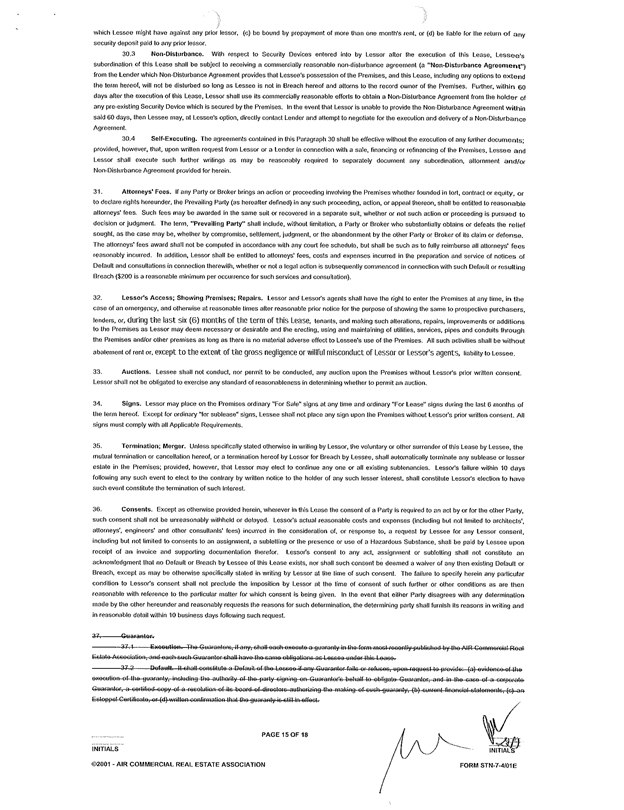
which Lessee might have against any prior lessor, (c) be bound by prepayment of more than one month’s rent, or (d) be liable for the return of any security deposit paid to any prior lessor.
30.3 Non-Disturbance. With respect to Security Devices entered into by Lessor after the execution of this Lease, Lessee’s subordination of this Lease shall be subject to receiving a commercially reasonable non-disturbance agreement (a “Non-Disturbance Agreement”) from the Lender which Non-Disturbance Agreement provides that Lessee’s possession of the Premises, and this Lease, including any options to extend the term hereof, will not be disturbed so long as Lessee is not in Breach hereof and attorns to the record owner of the Premises. Further, within 60 days after the execution of this Lease, Lessor shall use its commercially reasonable efforts to obtain a Non-Disturbance Agreement from the holder of any pre-existing Security Device which is secured by the Premises. In the event that Lessor is unable to provide the Non-Disturbance Agreement within said 60 days, then Lessee may, at Lessee’s option, directly contact Lender and attempt to negotiate for the execution and delivery of a Non-Disturbance Agreement.
30.4 Self-Executing. The agreements contained in this Paragraph 30 shall be effective without the execution of any further documents; provided, however, that, upon written request from Lessor or a Lender in connection with a sale, financing or refinancing of the Premises, Lessee and Lessor shall execute such further writings as may be reasonably required to separately document any subordination, attornment and/or Non-Disturbance Agreement provided for herein.
31. Attorneys’ Fees. If any Party or Broker brings an action or proceeding involving the Premises whether founded in tort, contract or equity, or to declare rights hereunder, the Prevailing Party (as hereafter defined) in any such proceeding, action, or appeal thereon, shall be entitled to reasonable attorneys’ fees. Such fees may be awarded in the same suit or recovered in a separate suit, whether or not such action or proceeding is pursued to decision or judgment. The term, “Prevailing Party” shall include, without limitation, a Party or Broker who substantially obtains or defeats the relief sought, as the case may be, whether by compromise, settlement, judgment, or the abandonment by the other Party or Broker of its claim or defense. The attorneys’ fees award shall not be computed in accordance with any court fee schedule, but shall be such as to fully reimburse all attorneys’ fees reasonably incurred. In addition, Lessor shall be entitled to attorneys’ fees, costs and expenses incurred in the preparation and service of notices of Default and consultations in connection therewith, whether or not a legal action is subsequently commenced in connection with such Default or resulting Breach ($200 is a reasonable minimum per occurrence for such services and consultation).
32. Lessor’s Access; Showing Premises; Repairs. Lessor and Lessor’s agents shall have the right to enter the Premises at any time, in the case of an emergency, and otherwise at reasonable times after reasonable prior notice for the purpose of showing the same to prospective purchasers, lenders, or, during the last six (6) months of the term of this Lease, tenants, and making such alterations, repairs, improvements or additions to the Premises as Lessor may deem necessary or desirable and the erecting, using and maintaining of utilities, services, pipes and conduits through the Premises and/or other premises as long as there is no material adverse effect to Lessee’s use of the Premises. All such activities shall be without abatement of rent or, except to the extent of the gross negligence or willful misconduct of Lessor or Lessor’s agents, liability to Lessee.
33. Auctions. Lessee shall not conduct, nor permit to be conducted, any auction upon the Premises without Lessor’s prior written consent. Lessor shall not be obligated to exercise any standard of reasonableness in determining whether to permit an auction.
34. Signs. Lessor may place on the Premises ordinary “For Sale” signs at any time and ordinary “For Lease” signs during the last 6 months of the term hereof. Except for ordinary “for sublease” signs, Lessee shall not place any sign upon the Premises without Lessor’s prior written consent. All signs must comply with all Applicable Requirements.
35. Termination; Merger. Unless specifically stated otherwise in writing by Lessor, the voluntary or other surrender of this Lease by Lessee, the mutual termination or cancellation hereof, or a termination hereof by Lessor for Breach by Lessee, shall automatically terminate any sublease or lesser estate in the Premises; provided, however, that Lessor may elect to continue any one or all existing subtenancies. Lessor’s failure within 10 days following any such event to elect to the contrary by written notice to the holder of any such lesser interest, shall constitute Lessor’s election to have such event constitute the termination of such interest.
36. Consents. Except as otherwise provided herein, wherever in this Lease the consent of a Party is required to an act by or for the other Party, such consent shall not be unreasonably withheld or delayed. Lessor’s actual reasonable costs and expenses (including but not limited to architects’, attorneys’, engineers’ and other consultants’ fees) incurred in the consideration of, or response to, a request by Lessee for any Lessor consent, including but not limited to consents to an assignment, a subletting or the presence or use of a Hazardous Substance, shall be paid by Lessee upon receipt of an invoice and supporting documentation therefor. Lessor’s consent to any act, assignment or subletting shall not constitute an acknowledgment that no Default or Breach by Lessee of this Lease exists, nor shall such consent be deemed a waiver of any then existing Default or Breach, except as may be otherwise specifically stated in writing by Lessor at the time of such consent. The failure to specify herein any particular condition to Lessor’s consent shall not preclude the imposition by Lessor at the time of consent of such further or other conditions as are then reasonable with reference to the particular matter for which consent is being given. In the event that either Party disagrees with any determination made by the other hereunder and reasonably requests the reasons for such determination, the determining party shall furnish its reasons in writing and in reasonable detail within 10 business days following such request.
37. Guarantor.
37.1 Execution. The Guarantors, if any; shall each execute a guaranty in the form most recently published by the AIR Commercial Real Estate Association, and each such Guarantor shall have the same obligations as Lessee under this Lease.
37.2 Default. It shall constitute a Default of the Lessee if any Guarantor fails or refuses, upon request to provide: (a) evidence of the execution of the guaranty, including the authority of the party signing on Guarantor’s behalf to obligate Guarantor, and in the case of a corporate Guarantor, a certified copy of a resolution of its board of directors authorizing the making of such guaranty, (b) current financial statements, (c) an Estoppel Certificate, or (d) written confirmation that the guaranty is still in effect.
PAGE 15 OF 18
INITIALS INITIALS
©2001 - AIR COMMERCIAL REAL ESTATE ASSOCIATION FORM STN-7-4/01E
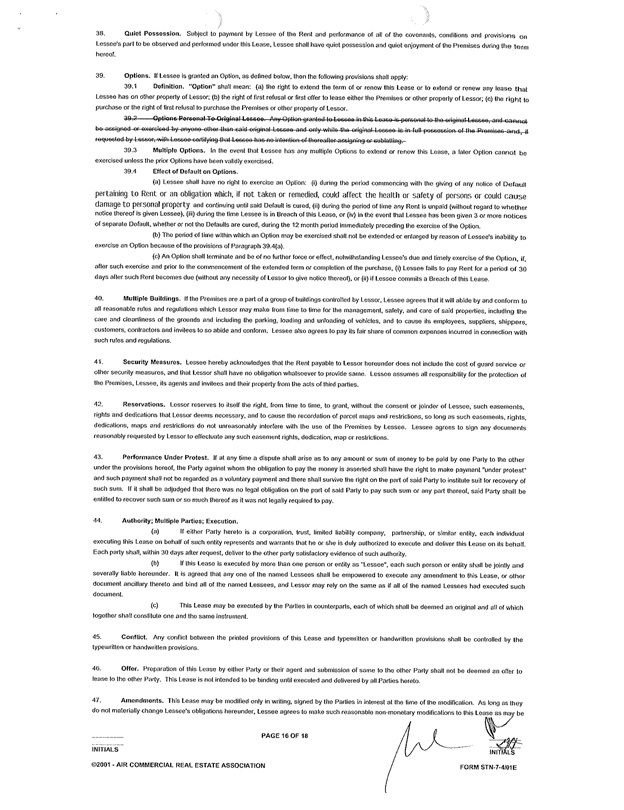
38. Quiet Possession. Subject to payment by Lessee of the Rent and performance of all of the covenants, conditions and provisions on Lessee’s part to be observed and performed under this Lease, Lessee shall have quiet possession and quiet enjoyment of the Premises during the term hereof.
39. Options. If Lessee is granted an Option, as defined below, then the following provisions shall apply:
39.1 Definition. “Option” shall mean: (a) the right to extend the term of or renew this Lease or to extend or renew any lease that Lessee has on other property of Lessor; (b) the right of first refusal or first offer to lease either the Premises or other property of Lessor; (c) the right to purchase or the right of first refusal to purchase the Premises or other property of Lessor.
39.2 Options Personal To Original Lessee. Any Option granted to Lessee in this Lease is personal to the original Lessee, and cannot be assigned or exercised by anyone other than said original Lessee and only while the original Lessee is in full possession of the Premises and, if requested by Lessor, with Lessee certifying that Lessee has no intention of thereafter assigning or subletting.
39.3 Multiple Options. In the event that Lessee has any multiple Options to extend or renew this Lease, a later Option cannot be exercised unless the prior Options have been validly exercised.
39.4 Effect of Default on Options.
(a) Lessee shall have no right to exercise an Option: (i) during the period commencing with the giving of any notice of Default pertaining to Rent or an obligation which, if not taken or remedied, could affect the health or safety of persons or could cause damage to personal property and continuing until said Default is cured, (ii) during the period of time any Rent is unpaid (without regard to whether notice thereof is given Lessee), (iii) during the time Lessee is in Breach of this Lease, or (iv) in the event that Lessee has been given 3 or more notices of separate Default, whether or not the Defaults are cured, during the 12 month period immediately preceding the exercise of the Option.
(b) The period of time within which an Option may be exercised shall not be extended or enlarged by reason of Lessee’s inability to exercise an Option because of the provisions of Paragraph 39.4(a).
(c) An Option shall terminate and be of no further force or effect, notwithstanding Lessee’s due and timely exercise of the Option, if, after such exercise and prior to the commencement of the extended term or completion of the purchase, (i) Lessee fails to pay Rent for a period of 30 days after such Rent becomes due (without any necessity of Lessor to give notice thereof), or (ii) if Lessee commits a Breach of this Lease.
40. Multiple Buildings. If the Premises are a part of a group of buildings controlled by Lessor, Lessee agrees that it will abide by and conform to all reasonable rules and regulations which Lessor may make from time to time for the management, safety, and care of said properties, including the care and cleanliness of the grounds and including the parking, loading and unloading of vehicles, and to cause its employees, suppliers, shippers, customers, contractors and invitees to so abide and conform. Lessee also agrees to pay its fair share of common expenses incurred in connection with such rules and regulations.
41. Security Measures. Lessee hereby acknowledges that the Rent payable to Lessor hereunder does not include the cost of guard service or other security measures, and that Lessor shall have no obligation whatsoever to provide same. Lessee assumes all responsibility for the protection of the Premises, Lessee, its agents and invitees and their property from the acts of third parties.
42. Reservations. Lessor reserves to itself the right, from time to time, to grant, without the consent or joinder of Lessee, such easements, rights and dedications that Lessor deems necessary, and to cause the recordation of parcel maps and restrictions, so long as such easements, rights, dedications, maps and restrictions do not unreasonably interfere with the use of the Premises by Lessee. Lessee agrees to sign any documents reasonably requested by Lessor to effectuate any such easement rights, dedication, map or restrictions.
43. Performance Under Protest. If at any time a dispute shall arise as to any amount or sum of money to be paid by one Party to the other under the provisions hereof, the Party against whom the obligation to pay the money is asserted shall have the right to make payment “under protest” and such payment shall not be regarded as a voluntary payment and there shall survive the right on the part of said Party to institute suit for recovery of such sum. If it shall be adjudged that there was no legal obligation on the part of said Party to pay such sum or any part thereof, said Party shall be entitled to recover such sum or so much thereof as it was not legally required to pay.
44. Authority; Multiple Parties; Execution.
(a) If either Party hereto is a corporation, trust, limited liability company, partnership, or similar entity, each individual executing this Lease on behalf of such entity represents and warrants that he or she is duly authorized to execute and deliver this Lease on its behalf. Each party shall, within 30 days after request, deliver to the other party satisfactory evidence of such authority.
(b) If this Lease is executed by more than one person or entity as “Lessee”, each such person or entity shall be jointly and severally liable hereunder. It is agreed that any one of the named Lessees shall be empowered to execute any amendment to this Lease, or other document ancillary thereto and bind all of the named Lessees, and Lessor may rely on the same as if all of the named Lessees had executed such document.
(c) This Lease may be executed by the Parties in counterparts, each of which shall be deemed an original and all of which together shall constitute one and the same instrument.
45. Conflict. Any conflict between the printed provisions of this Lease and typewritten or handwritten provisions shall be controlled by the typewritten or handwritten provisions.
46. Offer. Preparation of this Lease by either Party or their agent and submission of same to the other Party shall not be deemed an offer to lease to the other Party. This Lease is not intended to be binding until executed and delivered by all Parties hereto.
47. Amendments. This Lease may be modified only in writing, signed by the Parties in interest at the time of the modification. As long as they do not materially change Lessee’s obligations hereunder, Lessee agrees to make such reasonable non-monetary modifications to this Lease as may be
PAGE 16 OF 18
INITIALS INITIALS
©2001 - AIR COMMERCIAL REAL ESTATE ASSOCIATION FORM STN-7-4/01E
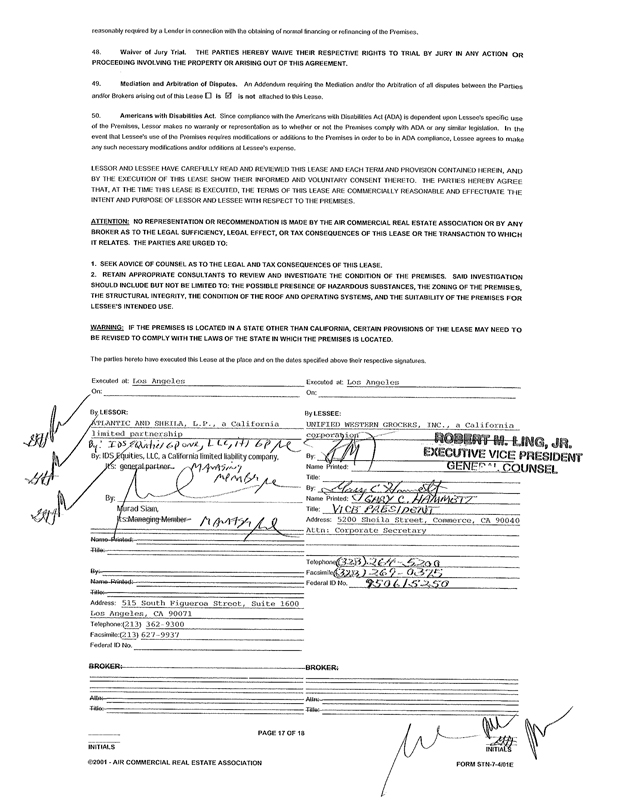
reasonably required by a Lender in connection with the obtaining of normal financing or refinancing of the Premises.
48. Waiver of Jury Trial. THE PARTIES HEREBY WAIVE THEIR RESPECTIVE RIGHTS TO TRIAL BY JURY IN ANY ACTION OR PROCEEDING INVOLVING THE PROPERTY OR ARISING OUT OF THIS AGREEMENT.
49. Mediation and Arbitration of Disputes. An Addendum requiring the Mediation and/or the Arbitration of all disputes between the Parties and/or Brokers arising out of this Lease is is not attached to this Lease.
50. Americans with Disabilities Act. Since compliance with the Americans with Disabilities Act (ADA) is dependent upon Lessee’s specific use of the Premises, Lessor makes no warranty or representation as to whether or not the Premises comply with ADA or any similar legislation. In the event that Lessee’s use of the Premises requires modifications or additions to the Premises in order to be in ADA compliance, Lessee agrees to make any such necessary modifications and/or additions at Lessee’s expense.
LESSOR AND LESSEE HAVE CAREFULLY READ AND REVIEWED THIS LEASE AND EACH TERM AND PROVISION CONTAINED HEREIN, AND BY THE EXECUTION OF THIS LEASE SHOW THEIR INFORMED AND VOLUNTARY CONSENT THERETO. THE PARTIES HEREBY AGREE THAT, AT THE TIME THIS LEASE IS EXECUTED, THE TERMS OF THIS LEASE ARE COMMERCIALLY REASONABLE AND EFFECTUATE THE INTENT AND PURPOSE OF LESSOR AND LESSEE WITH RESPECT TO THE PREMISES.
ATTENTION: NO REPRESENTATION OR RECOMMENDATION IS MADE BY THE AIR COMMERCIAL REAL ESTATE ASSOCIATION OR BY ANY BROKER AS TO THE LEGAL SUFFICIENCY, LEGAL EFFECT, OR TAX CONSEQUENCES OF THIS LEASE OR THE TRANSACTION TO WHICH IT RELATES. THE PARTIES ARE URGED TO:
1. SEEK ADVICE OF COUNSEL AS TO THE LEGAL AND TAX CONSEQUENCES OF THIS LEASE.
2. RETAIN APPROPRIATE CONSULTANTS TO REVIEW AND INVESTIGATE THE CONDITION OF THE PREMISES. SAID INVESTIGATION SHOULD INCLUDE BUT NOT BE LIMITED TO: THE POSSIBLE PRESENCE OF HAZARDOUS SUBSTANCES, THE ZONING OF THE PREMISES, THE STRUCTURAL INTEGRITY, THE CONDITION OF THE ROOF AND OPERATING SYSTEMS, AND THE SUITABILITY OF THE PREMISES FOR LESSEE’S INTENDED USE.
WARNING: IF THE PREMISES IS LOCATED IN A STATE OTHER THAN CALIFORNIA, CERTAIN PROVISIONS OF THE LEASE MAY NEED TO BE REVISED TO COMPLY WITH THE LAWS OF THE STATE IN WHICH THE PREMISES IS LOCATED.
The parties hereto have executed this Lease at the place and on the dates specified above their respective signatures.
Executed at: Los Angeles Executed at: Los Angeles
On: On:
By LESSOR:
ATLANTIC AND SHEILA, L.P., a California limited partnership
By: IDS Equities GP One, LLC, its GP
By: IDS Equities, LLC, a California limited liability company,
Its: general partner Managing Member
By:
Murad Siam, Its: Managing Member Manager
Name Printed:
Title:
By:
Name Printed:
Title:
Address: 515 South Figueroa Street, Suite 1600
Los Angeles, CA 90071
Telephone: (213) 362-9300
Facsimile: (213) 627-9937
Federal ID No.
BROKER
Attn:
Title:
Executed at: Los Angeles
On:
By LESSEE:
UNIFIED WESTERN GROCERS, INC., a California corporation
By: ROBERT M. LING, JR.
Name Printed: EXECUTIVE VICE PRESIDENT
Title: GENERAL COUNSEL
By: Gary C. Hammett
Name Printed: GARY C. HAMMETT
Title: VICE PRESIDENT
Address: 5200 Sheila Street, Commerce, CA 90040
Attn: Corporate Secretary
Telephone: (323) 264-5200
Facsimile: (323) 269-0375
Federal ID No. 950615250
BROKER:
Attn:
Title:
PAGE 17 OF 18
INITIALS
©2001 - AIR COMMERCIAL REAL ESTATE ASSOCIATION
INITIALS
FORM STN-7-4/01E
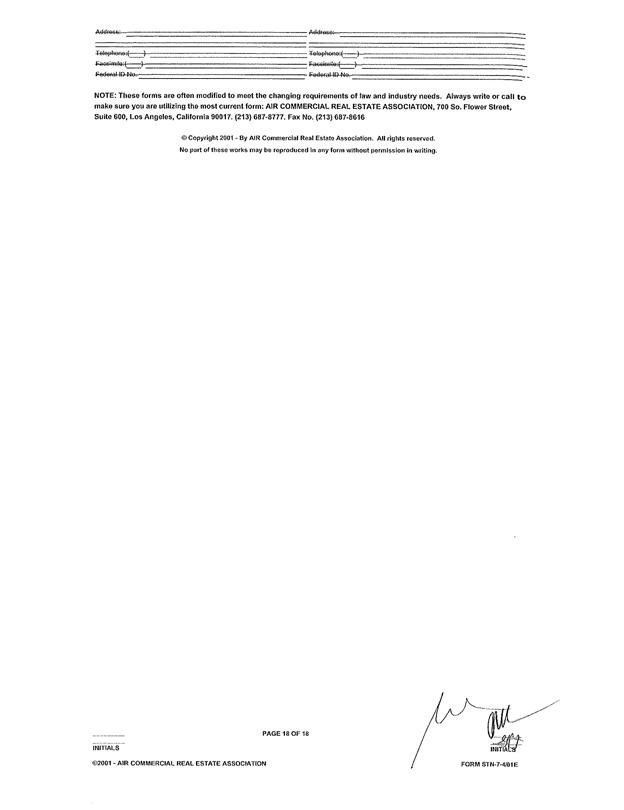
Address: Address:
Telephone:() Telephone:()
Facsimile: () Facsimile: ()
Federal ID No. Federal ID No.
NOTE: These forms are often modified to meet the changing requirements of law and industry needs. Always write or call to make sure you are utilizing the most current form: AIR COMMERCIAL REAL ESTATE ASSOCIATION, 700 So. Flower Street,
Suite 600, Los Angeles, California 90017. (213) 687-8777. Fax No. (213) 687-8616
© Copyright 2001 - By AIR Commercial Real Estate Association. All rights reserved.
No part of these works may be reproduced in any form without permission in writing.
PAGE 18 OF 18
INITIALS
©2001 - AIR COMMERCIAL REAL ESTATE ASSOCIATION
INITIALS
FORM STN-7-4/01E
Exhibit 10.4.1
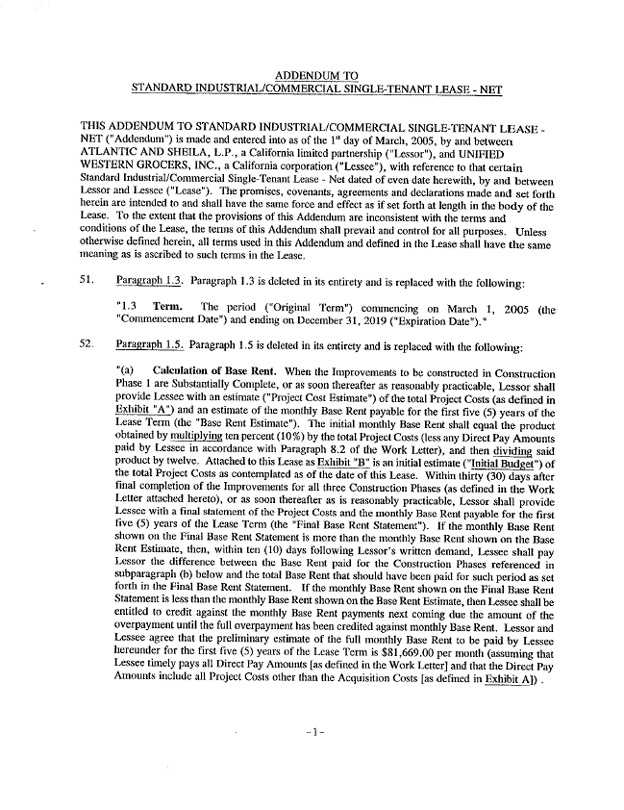
ADDENDUM TO
STANDARD INDUSTRIAL/COMMERCIAL SINGLE-TENANT LEASE-NET
THIS ADDENDUM TO STANDARD INDUSTRIAL/COMMERCIAL SINGLE-TENANT LEASE-NET (“Addendum”) is made and entered into as of the 1st day of March, 2005, by and between ATLANTIC AND SHEILA, L.P., a California limited partnership (“Lessor”), and UNIFIED WESTERN GROCERS, INC., a California corporation (“Lessee”), with reference to that certain Standard Industrial/Commercial Single-Tenant Lease - Net dated of even date herewith, by and between Lessor and Lessee (“Lease”). The promises, covenants, agreements and declarations made and set forth herein are intended to and shall have the same force and effect as if set forth at length in the body of the Lease. To the extent that the provisions of this Addendum are inconsistent with the terms and conditions of the Lease, the terms of this Addendum shall prevail and control for all purposes. Unless otherwise defined herein, all terms used in this Addendum and defined in the Lease shall have the same meaning as is ascribed to such terms in the Lease.
51. Paragraph 1.3. Paragraph 1.3 is deleted in its entirety and is replaced with the following:
“1.3 Term. The period (“Original Term”) commencing on March 1, 2005 (the “Commencement Date”) and ending on December 31, 2019 (“Expiration Date”).”
52. Paragraph 1.5. Paragraph 1.5 is deleted in its entirety and is replaced with the following:
“(a) Calculation of Base Rent. When the Improvements to be constructed in Construction Phase 1 are Substantially Complete, or as soon thereafter as reasonably practicable, Lessor shall provide Lessee with an estimate (“Project Cost Estimate”) of the total Project Costs (as defined in Exhibit “A”) and an estimate of the monthly Base Rent payable for the first five (5) years of the Lease Term (the “Base Rent Estimate”). The initial monthly Base Rent shall equal the product obtained by multiplying ten percent (10%) by the total Project Costs (less any Direct Pay Amounts paid by Lessee in accordance with Paragraph 8.2 of the Work Letter), and then dividing said product by twelve. Attached to this Lease as Exhibit “B” is an initial estimate (“Initial Budget”) of the total Project Costs as contemplated as of the date of this Lease. Within thirty (30) days after final completion of the Improvements for all three Construction Phases (as defined in the Work Letter attached hereto), or as soon thereafter as is reasonably practicable, Lessor shall provide Lessee with a final statement of the Project Costs and the monthly Base Rent payable for the first five (5) years of the Lease Term (the “Final Base Rent Statement”). If the monthly Base Rent shown on the Final Base Rent Statement is more than the monthly Base Rent shown on the Base Rent Estimate, then, within ten (10) days following Lessor’s written demand, Lessee shall pay Lessor the difference between the Base Rent paid for the Construction Phases referenced in subparagraph (b) below and the total Base Rent that should have been paid for such period as set forth in the Final Base Rent Statement. If the monthly Base Rent shown on the Final Base Rent Statement is less than the monthly Base Rent shown on the Base Rent Estimate, then Lessee shall be entitled to credit against the monthly Base Rent payments next coming due the amount of the overpayment until the full overpayment has been credited against monthly Base Rent. Lessor and Lessee agree that the preliminary estimate of the full monthly Base Rent to be paid by Lessee hereunder for the first five (5) years of the Lease Term is $81,669.00 per month (assuming that Lessee timely pays all Direct Pay Amounts [as defined in the Work Letter] and that the Direct Pay Amounts include all Project Costs other than the Acquisition Costs [as defined in Exhibit A]).
-1-
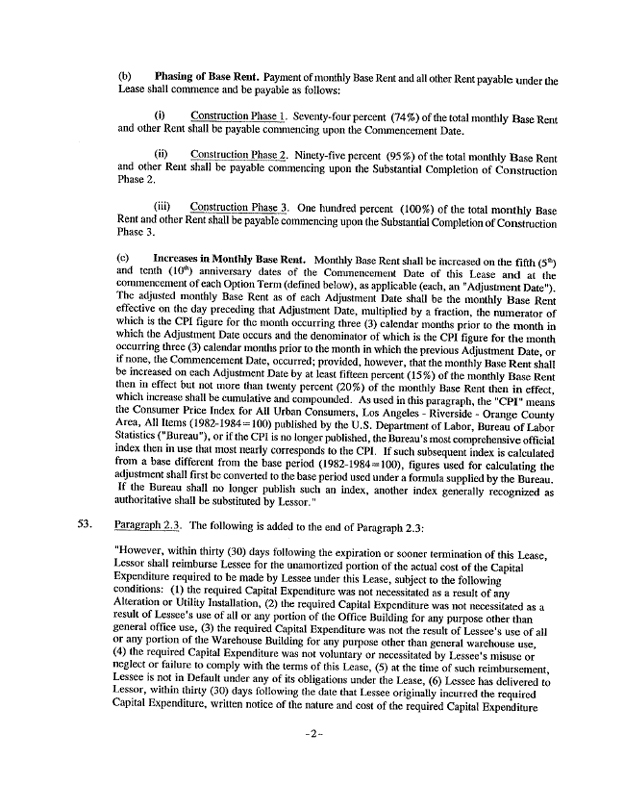
(b) Phasing of Base Rent. Payment of monthly Base Rent and all other Rent payable under the Lease shall commence and be payable as follows:
(i) Construction Phase 1. Seventy-four percent (74%) of the total monthly Base Rent and other Rent shall be payable commencing upon the Commencement Date.
(ii) Construction Phase 2. Ninety-five percent (95%) of the total monthly Base Rent and other Rent shall be payable commencing upon the Substantial Completion of Construction Phase 2.
(iii) Construction Phase 3. One hundred percent (100%) of the total monthly Base Rent and other Rent shall be payable commencing upon the Substantial Completion of Construction Phase 3.
(c) Increases in Monthly Base Rent. Monthly Base Rent shall be increased on the fifth (5th) and tenth (10th) anniversary dates of the Commencement Date of this Lease and at the commencement of each Option Term (defined below), as applicable (each, an “Adjustment Date”). The adjusted monthly Base Rent as of each Adjustment Date shall be the monthly Base Rent effective on the day preceding that Adjustment Date, multiplied by a fraction, the numerator of which is the CPI figure for the month occurring three (3) calendar months prior to the month in which the Adjustment Date occurs and the denominator of which is the CPI figure for the month occurring three (3) calendar months prior to the month in which the previous Adjustment Date, or if none, the Commencement Date, occurred; provided, however, that the monthly Base Rent shall be increased on each Adjustment Date by at least fifteen percent (15%) of the monthly Base Rent then in effect but not more than twenty percent (20%) of the monthly Base Rent then in effect, which increase shall be cumulative and compounded. As used in this paragraph, the “CPI” means the Consumer Price Index for All Urban Consumers, Los Angeles - Riverside - Orange County Area, All Items (1982-1984 = 100) published by the U.S. Department of Labor, Bureau of Labor Statistics (“Bureau”), or if the CPI is no longer published, the Bureau’s most comprehensive official index then in use that most nearly corresponds to the CPI. If such subsequent index is calculated from a base different from the base period (1982-1984 = 100), figures used for calculating the adjustment shall first be converted to the base period used under a formula supplied by the Bureau. If the Bureau shall no longer publish such an index, another index generally recognized as authoritative shall be substituted by Lessor.”
53. Paragraph 2.3. The following is added to the end of Paragraph 2.3:
“However, within thirty (30) days following the expiration or sooner termination of this Lease, Lessor shall reimburse Lessee for the unamortized portion of the actual cost of the Capital Expenditure required to be made by Lessee under this Lease, subject to the following conditions: (1) the required Capital Expenditure was not necessitated as a result of any Alteration or Utility Installation, (2) the required Capital Expenditure was not necessitated as a result of Lessee’s use of all or any portion of the Office Building for any purpose other than general office use, (3) the required Capital Expenditure was not the result of Lessee’s use of all or any portion of the Warehouse Building for any purpose other than general warehouse use, (4) the required Capital Expenditure was not voluntary or necessitated by Lessee’s misuse or neglect or failure to comply with the terms of this Lease, (5) at the time of such reimbursement, Lessee is not in Default under any of its obligations under the Lease, (6) Lessee has delivered to Lessor, within thirty (30) days following the date that Lessee originally incurred the required Capital Expenditure, written notice of the nature and cost of the required Capital Expenditure
-2-
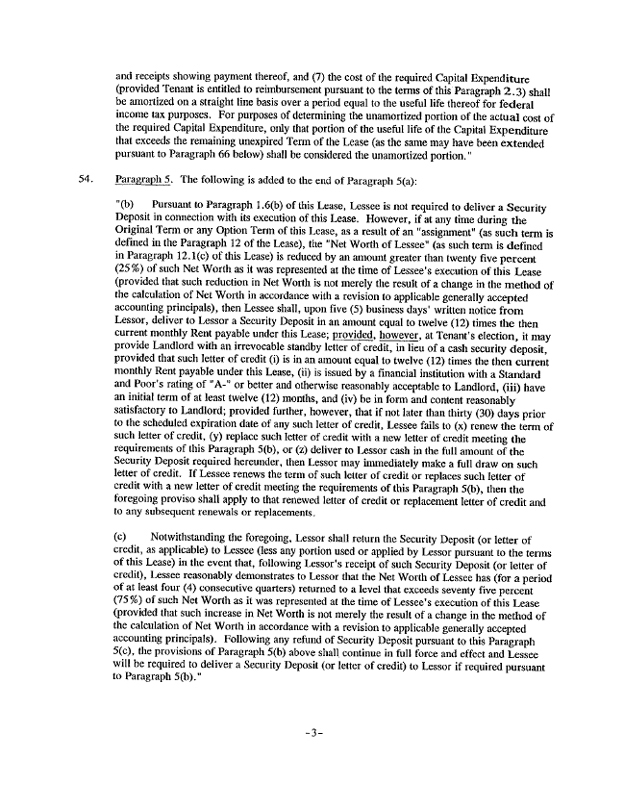
and receipts showing payment thereof, and (7) the cost of the required Capital Expenditure (provided Tenant is entitled to reimbursement pursuant to the terms of this Paragraph 2.3) shall be amortized on a straight line basis over a period equal to the useful life thereof for federal income tax purposes. For purposes of determining the unamortized portion of the actual cost of the required Capital Expenditure, only that portion of the useful life of the Capital Expenditure that exceeds the remaining unexpired Term of the Lease (as the same may have been extended pursuant to Paragraph 66 below) shall be considered the unamortized portion.”
54. Paragraph 5. The following is added to the end of Paragraph 5(a):
“(b) Pursuant to Paragraph 1.6(b) of this Lease, Lessee is not required to deliver a Security Deposit in connection with its execution of this Lease. However, if at any time during the Original Term or any Option Term of this Lease, as a result of an “assignment” (as such term is defined in the Paragraph 12 of the Lease), the “Net Worth of Lessee” (as such term is defined in Paragraph 12.1(c) of this Lease) is reduced by an amount greater than twenty five percent (25%) of such Net Worth as it was represented at the time of Lessee’s execution of this Lease (provided that such reduction in Net Worth is not merely the result of a change in the method of the calculation of Net Worth in accordance with a revision to applicable generally accepted accounting principals), then Lessee shall, upon five (5) business days’ written notice from Lessor, deliver to Lessor a Security Deposit in an amount equal to twelve (12) times the then current monthly Rent payable under this Lease; provided, however, at Tenant’s election, it may provide Landlord with an irrevocable standby letter of credit, in lieu of a cash security deposit, provided that such letter of credit (i) is in an amount equal to twelve (12) times the then current monthly Rent payable under this Lease, (ii) is issued by a financial institution with a Standard and Poor’s rating of “A-” or better and otherwise reasonably acceptable to Landlord, (iii) have an initial term of at least twelve (12) months, and (iv) be in form and content reasonably satisfactory to Landlord; provided further, however, that if not later than thirty (30) days prior to the scheduled expiration date of any such letter of credit, Lessee fails to (x) renew the term of such letter of credit, (y) replace such letter of credit with a new letter of credit meeting the requirements of this Paragraph 5(b), or (z) deliver to Lessor cash in the full amount of the Security Deposit required hereunder, then Lessor may immediately make a full draw on such letter of credit. If Lessee renews the term of such letter of credit or replaces such letter of credit with a new letter of credit meeting the requirements of this Paragraph 5(b), then the foregoing proviso shall apply to that renewed letter of credit or replacement letter of credit and to any subsequent renewals or replacements.
(c) Notwithstanding the foregoing, Lessor shall return the Security Deposit (or letter of credit, as applicable) to Lessee (less any portion used or applied by Lessor pursuant to the terms of this Lease) in the event that, following Lessor’s receipt of such Security Deposit (or letter of credit), Lessee reasonably demonstrates to Lessor that the Net Worth of Lessee has (for a period of at least four (4) consecutive quarters) returned to a level that exceeds seventy five percent (75%) of such Net Worth as it was represented at the time of Lessee’s execution of this Lease (provided that such increase in Net Worth is not merely the result of a change in the method of the calculation of Net Worth in accordance with a revision to applicable generally accepted accounting principals). Following any refund of Security Deposit pursuant to this Paragraph 5(c), the provisions of Paragraph 5(b) above shall continue in full force and effect and Lessee will be required to deliver a Security Deposit (or letter of credit) to Lessor if required pursuant to Paragraph 5(b).”
-3-
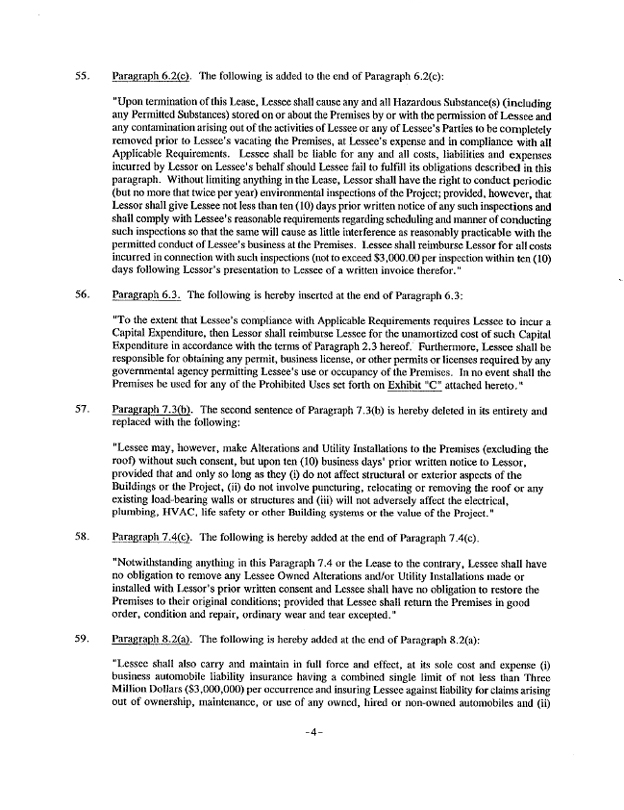
55. Paragraph 6.2(c). The following is added to the end of Paragraph 6.2(c):
“Upon termination of this Lease, Lessee shall cause any and all Hazardous Substance(s) (including any Permitted Substances) stored on or about the Premises by or with the permission of Lessee and any contamination arising out of the activities of Lessee or any of Lessee’s Parties to be completely removed prior to Lessee’s vacating the Premises, at Lessee’s expense and in compliance with all Applicable Requirements. Lessee shall be liable for any and all costs, liabilities and expenses incurred by Lessor on Lessee’s behalf should Lessee fail to fulfill its obligations described in this paragraph. Without limiting anything in the Lease, Lessor shall have the right to conduct periodic (but no more that twice per year) environmental inspections of the Project; provided, however, that Lessor shall give Lessee not less than ten (10) days prior written notice of any such inspections and shall comply with Lessee’s reasonable requirements regarding scheduling and manner of conducting such inspections so that the same will cause as little interference as reasonably practicable with the permitted conduct of Lessee’s business at the Premises. Lessee shall reimburse Lessor for all costs incurred in connection with such inspections (not to exceed $3,000.00 per inspection within ten (10) days following Lessor’s presentation to Lessee of a written invoice therefor.”
56. Paragraph 6.3. The following is hereby inserted at the end of Paragraph 6.3:
“To the extent that Lessee’s compliance with Applicable Requirements requires Lessee to incur a Capital Expenditure, then Lessor shall reimburse Lessee for the unamortized cost of such Capital Expenditure in accordance with the terms of Paragraph 2.3 hereof. Furthermore, Lessee shall be responsible for obtaining any permit, business license, or other permits or licenses required by any governmental agency permitting Lessee’s use or occupancy of the Premises. In no event shall the Premises be used for any of the Prohibited Uses set forth on Exhibit “C” attached hereto.”
57. Paragraph 7.3(b). The second sentence of Paragraph 7.3(b) is hereby deleted in its entirety and replaced with the following:
“Lessee may, however, make Alterations and Utility Installations to the Premises (excluding the roof) without such consent, but upon ten (10) business days’ prior written notice to Lessor, provided that and only so long as they (i) do not affect structural or exterior aspects of the Buildings or the Project, (ii) do not involve puncturing, relocating or removing the roof or any existing load-bearing walls or structures and (iii) will not adversely affect the electrical, plumbing, HVAC, life safety or other Building systems or the value of the Project.”
58. Paragraph 7.4(c). The following is hereby added at the end of Paragraph 7.4(c).
“Notwithstanding anything in this Paragraph 7.4 or the Lease to the contrary, Lessee shall have no obligation to remove any Lessee Owned Alterations and/or Utility Installations made or installed with Lessor’s prior written consent and Lessee shall have no obligation to restore the Premises to their original conditions; provided that Lessee shall return the Premises in good order, condition and repair, ordinary wear and tear excepted.”
59. Paragraph 8.2(a). The following is hereby added at the end of Paragraph 8.2(a):
“Lessee shall also carry and maintain in full force and effect, at its sole cost and expense (i) business automobile liability insurance having a combined single limit of not less than Three Million Dollars ($3,000,000) per occurrence and insuring Lessee against liability for claims arising out of ownership, maintenance, or use of any owned, hired or non-owned automobiles and (ii)
-4-
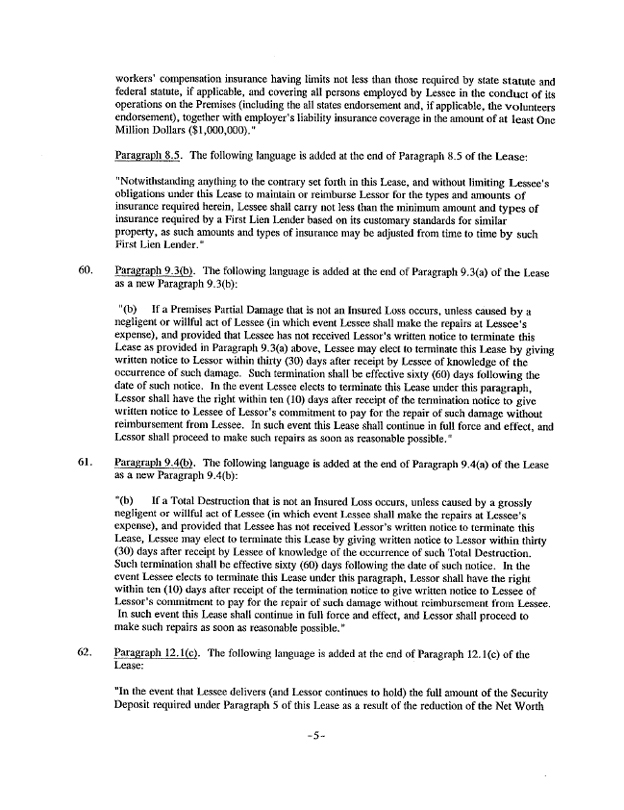
workers’ compensation insurance having limits not less than those required by state statute and federal statute, if applicable, and covering all persons employed by Lessee in the conduct of its operations on the Premises (including the all states endorsement and, if applicable, the volunteers endorsement), together with employer’s liability insurance coverage in the amount of at least One Million Dollars ($1,000,000).”
Paragraph 8.5. The following language is added at the end of Paragraph 8.5 of the Lease:
“Notwithstanding anything to the contrary set forth in this Lease, and without limiting Lessee’s obligations under this Lease to maintain or reimburse Lessor for the types and amounts of insurance required herein, Lessee shall carry not less than the minimum amount and types of insurance required by a First Lien Lender based on its customary standards for similar property, as such amounts and types of insurance may be adjusted from time to time by such First Lien Lender.”
60. Paragraph 9.3(b). The following language is added at the end of Paragraph 9.3(a) of the Lease as a new Paragraph 9.3(b):
“(b) If a Premises Partial Damage that is not an Insured Loss occurs, unless caused by a negligent or willful act of Lessee (in which event Lessee shall make the repairs at Lessee’s expense), and provided that Lessee has not received Lessor’s written notice to terminate this Lease as provided in Paragraph 9.3(a) above, Lessee may elect to terminate this Lease by giving written notice to Lessor within thirty (30) days after receipt by Lessee of knowledge of the occurrence of such damage. Such termination shall be effective sixty (60) days following the date of such notice. In the event Lessee elects to terminate this Lease under this paragraph, Lessor shall have the right within ten (10) days after receipt of the termination notice to give written notice to Lessee of Lessor’s commitment to pay for the repair of such damage without reimbursement from Lessee. In such event this Lease shall continue in full force and effect, and Lessor shall proceed to make such repairs as soon as reasonable possible.”
61. Paragraph 9.4(b). The following language is added at the end of Paragraph 9.4(a) of the Lease as a new Paragraph 9.4(b):
“(b) If a Total Destruction that is not an Insured Loss occurs, unless caused by a grossly negligent or willful act of Lessee (in which event Lessee shall make the repairs at Lessee’s expense), and provided that Lessee has not received Lessor’s written notice to terminate this Lease, Lessee may elect to terminate this Lease by giving written notice to Lessor within thirty (30) days after receipt by Lessee of knowledge of the occurrence of such Total Destruction. Such termination shall be effective sixty (60) days following the date of such notice. In the event Lessee elects to terminate this Lease under this paragraph, Lessor shall have the right within ten (10) days after receipt of the termination notice to give written notice to Lessee of Lessor’s commitment to pay for the repair of such damage without reimbursement from Lessee. In such event this Lease shall continue in full force and effect, and Lessor shall proceed to make such repairs as soon as reasonable possible.”
62. Paragraph 12.1(c). The following language is added at the end of Paragraph 12.1(c) of the Lease:
“In the event that Lessee delivers (and Lessor continues to hold) the full amount of the Security Deposit required under Paragraph 5 of this Lease as a result of the reduction of the Net Worth
-5-
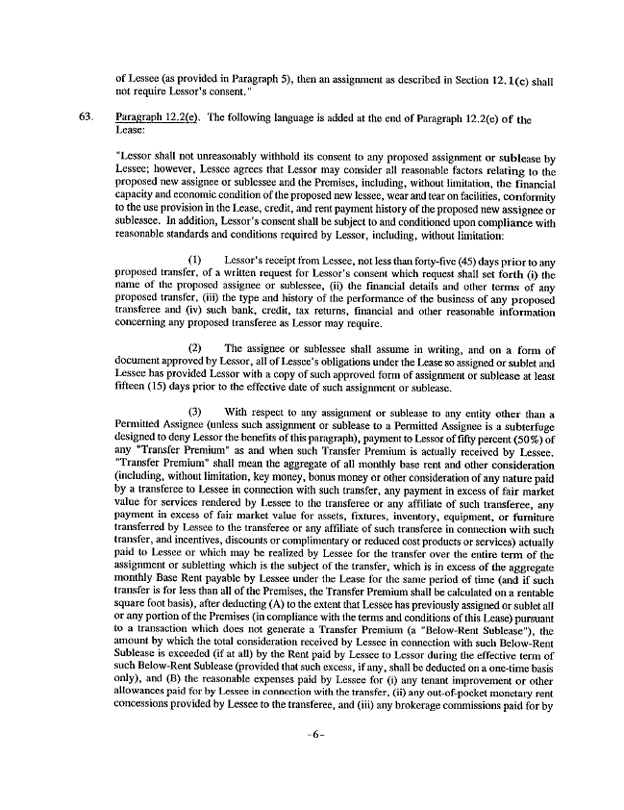
of Lessee (as provided in Paragraph 5), then an assignment as described in Section 12.1(c) shall not require Lessor’s consent,”
63. Paragraph 12.2(e). The following language is added at the end of Paragraph 12.2(e) of the Lease:
“Lessor shall not unreasonably withhold its consent to any proposed assignment or sublease by Lessee; however, Lessee agrees that Lessor may consider all reasonable factors relating to the proposed new assignee or sublessee and the Premises, including, without limitation, the financial capacity and economic condition of the proposed new lessee, wear and tear on facilities, conformity to the use provision in the Lease, credit, and rent payment history of the proposed new assignee or sublessee. In addition, Lessor’s consent shall be subject to and conditioned upon compliance with reasonable standards and conditions required by Lessor, including, without limitation:
(1) Lessor’s receipt from Lessee, not less than forty-five (45) days prior to any proposed transfer, of a written request for Lessor’s consent which request shall set forth (i) the name of the proposed assignee or sublessee, (ii) the financial details and other terms of any proposed transfer, (iii) the type and history of the performance of the business of any proposed transferee and (iv) such bank, credit, tax returns, financial and other reasonable information concerning any proposed transferee as Lessor may require.
(2) The assignee or sublessee shall assume in writing, and on a form of document approved by Lessor, all of Lessee’s obligations under the Lease so assigned or sublet and Lessee has provided Lessor with a copy of such approved form of assignment or sublease at least fifteen (15) days prior to the effective date of such assignment or sublease.
(3) With respect to any assignment or sublease to any entity other than a Permitted Assignee (unless such assignment or sublease to a Permitted Assignee is a subterfuge designed to deny Lessor the benefits of this paragraph), payment to Lessor of fifty percent (50%) of any “Transfer Premium” as and when such Transfer Premium is actually received by Lessee. “Transfer Premium” shall mean the aggregate of all monthly base rent and other consideration (including, without limitation, key money, bonus money or other consideration of any nature paid by a transferee to Lessee in connection with such transfer, any payment in excess of fair market value for services rendered by Lessee to the transferee or any affiliate of such transferee, any payment in excess of fair market value for assets, fixtures, inventory, equipment, or furniture transferred by Lessee to the transferee or any affiliate of such transferee in connection with such transfer, and incentives, discounts or complimentary or reduced cost products or services) actually paid to Lessee or which may be realized by Lessee for the transfer over the entire term of the assignment or subletting which is the subject of the transfer, which is in excess of the aggregate monthly Base Rent payable by Lessee under the Lease for the same period of time (and if such transfer is for less than all of the Premises, the Transfer Premium shall be calculated on a rentable square foot basis), after deducting (A) to the extent that Lessee has previously assigned or sublet all or any portion of the Premises (in compliance with the terms and conditions of this Lease) pursuant to a transaction which does not generate a Transfer Premium (a “Below-Rent Sublease”), the amount by which the total consideration received by Lessee in connection with such Below-Rent Sublease is exceeded (if at all) by the Rent paid by Lessee to Lessor during the effective term of such Below-Rent Sublease (provided that such excess, if any, shall be deducted on a one-time basis only), and (B) the reasonable expenses paid by Lessee for (i) any tenant improvement or other allowances paid for by Lessee in connection with the transfer, (ii) any out-of-pocket monetary rent concessions provided by Lessee to the transferee, and (iii) any brokerage commissions paid for by
-6-
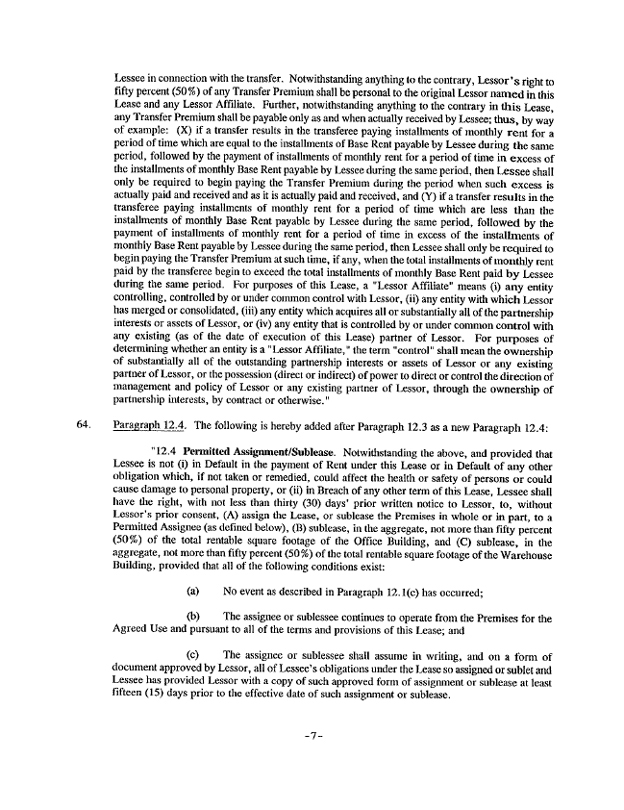
Lessee in connection with the transfer. Notwithstanding anything to the contrary, Lessor’s right to fifty percent (50%) of any Transfer Premium shall be personal to the original Lessor named in this Lease and any Lessor Affiliate. Further, notwithstanding anything to the contrary in this Lease, any Transfer Premium shall be payable only as and when actually received by Lessee; thus, by way of example: (X) if a transfer results in the transferee paying installments of monthly rent for a period of time which are equal to the installments of Base Rent payable by Lessee during the same period, followed by the payment of installments of monthly rent for a period of time in excess of the installments of monthly Base Rent payable by Lessee during the same period, then Lessee shall only be required to begin paying the Transfer Premium during the period when such excess is actually paid and received and as it is actually paid and received, and (Y) if a transfer results in the transferee paying installments of monthly rent for a period of time which are less than the installments of monthly Base Rent payable by Lessee during the same period, followed by the payment of installments of monthly rent for a period of time in excess of the installments of monthly Base Rent payable by Lessee during the same period, then Lessee shall only be required to begin paying the Transfer Premium at such time, if any, when the total installments of monthly rent paid by the transferee begin to exceed the total installments of monthly Base Rent paid by Lessee during the same period. For purposes of this Lease, a “Lessor Affiliate” means (i) any entity controlling, controlled by or under common control with Lessor, (ii) any entity with which Lessor has merged or consolidated, (iii) any entity which acquires all or substantially all of the partnership interests or assets of Lessor, or (iv) any entity that is controlled by or under common control with any existing (as of the date of execution of this Lease) partner of Lessor. For purposes of determining whether an entity is a “Lessor Affiliate,” the term “control” shall mean the ownership of substantially all of the outstanding partnership interests or assets of Lessor or any existing partner of Lessor, or the possession (direct or indirect) of power to direct or control the direction of management and policy of Lessor or any existing partner of Lessor, through the ownership of partnership interests, by contract or otherwise.”
64. Paragraph 12.4. The following is hereby added after Paragraph 12.3 as a new Paragraph 12.4:
“12.4 Permitted Assignment/Sublease. Notwithstanding the above, and provided that Lessee is not (i) in Default in the payment of Rent under this Lease or in Default of any other obligation which, if not taken or remedied, could affect the health or safety of persons or could cause damage to personal property, or (ii) in Breach of any other term of this Lease, Lessee shall have the right, with not less than thirty (30) days’ prior written notice to Lessor, to, without Lessor’s prior consent, (A) assign the Lease, or sublease the Premises in whole or in part, to a Permitted Assignee (as defined below), (B) sublease, in the aggregate, not more than fifty percent (50%) of the total rentable square footage of the Office Building, and (C) sublease, in the aggregate, not more than fifty percent (50%) of the total rentable square footage of the Warehouse Building, provided that all of the following conditions exist:
(a) No event as described in Paragraph 12.1(c) has occurred;
(b) The assignee or sublessee continues to operate from the Premises for the Agreed Use and pursuant to all of the terms and provisions of this Lease; and
(c) The assignee or sublessee shall assume in writing, and on a form of document approved by Lessor, all of Lessee’s obligations under the Lease so assigned or sublet and Lessee has provided Lessor with a copy of such approved form of assignment or sublease at least fifteen (15) days prior to the effective date of such assignment or sublease.
-7-
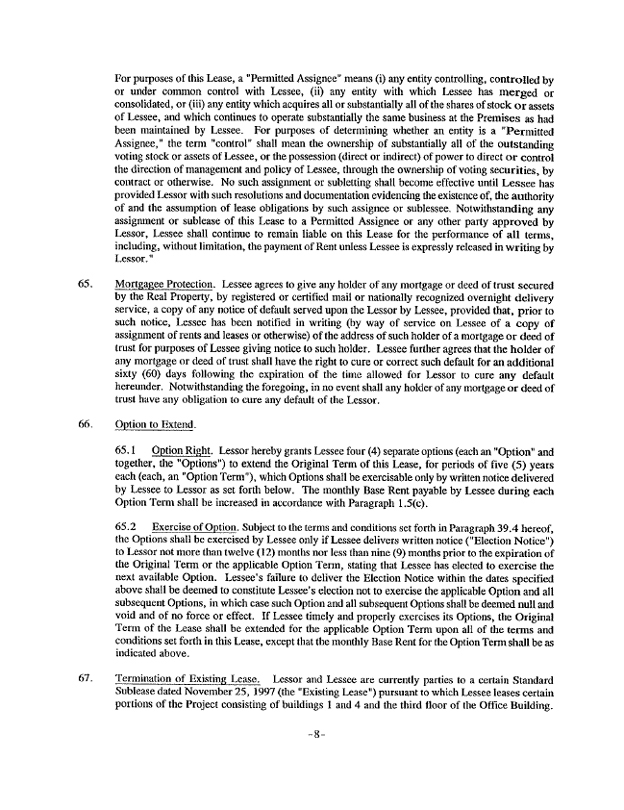
For purposes of this Lease, a “Permitted Assignee” means (i) any entity controlling, controlled by or under common control with Lessee, (ii) any entity with which Lessee has merged or consolidated, or (iii) any entity which acquires all or substantially all of the shares of stock or assets of Lessee, and which continues to operate substantially the same business at the Premises as had been maintained by Lessee. For purposes of determining whether an entity is a “Permitted Assignee,” the term “control” shall mean the ownership of substantially all of the outstanding voting stock or assets of Lessee, or the possession (direct or indirect) of power to direct or control the direction of management and policy of Lessee, through the ownership of voting securities, by contract or otherwise. No such assignment or subletting shall become effective until Lessee has provided Lessor with such resolutions and documentation evidencing the existence of, the authority of and the assumption of lease obligations by such assignee or sublessee. Notwithstanding any assignment or sublease of this Lease to a Permitted Assignee or any other party approved by Lessor, Lessee shall continue to remain liable on this Lease for the performance of all terms, including, without limitation, the payment of Rent unless Lessee is expressly released in writing by Lessor.”
65. Mortgagee Protection. Lessee agrees to give any holder of any mortgage or deed of trust secured by the Real Property, by registered or certified mail or nationally recognized overnight delivery service, a copy of any notice of default served upon the Lessor by Lessee, provided that, prior to such notice, Lessee has been notified in writing (by way of service on Lessee of a copy of assignment of rents and leases or otherwise) of the address of such holder of a mortgage or deed of trust for purposes of Lessee giving notice to such holder. Lessee further agrees that the holder of any mortgage or deed of trust shall have the right to cure or correct such default for an additional sixty (60) days following the expiration of the time allowed for Lessor to cure any default hereunder. Notwithstanding the foregoing, in no event shall any holder of any mortgage or deed of trust have any obligation to cure any default of the Lessor.
66. Option to Extend.
65.1 Option Right. Lessor hereby grants Lessee four (4) separate options (each an “Option” and together, the “Options”) to extend the Original Term of this Lease, for periods of five (5) years each (each, an “Option Term”), which Options shall be exercisable only by written notice delivered by Lessee to Lessor as set forth below. The monthly Base Rent payable by Lessee during each Option Term shall be increased in accordance with Paragraph 1.5(c).
65.2 Exercise of Option. Subject to the terms and conditions set forth in Paragraph 39.4 hereof, the Options shall be exercised by Lessee only if Lessee delivers written notice (“Election Notice”) to Lessor not more than twelve (12) months nor less than nine (9) months prior to the expiration of the Original Term or the applicable Option Term, stating that Lessee has elected to exercise the next available Option. Lessee’s failure to deliver the Election Notice within the dates specified above shall be deemed to constitute Lessee’s election not to exercise the applicable Option and all subsequent Options, in which case such Option and all subsequent Options shall be deemed null and void and of no force or effect. If Lessee timely and properly exercises its Options, the Original Term of the Lease shall be extended for the applicable Option Term upon all of the terms and conditions set forth in this Lease, except that the monthly Base Rent for the Option Term shall be as indicated above.
67. Termination of Existing Lease. Lessor and Lessee are currently parties to a certain Standard Sublease dated November 25, 1997 (the “Existing Lease”) pursuant to which Lessee leases certain portions of the Project consisting of buildings 1 and 4 and the third floor of the Office Building.
-8-
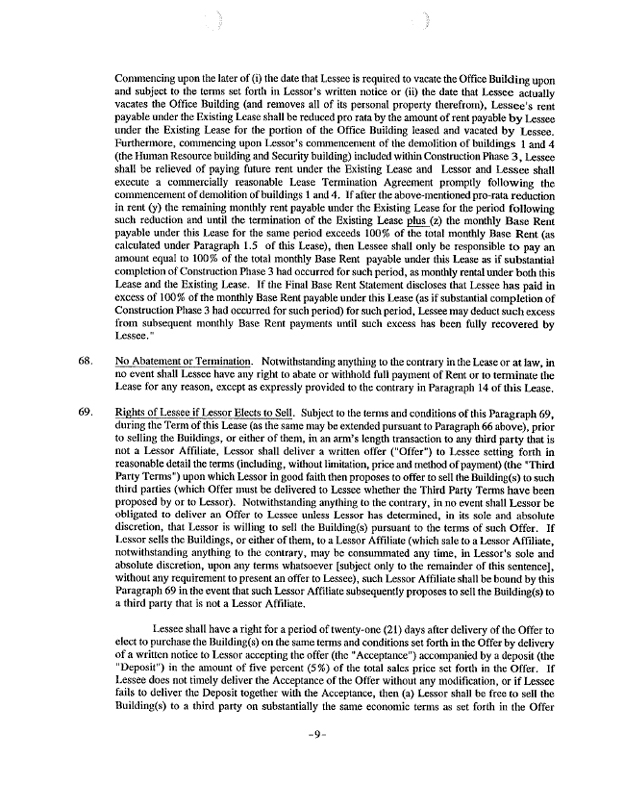
Commencing upon the later of (i) the date that Lessee is required to vacate the Office Building upon and subject to the terms set forth in Lessor’s written notice or (ii) the date that Lessee actually vacates the Office Building (and removes all of its personal property therefrom), Lessee’s rent payable under the Existing Lease shall be reduced pro rata by the amount of rent payable by Lessee under the Existing Lease for the portion of the Office Building leased and vacated by Lessee. Furthermore, commencing upon Lessor’s commencement of the demolition of buildings 1 and 4 (the Human Resource building and Security building) included within Construction Phase 3, Lessee shall be relieved of paying future rent under the Existing Lease and Lessor and Lessee shall execute a commercially reasonable Lease Termination Agreement promptly following the commencement of demolition of buildings 1 and 4. If after the above-mentioned pro-rata reduction in rent (y) the remaining monthly rent payable under the Existing Lease for the period following such reduction and until the termination of the Existing Lease plus (z) the monthly Base Rent payable under this Lease for the same period exceeds 100% of the total monthly Base Rent (as calculated under Paragraph 1.5 of this Lease), then Lessee shall only be responsible to pay an amount equal to 100% of the total monthly Base Rent payable under this Lease as if substantial completion of Construction Phase 3 had occurred for such period, as monthly rental under both this Lease and the Existing Lease. If the Final Base Rent Statement discloses that Lessee has paid in excess of 100% of the monthly Base Rent payable under this Lease (as if substantial completion of Construction Phase 3 had occurred for such period) for such period, Lessee may deduct such excess from subsequent monthly Base Rent payments until such excess has been fully recovered by Lessee.”
68. No Abatement or Termination. Notwithstanding anything to the contrary in the Lease or at law, in no event shall Lessee have any right to abate or withhold full payment of Rent or to terminate the Lease for any reason, except as expressly provided to the contrary in Paragraph 14 of this Lease.
69. Rights of Lessee if Lessor Elects to Sell. Subject to the terms and conditions of this Paragraph 69, during the Term of this Lease (as the same may be extended pursuant to Paragraph 66 above), prior to selling the Buildings, or either of them, in an arm’s length transaction to any third party that is not a Lessor Affiliate, Lessor shall deliver a written offer (“Offer”) to Lessee setting forth in reasonable detail the terms (including, without limitation, price and method of payment) (the “Third Party Terms”) upon which Lessor in good faith then proposes to offer to sell the Building(s) to such third parties (which Offer must be delivered to Lessee whether the Third Party Terms have been proposed by or to Lessor). Notwithstanding anything to the contrary, in no event shall Lessor be obligated to deliver an Offer to Lessee unless Lessor has determined, in its sole and absolute discretion, that Lessor is willing to sell the Building(s) pursuant to the terms of such Offer. If Lessor sells the Buildings, or either of them, to a Lessor Affiliate (which sale to a Lessor Affiliate, notwithstanding anything to the contrary, may be consummated any time, in Lessor’s sole and absolute discretion, upon any terms whatsoever [subject only to the remainder of this sentence], without any requirement to present an offer to Lessee), such Lessor Affiliate shall be bound by this Paragraph 69 in the event that such Lessor Affiliate subsequently proposes to sell the Building(s) to a third party that is not a Lessor Affiliate.
Lessee shall have a right for a period of twenty-one (21) days after delivery of the Offer to elect to purchase the Building(s) on the same terms and conditions set forth in the Offer by delivery of a written notice to Lessor accepting the offer (the “Acceptance”) accompanied by a deposit (the “Deposit”) in the amount of five percent (5%) of the total sales price set forth in the Offer. If Lessee does not timely deliver the Acceptance of the Offer without any modification, or if Lessee fails to deliver the Deposit together with the Acceptance, then (a) Lessor shall be free to sell the Building(s) to a third party on substantially the same economic terms as set forth in the Offer
-9-
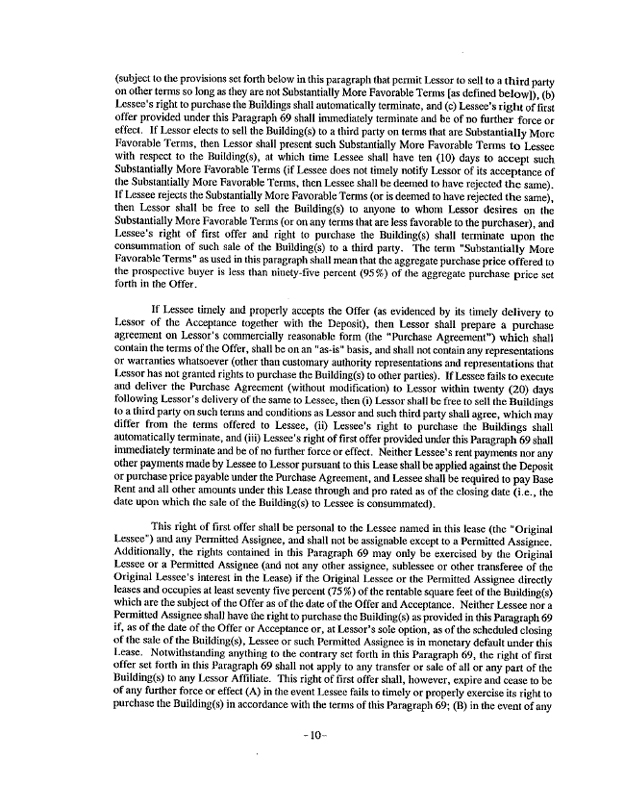
(subject to the provisions set forth below in this paragraph that permit Lessor to sell to a third party on other terms so long as they are not Substantially More Favorable Terms [as defined below]), (b) Lessee’s right to purchase the Buildings shall automatically terminate, and (c) Lessee’s right of first offer provided under this Paragraph 69 shall immediately terminate and be of no further force or effect. If Lessor elects to sell the Building(s) to a third party on terms that are Substantially More Favorable Terms, then Lessor shall present such Substantially More Favorable Terms to Lessee with respect to the Building(s), at which time Lessee shall have ten (10) days to accept such Substantially More Favorable Terms (if Lessee does not timely notify Lessor of its acceptance of the Substantially More Favorable Terms, then Lessee shall be deemed to have rejected the same). If Lessee rejects the Substantially More Favorable Terms (or is deemed to have rejected the same), then Lessor shall be free to sell the Building(s) to anyone to whom Lessor desires on the Substantially More Favorable Terms (or on any terms that are less favorable to the purchaser), and Lessee’s right of first offer and right to purchase the Building(s) shall terminate upon the consummation of such sale of the Building(s) to a third party. The term “Substantially More Favorable Terms” as used in this paragraph shall mean that the aggregate purchase price offered to the prospective buyer is less than ninety-five percent (95%) of the aggregate purchase price set forth in the Offer.
If Lessee timely and properly accepts the Offer (as evidenced by its timely delivery to Lessor of the Acceptance together with the Deposit), then Lessor shall prepare a purchase agreement on Lessor’s commercially reasonable form (the “Purchase Agreement”) which shall contain the terms of the Offer, shall be on an “as-is” basis, and shall not contain any representations or warranties whatsoever (other than customary authority representations and representations that Lessor has not granted rights to purchase the Building(s) to other parties). If Lessee fails to execute and deliver the Purchase Agreement (without modification) to Lessor within twenty (20) days following Lessor’s delivery of the same to Lessee, then (i) Lessor shall be free to sell the Buildings to a third party on such terms and conditions as Lessor and such third party shall agree, which may differ from the terms offered to Lessee, (ii) Lessee’s right to purchase the Buildings shall automatically terminate, and (iii) Lessee’s right of first offer provided under this Paragraph 69 shall immediately terminate and be of no further force or effect. Neither Lessee’s rent payments nor any other payments made by Lessee to Lessor pursuant to this Lease shall be applied against the Deposit or purchase price payable under the Purchase Agreement, and Lessee shall be required to pay Base Rent and all other amounts under this Lease through and pro rated as of the closing date (i.e., the date upon which the sale of the Building(s) to Lessee is consummated).
This right of first offer shall be personal to the Lessee named in this lease (the “Original Lessee”) and any Permitted Assignee, and shall not be assignable except to a Permitted Assignee. Additionally, the rights contained in this Paragraph 69 may only be exercised by the Original Lessee or a Permitted Assignee (and not any other assignee, sublessee or other transferee of the Original Lessee’s interest in the Lease) if the Original Lessee or the Permitted Assignee directly leases and occupies at least seventy five percent (75%) of the rentable square feet of the Building(s) which are the subject of the Offer as of the date of the Offer and Acceptance. Neither Lessee nor a Permitted Assignee shall have the right to purchase the Building(s) as provided in this Paragraph 69 if, as of the date of the Offer or Acceptance or, at Lessor’s sole option, as of the scheduled closing of the sale of the Building(s), Lessee or such Permitted Assignee is in monetary default under this Lease. Notwithstanding anything to the contrary set forth in this Paragraph 69, the right of first offer set forth in this Paragraph 69 shall not apply to any transfer or sale of all or any part of the Building(s) to any Lessor Affiliate. This right of first offer shall, however, expire and cease to be of any further force or effect (A) in the event Lessee fails to timely or properly exercise its right to purchase the Building(s) in accordance with the terms of this Paragraph 69; (B) in the event of any
-10-
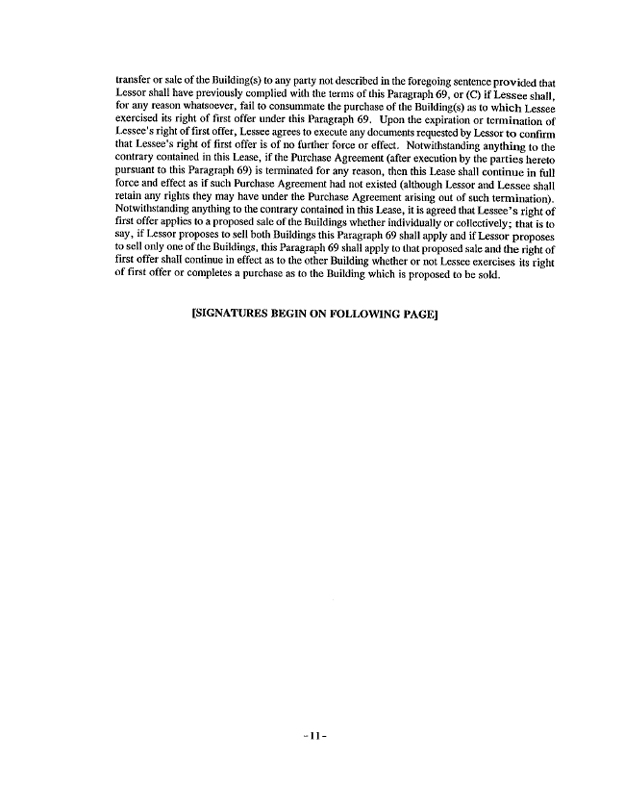
transfer or sale of the Building(s) to any party not described in the foregoing sentence provided that Lessor shall have previously complied with the terms of this Paragraph 69, or (C) if Lessee shall, for any reason whatsoever, fail to consummate the purchase of the Building(s) as to which Lessee exercised its right of first offer under this Paragraph 69. Upon the expiration or termination of Lessee’s right of first offer, Lessee agrees to execute any documents requested by Lessor to confirm that Lessee’s right of first offer is of no further force or effect. Notwithstanding anything to the contrary contained in this Lease, if the Purchase Agreement (after execution by the parties hereto pursuant to this Paragraph 69) is terminated for any reason, then this Lease shall continue in full force and effect as if such Purchase Agreement had not existed (although Lessor and Lessee shall retain any rights they may have under the Purchase Agreement arising out of such termination). Notwithstanding anything to the contrary contained in this Lease, it is agreed that Lessee’s right of first offer applies to a proposed sale of the Buildings whether individually or collectively; that is to say, if Lessor proposes to sell both Buildings this Paragraph 69 shall apply and if Lessor proposes to sell only one of the Buildings, this Paragraph 69 shall apply to that proposed sale and the right of first offer shall continue in effect as to the other Building whether or not Lessee exercises its right of first offer or completes a purchase as to the Building which is proposed to be sold.
[SIGNATURES BEGIN ON FOLLOWING PAGE]
-11-
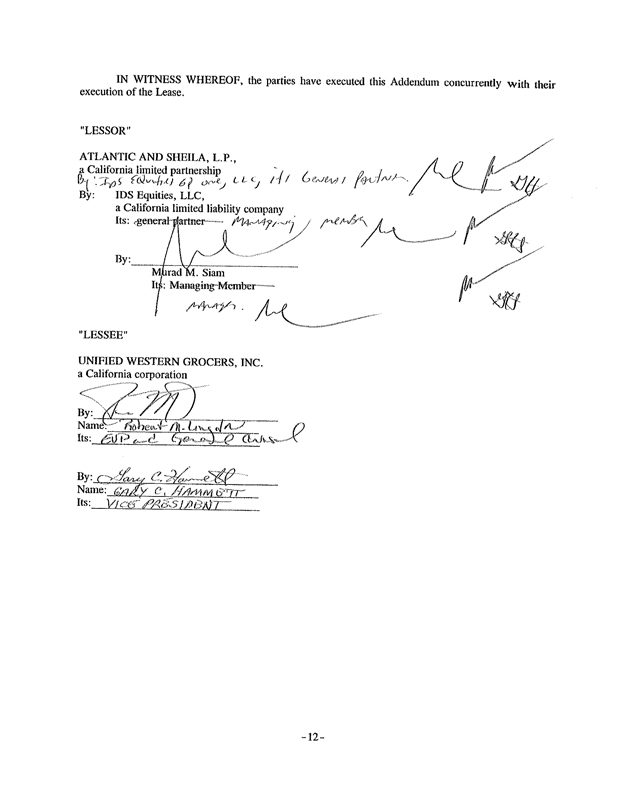
IN WITNESS WHEREOF, the parties have executed this Addendum concurrently with their execution of the Lease.
“LESSOR”
ATLANTIC AND SHEILA, L.P.,
a California limited partnership
By: IDS Equities GP One, LLC, its General Partner
By: IDS Equities, LLC,
a California limited liability company
Its: Managing Member
By:
Murad M. Siam
Its: Manager
“LESSEE”
UNIFIED WESTERN GROCERS, INC.
a California corporation
By:
Name: Robert M.
Its: EVP and General Counsel
By: Gary C. Hammett
Name: GARY C. HAMMETT
Its: VICE PRESIDENT
-12-
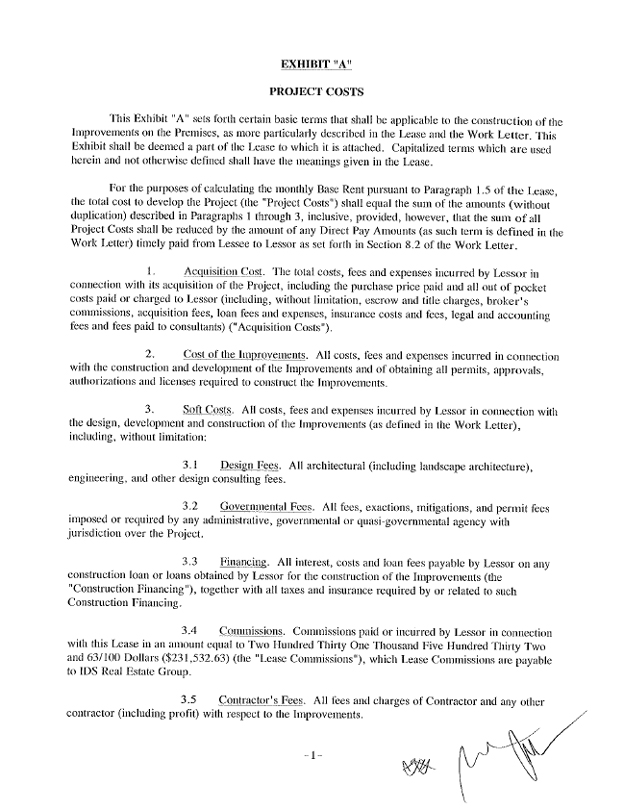
EXHIBIT “A”
PROJECT COSTS
This Exhibit “A” sets forth certain basic terms that shall be applicable to the construction of the Improvements on the Premises, as more particularly described in the Lease and the Work Letter. This Exhibit shall be deemed a part of the Lease to which it is attached. Capitalized terms which are used herein and not otherwise defined shall have the meanings given in the Lease.
For the purposes of calculating the monthly Base Rent pursuant to Paragraph 1.5 of the Lease, the total cost to develop the Project (the “Project Costs”) shall equal the sum of the amounts (without duplication) described in Paragraphs 1 through 3, inclusive, provided, however, that the sum of all Project Costs shall be reduced by the amount of any Direct Pay Amounts (as such term is defined in the Work Letter) timely paid from Lessee to Lessor as set forth in Section 8.2 of the Work Letter.
1. Acquisition Cost. The total costs, fees and expenses incurred by Lessor in connection with its acquisition of the Project, including the purchase price paid and all out of pocket costs paid or charged to Lessor (including, without limitation, escrow and title charges, broker’s commissions, acquisition fees, loan fees and expenses, insurance costs and fees, legal and accounting fees and fees paid to consultants) (“Acquisition Costs”).
2. Cost of the Improvements. All costs, fees and expenses incurred in connection with the construction and development of the Improvements and of obtaining all permits, approvals, authorizations and licenses required to construct the Improvements.
3. Soft Costs. All costs, fees and expenses incurred by Lessor in connection with the design, development and construction of the Improvements (as defined in the Work Letter), including, without limitation:
3.1 Design Fees. All architectural (including landscape architecture), engineering, and other design consulting fees.
3.2 Governmental Fees. All fees, exactions, mitigations, and permit fees imposed or required by any administrative, governmental or quasi-governmental agency with jurisdiction over the Project.
3.3 Financing. All interest, costs and loan fees payable by Lessor on any construction loan or loans obtained by Lessor for the construction of the Improvements (the “Construction Financing”), together with all taxes and insurance required by or related to such Construction Financing.
3.4 Commissions. Commissions paid or incurred by Lessor in connection with this Lease in an amount equal to Two Hundred Thirty One Thousand Five Hundred Thirty Two and 63/100 Dollars ($231,532.63) (the “Lease Commissions”), which Lease Commissions are payable to IDS Real Estate Group.
3.5 Contractor’s Fees. All fees and charges of Contractor and any other contractor (including profit) with respect to the Improvements.
-1-
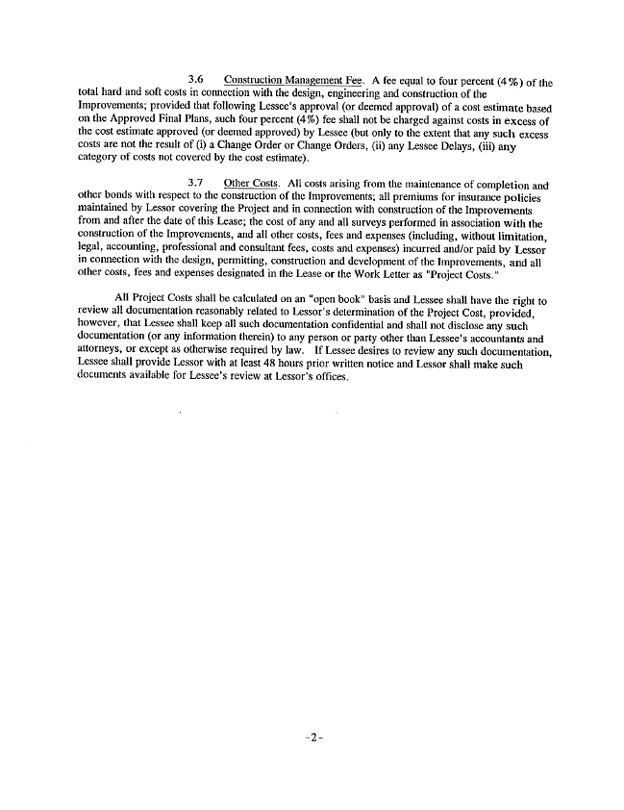
3.6 Construction Management Fee. A fee equal to four percent (4 %) of the total hard and soft costs in connection with the design, engineering and construction of the Improvements; provided that following Lessee’s approval (or deemed approval) of a cost estimate based on the Approved Final Plans, such four percent (4%) fee shall not be charged against costs in excess of the cost estimate approved (or deemed approved) by Lessee (but only to the extent that any such excess costs are not the result of (i) a Change Order or Change Orders, (ii) any Lessee Delays, (iii) any category of costs not covered by the cost estimate).
3.7 Other Costs. All costs arising from the maintenance of completion and other bonds with respect to the construction of the Improvements; all premiums for insurance policies maintained by Lessor covering the Project and in connection with construction of the Improvements from and after the date of this Lease; the cost of any and all surveys performed in association with the construction of the Improvements, and all other costs, fees and expenses (including, without limitation, legal, accounting, professional and consultant fees, costs and expenses) incurred and/or paid by Lessor in connection with the design, permitting, construction and development of the Improvements, and all other costs, fees and expenses designated in the Lease or the Work Letter as “Project Costs.”
All Project Costs shall be calculated on an “open book” basis and Lessee shall have the right to review all documentation reasonably related to Lessor’s determination of the Project Cost, provided, however, that Lessee shall keep all such documentation confidential and shall not disclose any such documentation (or any information therein) to any person or party other than Lessee’s accountants and attorneys, or except as otherwise required by law. If Lessee desires to review any such documentation, Lessee shall provide Lessor with at least 48 hours prior written notice and Lessor shall make such documents available for Lessee’s review at Lessor’s offices.
-2-

EXHIBIT “B”
INITIAL BUDGET
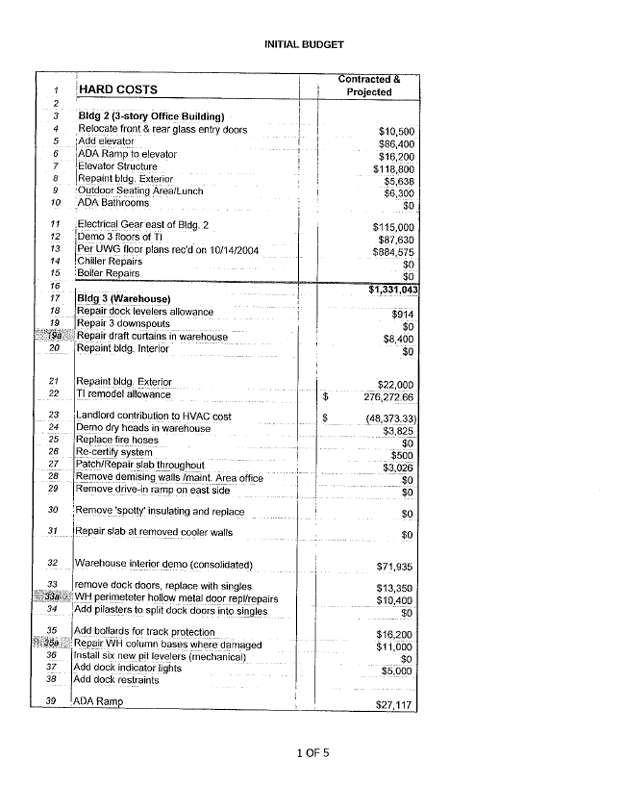
INITIAL BUDGET
1 HARD COSTS Contracted & Projected
2
3 Bldg 2 (3-story Office Building)
4 Relocate front & rear glass entry doors $10,500
5 Add elevator $86,400
6 ADA Ramp to elevator $16,200
7 Elevator Structure $118,800
8 Repaint bldg. Exterior $5,638
9 Outdoor Seating Area/Lunch $6,300
10 ADA Bathrooms $0
11 Electrical Gear east of Bldg. 2 $115,000
12 Demo 3 floors of Tl $87,630
13 Per UWG floor plans rec’d on 10/14/2004 $884,575
14 Chiller Repairs $0
15 Boiler Repairs $0
16 $1,331,043
17 Bldg 3 (Warehouse)
18 Repair dock levelers allowance $914
19 Repair 3 downspouts $0
19a Repair draft curtains in warehouse $8,400
20 Repaint bldg. Interior $0
21 Repaint bldg. Exterior $22,000
22 Tl remodel allowance $ 276,272.66
23 Landlord contribution to HVAC cost $ (48,373.33)
24 Demo dry heads in warehouse $3,825
25 Replace fire hoses $0
26 Re-certify system $500
27 Patch/Repair slab throughout $3,026
28 Remove demising walls /maint. Area office $0
29 Remove drive-in ramp on east side $0
30 Remove ���spotty’ insulating and replace $0
31 Repair slab at removed cooler walls $0
32 Warehouse interior demo (consolidated) $71,935
33 remove dock doors, replace with singles $13,350
33a WH perimeteter hollow metal door repl/repairs $10,400
34 Add pilasters to split dock doors into singles $0
35 Add bollards for track protection $16,200
35a Repair WH column bases where damaged $11,000
36 Install six new pit levelers (mechanical) $0
37 Add dock indicator lights $5,000
38 Add dock restraints
39 ADA Ramp $27,117
1 OF 5
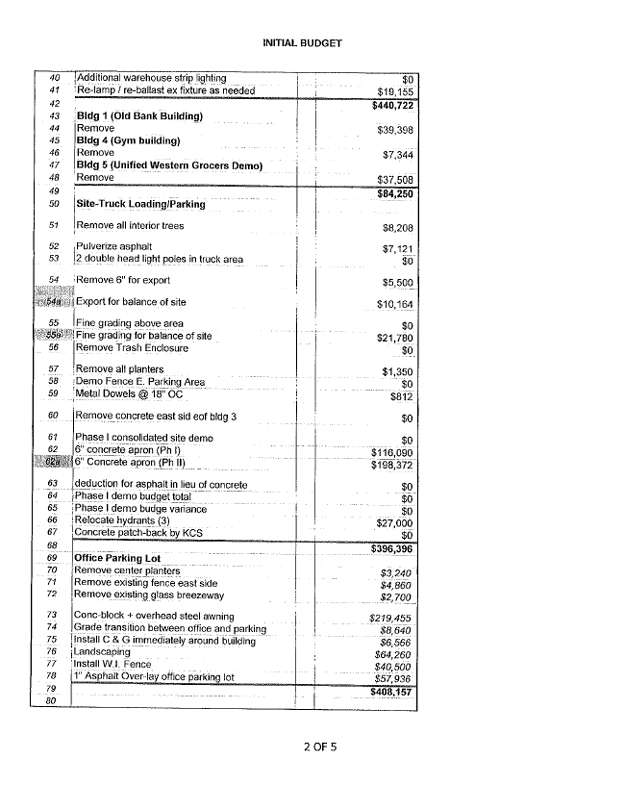
INITIAL BUDGET
40 Additional warehouse strip lighting $0
41 Re-lamp / re-ballast ex fixture as needed $19,155
42 $440,722
43 Bldg 1 (Old Bank Building)
44 Remove $39,398
45 Bldg 4 (Gym building)
46 Remove $7,344
47 Bldg 5 (Unified Western Grocers Demo)
48 Remove $37,508
49 $84,250
50 Site-Truck Loading/Parking
51 Remove all interior trees $8,208
52 Pulverize asphalt $7,121
53 2 double head light poles in truck area $0
54 Remove 6” for export $5,500
54a Export for balance of site $10,164
55 Fine grading above area $0
55a Fine grading for balance of site $21,780
56 Remove Trash Enclosure $0
57 Remove all planters $1,350
58 Demo Fence E. Parking Area $0
59 Metal Dowels @ 18” OC $812
60 Remove concrete east sid eof bldg 3 $0
61 Phase I consolidated site demo $0
62 6” concrete apron (Ph I) $116,090
62a 6” Concrete apron (Ph II) $198,372
63 deduction for asphalt in lieu of concrete $0
64 Phase I demo budget total $0
65 Phase I demo budge variance $0
66 Relocate hydrants (3) $27,000
67 Concrete patch-back by KCS $0
68 $396,396
69 Office Parking Lot
70 Remove center planters $3,240
71 Remove existing fence east side $4,860
72 Remove existing glass breezeway $2,700
73 Conc-block + overhead steel awning $219,455
74 Grade transition between office and parking $8,640
75 Install C & G immediately around building $6,566
76 Landscaping $64,260
77 Install W.I. Fence $40,500
78 1” Asphalt Over-lay office parking lot $57,936
79 $408,157
80
2 OF 5

INITIAL BUDGET
81 Phase I Supervision $11,258
81a Phase II & III Supervision $24,000
82
83 Siesmic upgrade $1.70 per sq ft (per Ajit) $215,560
84 $250,818
85
86 Subtotal $2,911,386
87
88 Insurance $43,671
89 General Conditions $116,455
90 Contractor’s Contingency $0
91 Contractor’s Fee $279,751
92 Total $439,877
93
94 Cafeteria (including consultant) $100,000
95 Scissor lift for Cafeteria loading $15,000
96 $115,000
97
98 Total Hard Costs $3,466,264
99
100 SOFT COSTS
101
102 Shell & Site Renovation Architectural Fees
103 Elevator shaft & stair drawings (include MPE) $55,000
104 Civil Engineering Drawings $25,000
105
106 T I Architectural fees Bldg. 2
107 Warehouse TI Drawings $12,318
108 Warehouse MEP Drawings $4,700
109 Soil engineer for yard work $750
110 Warehouse building permits $2,230
111 Warehouse health dept plan check $667
112 Space Planning and Design $.15 x 36,480 ft $0
113 Record Drawings Data Base $.15 x 36,480 ft $0
114 TI Mech/Plumbing drawings $27,000
115 TI Electrical Engineering $0
116 Construction Documents $1.50 x 36,480 ft $54,720
117
118 Reimbursible Expenses $36,055
119
120 City Permits / Fees $35,000
121
122 Course of Construction Insurance $7,100
123 Total Soft Cost $260,540
124
125 Total Cost $3,726,803
126 Construction Management Fee $149,072
127 Project Total $3,875,876
3 OF 5
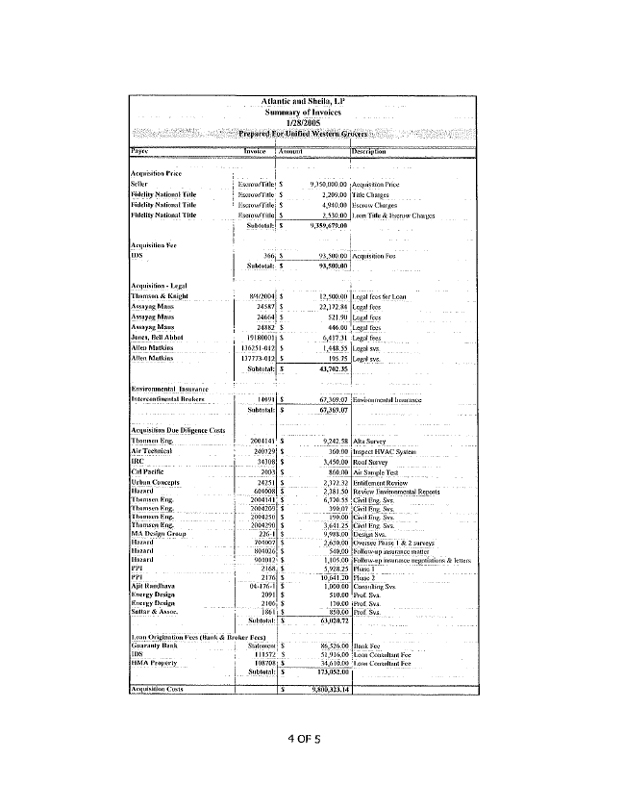
Atlantic and Sheila, LP
Summary of Invoices
1/28/2005
Prepared For Unified Western Grocers
Payee Invoice Amount Description
Acquisition Price
Seller Escrow/Title $ 9,350,000.00 Acquisition Price
Fidelity National Title Escrow/Title $ 2,209.00 Title Charges
Fidelity National Title Escrow/Title $ 4,940.00 Escrow Charges
Fidelity National Title Escrow/Title $ 2,530.00 Loan Title & Escrow Charges
Subtotal: $9,359,679.00
Acquisition Fee
IDS 366 $ 93,500.00 Acquisition Fee
Subtotal: $ 93,500.00
Acquisition - Legal
Thomson & Knight $ 8/4/2004 12,500.00 Legal fees for Loan
Assayag Maus 24587 $ 22,172.84 Legal fees
Assayag Maus 24664 $ 521.90 Legal fees
Assayag Maus 24882 $ 446.00 Legal fees
Jones, Bell Abbot 19180001 $ 6,417.31 Legal fees
Allen Matkins 136251-012 $ 1,448.55 Legal svs.
Allen Matkins 137773-012 $ 195.75 Legal svs.
Subtotal: $ 43,702.35
Environmental Insurance
Intercontinental Brokers 14091 $ 67,369.07 Environmental Insurance
Subtotal: $ 67,369.07
Acquisition Due Diligence Costs
Thomsen Eng. 2004141 $ 9,242.58 Alta Survey
Air Technical 240729 $ 360.00 Inspect HVAC System
IRC 34308 $ 3,450.00 Roof Survey
Cal Pacific 2003 $ 860.00 Air Sample Test
Urban Concepts 24251 $ 2,372.32 Entitlement Review
Hazard 604008 $ 2,381.50 Review Environmental Reports
Thomsen Eng. 2004141 $ 6,770.55 Civil Eng. Svs.
Thomsen Eng. 2004209 $ 390.07 Civil Eng. Svs.
Thomsen Eng. 2004250 $ 190.00 Civil Eng. Svs.
Thomsen Eng. 2004290 $ 3,641.25 Civil Eng. Svs.
MA Design Group 226-1 $ 9,988.00 Design Svs.
Hazard 704007 $ 2,630.00 Oversee Phase 1 & 2 surveys
Hazard 804026 $ 540.00 Follow-up insurance matter
Hazard 904012 $ 1,105.00 Follow-up insurance negotiations & letters
PPI 2168 $ 5,928.25 Phase 1
PPI 2176 $ 10,641.20 Phase 2
Ajit Randhava 04-176-1 $ 1,000.00 Consulting Svs.
Energy Design 2091 $ 510.00 Prof. Svs.
Energy Design 2106 $ 170.00 Prof. Svs.
Sattar & Assoc. 1861 $ 850.00 Prof. Svs.
Subtotal: $ 63,020.72
Loan Origination Fees (Bank & Broker Fees)
Guaranty Bank Statement $ 86,526.00 Bank Fee
IDS 111572 $ 51,916,00 Loan Consultant Fee
HMA Property 108708 $ 34,610.00 Loan Consultant Fee
Subtotal: $ 173,052.00
Acquisition Costs $ 9,800,323.14
4 OF 5
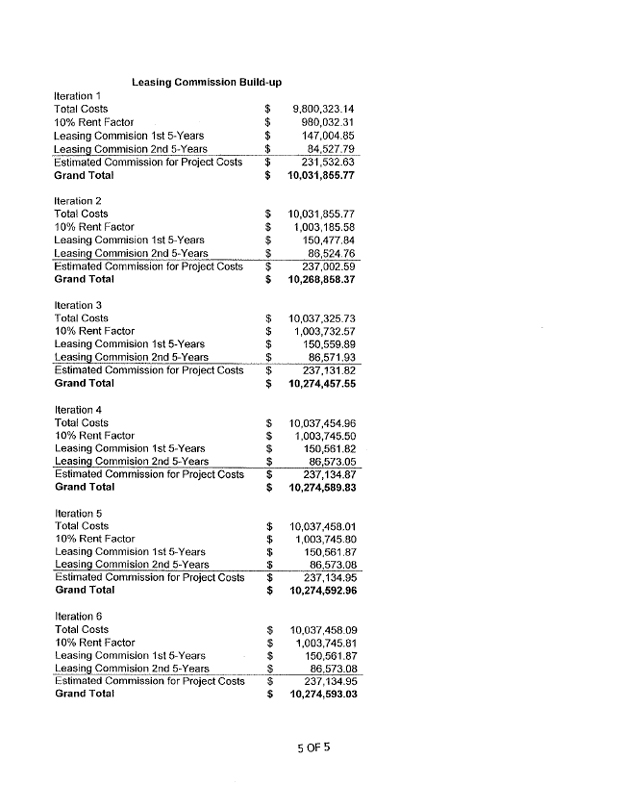
Leasing Commission Build-up
Iteration 1
Total Costs $ 9,800,323.14
10% Rent Factor $ 980,032.31
Leasing Commision 1st 5-Years $ 147,004.85
Leasing Commision 2nd 5-Years $ 84,527.79
Estimated Commission for Project Costs $ 231,532.63
Grand Total $ 10,031,855.77
Iteration 2
Total Costs $ 10,031,855.77
10% Rent Factor $ 1,003,185.58
Leasing Commision 1st 5-Years $ 150,477.84
Leasing Commision 2nd 5-Years $ 86,524.76
Estimated Commission for Project Costs $ 237,002.59
Grand Total $ 10,268,858.37
Iteration 3
Total Costs $ 10,037,325.73
10% Rent Factor $ 1,003,732.57
Leasing Commision 1st 5-Years $ 150,559.89
Leasing Commision 2nd 5-Years $ 86,571.93
Estimated Commission for Project Costs $ 237,131.82
Grand Total $ 10,274,457.55
Iteration 4
Total Costs $ 10,037,454.96
10% Rent Factor $ 1,003,745.50
Leasing Commision 1st 5-Years $ 150,561.82
Leasing Commision 2nd 5-Years $ 86,573.05
Estimated Commission for Project Costs $ 237,134.87
Grand Total $ 10,274,589.83
Iteration 5
Total Costs $ 10,037,458.01
10% Rent Factor $ 1,003,745.80
Leasing Commision 1st 5-Years $ 150,561.87
Leasing Commision 2nd 5-Years $ 86,573.08
Estimated Commission for Project Costs $ 237,134.95
Grand Total $ 10,274,592.96
Iteration 6
Total Costs $ 10,037,458.09
10% Rent Factor $ 1,003,745.81
Leasing Commision 1st 5-Years $ 150,561.87
Leasing Commision 2nd 5-Years $ 86,573.08
Estimated Commission for Project Costs $ 237,134.95
Grand Total $ 10,274,593.03
5 OF 5

EXHIBIT “C”
PROHIBITED USES
The following types of operations and activities are expressly prohibited on the Premises and Project:
1. automobile/truck maintenance, repair or fueling, except for automobiles and trucks owned or leased by Lessee in connection with its business;
2. battery manufacturing or reclamation;
3. ceramics and jewelry manufacturing or finishing;
4. chemical (organic or inorganic) manufacturing;
5. drum recycling;
6. dry cleaning;
7. electronic components manufacturing;
8. electroplating and metal finishing;
9. explosives manufacturing, use or storage;
10. hazardous waste treatment, storage, or disposal;
11. leather production, tanning or finishing;
12. machinery and tool manufacturing;
13. manufacturing of any type;
14. metal shredding, recycling or reclamation;
15. metal smelting and refining;
16. mining;
17. paint, pigment and coating operations;
18. petroleum refining;
19. plastic and synthetic materials manufacturing;
20. solvent reclamation;
21. tire and rubber manufacturing;
-1-

22. underground storage tanks; and
23. residential use or occupancy.
-1-
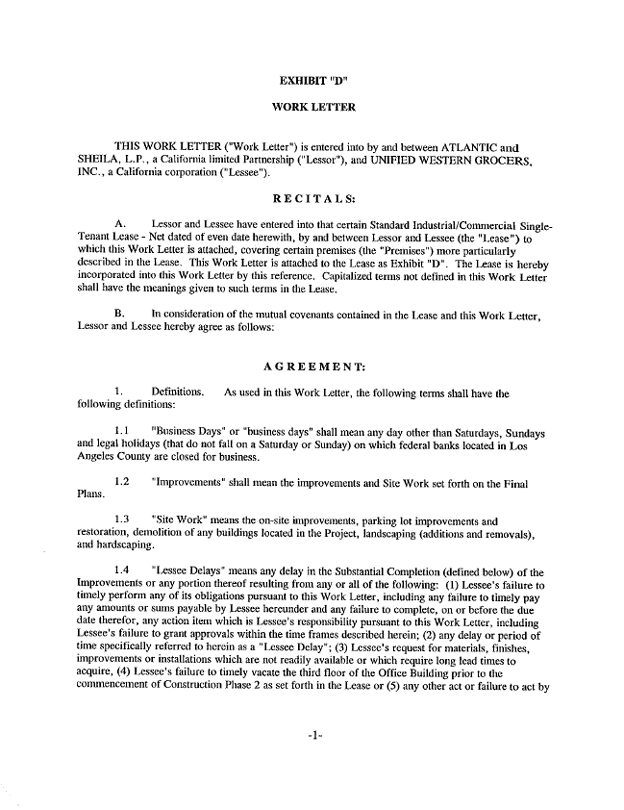
EXHIBIT “D”
WORK LETTER
THIS WORK LETTER (“Work Letter”) is entered into by and between ATLANTIC and SHEILA, L.P., a California limited Partnership (“Lessor”), and UNIFIED WESTERN GROCERS, INC., a California corporation (“Lessee”).
R E C I T A L S:
A. Lessor and Lessee have entered into that certain Standard Industrial/Commercial Single-Tenant Lease - Net dated of even date herewith, by and between Lessor and Lessee (the “Lease”) to which this Work Letter is attached, covering certain premises (the “Premises”) more particularly described in the Lease. This Work Letter is attached to the Lease as Exhibit “D”. The Lease is hereby incorporated into this Work Letter by this reference. Capitalized terms not defined in this Work Letter shall have the meanings given to such terms in the Lease.
B. In consideration of the mutual covenants contained in the Lease and this Work Letter, Lessor and Lessee hereby agree as follows:
A G R E E M E N T:
1. Definitions. As used in this Work Letter, the following terms shall have the following definitions:
1.1 “Business Days” or “business days” shall mean any day other than Saturdays, Sundays and legal holidays (that do not fall on a Saturday or Sunday) on which federal banks located in Los Angeles County are closed for business.
1.2 “Improvements” shall mean the improvements and Site Work set forth on the Final Plans.
1.3 “Site Work” means the on-site improvements, parking lot improvements and restoration, demolition of any buildings located in the Project, landscaping (additions and removals), and hardscaping.
1.4 “Lessee Delays” means any delay in the Substantial Completion (defined below) of the Improvements or any portion thereof resulting from any or all of the following: (1) Lessee’s failure to timely perform any of its obligations pursuant to this Work Letter, including any failure to timely pay any amounts or sums payable by Lessee hereunder and any failure to complete, on or before the due date therefor, any action item which is Lessee’s responsibility pursuant to this Work Letter, including Lessee’s failure to grant approvals within the time frames described herein; (2) any delay or period of time specifically referred to herein as a “Lessee Delay”; (3) Lessee’s request for materials, finishes, improvements or installations which are not readily available or which require long lead times to acquire, (4) Lessee’s failure to timely vacate the third floor of the Office Building prior to the commencement of Construction Phase 2 as set forth in the Lease or (5) any other act or failure to act by
-1-
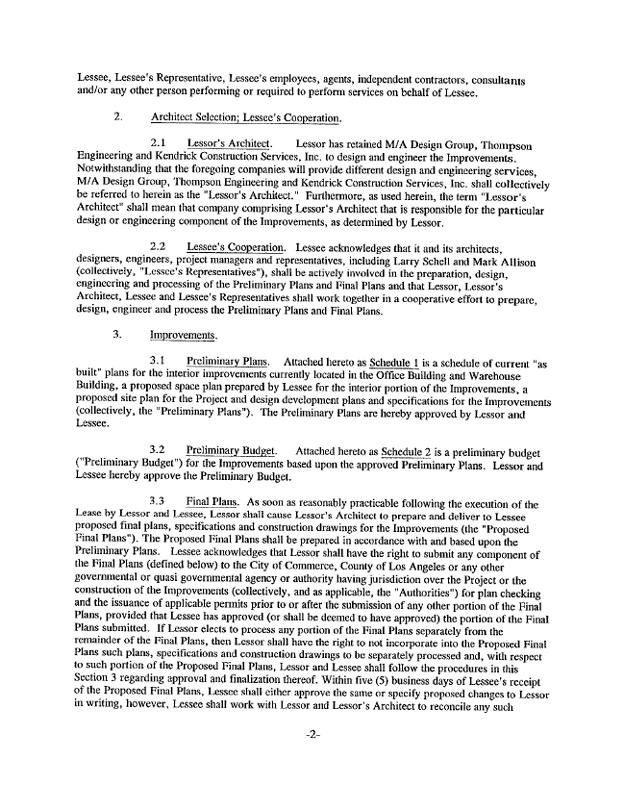
Lessee, Lessee’s Representative, Lessee’s employees, agents, independent contractors, consultants and/or any other person performing or required to perform services on behalf of Lessee.
2. Architect Selection; Lessee’s Cooperation.
2.1 Lessor’s Architect. Lessor has retained M/A Design Group, Thompson Engineering and Kendrick Construction Services, Inc. to design and engineer the Improvements. Notwithstanding that the foregoing companies will provide different design and engineering services, M/A Design Group, Thompson Engineering and Kendrick Construction Services, Inc. shall collectively be referred to herein as the “Lessor’s Architect.” Furthermore, as used herein, the term “Lessor’s Architect” shall mean that company comprising Lessor’s Architect that is responsible for the particular design or engineering component of the Improvements, as determined by Lessor.
2.2 Lessee’s Cooperation. Lessee acknowledges that it and its architects, designers, engineers, project managers and representatives, including Larry Schell and Mark Allison (collectively, “Lessee’s Representatives”), shall be actively involved in the preparation, design, engineering and processing of the Preliminary Plans and Final Plans and that Lessor, Lessor’s Architect, Lessee and Lessee’s Representatives shall work together in a cooperative effort to prepare, design, engineer and process the Preliminary Plans and Final Plans.
3. Improvements.
3.1 Preliminary Plans. Attached hereto as Schedule 1 is a schedule of current “as built” plans for the interior improvements currently located in the Office Building and Warehouse Building, a proposed space plan prepared by Lessee for the interior portion of the Improvements, a proposed site plan for the Project and design development plans and specifications for the Improvements (collectively, the “Preliminary Plans”). The Preliminary Plans are hereby approved by Lessor and Lessee.
3.2 Preliminary Budget. Attached hereto as Schedule 2 is a preliminary budget (“Preliminary Budget”) for the Improvements based upon the approved Preliminary Plans. Lessor and Lessee hereby approve the Preliminary Budget.
3.3 Final Plans. As soon as reasonably practicable following the execution of the Lease by Lessor and Lessee, Lessor shall cause Lessor’s Architect to prepare and deliver to Lessee proposed final plans, specifications and construction drawings for the Improvements (the “Proposed Final Plans”). The Proposed Final Plans shall be prepared in accordance with and based upon the Preliminary Plans. Lessee acknowledges that Lessor shall have the right to submit any component of the Final Plans (defined below) to the City of Commerce, County of Los Angeles or any other governmental or quasi governmental agency or authority having jurisdiction over the Project or the construction of the Improvements (collectively, and as applicable, the “Authorities”) for plan checking and the issuance of applicable permits prior to or after the submission of any other portion of the Final Plans, provided that Lessee has approved (or shall be deemed to have approved) the portion of the Final Plans submitted. If Lessor elects to process any portion of the Final Plans separately from the remainder of the Final Plans, then Lessor shall have the right to not incorporate into the Proposed Final Plans such plans, specifications and construction drawings to be separately processed and, with respect to such portion of the Proposed Final Plans, Lessor and Lessee shall follow the procedures in this Section 3 regarding approval and finalization thereof. Within five (5) business days of Lessee’s receipt of the Proposed Final Plans, Lessee shall either approve the same or specify proposed changes to Lessor in writing, however, Lessee shall work with Lessor and Lessor’s Architect to reconcile any such
-2-
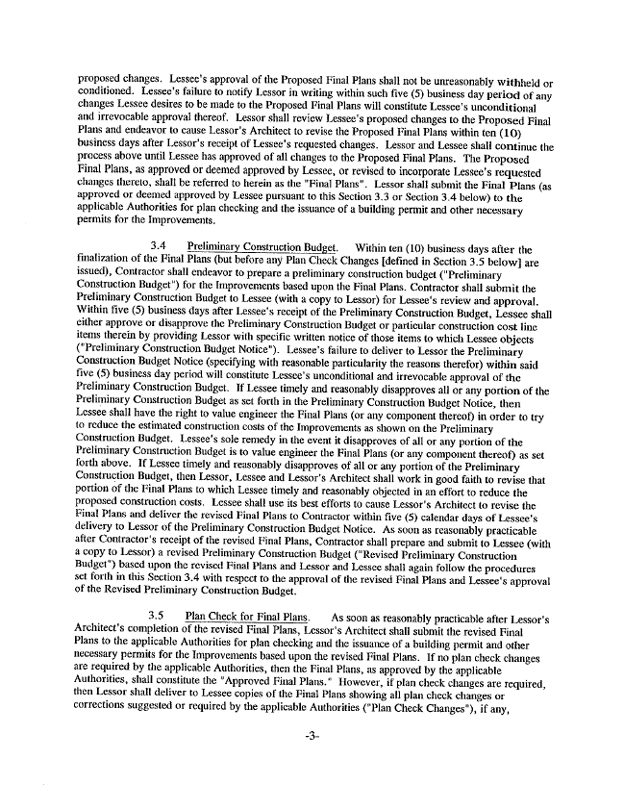
proposed changes, Lessee’s approval of the Proposed Final Plans shall not be unreasonably withheld or conditioned. Lessee’s failure to notify Lessor in writing within such five (5) business day period of any changes Lessee desires to be made to the Proposed Final Plans will constitute Lessee’s unconditional and irrevocable approval thereof. Lessor shall review Lessee’s proposed changes to the Proposed Final Plans and endeavor to cause Lessor’s Architect to revise the Proposed Final Plans within ten (10) business days after Lessor’s receipt of Lessee’s requested changes. Lessor and Lessee shall continue the process above until Lessee has approved of all changes to the Proposed Final Plans. The Proposed Final Plans, as approved or deemed approved by Lessee, or revised to incorporate Lessee’s requested changes thereto, shall be referred to herein as the “Final Plans”. Lessor shall submit the Final Plans (as approved or deemed approved by Lessee pursuant to this Section 3.3 or Section 3.4 below) to the applicable Authorities for plan checking and the issuance of a building permit and other necessary permits for the Improvements.
3.4 Preliminary Construction Budget. Within ten (10) business days after the finalization of the Final Plans (but before any Plan Check Changes [defined in Section 3.5 below] are issued), Contractor shall endeavor to prepare a preliminary construction budget (“Preliminary Construction Budget”) for the Improvements based upon the Final Plans. Contractor shall submit the Preliminary Construction Budget to Lessee (with a copy to Lessor) for Lessee’s review and approval. Within five (5) business days after Lessee’s receipt of the Preliminary Construction Budget, Lessee shall either approve or disapprove the Preliminary Construction Budget or particular construction cost line items therein by providing Lessor with specific written notice of those items to which Lessee objects (“Preliminary Construction Budget Notice”). Lessee’s failure to deliver to Lessor the Preliminary Construction Budget Notice (specifying with reasonable particularity the reasons therefor) within said five (5) business day period will constitute Lessee’s unconditional and irrevocable approval of the Preliminary Construction Budget. If Lessee timely and reasonably disapproves all or any portion of the Preliminary Construction Budget as set forth in the Preliminary Construction Budget Notice, then Lessee shall have the right to value engineer the Final Plans (or any component thereof) in order to try to reduce the estimated construction costs of the Improvements as shown on the Preliminary Construction Budget. Lessee’s sole remedy in the event it disapproves of all or any portion of the Preliminary Construction Budget is to value engineer the Final Plans (or any component thereof) as set forth above. If Lessee timely and reasonably disapproves of all or any portion of the Preliminary Construction Budget, then Lessor, Lessee and Lessor’s Architect shall work in good faith to revise that portion of the Final Plans to which Lessee timely and reasonably objected in an effort to reduce the proposed construction costs. Lessee shall use its best efforts to cause Lessor’s Architect to revise the Final Plans and deliver the revised Final Plans to Contractor within five (5) calendar days of Lessee’s delivery to Lessor of the Preliminary Construction Budget Notice. As soon as reasonably practicable after Contractor’s receipt of the revised Final Plans, Contractor shall prepare and submit to Lessee (with a copy to Lessor) a revised Preliminary Construction Budget (“Revised Preliminary Construction Budget”) based upon the revised Final Plans and Lessor and Lessee shall again follow the procedures set forth in this Section 3.4 with respect to the approval of the revised Final Plans and Lessee’s approval of the Revised Preliminary Construction Budget.
3.5 Plan Check for Final Plans. As soon as reasonably practicable after Lessor’s Architect’s completion of the revised Final Plans, Lessor’s Architect shall submit the revised Final Plans to the applicable Authorities for plan checking and the issuance of a building permit and other necessary permits for the Improvements based upon the revised Final Plans. If no plan check changes are required by the applicable Authorities, then the Final Plans, as approved by the applicable Authorities, shall constitute the “Approved Final Plans.” However, if plan check changes are required, then Lessor shall deliver to Lessee copies of the Final Plans showing all plan check changes or corrections suggested or required by the applicable Authorities (“Plan Check Changes”), if any,
-3-
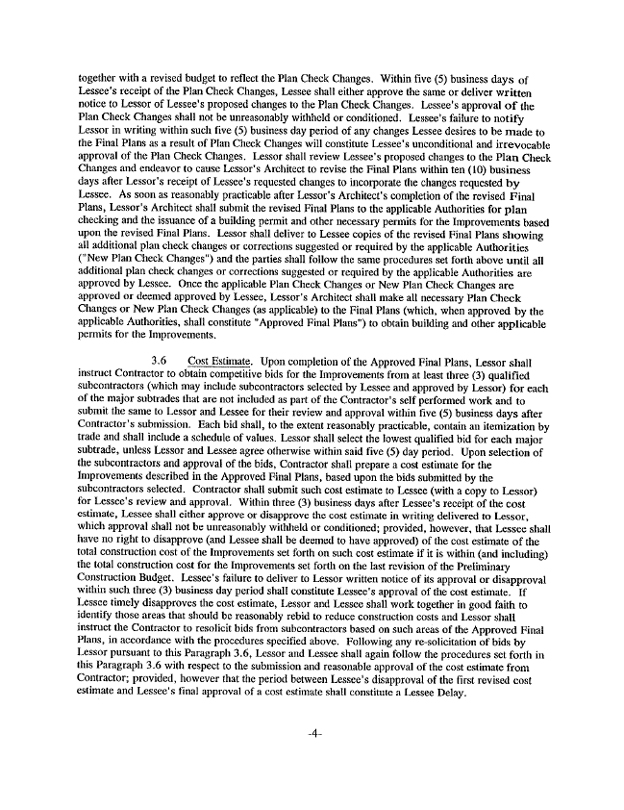
together with a revised budget to reflect the Plan Check Changes. Within five (5) business days of Lessee’s receipt of the Plan Check Changes, Lessee shall either approve the same or deliver written notice to Lessor of Lessee’s proposed changes to the Plan Check Changes. Lessee’s approval of the Plan Check Changes shall not be unreasonably withheld or conditioned. Lessee’s failure to notify Lessor in writing within such five (5) business day period of any changes Lessee desires to be made to the Final Plans as a result of Plan Check Changes will constitute Lessee’s unconditional and irrevocable approval of the Plan Check Changes. Lessor shall review Lessee’s proposed changes to the Plan Check Changes and endeavor to cause Lessor’s Architect to revise the Final Plans within ten (10) business days after Lessor’s receipt of Lessee’s requested changes to incorporate the changes requested by Lessee. As soon as reasonably practicable after Lessor’s Architect’s completion of the revised Final Plans, Lessor’s Architect shall submit the revised Final Plans to the applicable Authorities for plan checking and the issuance of a building permit and other necessary permits for the Improvements based upon the revised Final Plans. Lessor shall deliver to Lessee copies of the revised Final Plans showing all additional plan check changes or corrections suggested or required by the applicable Authorities (“New Plan Check Changes”) and the parties shall follow the same procedures set forth above until all additional plan check changes or corrections suggested or required by the applicable Authorities are approved by Lessee. Once the applicable Plan Check Changes or New Plan Check Changes are approved or deemed approved by Lessee, Lessor’s Architect shall make all necessary Plan Check Changes or New Plan Check Changes (as applicable) to the Final Plans (which, when approved by the applicable Authorities, shall constitute “Approved Final Plans”) to obtain building and other applicable permits for the Improvements.
3.6 Cost Estimate. Upon completion of the Approved Final Plans, Lessor shall instruct Contractor to obtain competitive bids for the Improvements from at least three (3) qualified subcontractors (which may include subcontractors selected by Lessee and approved by Lessor) for each of the major subtrades that are not included as part of the Contractor’s self performed work and to submit the same to Lessor and Lessee for their review and approval within five (5) business days after Contractor’s submission. Each bid shall, to the extent reasonably practicable, contain an itemization by trade and shall include a schedule of values. Lessor shall select the lowest qualified bid for each major subtrade, unless Lessor and Lessee agree otherwise within said five (5) day period. Upon selection of the subcontractors and approval of the bids, Contractor shall prepare a cost estimate for the Improvements described in the Approved Final Plans, based upon the bids submitted by the subcontractors selected. Contractor shall submit such cost estimate to Lessee (with a copy to Lessor) for Lessee’s review and approval. Within three (3) business days after Lessee’s receipt of the cost estimate, Lessee shall either approve or disapprove the cost estimate in writing delivered to Lessor, which approval shall not be unreasonably withheld or conditioned; provided, however, that Lessee shall have no right to disapprove (and Lessee shall be deemed to have approved) of the cost estimate of the total construction cost of the Improvements set forth on such cost estimate if it is within (and including) the total construction cost for the Improvements set forth on the last revision of the Preliminary Construction Budget. Lessee’s failure to deliver to Lessor written notice of its approval or disapproval within such three (3) business day period shall constitute Lessee’s approval of the cost estimate. If Lessee timely disapproves the cost estimate, Lessor and Lessee shall work together in good faith to identity those areas that should be reasonably rebid to reduce construction costs and Lessor shall instruct the Contractor to resolicit bids from subcontractors based on such areas of the Approved Final Plans, in accordance with the procedures specified above. Following any re-solicitation of bids by Lessor pursuant to this Paragraph 3.6, Lessor and Lessee shall again follow the procedures set forth in this Paragraph 3.6 with respect to the submission and reasonable approval of the cost estimate from Contractor; provided, however that the period between Lessee’s disapproval of the first revised cost estimate and Lessee’s final approval of a cost estimate shall constitute a Lessee Delay.
-4-
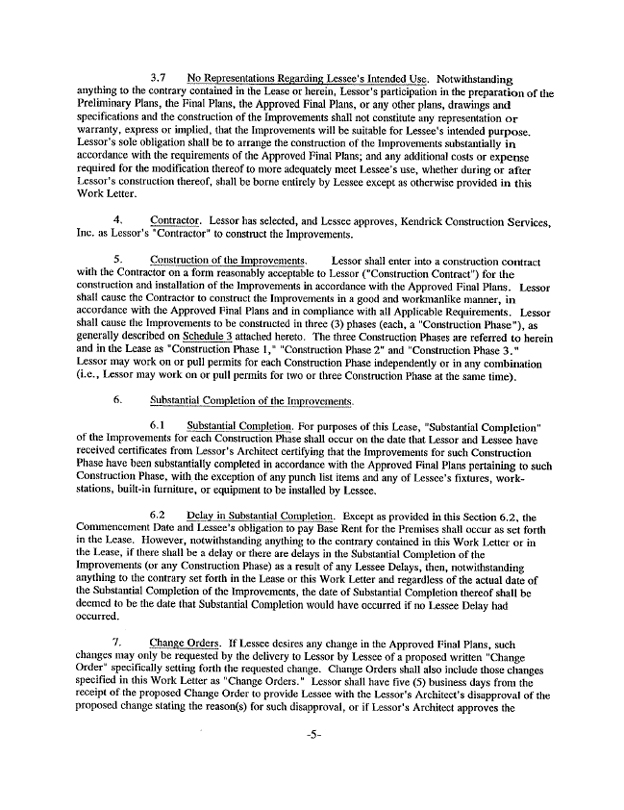
3.7 No Representations Regarding Lessee’s Intended Use. Notwithstanding anything to the contrary contained in the Lease or herein, Lessor’s participation in the preparation of the Preliminary Plans, the Final Plans, the Approved Final Plans, or any other plans, drawings and specifications and the construction of the Improvements shall not constitute any representation or warranty, express or implied, that the Improvements will be suitable for Lessee’s intended purpose. Lessor’s sole obligation shall be to arrange the construction of the Improvements substantially in accordance with the requirements of the Approved Final Plans; and any additional costs or expense required for the modification thereof to more adequately meet Lessee’s use, whether during or after Lessor’s construction thereof, shall be borne entirely by Lessee except as otherwise provided in this Work Letter.
4 . Contractor. Lessor has selected, and Lessee approves, Kendrick Construction Services, Inc. as Lessor’s “Contractor” to construct the Improvements.
5. Construction of the Improvements. Lessor shall enter into a construction contract with the Contractor on a form reasonably acceptable to Lessor (“Construction Contract”) for the construction and installation of the Improvements in accordance with the Approved Final Plans. Lessor shall cause the Contractor to construct the Improvements in a good and workmanlike manner, in accordance with the Approved Final Plans and in compliance with all Applicable Requirements. Lessor shall cause the Improvements to be constructed in three (3) phases (each, a “Construction Phase”), as generally described on Schedule 3 attached hereto. The three Construction Phases are referred to herein and in the Lease as “Construction Phase 1,” “Construction Phase 2” and “Construction Phase 3.”
Lessor may work on or pull permits for each Construction Phase independently or in any combination (i.e., Lessor may work on or pull permits for two or three Construction Phase at the same time).
6. Substantial Completion of the Improvements.
6.1 Substantial Completion. For purposes of this Lease, “Substantial Completion” of the Improvements for each Construction Phase shall occur on the date that Lessor and Lessee have received certificates from Lessor’s Architect certifying that the Improvements for such Construction Phase have been substantially completed in accordance with the Approved Final Plans pertaining to such Construction Phase, with the exception of any punch list items and any of Lessee’s fixtures, work-stations, built-in furniture, or equipment to be installed by Lessee.
6.2 Delay in Substantial Completion. Except as provided in this Section 6.2, the Commencement Date and Lessee’s obligation to pay Base Rent for the Premises shall occur as set forth in the Lease. However, notwithstanding anything to the contrary contained in this Work Letter or in the Lease, if there shall be a delay or there are delays in the Substantial Completion of the Improvements (or any Construction Phase) as a result of any Lessee Delays, then, notwithstanding anything to the contrary set forth in the Lease or this Work Letter and regardless of the actual date of the Substantial Completion of the Improvements, the date of Substantial Completion thereof shall be deemed to be the date that Substantial Completion would have occurred if no Lessee Delay had occurred.
7. Change Orders. If Lessee desires any change in the Approved Final Plans, such changes may only be requested by the delivery to Lessor by Lessee of a proposed written “Change Order” specifically setting forth the requested change. Change Orders shall also include those changes specified in this Work Letter as “Change Orders.” Lessor shall have five (5) business days from the receipt of the proposed Change Order to provide Lessee with the Lessor’s Architect’s disapproval of the proposed change stating the reason(s) for such disapproval, or if Lessor’s Architect approves the
-5-
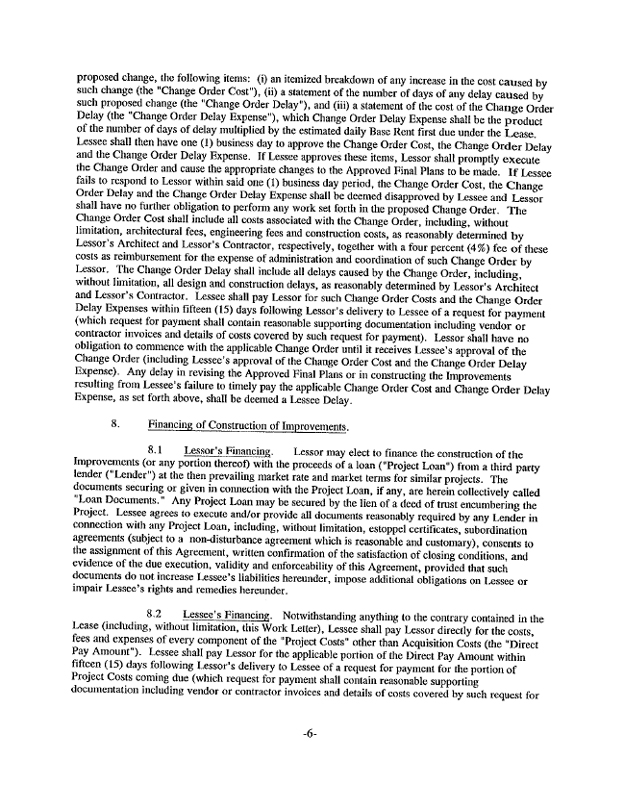
proposed change, the following items: (i) an itemized breakdown of any increase in the cost caused by such change (the “Change Order Cost”), (ii) a statement of the number of days of any delay caused by such proposed change (the “Change Order Delay”), and (iii) a statement of the cost of the Change Order Delay (the “Change Order Delay Expense”), which Change Order Delay Expense shall be the product of the number of days of delay multiplied by the estimated daily Base Rent first due under the Lease. Lessee shall then have one (1) business day to approve the Change Order Cost, the Change Order Delay and the Change Order Delay Expense. If Lessee approves these items, Lessor shall promptly execute the Change Order and cause the appropriate changes to the Approved Final Plans to be made. If Lessee fails to respond to Lessor within said one (1) business day period, the Change Order Cost, the Change Order Delay and the Change Order Delay Expense shall be deemed disapproved by Lessee and Lessor shall have no further obligation to perform any work set forth in the proposed Change Order. The Change Order Cost shall include all costs associated with the Change Order, including, without limitation, architectural fees, engineering fees and construction costs, as reasonably determined by Lessor’s Architect and Lessor’s Contractor, respectively, together with a four percent (4%) fee of these costs as reimbursement for the expense of administration and coordination of such Change Order by Lessor. The Change Order Delay shall include all delays caused by the Change Order, including, without limitation, all design and construction delays, as reasonably determined by Lessor’s Architect and Lessor’s Contractor. Lessee shall pay Lessor for such Change Order Costs and the Change Order Delay Expenses within fifteen (15) days following Lessor’s delivery to Lessee of a request for payment (which request for payment shall contain reasonable supporting documentation including vendor or contractor invoices and details of costs covered by such request for payment). Lessor shall have no obligation to commence with the applicable Change Order until it receives Lessee’s approval of the Change Order (including Lessee’s approval of the Change Order Cost and the Change Order Delay Expense). Any delay in revising the Approved Final Plans or in constructing the Improvements resulting from Lessee’s failure to timely pay the applicable Change Order Cost and Change Order Delay Expense, as set forth above, shall be deemed a Lessee Delay.
8. Financing of Construction of Improvements.
8.1 Lessor’s Financing. Lessor may elect to finance the construction of the Improvements (or any portion thereof) with the proceeds of a loan (“Project Loan”) from a third party lender (“Lender”) at the then prevailing market rate and market terms for similar projects. The documents securing or given in connection with the Project Loan, if any, are herein collectively called “Loan Documents.” Any Project Loan may be secured by the lien of a deed of trust encumbering the Project. Lessee agrees to execute and/or provide all documents reasonably required by any Lender in connection with any Project Loan, including, without limitation, estoppel certificates, subordination agreements (subject to a non-disturbance agreement which is reasonable and customary), consents to the assignment of this Agreement, written confirmation of the satisfaction of closing conditions, and evidence of the due execution, validity and enforceability of this Agreement, provided that such documents do not increase Lessee’s liabilities hereunder, impose additional obligations on Lessee or impair Lessee’s rights and remedies hereunder.
8.2 Lessee’s Financing. Notwithstanding anything to the contrary contained in the Lease (including, without limitation, this Work Letter), Lessee shall pay Lessor directly for the costs, fees and expenses of every component of the “Project Costs” other than Acquisition Costs (the “Direct Pay Amount”). Lessee shall pay Lessor for the applicable portion of the Direct Pay Amount within fifteen (15) days following Lessor’s delivery to Lessee of a request for payment for the portion of Project Costs coming due (which request for payment shall contain reasonable supporting documentation including vendor or contractor invoices and details of costs covered by such request for
-6-
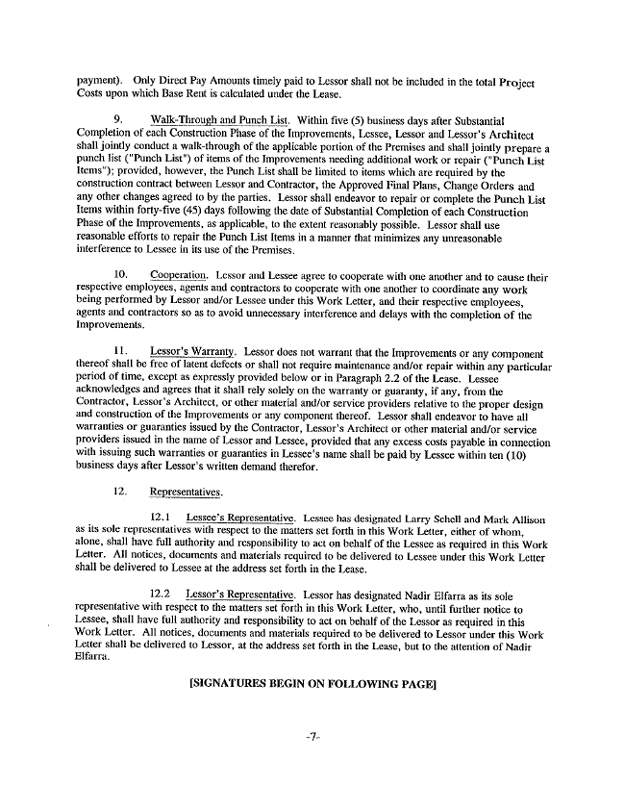
payment). Only Direct Pay Amounts timely paid to Lessor shall not be included in the total Project Costs upon which Base Rent is calculated under the Lease.
9. Walk-Through and Punch List. Within five (5) business days after Substantial Completion of each Construction Phase of the Improvements, Lessee, Lessor and Lessor’s Architect shall jointly conduct a walk-through of the applicable portion of the Premises and shall jointly prepare a punch list (“Punch List”) of items of the Improvements needing additional work or repair (“Punch List Items”); provided, however, the Punch List shall be limited to items which are required by the construction contract between Lessor and Contractor, the Approved Final Plans, Change Orders and any other changes agreed to by the parties. Lessor shall endeavor to repair or complete the Punch List Items within forty-five (45) days following the date of Substantial Completion of each Construction Phase of the Improvements, as applicable, to the extent reasonably possible. Lessor shall use reasonable efforts to repair the Punch List Items in a manner that minimizes any unreasonable interference to Lessee in its use of the Premises.
10. Cooperation. Lessor and Lessee agree to cooperate with one another and to cause their respective employees, agents and contractors to cooperate with one another to coordinate any work being performed by Lessor and/or Lessee under this Work Letter, and their respective employees, agents and contractors so as to avoid unnecessary interference and delays with the completion of the Improvements.
11. Lessor’s Warranty. Lessor does not warrant that the Improvements or any component thereof shall be free of latent defects or shall not require maintenance and/or repair within any particular period of time, except as expressly provided below or in Paragraph 2.2 of the Lease. Lessee acknowledges and agrees that it shall rely solely on the warranty or guaranty, if any, from the Contractor, Lessor’s Architect, or other material and/or service providers relative to the proper design and construction of the Improvements or any component thereof. Lessor shall endeavor to have all warranties or guaranties issued by the Contractor, Lessor’s Architect or other material and/or service providers issued in the name of Lessor and Lessee, provided that any excess costs payable in connection with issuing such warranties or guaranties in Lessee’s name shall be paid by Lessee within ten (10) business days after Lessor’s written demand therefor.
12. Representatives.
12.1 Lessee’s Representative. Lessee has designated Larry Schell and Mark Allison as its sole representatives with respect to the matters set forth in this Work Letter, either of whom, alone, shall have full authority and responsibility to act on behalf of the Lessee as required in this Work Letter. All notices, documents and materials required to be delivered to Lessee under this Work Letter shall be delivered to Lessee at the address set forth in the Lease.
12.2 Lessor’s Representative. Lessor has designated Nadir Elfarra as its sole representative with respect to the matters set forth in this Work Letter, who, until further notice to Lessee, shall have full authority and responsibility to act on behalf of the Lessor as required in this Work Letter. All notices, documents and materials required to be delivered to Lessor under this Work Letter shall be delivered to Lessor, at the address set forth in the Lease, but to the attention of Nadir Elfarra.
[SIGNATURES BEGIN ON FOLLOWING PAGE]
-7-
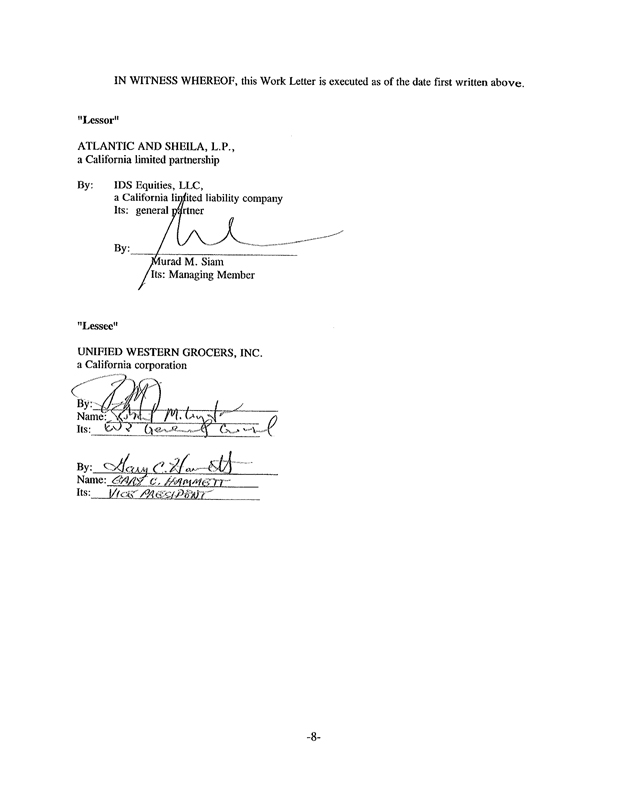
IN WITNESS WHEREOF, this Work Letter is executed as of the date first written above.
“Lessor”
ATLANTIC AND SHEILA, L.P.,
a California limited partnership
By: IDS Equities, LLC,
a California Limited liability company
Its: general partner
By:
Murad M. Siam
Its: Managing Member
“Lessee”
UNIFIED WESTERN GROCERS, INC.
a California corporation
By:
Name:
Its: EVP General Counsel
By: Gary C. Hammett
Name: Gary C. Hammett
Its: VICE PRESIDENT
-8-

SCHEDULE 1
PRELIMINARY PLANS
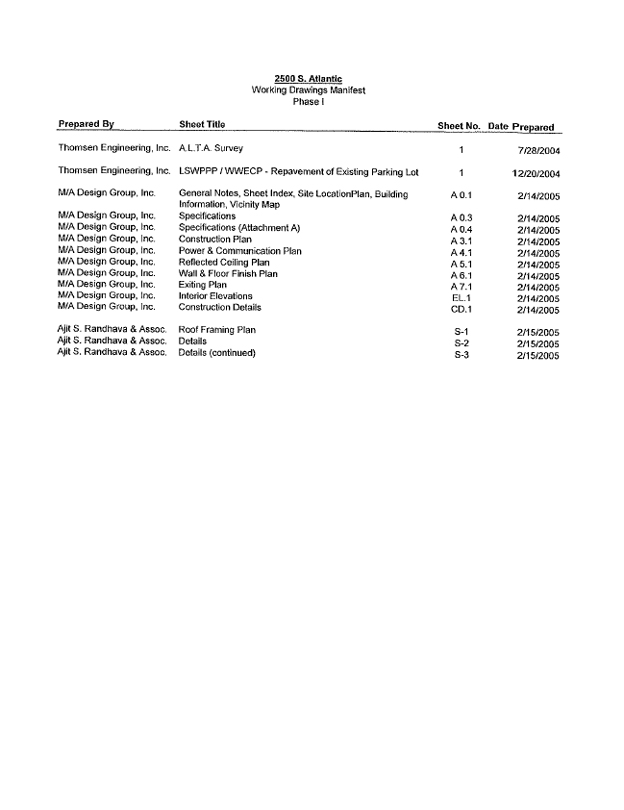
2500 S. Atlantic
Working Drawings Manifest
Phase I
Prepared By Sheet Title Sheet No. Date Prepared
Thomsen Engineering, Inc. A.L.T.A. Survey 1 7/28/2004
Thomsen Engineering, Inc. LSWPPP / WWECP - Repavement of Existing Parking Lot 1 12/20/2004
M/A Design Group, Inc. General Notes, Sheet Index, Site LocationPlan, Building Information, Vicinity Map A 0.1 2/14/2005
M/A Design Group, Inc. Specifications A 0.3 2/14/2005
M/A Design Group, Inc. Specifications (Attachment A) A 0.4 2/14/2005
M/A Design Group, Inc. Construction Plan A 3.1 2/14/2005
M/A Design Group, Inc. Power & Communication Plan A 4.1 2/14/2005
M/A Design Group, Inc. Reflected Ceiling Plan A 5.1 2/14/2005
M/A Design Group, Inc. Wall & Floor Finish Plan A 6.1 2/14/2005
M/A Design Group. Inc. Exiting Plan A 7.1 2/14/2005
M/A Design Group, Inc. Interior Elevations EL.1 2/14/2005
M/A Design Group, Inc. Construction Details CD.1 2/14/2005
Ajit S. Randhava & Assoc. Roof Framing Plan S-1 2/15/2005
Ajit S. Randhava & Assoc. Details S-2 2/15/2005
Ajit S. Randhava & Assoc. Details (continued) S-3 2/15/2005
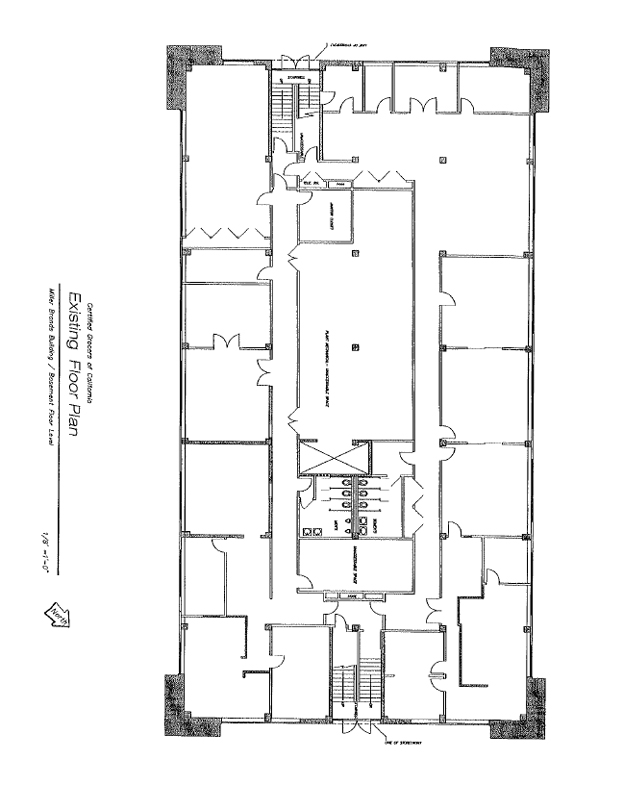
Certified Grocers of California
Existing Floor Plan
Miller Brands Building / Basement Floor Level
1/8 =1’-0”
North
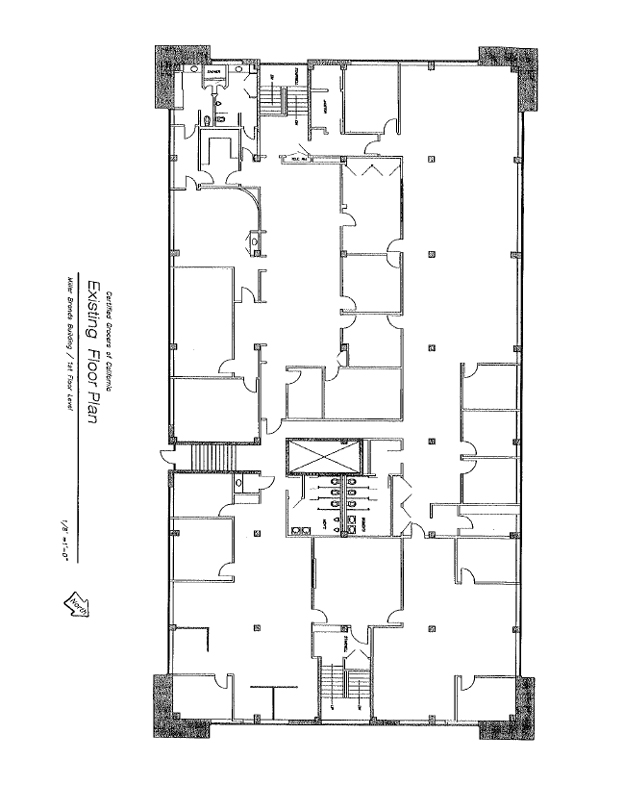
Certified Grocers of California
Existing Floor Plan
Miller Brands Building / 1st Floor Level
1/8’=1’10”
North
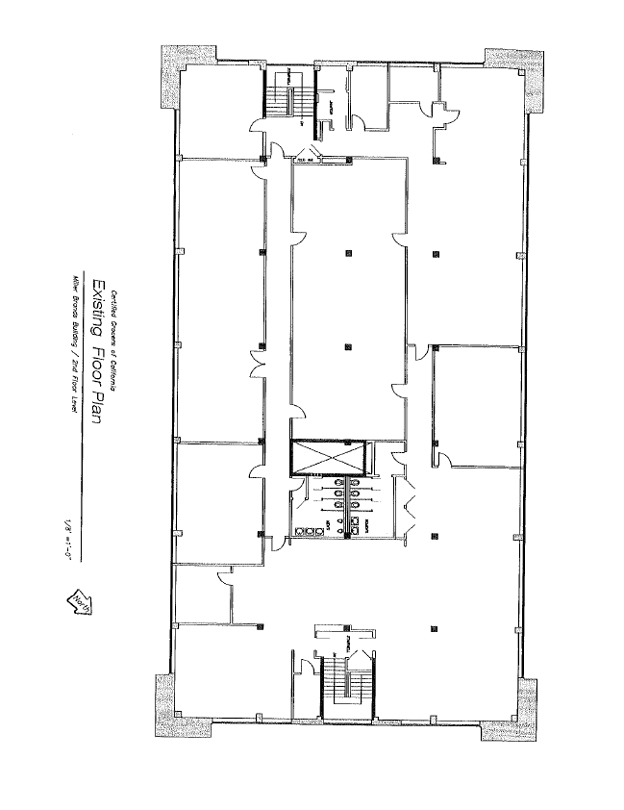
Certified Grocers of California
Existing Floor Plan
Miller Brands Building / 2nd Floor Level
1/8’=1’-0”
North
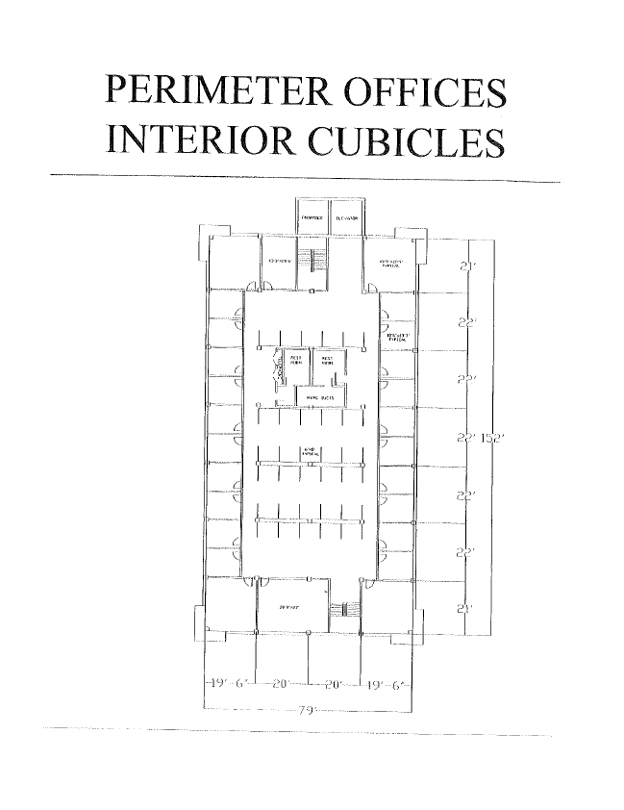
PERIMETER OFFICES
INTERIOR CUBICLES

SCHEDULE 2
PRELIMINARY BUDGET
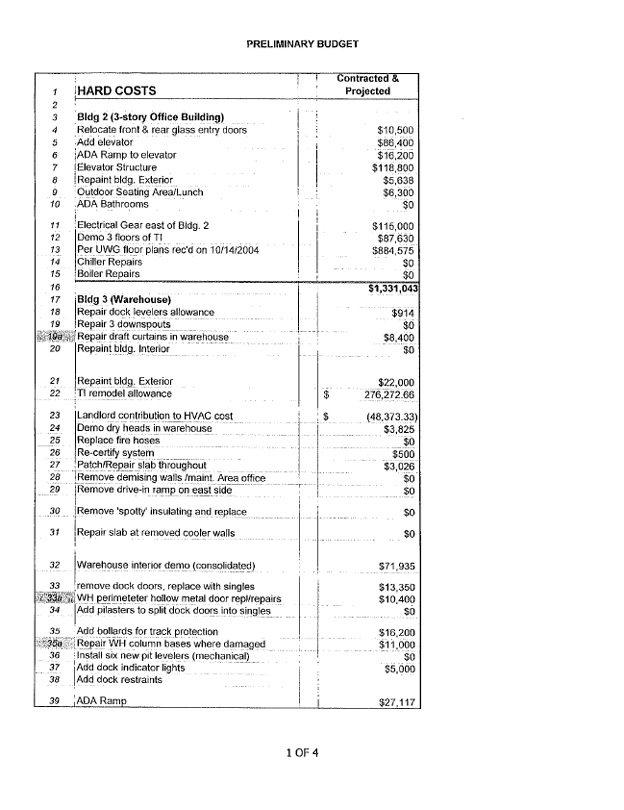
PRELIMINARY BUDGET
1 HARD COSTS Contracted & Projected
2
3 Bldg 2 (3-story Office Building)
4 Relocate front & rear glass entry doors $10,500
5 Add elevator $86,400
6 ADA Ramp to elevator $16,200
7 Elevator Structure $118,800
8 Repaint bldg. Exterior $5,638
9 Outdoor Seating Area/Lunch $6,300
10 ADA Bathrooms $0
11 Electrical Gear east of Bldg. 2 $115,000
12 Demo 3 floors of Tl $87,630
13 Per UWG floor plans rec’d on 10/14/2004 $884,575
14 Chiller Repairs $0
15 Boiler Repairs $0
16 $1,331,043
17 Bldg 3 (Warehouse)
18 Repair dock levelers allowance $914
19 Repair 3 downspouts $0
19a Repair draft curtains in warehouse $8,400
20 Repaint bldg. Interior $0
21 Repaint bldg. Exterior $22,000
22 TI remodel allowance $276,272.66
23 Landlord contribution to HVAC cost $(48,373.33)
24 Demo dry heads in warehouse $3,825
25 Replace fire hoses $0
26 Re-certify system $500
27 Patch/Repair slab throughout $3,026
28 Remove demising walls /maint. Area office $0
29 Remove drive-in ramp on east side $0
30 Remove ’spotty’ insulating and replace $0
31 Repair slab at removed cooler walls $0
32 Warehouse interior demo (consolidated) $71,935
33 remove dock doors, replace with singles $13,350
33a WH perimeteter hollow metal door repl/repairs $10,400
34 Add pilasters to split dock doors into singles $0
35 Add bollards for track protection $16,200
35a Repair WH column bases where damaged $11,000
36 Install six new pit levelers (mechanical) $0
37 Add dock indicator lights $5,000
38 Add dock restraints
39 ADA Ramp $27,117
1 OF 4
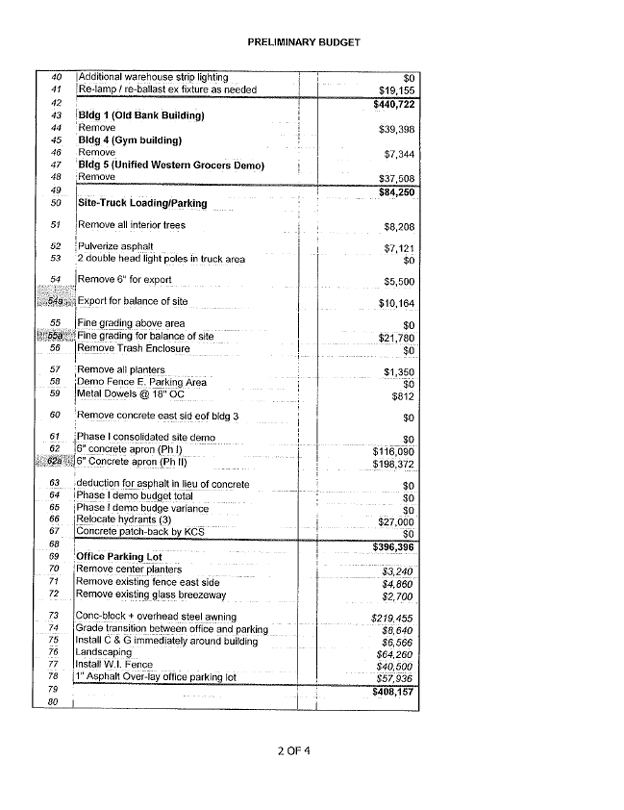
PRELIMINARY BUDGET
40 Additional warehouse strip lighting $0
41 Re-lamp / re-ballast ex fixture as needed $19,155
42 $440,722
43 Bldg 1 (Old Bank Building)
44 Remove $39,398
45 Bldg 4 (Gym building)
46 Remove $7,344
47 Bldg 5 (Unified Western Grocers Demo)
48 Remove $37,508
49 $84,250
50 Site-Truck Loading/Parking
51 Remove all interior trees $8,208
52 Pulverize asphalt $7,121
53 2 double head light poles in truck area $0
54 Remove 6” for export $5,500
54a Export for balance of site $10,164
55 Fine grading above area $0
55a Fine grading for balance of site $21,780
56 Remove Trash Enclosure $0
57 Remove all planters $1,350
58 Demo Fence E. Parking Area $0
59 Metal Dowels @ 18” OC $812
60 Remove concrete east sid eof bldg 3 $0
61 Phase I consolidated site demo $0
62 6” concrete apron (Ph I) $116,090
62a 6” Concrete apron (Ph II) $198,372
63 deduction for asphalt in lieu of concrete $0
64 Phase I demo budget total $0
65 Phase I demo budge variance $0
66 Relocate hydrants (3) $27,000
67 Concrete patch-back by KCS $0
68 $396,396
69 Office Parking Lot
70 Remove center planters $3,240
71 Remove existing fence east side $4,860
72 Remove existing glass breezeway $2,700
73 Conc-block + overhead steel awning $219,455
74 Grade transition between office and parking $8,640
75 Install C & G immediately around building $6,566
76 Landscaping $64,260
77 Install W.I. Fence $40,500
78 1” Asphalt Over-lay office parking lot $57,936
79 $408,157
80
2 OR 4
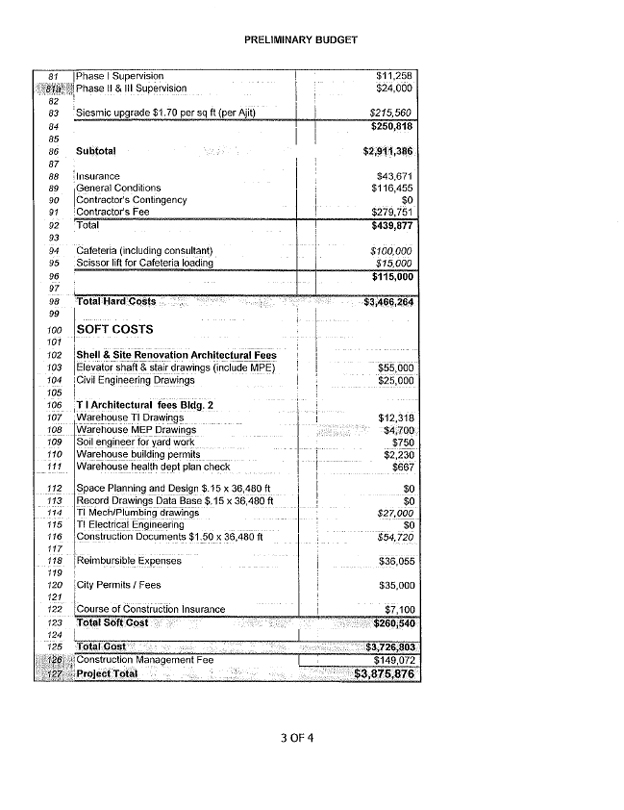
PRELIMINARY BUDGET
81 Phase I Supervision $11,258
81a Phase II & III Supervision $24,000
82
83 Siesmic upgrade $1.70 per sq ft (per Ajit) $215,560
84 $250,818
85
86 Subtotal $2,911,386
87
88 Insurance $43,671
89 General Conditions $116,455
90 Contractor’s Contingency $0
91 Contractor’s Fee $279,751
92 Total $439,877
93
94 Cafeteria (including consultant) $100,000
95 Scissor lift for Cafeteria loading $15,000
96 $115,000
97
98 Total Hard Costs $3,466,264
99
100 SOFT COSTS
101
102 Shell & Site Renovation Architectural Fees
103 Elevator shaft & stair drawings (include MPE) $55,000
104 Civil Engineering Drawings $25,000
105
106 T I Architectural fees Bldg. 2
107 Warehouse TI Drawings $12,318
108 Warehouse MEP Drawings $4,700
109 Soil engineer for yard work $750
110 Warehouse building permits $2,230
111 Warehouse health dept plan check $667
112 Space Planning and Design $.15 x 36,480 ft $0
113 Record Drawings Data Base $.15 x 36,480 ft $0
114 TI Mech/Plumbing drawings $27,000
115 TI Electrical Engineering $0
116 Construction Documents $1.50 x 36,480 ft $54,720
117
118 Reimbursible Expenses $36,055
119
120 City Permits / Fees $35,000
121
122 Course of Construction Insurance $7,100
123 Total Soft Cost $260,540
124
125 Total Cost $3,726,803
126 Construction Management Fee $149,072
127 Project Total $3,875,876
3 OF 4
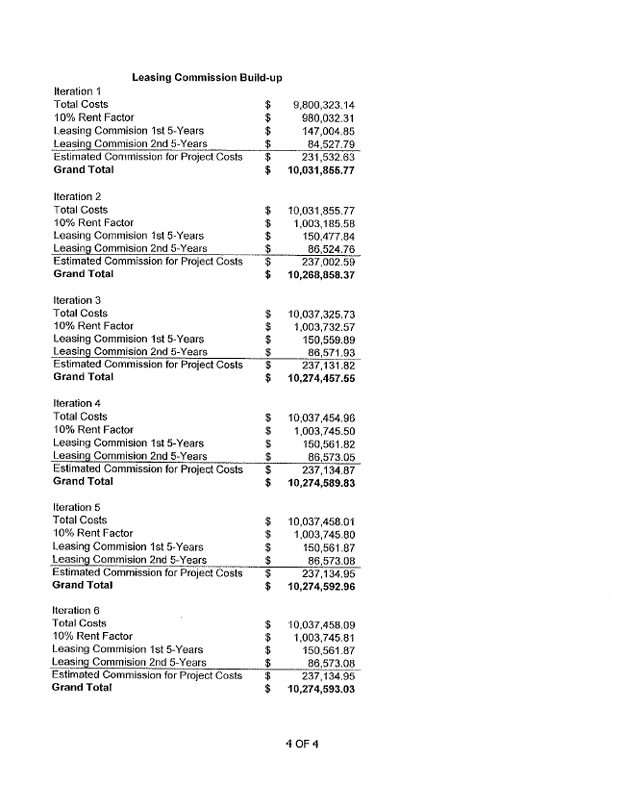
Leasing Commission Build-up
Iteration 1
Total Costs $ 9,800,323.14
10% Rent Factor $ 980,032.31
Leasing Commision 1st 5-Years $ 147,004.85
Leasing Commision 2nd 5-Years $ 84,527.79
Estimated Commission for Project Costs $ 231,532.63
Grand Total $ 10,031,855.77
Iteration 2
Total Costs $ 10,031,855.77
10% Rent Factor $ 1,003,185.58
Leasing Commision 1st 5-Years $ 150,477.84
Leasing Commision 2nd 5-Years $ 86,524.76
Estimated Commission for Project Costs $ 237,002.59
Grand Total $ 10,268,858.37
Iteration 3
Total Costs $ 10,037,325.73
10% Rent Factor $ 1,003,732.57
Leasing Commision 1st 5-Years $ 150,559.89
Leasing Commision 2nd 5-Years $ 86,571.93
Estimated Commission for Project Costs $ 237,131.82
Grand Total $ 10,274,457.55
Iteration 4
Total Costs $ 10,037,454.96
10% Rent Factor $ 1,003,745.50
Leasing Commision 1st 5-Years $ 150,561.82
Leasing Commision 2nd 5-Years $ 86,573.05
Estimated Commission for Project Costs $ 237,134.87
Grand Total $ 10,274,589.83
Iteration 5
Total Costs $ 10,037,458.01
10% Rent Factor $ 1,003,745.80
Leasing Commision 1st 5-Years $ 150,561.87
Leasing Commision 2nd 5-Years $ 86,573.08
Estimated Commission for Project Costs $ 237,134.95
Grand Total $ 10,274,592.96
Iteration 6
Total Costs $ 10,037,458.09
10% Rent Factor $ 1,003,745.81
Leasing Commision 1st 5-Years $ 150,561.87
Leasing Commision 2nd 5-Years $ 86,573.08
Estimated Commission for Project Costs $ 237,134.95
Grand Total $ 10,274,593.03
4 OF 4
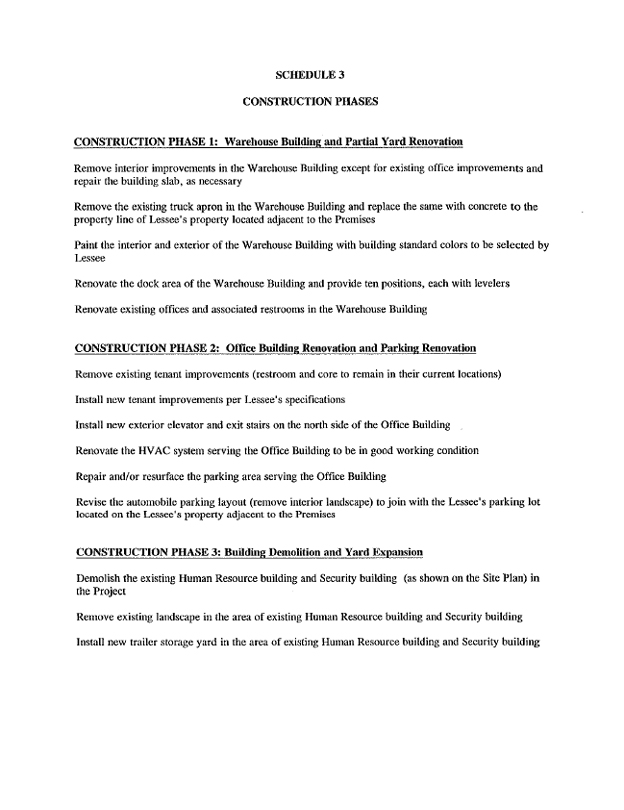
SCHEDULE 3
CONSTRUCTION PHASES
CONSTRUCTION PHASE 1: Warehouse Building and Partial Yard Renovation
Remove interior improvements in the Warehouse Building except for existing office improvements and repair the building slab, as necessary
Remove the existing truck apron in the Warehouse Building and replace the same with concrete to the property line of Lessee’s property located adjacent to the Premises
Paint the interior and exterior of the Warehouse Building with building standard colors to be selected by Lessee
Renovate the dock area of the Warehouse Building and provide ten positions, each with levelers
Renovate existing offices and associated restrooms in the Warehouse Building
CONSTRUCTION PHASE 2: Office Building Renovation and Parking Renovation
Remove existing tenant improvements (restroom and core to remain in their current locations)
Install new tenant improvements per Lessee’s specifications
Install new exterior elevator and exit stairs on the north side of the Office Building
Renovate the HVAC system serving the Office Building to be in good working condition
Repair and/or resurface the parking area serving the Office Building
Revise the automobile parking layout (remove interior landscape) to join with the Lessee’s parking lot located on the Lessee’s property adjacent to the Premises
CONSTRUCTION PHASE 3: Building Demolition and Yard Expansion
Demolish the existing Human Resource building and Security building (as shown on the Site Plan) in the Project
Remove existing landscape in the area of existing Human Resource building and Security building
Install new trailer storage yard in the area of existing Human Resource building and Security building
Exhibit 10.5
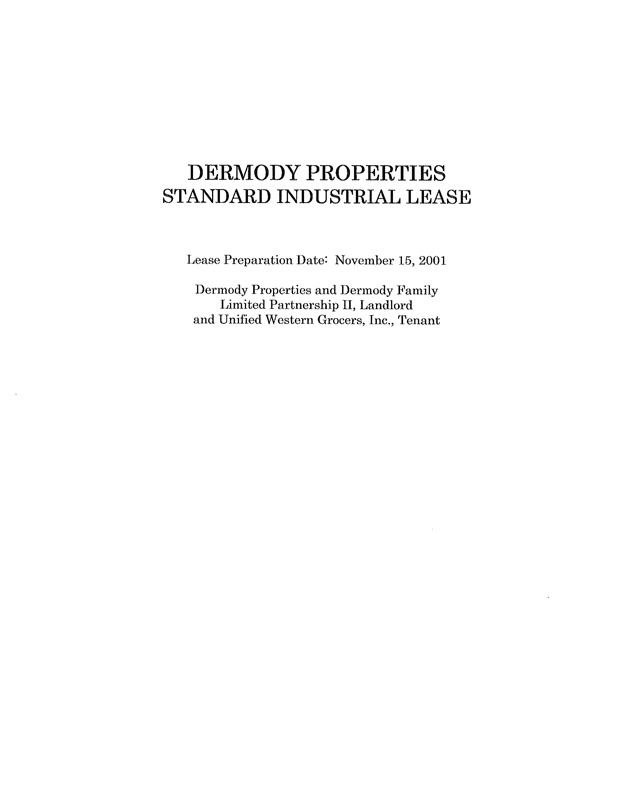
DERMODY PROPERTIES
STANDARD INDUSTRIAL LEASE
Lease Preparation Date: November 15, 2001
Dermody Properties and Dermody Family Limited Partnership II, Landlord and Unified Western Grocers, Inc., Tenant
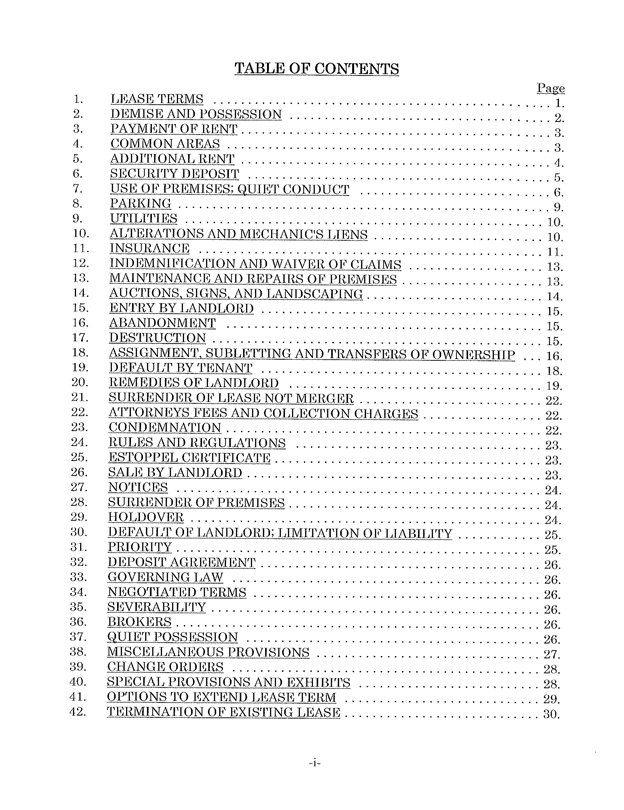
TABLE OF CONTENTS
Page
1. LEASE TERMS 1.
2. DEMISE AND POSSESSION 2.
3. PAYMENT OF RENT 3.
4. COMMON AREAS 3.
5. ADDITIONAL RENT 4.
6. SECURITY DEPOSIT 5.
7. USE OF PREMISES; QUIET CONDUCT 6.
8. PARKING 9.
9. UTILITIES 10.
10. ALTERATIONS AND MECHANIC’S LIENS 10.
11. INSURANCE 11.
12. INDEMNIFICATION AND WAIVER OF CLAIMS 13.
13. MAINTENANCE AND REPAIRS OF PREMISES 13.
14. AUCTIONS, SIGNS, AND LANDSCAPING 14.
15. ENTRY BY LANDLORD 15.
16. ABANDONMENT 15.
17. DESTRUCTION 15.
18. ASSIGNMENT, SUBLETTING AND TRANSFERS OF OWNERSHIP 16.
19. DEFAULT BY TENANT 18.
20. REMEDIES OF LANDLORD 19.
21. SURRENDER OF LEASE NOT MERGER 22.
22. ATTORNEYS FEES AND COLLECTION CHARGES 22.
23. CONDEMNATION 22.
24. RULES AND REGULATIONS 23.
25. ESTOPPEL CERTIFICATE 23.
26. SALE BY LANDLORD 23.
27. NOTICES 24.
28. SURRENDER OF PREMISES 24.
29. HOLDOVER 24.
30. DEFAULT OF LANDLORD; LIMITATION OF LIABILITY 25.
31. PRIORITY 25.
32. DEPOSIT AGREEMENT 26.
33. GOVERNING LAW 26.
34. NEGOTIATED TERMS 26.
35. SEVERABILITY 26.
36. BROKERS 26.
37. QUIET POSSESSION 26.
38. MISCELLANEOUS PROVISIONS 27.
39. CHANGE ORDERS 28.
40. SPECIAL PROVISIONS AND EXHIBITS 28.
41. OPTIONS TO EXTEND LEASE TERM 29.
42. TERMINATION OF EXISTING LEASE 30.
-i-
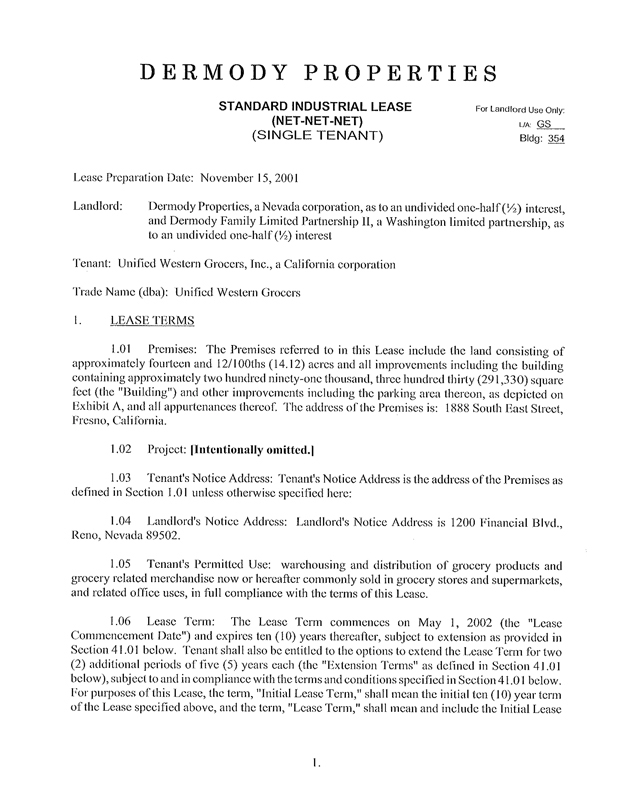
DERMODY PROPERTIES
STANDARD INDUSTRIAL LEASE For Landlord Use Only: (NET-NET-NET) L/A: GS (SINGLE TENANT) Bldg: 354
Lease Preparation Date: November 15, 2001
Landlord: Dermody Properties, a Nevada corporation, as to an undivided one-half (1/2) interest, and Dermody Family Limited Partnership II, a Washington limited partnership, as to an undivided one-half (1/2) interest
Tenant: Unified Western Grocers, Inc., a California corporation
Trade Name (dba): Unified Western Grocers
1. LEASE TERMS
1.01 Premises: The Premises referred to in this Lease include the land consisting of approximately fourteen and 12/100ths (14.12) acres and all improvements including the building containing approximately two hundred ninety-one thousand, three hundred thirty (291,330) square feet (the “Building”) and other improvements including the parking area thereon, as depicted on Exhibit A, and all appurtenances thereof. The address of the Premises is: 1888 South East Street, Fresno, California.
1.02 Project: [Intentionally omitted.]
1.03 Tenant’s Notice Address: Tenant’s Notice Address is the address of the Premises as defined in Section 1.01 unless otherwise specified here:
1.04 Landlord’s Notice Address: Landlord’s Notice Address is 1200 Financial Blvd., Reno, Nevada 89502.
1.05 Tenant’s Permitted Use: warehousing and distribution of grocery products and grocery related merchandise now or hereafter commonly sold in grocery stores and supermarkets, and related office uses, in full compliance with the terms of this Lease.
1.06 Lease Term: The Lease Term commences on May 1, 2002 (the “Lease Commencement Date”) and expires ten (10) years thereafter, subject to extension as provided in Section 41.01 below. Tenant shall also be entitled to the options to extend the Lease Term for two (2) additional periods of five (5) years each (the “Extension Terms” as defined in Section 41.01 below), subject to and in compliance with the terms and conditions specified in Section 41.01 below. For purposes of this Lease, the term, “Initial Lease Term,” shall mean the initial ten (10) year term of the Lease specified above, and the term, “Lease Term,” shall mean and include the Initial Lease
1.
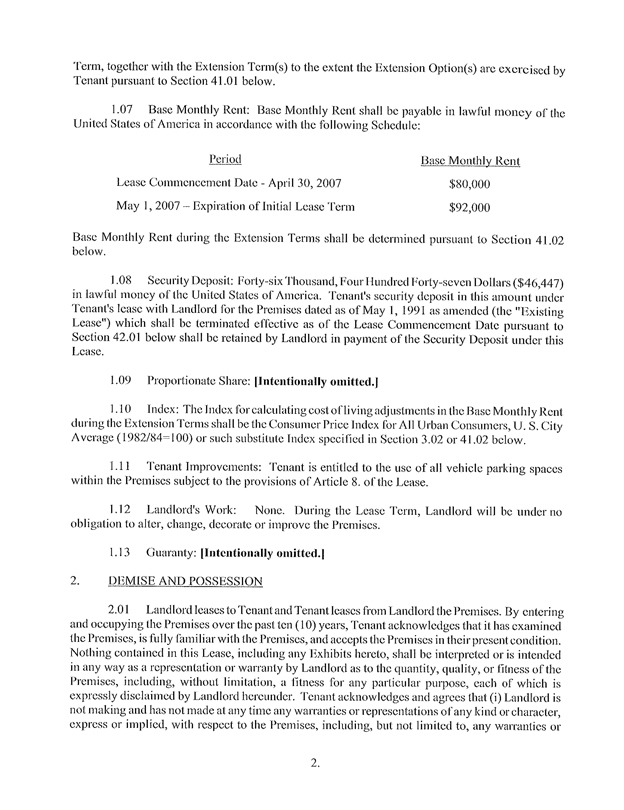
Term, together with the Extension Term(s) to the extent the Extension Option(s) are exercised by Tenant pursuant to Section 41.01 below.
1.07 Base Monthly Rent: Base Monthly Rent shall be payable in lawful money of the United States of America in accordance with the following Schedule:
Period Base Monthly Rent
Lease Commencement Date - April 30, 2007 $80,000
May 1, 2007 – Expiration of Initial Lease Term $92,000
Base Monthly Rent during the Extension Terms shall be determined pursuant to Section 41.02 below.
1.08 Security Deposit: Forty-six Thousand, Four Hundred Forty-seven Dollars ($46,447) in lawful money of the United States of America. Tenant’s security deposit in this amount under Tenant’s lease with Landlord for the Premises dated as of May 1, 1991 as amended (the “Existing Lease”) which shall be terminated effective as of the Lease Commencement Date pursuant to Section 42.01 below shall be retained by Landlord in payment of the Security Deposit under this Lease.
1.09 Proportionate Share: [Intentionally omitted.]
1.10 Index: The Index for calculating cost of living adjustments in the Base Monthly Rent during the Extension Terms shall be the Consumer Price Index for All Urban Consumers, U.S. City Average (1982/84=100) or such substitute Index specified in Section 3.02 or 41.02 below.
1.11 Tenant Improvements: Tenant is entitled to the use of all vehicle parking spaces within the Premises subject to the provisions of Article 8. of the Lease.
1.12 Landlord’s Work: None. During the Lease Term, Landlord will be under no obligation to alter, change, decorate or improve the Premises.
1.13 Guaranty: [Intentionally omitted.]
2. DEMISE AND POSSESSION
2.01 Landlord leases to Tenant and Tenant leases from Landlord the Premises. By entering and occupying the Premises over the past ten (10) years, Tenant acknowledges that it has examined the Premises, is fully familiar with the Premises, and accepts the Premises in their present condition. Nothing contained in this Lease, including any Exhibits hereto, shall be interpreted or is intended in any way as a representation or warranty by Landlord as to the quantity, quality, or fitness of the Premises, including, without limitation, a fitness for any particular purpose, each of which is expressly disclaimed by Landlord hereunder. Tenant acknowledges and agrees that (i) Landlord is not making and has not made at any time any warranties or representations of any kind or character, express or implied, with respect to the Premises, including, but not limited to, any warranties or
2.
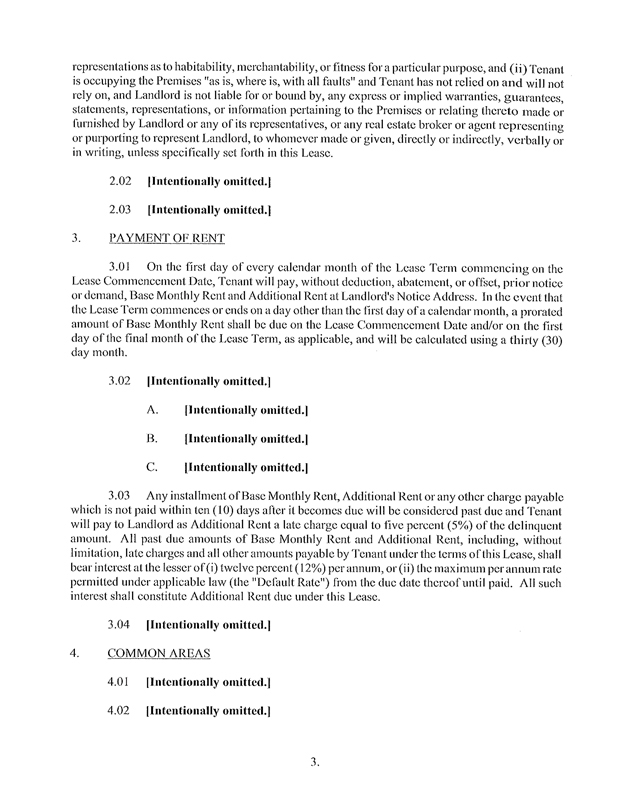
representations as to habitability, merchantability, or fitness for a particular purpose, and (ii) Tenant is occupying the Premises “as is, where is, with all faults” and Tenant has not relied on and will not rely on, and Landlord is not liable for or bound by, any express or implied warranties, guarantees, statements, representations, or information pertaining to the Premises or relating thereto made or furnished by Landlord or any of its representatives, or any real estate broker or agent representing or purporting to represent Landlord, to whomever made or given, directly or indirectly, verbally or in writing, unless specifically set forth in this Lease.
2.02 [Intentionally omitted.]
2.03 [Intentionally omitted.]
3. PAYMENT OF RENT
3.01 On the first day of every calendar month of the Lease Term commencing on the Lease Commencement Date, Tenant will pay, without deduction, abatement, or offset, prior notice or demand, Base Monthly Rent and Additional Rent at Landlord’s Notice Address. In the event that the Lease Term commences or ends on a day other than the first day of a calendar month, a prorated amount of Base Monthly Rent shall be due on the Lease Commencement Date and/or on the first day of the final month of the Lease Term, as applicable, and will be calculated using a thirty (30) day month.
3.02 [Intentionally omitted.]
A. [Intentionally omitted.]
B. [Intentionally omitted.]
C. [Intentionally omitted.)
3.03 Any installment of Base Monthly Rent, Additional Rent or any other charge payable which is not paid within ten (10) days after it becomes due will be considered past due and Tenant will pay to Landlord as Additional Rent a late charge equal to five percent (5%) of the delinquent amount. All past due amounts of Base Monthly Rent and Additional Rent, including, without limitation, late charges and all other amounts payable by Tenant under the terms of this Lease, shall bear interest at the lesser of (i) twelve percent (12%) per annum, or (ii) the maximum per annum rate permitted under applicable law (the “Default Rate”) from the due date thereof until paid. All such interest shall constitute Additional Rent due under this Lease.
3.04 [Intentionally omitted.]
4. COMMON AREAS
4.01 [Intentionally omitted.]
4.02 [Intentionally omitted.]
3.
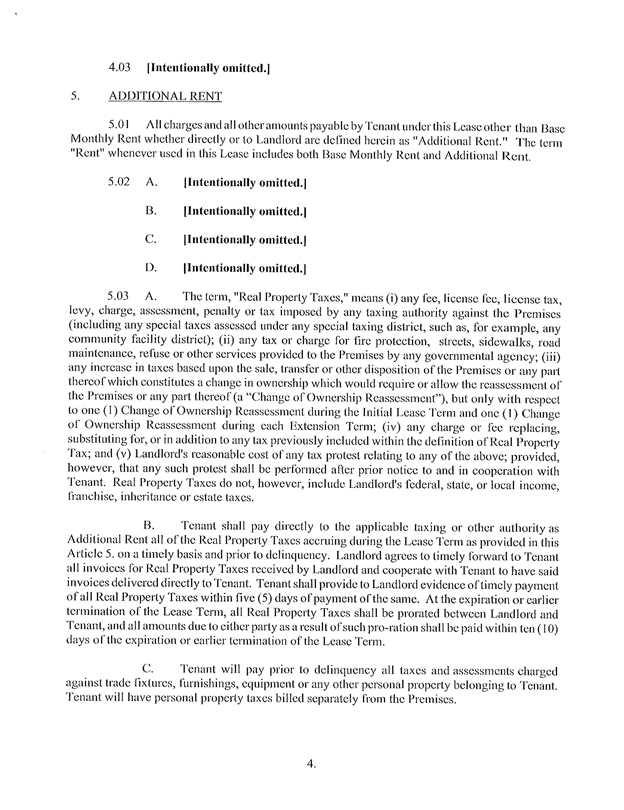
4.03 [Intentionally omitted.]
5. ADDITIONAL RENT
5.01 All charges and all other amounts payable by Tenant under this Lease other than Base Monthly Rent whether directly or to Landlord are defined herein as “Additional Rent.” The term “Rent” whenever used in this Lease includes both Base Monthly Rent and Additional Rent.
5.02 A. [Intentionally omitted.]
B. [Intentionally omitted.]
C. [Intentionally omitted.]
D. [Intentionally omitted.]
5.03 A. The term, “Real Property Taxes,” means (i) any fee, license fee, license tax, levy, charge, assessment, penalty or tax imposed by any taxing authority against the Premises (including any special taxes assessed under any special taxing district, such as, for example, any community facility district); (ii) any tax or charge for fire protection, streets, sidewalks, road maintenance, refuse or other services provided to the Premises by any governmental agency; (iii) any increase in taxes based upon the sale, transfer or other disposition of the Premises or any part thereof which constitutes a change in ownership which would require or allow the reassessment of the Premises or any part thereof (a “Change of Ownership Reassessment”), but only with respect to one (1) Change of Ownership Reassessment during the Initial Lease Term and one (1) Change of Ownership Reassessment during each Extension Term; (iv) any charge or fee replacing, substituting for, or in addition to any tax previously included within the definition of Real. Property Tax; and (v) Landlord’s reasonable cost of any tax protest relating to any of the above; provided, however, that any such protest shall be performed after prior notice to and in cooperation with tenant. Real Property Taxes do not, however, include Landlord’s federal, state, or local income, franchise, inheritance or estate taxes.
B. Tenant shall pay directly to the applicable taxing or other authority as Additional Rent all of the Real Property Taxes accruing during the Lease Term as provided in this Article 5. on a timely basis and prior to delinquency. Landlord agrees to timely forward to Tenant all invoices for Real Property Taxes received by Landlord and cooperate with Tenant to have said invoices delivered directly to Tenant. Tenant shall provide to Landlord evidence of timely payment of all Real Property Taxes within five (5) days of payment of the same. At the expiration or earlier termination of the Lease Term, all Real Property Taxes shall be prorated between Landlord and Tenant, and all amounts due to either party as a result of such pro-ration shall be paid within ten (10) days of the expiration or earlier termination of the Lease Term.
C. Tenant will pay prior to delinquency all taxes and assessments charged against trade fixtures, furnishings, equipment or any other personal property belonging to Tenant. Tenant will have personal property taxes billed separately from the Premises.
4.
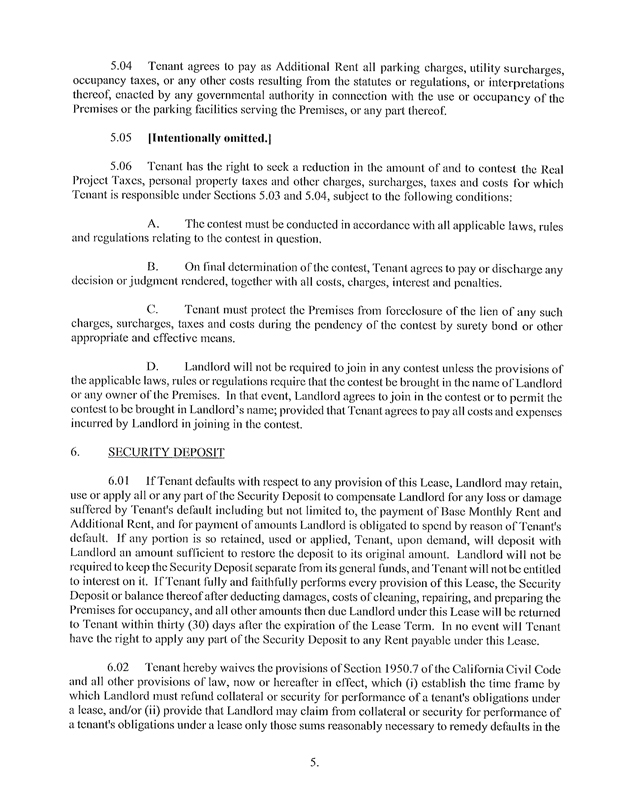
5.04 Tenant agrees to pay as Additional Rent all parking charges, utility surcharges, occupancy taxes, or any other costs resulting from the statutes or regulations, or interpretations thereof, enacted by any governmental authority in connection with the use or occupancy of the Premises or the parking facilities serving the Premises, or any part thereof.
5.05 [Intentionally omitted.]
5.06 Tenant has the right to seek a reduction in the amount of and to contest the Real Project Taxes, personal property taxes and other charges, surcharges, taxes and costs for which Tenant is responsible under Sections 5.03 and 5.04, subject to the following conditions:
A. The contest must be conducted in accordance with all applicable laws, rules and regulations relating to the contest in question.
B. On final determination of the contest, Tenant agrees to pay or discharge any decision or judgment rendered, together with all costs, charges, interest and penalties.
C. Tenant must protect the Premises from foreclosure of the lien of any such charges, surcharges, taxes and costs during the pendency of the contest by surety bond or other appropriate and effective means.
D. Landlord will not be required to join in any contest unless the provisions of the applicable laws, rules or regulations require that the contest be brought in the name of Landlord or any owner of the Premises. In that event, Landlord agrees to join in the contest or to permit the contest to be brought in Landlord’s name; provided that Tenant agrees to pay all costs and expenses incurred by Landlord in joining in the contest.
6. SECURITY DEPOSIT
6.01 If Tenant defaults with respect to any provision of this Lease, Landlord may retain, use or apply all or any part of the Security Deposit to compensate Landlord for any loss or damage suffered by Tenant’s default including but not limited to, the payment of Base Monthly Rent and Additional Rent, and for payment of amounts Landlord is obligated to spend by reason of Tenant’s default. If any portion is so retained, used or applied, Tenant, upon demand, will deposit with Landlord an amount sufficient to restore the deposit to its original amount. Landlord will not be required to keep the Security Deposit separate from its general funds, and Tenant will not be entitled to interest on it. If Tenant fully and faithfully performs every provision of this Lease, the Security Deposit or balance thereof after deducting damages, costs of cleaning, repairing, and preparing the Premises for occupancy, and all other amounts then due Landlord under this Lease will be returned to Tenant within thirty (30) days after the expiration of the Lease Term. In no event will Tenant have the right to apply any part of the Security Deposit to any Rent payable under this Lease.
6.02 Tenant hereby waives the provisions of Section 1950.7 of the California Civil Code and all other provisions of law, now or hereafter in effect, which (i) establish the time frame by which Landlord must refund collateral or security for performance of a tenant’s obligations under a lease, and/or (ii) provide that Landlord may claim from collateral or security for performance of a tenant’s obligations under a lease only those sums reasonably necessary to remedy defaults in the
5.
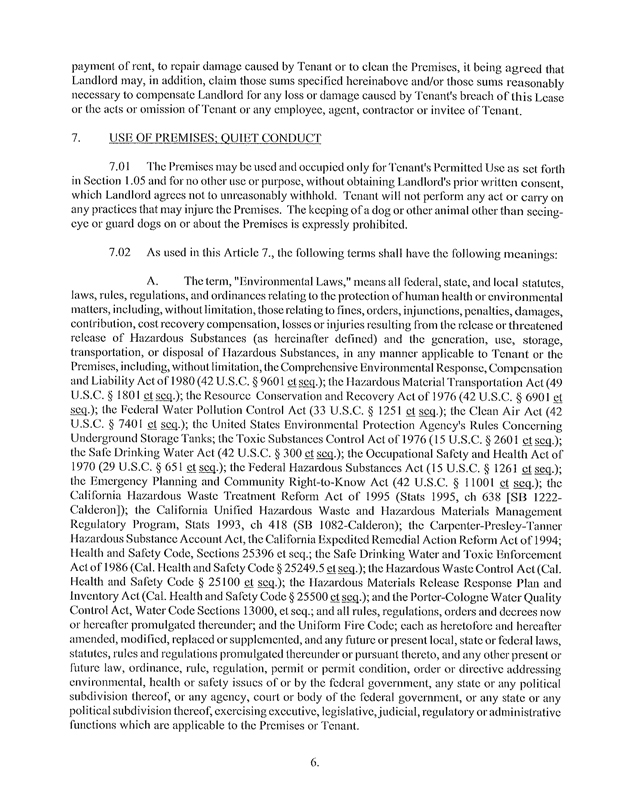
payment of rent, to repair damage caused by Tenant or to clean the Premises, it being agreed that Landlord may, in addition, claim those sums specified hereinabove and/or those sums reasonably necessary to compensate Landlord for any loss or damage caused by Tenant’s breach of this Lease or the acts or omission of Tenant or any employee, agent, contractor or invitee of Tenant.
7. USE OF PREMISES; QUIET CONDUCT
7.01 The Premises may be used and occupied only for Tenant’s Permitted Use as set forth in Section 1.05 and for no other use or purpose, without obtaining Landlord’s prior written consent, which Landlord agrees not to unreasonably withhold. Tenant will not perform any act or carry on any practices that may injure the Premises. The keeping of a dog or other animal other than seeing- eye or guard dogs on or about the Premises is expressly prohibited.
7.02 As used in this Article 7., the following terms shall have the following meanings:
A. The term, “Environmental Laws,” means all federal, state, and local statutes, laws, rules, regulations, and ordinances relating to the protection of human health or environmental matters, including, without limitation, those relating to fines, orders, injunctions, penalties, damages, contribution, cost recovery compensation, losses or injuries resulting from the release or threatened release of Hazardous Substances (as hereinafter defined) and the generation, use, storage, transportation, or disposal of Hazardous Substances, in any manner applicable to Tenant or the Premises, including, without limitation, the Comprehensive Environmental Response, Compensation and Liability Act of 1980 (42 U.S.C. § 9601 et seq.); the Hazardous Material Transportation Act (49 U.S.C. § 1801 et seq.); the Resource Conservation and Recovery Act of 1976 (42 U.S.C. § 6901 et seq.); the Federal Water Pollution Control Act (33 U.S.C. § 1251 et seq.); the Clean Air Act (42 U.S.C. § 7401 et seq.); the United States Environmental Protection Agency’s Rules Concerning Underground Storage Tanks; the Toxic Substances Control Act of 1976 (15 U.S.C. § 2601 et seq.); the Safe Drinking Water Act (42 U.S.C. § 300 et seq.): the Occupational Safety and Health Act of 1970 (29 U.S.C. § 651 et seq.); the Federal Hazardous Substances Act (15 U.S.C. § 1261 et seq.); the Emergency Planning and Community Right-to-Know Act (42 U.S.C. § 11001 et seq.); the California Hazardous Waste Treatment Reform Act of 1995 (Stats 1995, ch 638 [SB 1222-Calderon]); the California Unified Hazardous Waste and Hazardous Materials Management Regulatory Program, Stats 1993, ch 418 (SB 1082-Calderon); the Carpenter-Presley-Tanner Hazardous Substance Account Act, the California Expedited Remedial Action Reform Act of 1994; Health and Safety Code, Sections 25396 et seq.; the Safe Drinking Water and Toxic Enforcement Act of 1986 (Cal. Health and Safety Code § 25249.5 et seq.); the Hazardous Waste Control Act (Cal. Health and Safety Code § 25100 et seq.): the Hazardous Materials Release Response Plan and Inventory Act (Cal. Health and Safety Code § 25500 et seq.); and the Porter-Cologne Water Quality Control Act, Water Code Sections 13000, et seq.; and all rules, regulations, orders and decrees now or hereafter promulgated thereunder; and the Uniform Fire Code; each as heretofore and hereafter amended, modified, replaced or supplemented, and any future or present local, state or federal laws, statutes, rules and regulations promulgated thereunder or pursuant thereto, and any other present or future law, ordinance, rule, regulation, permit or permit condition, order or directive addressing environmental, health or safety issues of or by the federal government, any state or any political subdivision thereof, or any agency, court or body of the federal government, or any state or any political subdivision thereof, exercising executive, legislative, judicial, regulatory or administrative functions which are applicable to the Premises or Tenant.
6.
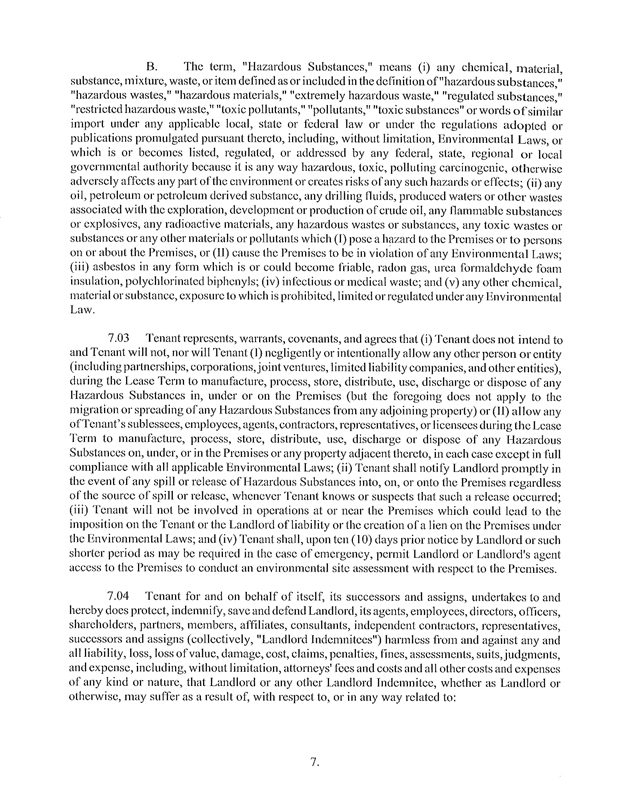
B. The term, “Hazardous Substances,” means (i) any chemical, material, substance, mixture, waste, or item defined as or included in the definition of “hazardous substances,” “hazardous wastes,” “hazardous materials,” “extremely hazardous waste,” “regulated substances,” “restricted hazardous waste,” “toxic pollutants,” “pollutants,” “toxic substances” or words of similar import under any applicable local, state or federal law or under the regulations adopted or publications promulgated pursuant thereto, including, without limitation, Environmental Laws, or which is or becomes listed, regulated, or addressed by any federal, state, regional or local governmental authority because it is any way hazardous, toxic, polluting carcinogenic, otherwise adversely affects any part of the environment or creates risks of any such hazards or effects; (ii) any oil, petroleum or petroleum derived substance, any drilling fluids, produced waters or other wastes associated with the exploration, development or production of crude oil, any flammable substances or explosives, any radioactive materials, any hazardous wastes or substances, any toxic wastes or substances or any other materials or pollutants which (I) pose a hazard to the Premises or to persons on or about the Premises, or (II) cause the Premises to be in violation of any Environmental Laws; (iii) asbestos in any form which is or could become friable, radon gas, urea formaldehyde foam insulation, polychlorinated biphenyls; (iv) infectious or medical waste; and (v) any other chemical, material or substance, exposure to which is prohibited, limited or regulated under any Environmental Law.
7.03 Tenant represents, warrants, covenants, and agrees that (i) Tenant does not intend to and Tenant will not, nor will Tenant (I) negligently or intentionally allow any other person or entity (including partnerships, corporations, joint ventures, limited liability companies, and other entities), during the Lease Term to manufacture, process, store, distribute, use, discharge or dispose of any Hazardous Substances in, under or on the Premises (but the foregoing does not apply to the migration or spreading of any Hazardous Substances from any adjoining property) or (II) allow any of Tenant’s sublessees, employees, agents, contractors, representatives, or licensees during the Lease Term to manufacture, process, store, distribute, use, discharge or dispose of any Hazardous Substances on, under, or in the Premises or any property adjacent thereto, in each case except in full compliance with all applicable Environmental Laws; (ii) Tenant shall notify Landlord promptly in the event of any spill or release of Hazardous Substances into, on, or onto the Premises regardless of the source of spill or release, whenever Tenant knows or suspects that such a release occurred; (iii) Tenant will not be involved in operations at or near the Premises which could lead to the imposition on the Tenant or the Landlord of liability or the creation of a lien on the Premises under the Environmental Laws; and (iv) Tenant shall, upon ten (10) days prior notice by Landlord or such shorter period as may be required in the case of emergency, permit Landlord or Landlord’s agent access to the Premises to conduct an environmental site assessment with respect to the Premises.
7.04 Tenant for and on behalf of itself, its successors and assigns, undertakes to and hereby does protect, indemnify, save and defend Landlord, its agents, employees, directors, officers, shareholders, partners, members, affiliates, consultants, independent contractors, representatives, successors and assigns (collectively, “Landlord Indemnitees”) harmless from and against any and all liability, loss, loss of value, damage, cost, claims, penalties, fines, assessments, suits, judgments, and expense, including, without limitation, attorneys’ fees and costs and all other costs and expenses of any kind or nature, that Landlord or any other Landlord Indemnitee, whether as Landlord or otherwise, may suffer as a result of, with respect to, or in any way related to:
7.
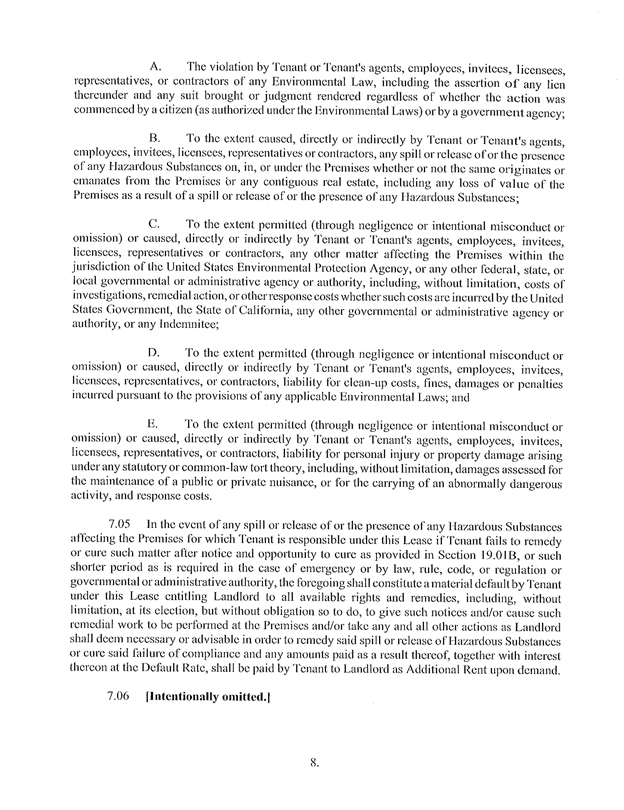
A. The violation by Tenant or Tenant’s agents, employees, invitees, licensees, representatives, or contractors of any Environmental Law, including the assertion of any lien thereunder and any suit brought or judgment rendered regardless of whether the action was commenced by a citizen (as authorized under the Environmental Laws) or by a government agency;
B. To the extent caused, directly or indirectly by Tenant or Tenant’s agents, employees, invitees, licensees, representatives or contractors, any spill or release of or the presence of any Hazardous Substances on, in, or under the Premises whether or not the same originates or emanates from the Premises or any contiguous real estate, including any loss of value of the Premises as a result of a spill or release of or the presence of any Hazardous Substances;
C. To the extent permitted (through negligence or intentional misconduct or omission) or caused, directly or indirectly by Tenant or Tenant’s agents, employees, invitees, licensees, representatives or contractors, any other matter affecting the Premises within the jurisdiction of the United States Environmental Protection Agency, or any other federal, state, or local governmental or administrative agency or authority, including, without limitation, costs of investigations, remedial action, or other response costs whether such costs are incurred by the United States Government, the State of California, any other governmental or administrative agency or authority, or any Indemnitee;
D. To the extent permitted (through negligence or intentional misconduct or omission) or caused, directly or indirectly by Tenant or Tenant’s agents, employees, invitees, licensees, representatives, or contractors, liability for clean-up costs, fines, damages or penalties incurred pursuant to the provisions of any applicable Environmental Laws; and
E. To the extent permitted (through negligence or intentional misconduct or omission) or caused, directly or indirectly by Tenant or Tenant’s agents, employees, invitees, licensees, representatives, or contractors, liability for personal injury or property damage arising under any statutory or common-law tort theory, including, without limitation, damages assessed for the maintenance of a public or private nuisance, or for the carrying of an abnormally dangerous activity, and response costs.
7.05 In the event of any spill or release of or the presence of any Hazardous Substances affecting the Premises for which Tenant is responsible under this Lease if Tenant fails to remedy or cure such matter after notice and opportunity to cure as provided in Section 19.01B, or such shorter period as is required in the case of emergency or by law, rule, code, or regulation or governmental or administrative authority, the foregoing shall constitute a material default by Tenant under this Lease entitling Landlord to all available rights and remedies, including, without limitation, at its election, but without obligation so to do, to give such notices and/or cause such remedial work to be performed at the Premises and/or take any and all other actions as Landlord shall deem necessary or advisable in order to remedy said spill or release of Hazardous Substances or cure said failure of compliance and any amounts paid as a result thereof, together with interest thereon at the Default Rate, shall be paid by Tenant to Landlord as Additional Rent upon demand.
7.06 [Intentionally omitted.]
8.
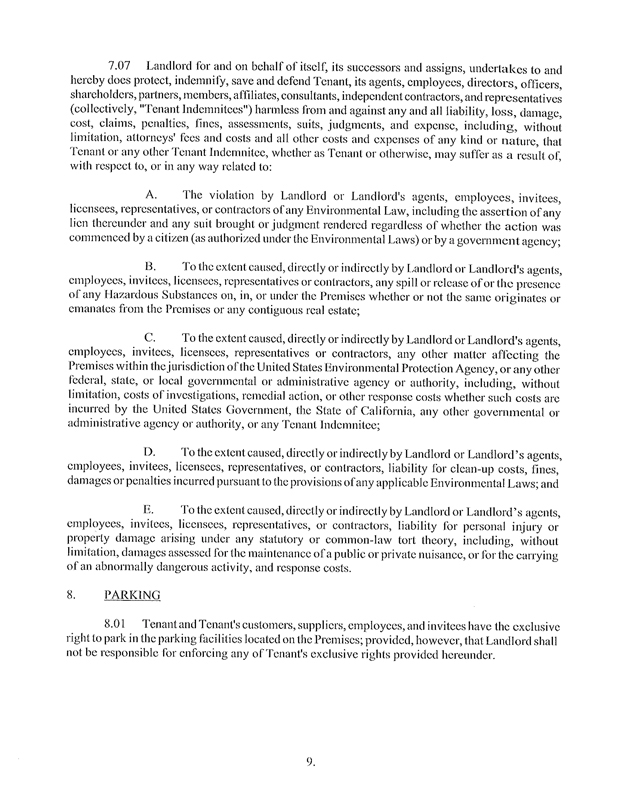
7.07 Landlord for and on behalf of itself, its successors and assigns, undertakes to and hereby does protect, indemnify, save and defend Tenant, its agents, employees, directors, officers, shareholders, partners, members, affiliates, consultants, independent contractors, and representatives (collectively, “Tenant Indemnitees”) harmless from and against any and all liability, loss, damage, cost, claims, penalties, fines, assessments, suits, judgments, and expense, including, without limitation, attorneys’ fees and costs and all other costs and expenses of any kind or nature, that Tenant or any other Tenant Indemnitee, whether as Tenant or otherwise, may suffer as a result of, with respect to, or in any way related to:
A. The violation by Landlord or Landlord’s agents, employees, invitees, licensees, representatives, or contractors of any Environmental Law, including the assertion of any lien thereunder and any suit brought or judgment rendered regardless of whether the action was commenced by a citizen (as authorized under the Environmental Laws) or by a government agency;
B. To the extent caused, directly or indirectly by Landlord or Landlord’s agents, employees, invitees, licensees, representatives or contractors, any spill or release of or the presence of any Hazardous Substances on, in, or under the Premises whether or not the same originates or emanates from the Premises or any contiguous real estate;
C. To the extent caused, directly or indirectly by Landlord or Landlord’s agents, employees, invitees, licensees, representatives or contractors, any other matter affecting the Premises within the jurisdiction of the United States Environmental Protection Agency, or any other federal, state, or local governmental or administrative agency or authority, including, without limitation, costs of investigations, remedial action, or other response costs whether such costs are incurred by the United States Government, the State of California, any other governmental or administrative agency or authority, or any Tenant Indemnitee;
D. To the extent caused, directly or indirectly by Landlord or Landlord’s agents, employees, invitees, licensees, representatives, or contractors, liability for clean-up costs, fines, damages or penalties incurred pursuant to the provisions of any applicable Environmental Laws; and
E. To the extent caused, directly or indirectly by Landlord or Landlord’s agents, employees, invitees, licensees, representatives, or contractors, liability for personal injury or property damage arising under any statutory or common-law tort theory, including, without limitation, damages assessed for the maintenance of a public or private nuisance, or for the carrying of an abnormally dangerous activity, and response costs.
8. PARKING
8.01 Tenant and Tenant’s customers, suppliers, employees, and invitees have the exclusive right to park in the parking facilities located on the Premises; provided, however, that Landlord shall not be responsible for enforcing any of Tenant’s exclusive rights provided hereunder.
9.
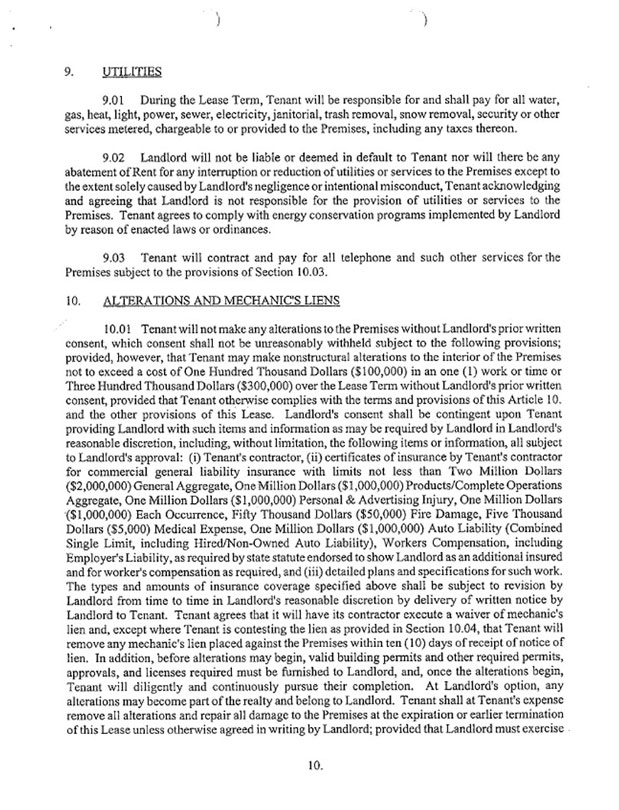
9. UTILITIES
9.01 During the Lease Term, Tenant will be responsible for and shall pay for all water, gas, heat, light, power, sewer, electricity, janitorial, trash removal, snow removal, security or other services metered, chargeable to or provided to the Premises, including any taxes thereon.
9.02 Landlord will not be liable or deemed in default to Tenant nor will there be any abatement of Rent for any interruption or reduction of utilities or services to the Premises except to the extent solely caused by Landlord’s negligence or intentional misconduct, Tenant acknowledging and agreeing that Landlord is not responsible for the provision of utilities or services to the Premises. Tenant agrees to comply with energy conservation programs implemented by Landlord by reason of enacted laws or ordinances.
9.03 Tenant will contract and pay for all telephone and such other services for the Premises subject to the provisions of Section 10.03.
10. ALTERATIONS AND MECHANIC’S LIENS
10.01 Tenant will not make any alterations to the Premises without Landlord’s prior written consent, which consent shall not be unreasonably withheld subject to the following provisions; provided, however, that Tenant may make nonstructural alterations to the interior of the Premises not to exceed a cost of One Hundred Thousand Dollars ($100,000) in an one (1) work or time or Three Hundred Thousand Dollars ($300,000) over the Lease Term without Landlord’s prior written consent, provided that Tenant otherwise complies with the terms and provisions of this Article 10, and the other provisions of this Lease. Landlord’s consent shall be contingent upon Tenant providing Landlord with such items and information as may be required by Landlord in Landlord’s reasonable discretion, including, without limitation, the following items or information, all subject to Landlord’s approval: (i) Tenant’s contractor, (ii) certificates of insurance by Tenant’s contractor for commercial general liability insurance with limits not less than Two Million Dollars ($2,000,000) General Aggregate, One Million Dollars ($1,000,000) Products/Complete Operations Aggregate, One Million Dollars ($1,000,000) Personal & Advertising Injury, One Million Dollars ($1,000,000) Each Occurrence, Fifty Thousand Dollars ($50,000) Fire Damage, Five Thousand Dollars ($5,000) Medical Expense, One Million Dollars ($1,000,000) Auto Liability (Combined Single Limit, including Hired/Non-Owned Auto Liability), Workers Compensation, including Employer’s Liability, as required by state statute endorsed to show Landlord as an additional insured and for worker’s compensation as required, and (iii) detailed plans and specifications for such work. The types and amounts of insurance coverage specified above shall be subject to revision by Landlord from time to time in Landlord’s reasonable discretion by delivery of written notice by Landlord to Tenant. Tenant agrees that it will have its contractor execute a waiver of mechanic’s lien and, except where Tenant is contesting the lien as provided in Section 10.04, that Tenant will remove any mechanic’s lien placed against the Premises within ten (10) days of receipt of notice of lien. In addition, before alterations may begin, valid building permits and other required permits, approvals, and licenses required must be furnished to Landlord, and, once the alterations begin, Tenant will diligently and continuously pursue their completion. At Landlord’s option, any alterations may become part of the realty and belong to Landlord. Tenant shall at Tenant’s expense remove all alterations and repair all damage to the Premises at the expiration or earlier termination of this Lease unless otherwise agreed in writing by Landlord; provided that Landlord must exercise
10.
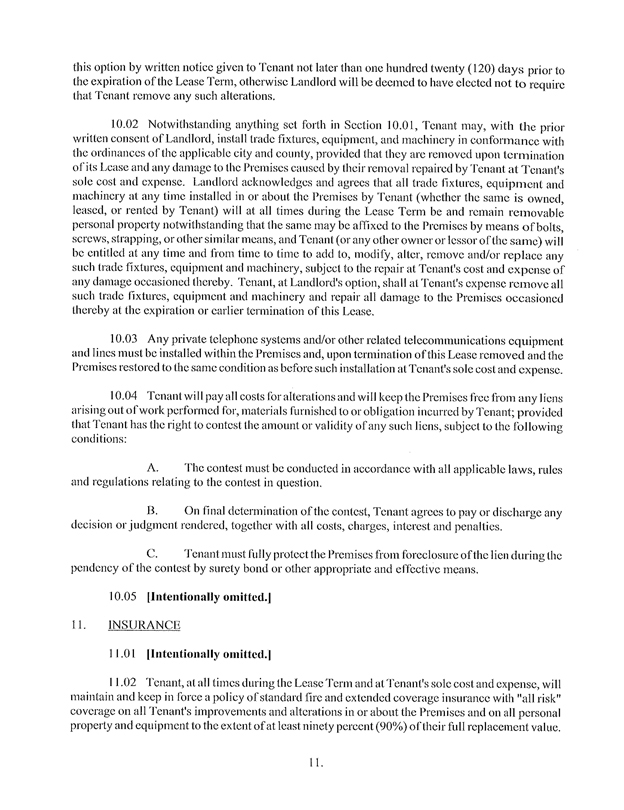
this option by written notice given to Tenant not later than one hundred twenty (120) days prior to the expiration of the Lease Term, otherwise Landlord will be deemed to have elected not to require that Tenant remove any such alterations.
10.02 Notwithstanding anything set forth in Section 10.01, Tenant may, with the prior written consent of Landlord, install trade fixtures, equipment, and machinery in conformance with the ordinances of the applicable city and county, provided that they are removed upon termination of its Lease and any damage to the Premises caused by their removal repaired by Tenant at Tenant’s sole cost and expense. Landlord acknowledges and agrees that all trade fixtures, equipment and machinery at any time installed in or about the Premises by Tenant (whether the same is owned, leased, or rented by Tenant) will at all times during the Lease Term be and remain removable personal property notwithstanding that the same may be affixed to the Premises by means of bolts, screws, strapping, or other similar means, and Tenant (or any other owner or lessor of the same) will be entitled at any time and from time to time to add to, modify, alter, remove and/or replace any such trade fixtures, equipment and machinery, subject to the repair at Tenant’s cost and expense of any damage occasioned thereby. Tenant, at Landlord’s option, shall at Tenant’s expense remove all such trade fixtures, equipment and machinery and repair all damage to the Premises occasioned thereby at the expiration or earlier termination of this Lease.
10.03 Any private telephone systems and/or other related telecommunications equipment and lines must be installed within the Premises and, upon termination of this Lease removed and the Premises restored to the same condition as before such installation at Tenant’s sole cost and expense.
10.04 Tenant will pay all costs for alterations and will keep the Premises free from any liens arising out of work performed for, materials furnished to or obligation incurred by Tenant; provided that Tenant has the right to contest the amount or validity of any such liens, subject to the following conditions:
A. The contest must be conducted in accordance with all applicable laws, rules and regulations relating to the contest in question.
B. On final determination of the contest, Tenant agrees to pay or discharge any decision or judgment rendered, together with all costs, charges, interest and penalties.
C. Tenant must fully protect the Premises from foreclosure of the lien during the pendency of the contest by surety bond or other appropriate and effective means.
10.05 [Intentionally omitted.]
11. INSURANCE
11.01 [Intentionally omitted.]
11.02 Tenant, at all times during the Lease Term and at Tenant’s sole cost and expense, will maintain and keep in force a policy of standard fire and extended coverage insurance with “all risk” coverage on all Tenant’s improvements and alterations in or about the Premises and on all personal property and equipment to the extent of at least ninety percent (90%) of their full replacement value.
11.
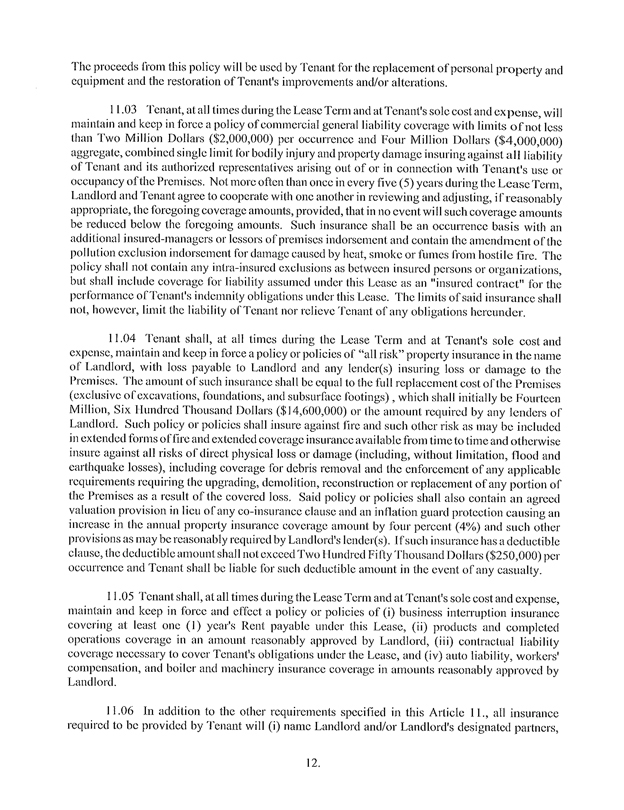
The proceeds from this policy will be used by Tenant for the replacement of personal property and equipment and the restoration of Tenant’s improvements and/or alterations.
11.03 Tenant, at all times during the Lease Term and at Tenant’s sole cost and expense, will maintain and keep in force a policy of commercial general liability coverage with limits of not less than Two Million Dollars ($2,000,000) per occurrence and Four Million Dollars ($4,000,000) aggregate, combined single limit for bodily injury and property damage insuring against all liability of Tenant and its authorized representatives arising out of or in connection with Tenant’s use or occupancy of the Premises. Not more often than once in every five (5) years during the Lease Term, Landlord and Tenant agree to cooperate with one another in reviewing and adjusting, if reasonably appropriate, the foregoing coverage amounts, provided, that in no event will such coverage amounts be reduced below the foregoing amounts. Such insurance shall be an occurrence basis with an additional insured-managers or lessors of premises indorsement and contain the amendment of the pollution exclusion indorsement for damage caused by heat, smoke or fumes from hostile fire. The policy shall not contain any intra-insured exclusions as between insured persons or organizations, but shall include coverage for liability assumed under this Lease as an “insured contract” for the performance of Tenant’s indemnity obligations under this Lease. The limits of said insurance shall not, however, limit the liability of Tenant nor relieve Tenant of any obligations hereunder.
11.04 Tenant shall, at all times during the Lease Term and at Tenant’s sole cost and expense, maintain and keep in force a policy or policies of “all risk” property insurance in the name of Landlord, with loss payable to Landlord and any lender(s) insuring loss or damage to the Premises. The amount of such insurance shall be equal to the full replacement cost of the Premises (exclusive of excavations, foundations, and subsurface footings) , which shall initially be Fourteen Million, Six Hundred Thousand Dollars ($14,600,000) or the amount required by any lenders of Landlord. Such policy or policies shall insure against fire and such other risk as may be included in extended forms of fire and extended coverage insurance available from time to time and otherwise insure against all risks of direct physical loss or damage (including, without limitation, flood and earthquake losses), including coverage for debris removal and the enforcement of any applicable requirements requiring the upgrading, demolition, reconstruction or replacement of any portion of the Premises as a result of the covered loss. Said policy or policies shall also contain an agreed valuation provision in lieu of any co-insurance clause and an inflation guard protection causing an increase in the annual property insurance coverage amount by four percent (4%) and such other provisions as may be reasonably required by Landlord’s lender(s). If such insurance has a deductible clause, the deductible amount shall not exceed Two Hundred Fifty Thousand Dollars ($250,000) per occurrence and Tenant shall be liable for such deductible amount in the event of any casualty.
11.05 Tenant shall, at all times during the Lease Term and at Tenant’s sole cost and expense, maintain and keep in force and effect a policy or policies of (i) business interruption insurance covering at least one (1) year’s Rent payable under this Lease, (ii) products and completed operations coverage in an amount reasonably approved by Landlord, (iii) contractual liability coverage necessary to cover Tenant’s obligations under the Lease, and (iv) auto liability, workers’ compensation, and boiler and machinery insurance coverage in amounts reasonably approved by Landlord.
11.06 In addition to the other requirements specified in this Article 11., all insurance required to be provided by Tenant will (i) name Landlord and/or Landlord’s designated partners,
12.
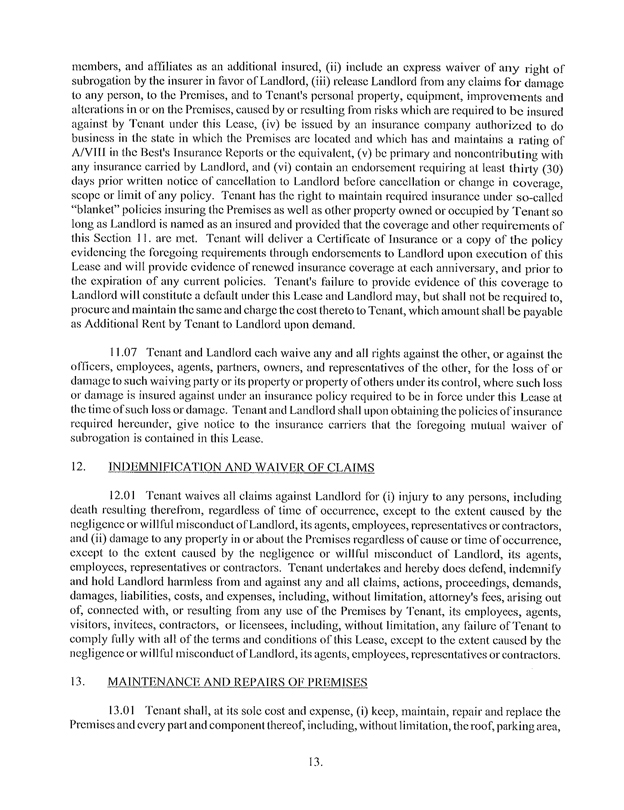
members, and affiliates as an additional insured, (ii) include an express waiver of any right of subrogation by the insurer in favor of Landlord, (iii) release Landlord from any claims for damage to any person, to the Premises, and to Tenant’s personal property, equipment, improvements and alterations in or on the Premises, caused by or resulting from risks which are required to be insured against by Tenant under this Lease, (iv) be issued by an insurance company authorized to do business in the state in which the Premises are located and which has and maintains a rating of A/VIII in the Best’s Insurance Reports or the equivalent, (v) be primary and noncontributing with any insurance carried by Landlord, and (vi) contain an endorsement requiring at least thirty (30) days prior written notice of cancellation to Landlord before cancellation or change in coverage, scope or limit of any policy. Tenant has the right to maintain required insurance under so-called “blanket” policies insuring the Premises as well as other property owned or occupied by Tenant so long as Landlord is named as an insured and provided that the coverage and other requirements of this Section 11. are met. Tenant will deliver a Certificate of Insurance or a copy of the policy evidencing the foregoing requirements through endorsements to Landlord upon execution of this Lease and will provide evidence of renewed insurance coverage at each anniversary, and prior to the expiration of any current policies. Tenant’s failure to provide evidence of this coverage to Landlord will constitute a default under this Lease and Landlord may, but shall not be required to, procure and maintain the same and charge the cost thereto to Tenant, which amount shall be payable as Additional Rent by Tenant to Landlord upon demand.
11.07 Tenant and Landlord each waive any and all rights against the other, or against the officers, employees, agents, partners, owners, and representatives of the other, for the loss of or damage to such waiving party or its property or property of others under its control, where such loss or damage is insured against under an insurance policy required to be in force under this Lease at the time of such loss or damage. Tenant and Landlord shall upon obtaining the policies of insurance required hereunder, give notice to the insurance carriers that the foregoing mutual waiver of subrogation is contained in this Lease.
12. INDEMNIFICATION AND WAIVER OF CLAIMS
12.01 Tenant waives all claims against Landlord for (i) injury to any persons, including death resulting therefrom, regardless of time of occurrence, except to the extent caused by the negligence or willful misconduct of Landlord, its agents, employees, representatives or contractors, and (ii) damage to any property in or about the Premises regardless of cause or time of occurrence, except to the extent caused by the negligence or willful misconduct of Landlord, its agents, employees, representatives or contractors. Tenant undertakes and hereby does defend, indemnify and hold Landlord harmless from and against any and all claims, actions, proceedings, demands, damages, liabilities, costs, and expenses, including, without limitation, attorney’s fees, arising out of, connected with, or resulting from any use of the Premises by Tenant, its employees, agents, visitors, invitees, contractors, or licensees, including, without limitation, any failure of Tenant to comply fully with all of the terms and conditions of this Lease, except to the extent caused by the negligence or willful misconduct of Landlord, its agents, employees, representatives or contractors.
13. MAINTENANCE AND REPAIRS OF PREMISES
13.01 Tenant shall, at its sole cost and expense, (i) keep, maintain, repair and replace the Premises and every part and component thereof, including, without limitation, the roof, parking area,
13.
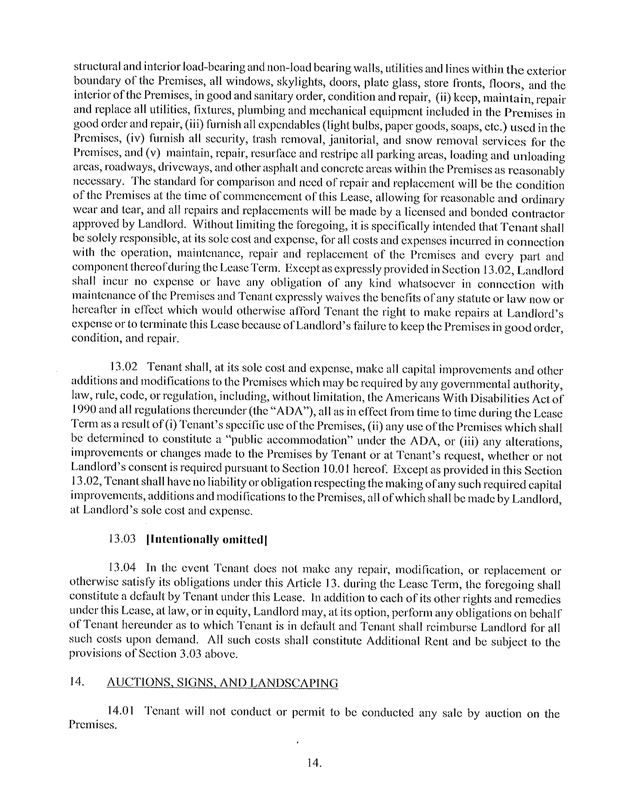
structural and interior load-bearing and non-load bearing walls, utilities and lines within the exterior boundary of the Premises, all windows, skylights, doors, plate glass, store fronts, floors, and the interior of the Premises, in good and sanitary order, condition and repair, (ii) keep, maintain, repair and replace all utilities, fixtures, plumbing and mechanical equipment included in the Premises in good order and repair, (iii) furnish all expendables (light bulbs, paper goods, soaps, etc.) used in the Premises, (iv) furnish all security, trash removal, janitorial, and snow removal services for the Premises, and (v) maintain, repair, resurface and restripe all parking areas, loading and unloading areas, roadways, driveways, and other asphalt and concrete areas within the Premises as reasonably necessary. The standard for comparison and need of repair and replacement will be the condition of the Premises at the time of commencement of this Lease, allowing for reasonable and ordinary wear and tear, and all repairs and replacements will be made by a licensed and bonded contractor approved by Landlord. Without limiting the foregoing, it is specifically intended that Tenant shall be solely responsible, at its sole cost and expense, for all costs and expenses incurred in connection with the operation, maintenance, repair and replacement of the Premises and every part and component thereof during the Lease Term. Except as expressly provided in Section 13.02, Landlord shall incur no expense or have any obligation of any kind whatsoever in connection with maintenance of the Premises and Tenant expressly waives the benefits of any statute or law now or hereafter in effect which would otherwise afford Tenant the right to make repairs at Landlord’s expense or to terminate this Lease because of Landlord’s failure to keep the Premises in good order, condition, and repair.
13.02 Tenant shall, at its sole cost and expense, make all capital improvements and other additions and modifications to the Premises which may be required by any governmental authority, law, rule, code, or regulation, including, without limitation, the Americans With Disabilities Act of 1990 and all regulations thereunder (the “ADA”), all as in effect from time to time during the Lease Term as a result of (i) Tenant’s specific use of the Premises, (ii) any use of the Premises which shall be determined to constitute a “public accommodation” under the ADA, or (iii) any alterations, improvements or changes made to the Premises by Tenant or at Tenant’s request, whether or not Landlord’s consent is required pursuant to Section 10.01 hereof. Except as provided in this Section 13.02, Tenant shall have no liability or obligation respecting the making of any such required capital improvements, additions and modifications to the Premises, all of which shall be made by Landlord, at Landlord’s sole cost and expense.
13.03 [Intentionally omitted]
13.04 In the event Tenant does not make any repair, modification, or replacement or otherwise satisfy its obligations under this Article 13. during the Lease Term, the foregoing shall constitute a default by Tenant under this Lease. In addition to each of its other rights and remedies under this Lease, at law, or in equity, Landlord may, at its option, perform any obligations on behalf of Tenant hereunder as to which Tenant is in default and Tenant shall reimburse Landlord for all such costs upon demand. All such costs shall constitute Additional Rent and be subject to the provisions of Section 3.03 above.
14. AUCTIONS, SIGNS, AND LANDSCAPING
14.01 Tenant will not conduct or permit to be conducted any sale by auction on the Premises.
14.
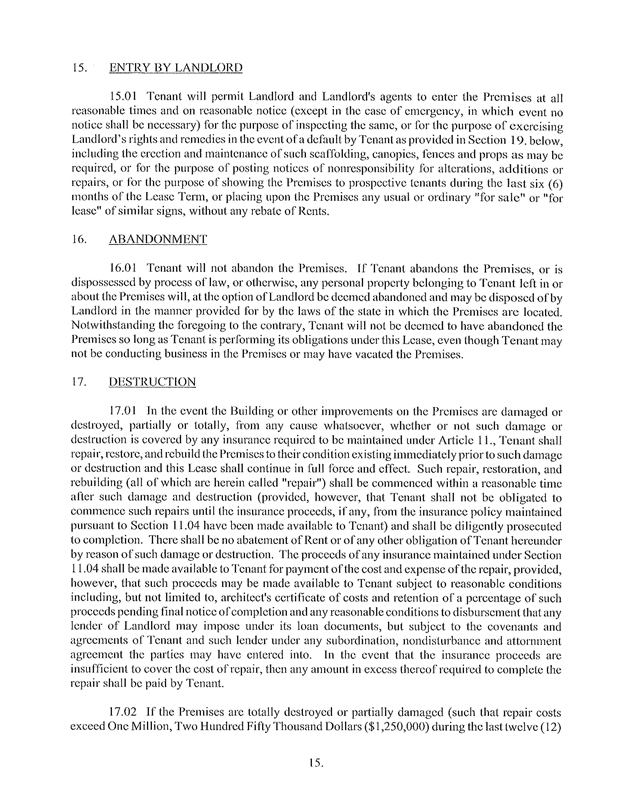
15. ENTRY BY LANDLORD
15.01 Tenant will permit Landlord and Landlord’s agents to enter the Premises at all reasonable times and on reasonable notice (except in the case of emergency, in which event no notice shall be necessary) for the purpose of inspecting the same, or for the purpose of exercising Landlord’s rights and remedies in the event of a default by Tenant as provided in Section 19. below, including the erection and maintenance of such scaffolding, canopies, fences and props as may be required, or for the purpose of posting notices of nonresponsibility for alterations, additions or repairs, or for the purpose of showing the Premises to prospective tenants during the last six (6) months of the Lease Term, or placing upon the Premises any usual or ordinary “for sale” or “for lease” of similar signs, without any rebate of Rents.
16. ABANDONMENT
16.01 Tenant will not abandon the Premises. If Tenant abandons the Premises, or is dispossessed by process of law, or otherwise, any personal property belonging to Tenant left in or about the Premises will, at the option of Landlord be deemed abandoned and may be disposed of by Landlord in the manner provided for by the laws of the state in which the Premises are located. Notwithstanding the foregoing to the contrary, Tenant will not be deemed to have abandoned the Premises so long as Tenant is performing its obligations under this Lease, even though Tenant may not be conducting business in the Premises or may have vacated the Premises.
17. DESTRUCTION
17.01 In the event the Building or other improvements on the Premises are damaged or destroyed, partially or totally, from any cause whatsoever, whether or not such damage or destruction is covered by any insurance required to be maintained under Article 11., Tenant shall repair, restore, and rebuild the Premises to their condition existing immediately prior to such damage or destruction and this Lease shall continue in full force and effect. Such repair, restoration, and rebuilding (all of which are herein called “repair”) shall be commenced within a reasonable time after such damage and destruction (provided, however, that Tenant shall not be obligated to commence such repairs until the insurance proceeds, if any, from the insurance policy maintained pursuant to Section 11.04 have been made available to Tenant) and shall be diligently prosecuted to completion. There shall be no abatement of Rent or of any other obligation of Tenant hereunder by reason of such damage or destruction. The proceeds of any insurance maintained under Section
11.04 shall be made available to Tenant for payment of the cost and expense of the repair, provided, however, that such proceeds may be made available to Tenant subject to reasonable conditions including, but not limited to, architect’s certificate of costs and retention of a percentage of such proceeds pending final notice of completion and any reasonable conditions to disbursement that any lender of Landlord may impose under its loan documents, but subject to the covenants and agreements of Tenant and such lender under any subordination, nondisturbance and attornment agreement the parties may have entered into. In the event that the insurance proceeds are insufficient to cover the cost of repair, then any amount in excess thereof required to complete the repair shall be paid by Tenant.
17.02 If the Premises are totally destroyed or partially damaged (such that repair costs exceed One Million, Two Hundred Fifty Thousand Dollars ($1,250,000) during the last twelve (12)
15.
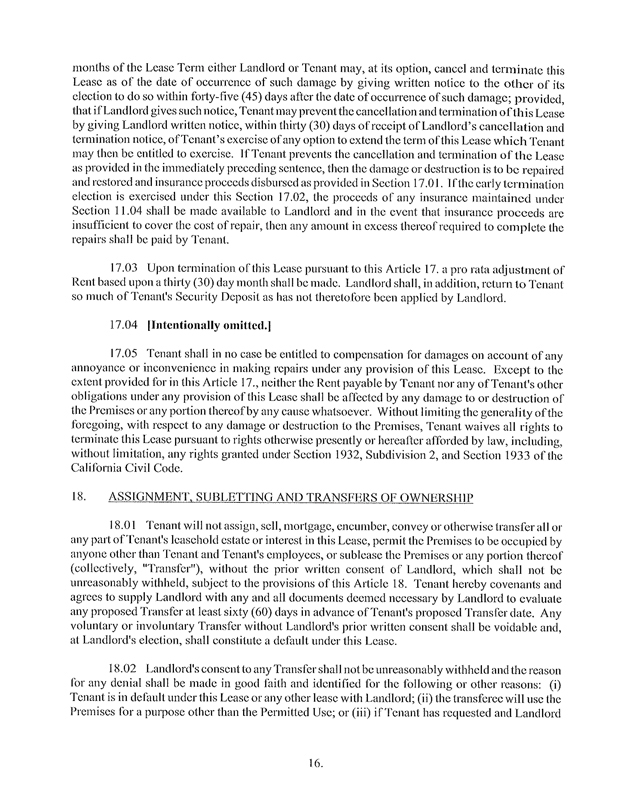
months of the Lease Term either Landlord or Tenant may, at its option, cancel and terminate this Lease as of the date of occurrence of such damage by giving written notice to the other of its election to do so within forty-five (45) days after the date of occurrence of such damage; provided, that if Landlord gives such notice, Tenant may prevent the cancellation and termination of this Lease by giving Landlord written notice, within thirty (30) days of receipt of Landlord’s cancellation and termination notice, of Tenant’s exercise of any option to extend the term of this Lease which Tenant may then be entitled to exercise. If Tenant prevents the cancellation and termination of the Lease as provided in the immediately preceding sentence, then the damage or destruction is to be repaired and restored and insurance proceeds disbursed as provided in Section 17.01. If the early termination election is exercised under this Section 17.02, the proceeds of any insurance maintained under Section 11.04 shall be made available to Landlord and in the event that insurance proceeds are insufficient to cover the cost of repair, then any amount in excess thereof required to complete the repairs shall be paid by Tenant.
17.03 Upon termination of this Lease pursuant to this Article 17. a pro rata adjustment of Rent based upon a thirty (30) day month shall be made. Landlord shall, in addition, return to Tenant so much of Tenant’s Security Deposit as has not thereto fore been applied by Landlord.
17.04 [Intentionally omitted.]
17.05 Tenant shall in no case be entitled to compensation for damages on account of any annoyance or inconvenience in making repairs under any provision of this Lease. Except to the extent provided for in this Article 17., neither the Rent payable by Tenant nor any of Tenant’s other obligations under any provision of this Lease shall be affected by any damage to or destruction of the Premises or any portion thereof by any cause whatsoever. Without limiting the generality of the foregoing, with respect to any damage or destruction to the Premises, Tenant waives all rights to terminate this Lease pursuant to rights otherwise presently or hereafter afforded by law, including, without limitation, any rights granted under Section 1932, Subdivision 2, and Section 1933 of the California Civil Code.
18. ASSIGNMENT, SUBLETTING AND TRANSFERS OF OWNERSHIP
18.01 Tenant will not assign, sell, mortgage, encumber, convey or otherwise transfer all or any part of Tenant’s leasehold estate or interest in this Lease, permit the Premises to be occupied by anyone other than Tenant and Tenant’s employees, or sublease the Premises or any portion thereof (collectively, “Transfer”), without the prior written consent of Landlord, which shall not be unreasonably withheld, subject to the provisions of this Article 18. Tenant hereby covenants and agrees to supply Landlord with any and all documents deemed necessary by Landlord to evaluate any proposed Transfer at least sixty (60) days in advance of Tenant’s proposed Transfer date. Any voluntary or involuntary Transfer without Landlord’s prior written consent shall be voidable and, at Landlord’s election, shall constitute a default under this Lease.
18.02 Landlord’s consent to any Transfer shall not be unreasonably withheld and the reason for any denial shall be made in good faith and identified for the following or other reasons: (i) Tenant is in default under this Lease or any other lease with Landlord; (ii) the transferee will use the Premises for a purpose other than the Permitted Use; or (iii) if Tenant has requested and Landlord
16 ..
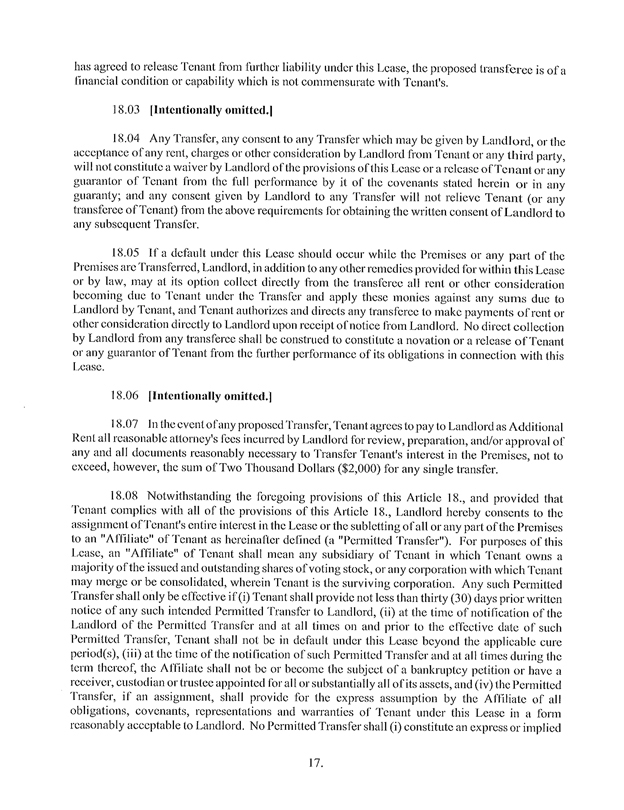
has agreed to release Tenant from further liability under this Lease, the proposed transferee is of a financial condition or capability which is not commensurate with Tenant’s.
18.03 [Intentionally omitted.]
18.04 Any Transfer, any consent to any Transfer which may be given by Landlord, or the acceptance of any rent, charges or other consideration by Landlord from Tenant or any third party, will not constitute a waiver by Landlord of the provisions of this Lease or a release of Tenant or any guarantor of Tenant from the full performance by it of the covenants stated herein or in any guaranty; and any consent given by Landlord to any Transfer will not relieve Tenant (or any transferee of Tenant) from the above requirements for obtaining the written consent of Landlord to any subsequent Transfer.
18.05 If a default under this Lease should occur while the Premises or any part of the Premises are Transferred, Landlord, in addition to any other remedies provided for within this Lease or by law, may at its option collect directly from the transferee all rent or other consideration becoming due to Tenant under the Transfer and apply these monies against any sums due to Landlord by Tenant, and Tenant authorizes and directs any transferee to make payments of rent or other consideration directly to Landlord upon receipt of notice from Landlord. No direct collection by Landlord from any transferee shall be construed to constitute a novation or a release of Tenant or any guarantor of Tenant from the further performance of its obligations in connection with this Lease.
18.06 [Intentionally omitted.]
18.07 In the event of any proposed Transfer, Tenant agrees to pay to Landlord as Additional Rent all reasonable attorney’s fees incurred by Landlord for review, preparation, and/or approval of any and all documents reasonably necessary to Transfer Tenant’s interest in the Premises, not to exceed, however, the sum of Two Thousand Dollars ($2,000) for any single transfer.
18.08 Notwithstanding the foregoing provisions of this Article 18., and provided that Tenant complies with all of the provisions of this Article 18., Landlord hereby consents to the assignment of Tenant’s entire interest in the Lease or the subletting of all or any part of the Premises to an “Affiliate” of Tenant as hereinafter defined (a “Permitted Transfer”). For purposes of this Lease, an “Affiliate” of Tenant shall mean any subsidiary of Tenant in which Tenant owns a majority of the issued and outstanding shares of voting stock, or any corporation with which Tenant may merge or be consolidated, wherein Tenant is the surviving corporation. Any such Permitted Transfer shall only be effective if (i) Tenant shall provide not less than thirty (30) days prior written notice of any such intended Permitted Transfer to Landlord, (ii) at the time of notification of the Landlord of the Permitted Transfer and at all times on and prior to the effective date of such Permitted Transfer, Tenant shall not be in default under this Lease beyond the applicable cure period(s), (iii) at the time of the notification of such Permitted Transfer and at all times during the term thereof, the Affiliate shall not be or become the subject of a bankruptcy petition or have a receiver, custodian or trustee appointed for all or substantially all of its assets, and (iv) the Permitted Transfer, if an assignment, shall provide for the express assumption by the Affiliate of all obligations, covenants, representations and warranties of Tenant under this Lease in a form reasonably acceptable to Landlord. No Permitted Transfer shall (i) constitute an express or implied
17 ..
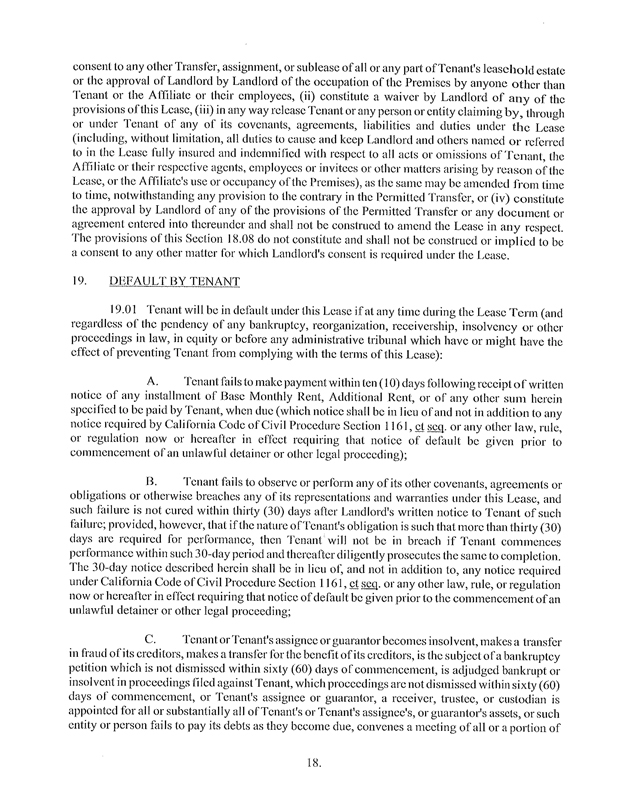
consent to any other Transfer, assignment, or sublease of all or any part of Tenant’s leasehold estate or the approval of Landlord by Landlord of the occupation of the Premises by anyone other than Tenant or the Affiliate or their employees, (ii) constitute a waiver by Landlord of any of the provisions of this Lease, (iii) in any way release Tenant or any person or entity claiming by, through or under Tenant of any of its covenants, agreements, liabilities and duties under the Lease (including, without limitation, all duties to cause and keep Landlord and others named or referred to in the Lease fully insured and indemnified with respect to all acts or omissions of Tenant, the Affiliate or their respective agents, employees or invitees or other matters arising by reason of the Lease, or the Affiliate’s use or occupancy of the Premises), as the same may be amended from time to time, notwithstanding any provision to the contrary in the Permitted Transfer, or (iv) constitute the approval by Landlord of any of the provisions of the Permitted Transfer or any document or agreement entered into thereunder and shall not be construed to amend the Lease in any respect. The provisions of this Section 18.08 do not constitute and shall not be construed or implied to be a consent to any other matter for which Landlord’s consent is required under the Lease.
19. DEFAULT BY TENANT
19.01 Tenant will be in default under this Lease if at any time during the Lease Term (and regardless of the pendency of any bankruptcy, reorganization, receivership, insolvency or other proceedings in law, in equity or before any administrative tribunal which have or might have the effect of preventing Tenant from complying with the terms of this Lease):
A. Tenant fails to make payment within ten (10) days following receipt of written notice of any installment of Base Monthly Rent, Additional Rent, or of any other sum herein specified to be paid by Tenant, when due (which notice shall be in lieu of and not in addition to any notice required by California Code of Civil Procedure Section 1161, et seq. or any other law, rule, or regulation now or hereafter in effect requiring that notice of default be given prior to commencement of an unlawful detainer or other legal proceeding);
B. Tenant fails to observe or perform any of its other covenants, agreements or obligations or otherwise breaches any of its representations and warranties under this Lease, and such failure is not cured within thirty (30) days after Landlord’s written notice to Tenant of such failure; provided, however, that if the nature of Tenant’s obligation is such that more than thirty (30) days are required for performance, then Tenant will not be in breach if Tenant commences performance within such 30-day period and thereafter diligently prosecutes the same to completion. The 30-day notice described herein shall be in lieu of, and not in addition to, any notice required under California Code of Civil Procedure Section 1161, et seq. or any other law, rule, or regulation now or hereafter in effect requiring that notice of default be given prior to the commencement of an unlawful detainer or other legal proceeding;
C. Tenant or Tenant’s assignee or guarantor becomes insolvent, makes a transfer in fraud of its creditors, makes a transfer for the benefit of its creditors, is the subject of a bankruptcy petition which is not dismissed within sixty (60) days of commencement, is adjudged bankrupt or insolvent in proceedings filed against Tenant, which proceedings are not dismissed within sixty (60) days of commencement, or Tenant’s assignee or guarantor, a receiver, trustee, or custodian is appointed for all or substantially all of Tenant’s or Tenant’s assignee’s, or guarantor’s assets, or such entity or person fails to pay its debts as they become due, convenes a meeting of all or a portion of
18 ..
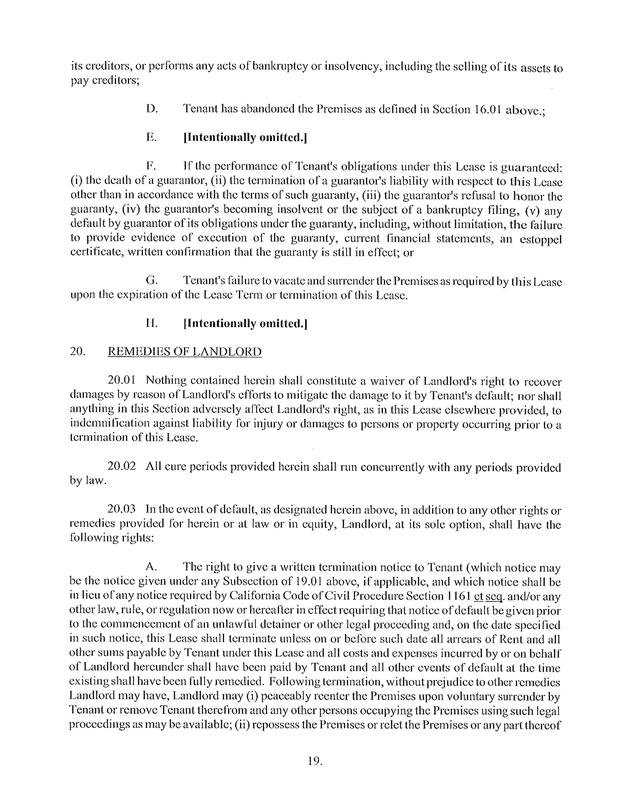
its creditors, or performs any acts of bankruptcy or insolvency, including the selling of its assets to pay creditors;
D. Tenant has abandoned the Premises as defined in Section 16.01 above.;
E. [Intentionally omitted.]
F. If the performance of Tenant’s obligations under this Lease is guaranteed: (i) the death of a guarantor, (ii) the termination of a guarantor’s liability with respect to this Lease other than in accordance with the terms of such guaranty, (iii) the guarantor’s refusal to honor the guaranty, (iv) the guarantor’s becoming insolvent or the subject of a bankruptcy filing, (v) any default by guarantor of its obligations under the guaranty, including, without limitation, the failure to provide evidence of execution of the guaranty, current financial statements, an estoppel certificate, written confirmation that the guaranty is still in effect; or
G. Tenant’s failure to vacate and surrender the Premises as required by this Lease upon the expiration of the Lease Term or termination of this Lease.
H. [Intentionally omitted.]
20. REMEDIES OF LANDLORD
20.01 Nothing contained herein shall constitute a waiver of Landlord’s right to recover damages by reason of Landlord’s efforts to mitigate the damage to it by Tenant’s default; nor shall anything in this Section adversely affect Landlord’s right, as in this Lease elsewhere provided, to indemnification against liability for injury or damages to persons or property occurring prior to a termination of this Lease.
20.02 All cure periods provided herein shall run concurrently with any periods provided
by law.
20.03 In the event of default, as designated herein above, in addition to any other rights or remedies provided for herein or at law or in equity, Landlord, at its sole option, shall have the following rights:
A. The right to give a written termination notice to Tenant (which notice may be the notice given under any Subsection of 19.01 above, if applicable, and which notice shall be in lieu of any notice required by California Code of Civil Procedure Section 1161 et seq. and/or any other law, rule, or regulation now or hereafter in effect requiring that notice of default be given prior to the commencement of an unlawful detainer or other legal proceeding and, on the date specified in such notice, this Lease shall terminate unless on or before such date all arrears of Rent and all other sums payable by Tenant under this Lease and all costs and expenses incurred by or on behalf of Landlord hereunder shall have been paid by Tenant and all other events of default at the time existing shall have been fully remedied. Following termination, without prejudice to other remedies Landlord may have, Landlord may (i) peaceably reenter the Premises upon voluntary surrender by Tenant or remove Tenant therefrom and any other persons occupying the Premises using such legal proceedings as may be available; (ii) repossess the Premises or relet the Premises or any part thereof
19 ..
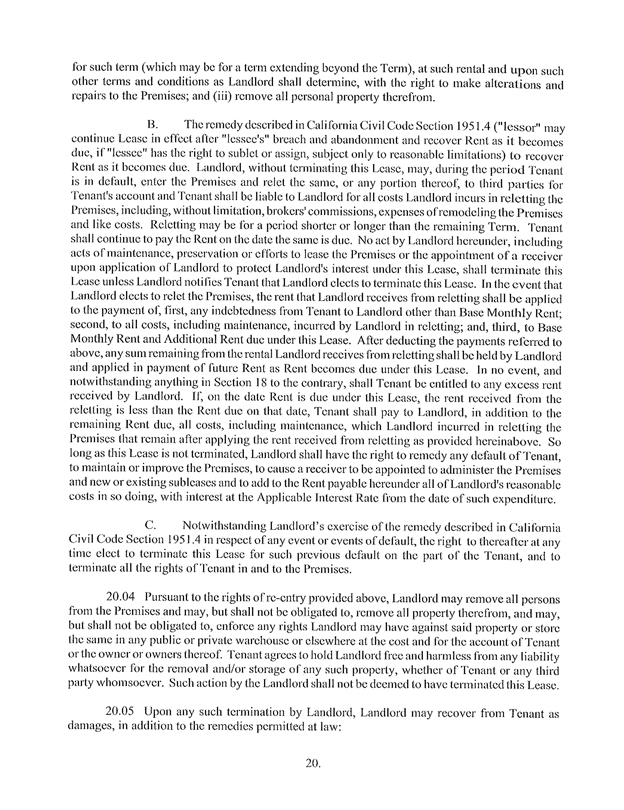
for such term (which may be for a term extending beyond the Term), at such rental and upon such other terms and conditions as Landlord shall determine, with the right to make alterations and repairs to the Premises; and (iii) remove all personal property therefrom.
B. The remedy described in California Civil Code Section 1951.4 (“lessor” may continue Lease in effect after “lessee’s” breach and abandonment and recover Rent as it becomes due, if “lessee” has the right to sublet or assign, subject only to reasonable limitations) to recover Rent as it becomes due. Landlord, without terminating this Lease, may, during the period Tenant is in default, enter the Premises and relet the same, or any portion thereof, to third parties for Tenant’s account and Tenant shall be liable to Landlord for all costs Landlord incurs in reletting the Premises, including, without limitation, brokers’ commissions, expenses of remodeling the Premises and like costs. Reletting may be for a period shorter or longer than the remaining Term. Tenant shall continue to pay the Rent on the date the same is due. No act by Landlord hereunder, including acts of maintenance, preservation or efforts to lease the Premises or the appointment of a receiver upon application of Landlord to protect Landlord’s interest under this Lease, shall terminate this Lease unless Landlord notifies Tenant that Landlord elects to terminate this Lease. In the event that Landlord elects to relet the Premises, the rent that Landlord receives from reletting shall be applied to the payment of, first, any indebtedness from Tenant to Landlord other than Base Monthly Rent; second, to all costs, including maintenance, incurred by Landlord in reletting; and, third, to Base Monthly Rent and Additional Rent due under this Lease. After deducting the payments referred to above, any sum remaining from the rental Landlord receives from reletting shall be held by Landlord and applied in payment of future Rent as Rent becomes due under this Lease. In no event, and notwithstanding anything in Section 18 to the contrary, shall Tenant be entitled to any excess rent received by Landlord. If, on the date Rent is due under this Lease, the rent received from the reletting is less than the Rent due on that date, Tenant shall pay to Landlord, in addition to the remaining Rent due, all costs, including maintenance, which Landlord incurred in reletting the Premises that remain after applying the rent received from reletting as provided hereinabove. So long as this Lease is not terminated, Landlord shall have the right to remedy any default of Tenant, to maintain or improve the Premises, to cause a receiver to be appointed to administer the Premises and new or existing subleases and to add to the Rent payable hereunder all of Landlord’s reasonable costs in so doing, with interest at the Applicable Interest Rate from the date of such expenditure.
C. Notwithstanding Landlord’s exercise of the remedy described in California Civil Code Section 1951.4 in respect of any event or events of default, the right to thereafter at any time elect to terminate this Lease for such previous default on the part of the Tenant, and to terminate all the rights of Tenant in and to the Premises.
20.04 Pursuant to the rights of re-entry provided above, Landlord may remove all persons from the Premises and may, but shall not be obligated to, remove all property therefrom, and may, but shall not be obligated to, enforce any rights Landlord may have against said property or store the same in any public or private warehouse or elsewhere at the cost and for the account of Tenant or the owner or owners thereof. Tenant agrees to hold Landlord free and harmless from any liability whatsoever for the removal and/or storage of any such property, whether of Tenant or any third party whomsoever. Such action by the Landlord shall not be deemed to have terminated this Lease.
20.05 Upon any such termination by Landlord, Landlord may recover from Tenant as damages, in addition to the remedies permitted at law:
20 ..
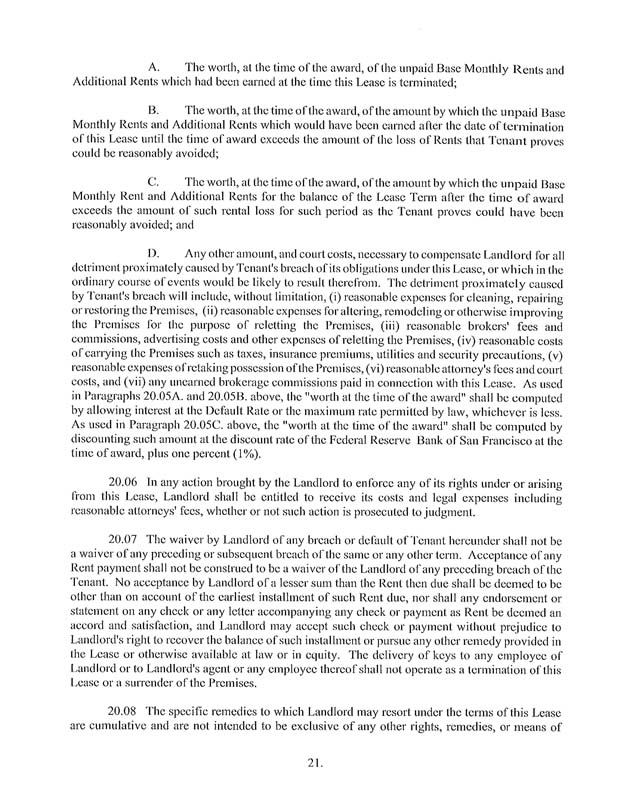
A. The worth, at the time of the award, of the unpaid Base Monthly Rents and Additional Rents which had been earned at the time this Lease is terminated;
B. The worth, at the time of the award, of the amount by which the unpaid Base Monthly Rents and Additional Rents which would have been earned after the date of termination of this Lease until the time of award exceeds the amount of the loss of Rents that Tenant proves could be reasonably avoided;
C. The worth, at the time of the award, of the amount by which the unpaid Base Monthly Rent and Additional Rents for the balance of the Lease Term after the time of award exceeds the amount of such rental loss for such period as the Tenant proves could have been reasonably avoided; and
D. Any other amount, and court costs, necessary to compensate Landlord for all detriment proximately caused by Tenant’s breach of its obligations under this Lease, or which in the ordinary course of events would be likely to result therefrom. The detriment proximately caused by Tenant’s breach will include, without limitation, (i) reasonable expenses for cleaning, repairing or restoring the Premises, (ii) reasonable expenses for altering, remodeling or otherwise improving the Premises for the purpose of reletting the Premises, (iii) reasonable brokers’ fees and commissions, advertising costs and other expenses of reletting the Premises, (iv) reasonable costs of carrying the Premises such as taxes, insurance premiums, utilities and security precautions, (v) reasonable expenses of retaking possession of the Promises, (vi) reasonable attorney’s fees and court costs, and (vii) any unearned brokerage commissions paid in connection with this Lease. As used in Paragraphs 20.05A. and 20.05B. above, the “worth at the time of the award” shall be computed by allowing interest at the Default Rate or the maximum rate permitted by law, whichever is less. As used in Paragraph 20.05C. above, the “worth at the time of the award” shall be computed by discounting such amount at the discount rate of the Federal Reserve Bank of San Francisco at the time of award, plus one percent (1%).
20.06 In any action brought by the Landlord to enforce any of its rights under or arising from this Lease, Landlord shall be entitled to receive its costs and legal expenses including reasonable attorneys’ fees, whether or not such action is prosecuted to judgment.
20.07 The waiver by Landlord of any breach or default of Tenant hereunder shall not be a waiver of any preceding or subsequent breach of the same or any other term. Acceptance of any Rent payment shall not be construed to be a waiver of the Landlord of any preceding breach of the Tenant. No acceptance by Landlord of a lesser sum than the Rent then due shall be deemed to be other than on account of the earliest installment of such Rent due, nor shall any endorsement or statement on any check or any letter accompanying any check or payment as Rent be deemed an accord and satisfaction, and Landlord may accept such check or payment without prejudice to Landlord’s right to recover the balance of such installment or pursue any other remedy provided in the Lease or otherwise available at law or in equity. The delivery of keys to any employee of Landlord or to Landlord’s agent or any employee thereof shall not operate as a termination of this Lease or a surrender of the Premises.
20.08 The specific remedies to which Landlord may resort under the terms of this Lease are cumulative and are not intended to be exclusive of any other rights, remedies, or means of
21 ..
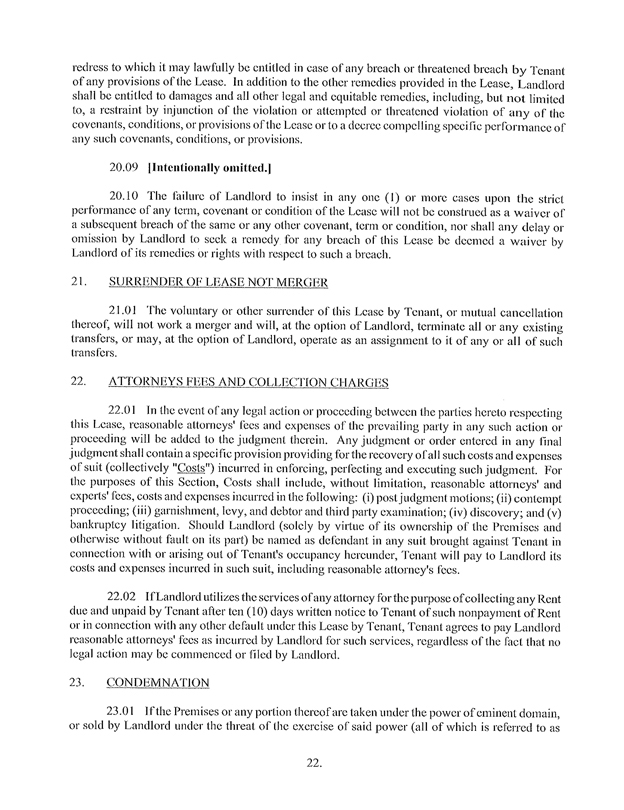
redress to which it may lawfully be entitled in case of any breach or threatened breach by Tenant of any provisions of the Lease. In addition to the other remedies provided in the Lease, Landlord shall be entitled to damages and all other legal and equitable remedies, including, but not limited to, a restraint by injunction of the violation or attempted or threatened violation of any of the covenants, conditions, or provisions of the Lease or to a decree compelling specific performance of any such covenants, conditions, or provisions.
20.09 [Intentionally omitted.]
20.10 The failure of Landlord to insist in any one (1) or more cases upon the strict performance of any term, covenant or condition of the Lease will not be construed as a waiver of a subsequent breach of the same or any other covenant, term or condition, nor shall any delay or omission by Landlord to seek a remedy for any breach of this Lease be deemed a waiver by Landlord of its remedies or rights with respect to such a breach.
21. SURRENDER OF LEASE NOT MERGER
21.01 The voluntary or other surrender of this Lease by Tenant, or mutual cancellation thereof, will not work a merger and will, at the option of Landlord, terminate all or any existing transfers, or may, at the option of Landlord, operate as an assignment to it of any or all of such transfers.
22. ATTORNEYS FEES AND COLLECTION CHARGES
22.01 In the event of any legal action or proceeding between the parties hereto respecting this Lease, reasonable attorneys’ fees and expenses of the prevailing party in any such action or proceeding will be added to the judgment therein. Any judgment or order entered in any final judgment shall contain a specific provision providing for the recovery of all such costs and expenses of suit (collectively “Costs”) incurred in enforcing, perfecting and executing such judgment. For the purposes of this Section, Costs shall include, without limitation, reasonable attorneys’ and experts’ fees, costs and expenses incurred in the following: (i) post judgment motions; (ii) contempt proceeding; (iii) garnishment, levy, and debtor and third party examination; (iv) discovery; and (v) bankruptcy litigation. Should Landlord (solely by virtue of its ownership of the Premises and otherwise without fault on its part) be named as defendant in any suit brought against Tenant in connection with or arising out of Tenant’s occupancy hereunder, Tenant will pay to Landlord its costs and expenses incurred in such suit, including reasonable attorney’s fees.
22.02 If Landlord utilizes the services of any attorney for the purpose of collecting any Rent due and unpaid by Tenant after ten (10) days written notice to Tenant of such nonpayment of Rent or in connection with any other default under this Lease by Tenant, Tenant agrees to pay Landlord reasonable attorneys’ fees as incurred by Landlord for such services, regardless of the fact that no legal action may be commenced or filed by Landlord.
23. CONDEMNATION
23.01 If the Premises or any portion thereof are taken under the power of eminent domain, or sold by Landlord under the threat of the exercise of said power (all of which is referred to as
22 ..
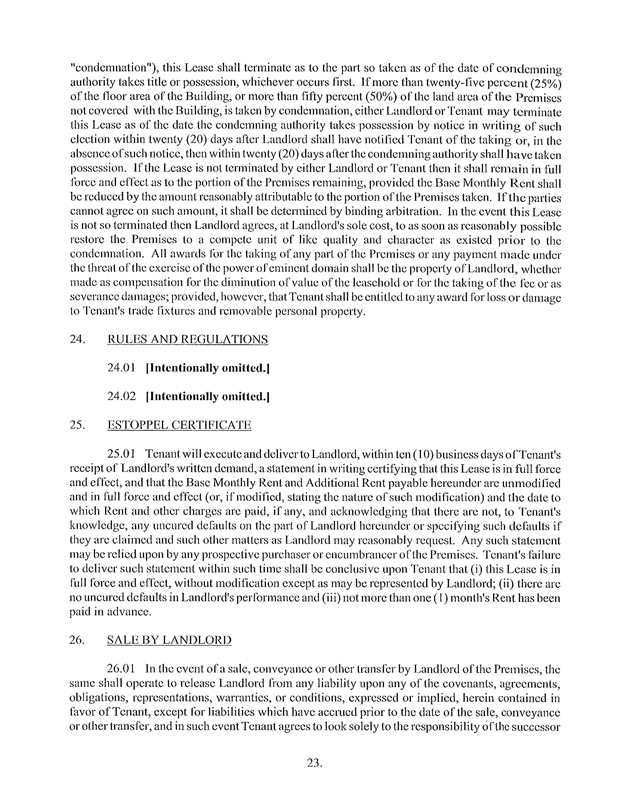
“condemnation”), this Lease shall terminate as to the part so taken as of the date of condemning authority takes title or possession, whichever occurs first. If more than twenty-five percent (25%) of the floor area of the Building, or more than fifty percent (50%) of the land area of the Premises not covered with the Building, is taken by condemnation, either Landlord or Tenant may terminate this Lease as of the date the condemning authority takes possession by notice in writing of such election within twenty (20) days after Landlord shall have notified Tenant of the taking or, in the absence of such notice, then within twenty (20) days after the condemning authority shall have taken possession. If the Lease is not terminated by either Landlord or Tenant then it shall remain in full force and effect as to the portion of the Premises remaining, provided the Base Monthly Rent shall be reduced by the amount reasonably attributable to the portion of the Premises taken. If the parties cannot agree on such amount, it shall be determined by binding arbitration. In the event this Lease is not so terminated then Landlord agrees, at Landlord’s sole cost, to as soon as reasonably possible restore the Premises to a compete unit of like quality and character as existed prior to the condemnation. All awards for the taking of any part of the Premises or any payment made under the threat of the exercise of the power of eminent domain shall be the property of Landlord, whether made as compensation for the diminution of value of the leasehold or for the taking of the fee or as severance damages; provided, however, that Tenant shall be entitled to any award for loss or damage to Tenant’s trade fixtures and removable personal property.
24. RULES AND REGULATIONS
24.01 [Intentionally omitted.]
24.02 [Intentionally omitted.]
25. ESTOPPEL CERTIFICATE
25.01 Tenant will execute and deliver to Landlord, within ten (10) business days of Tenant’s receipt of Landlord’s written demand, a statement in writing certifying that this Lease is in full force and effect, and that the Base Monthly Rent and Additional Rent payable hereunder are unmodified and in full force and effect (or, if modified, stating the nature of such modification) and the date to which Rent and other charges are paid, if any, and acknowledging that there are not, to Tenant’s knowledge, any uncured defaults on the part of Landlord hereunder or specifying such defaults if they are claimed and such other matters as Landlord may reasonably request. Any such statement may be relied upon by any prospective purchaser or encumbrancer of the Premises. Tenant’s failure to deliver such statement within such time shall be conclusive upon Tenant that (i) this Lease is in full force and effect, without modification except as may be represented by Landlord; (ii) there are no uncured defaults in Landlord’s performance and (iii) not more than one (1) month’s Rent has been paid in advance.
26. SALE BY LANDLORD
26.01 In the event of a sale, conveyance or other transfer by Landlord of the Premises, the same shall operate to release Landlord from any liability upon any of the covenants, agreements, obligations, representations, warranties, or conditions, expressed or implied, herein contained in favor of Tenant, except for liabilities which have accrued prior to the date of the sale, conveyance or other transfer, and in such event Tenant agrees to look solely to the responsibility of the successor
23 ..
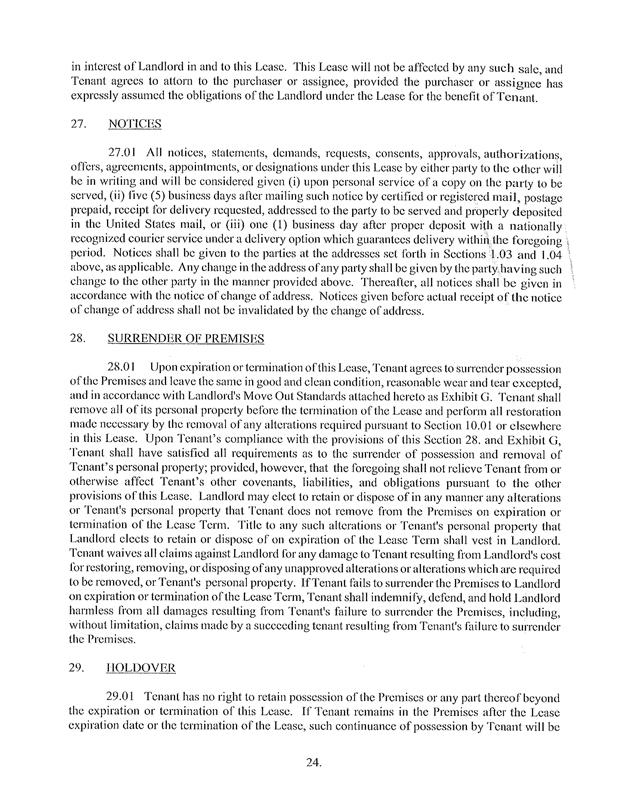
in interest of Landlord in and to this Lease. This Lease will not be affected by any such sale, and Tenant agrees to attorn to the purchaser or assignee, provided the purchaser or assignee has expressly assumed the obligations of the Landlord under the Lease for the benefit of Tenant.
27. NOTICES
27.01 All notices, statements, demands, requests, consents, approvals, authorizations, offers, agreements, appointments, or designations under this Lease by either party to the other will be in writing and will be considered given (i) upon personal service of a copy on the party to be served, (ii) five (5) business days after mailing such notice by certified or registered mail, postage prepaid, receipt for delivery requested, addressed to the party to be served and properly deposited in the United States mail, or (iii) one (1) business day after proper deposit with a nationally recognized courier service under a delivery option which guarantees delivery within the foregoing period. Notices shall be given to the parties at the addresses set forth in Sections 1.03 and 1.04 above, as applicable. Any change in the address of any party shall be given by the party having such change to the other party in the manner provided above. Thereafter, all notices shall be given in accordance with the notice of change of address. Notices given before actual receipt of the notice of change of address shall not be invalidated by the change of address.
28. SURRENDER OF PREMISES
28.01 Upon expiration or termination of this Lease, Tenant agrees to surrender possession of the Premises and leave the same in good and clean condition, reasonable wear and tear excepted, and in accordance with Landlord’s Move Out Standards attached hereto as Exhibit G. Tenant shall remove all of its personal property before the termination of the Lease and perform all restoration made necessary by the removal of any alterations required pursuant to Section 10.01 or elsewhere in this Lease. Upon Tenant’s compliance with the provisions of this Section 28. and Exhibit G, Tenant shall have satisfied all requirements as to the surrender of possession and removal of Tenant’s personal property; provided, however, that the foregoing shall not relieve Tenant from or otherwise affect Tenant’s other covenants, liabilities, and obligations pursuant to the other provisions of this Lease. Landlord may elect to retain or dispose of in any manner any alterations or Tenant’s personal property that Tenant does not remove from the Premises on expiration or termination of the Lease Term. Title to any such alterations or Tenant’s personal property that Landlord elects to retain or dispose of on expiration of the Lease Term shall vest in Landlord. Tenant waives all claims against Landlord for any damage to Tenant resulting from Landlord’s cost for restoring, removing, or disposing of any unapproved alterations or alterations which are required to be removed, or Tenant’s personal property. If Tenant fails to surrender the Premises to Landlord on expiration or termination of the Lease Term, Tenant shall indemnify, defend, and hold Landlord harmless from all damages resulting from Tenant’s failure to surrender the Premises, including, without limitation, claims made by a succeeding tenant resulting from Tenant’s failure to surrender the Premises.
29. HOLDOVER
29.01 Tenant has no right to retain possession of the Premises or any part thereof beyond the expiration or termination of this Lease. If Tenant remains in the Premises after the Lease expiration date or the termination of the Lease, such continuance of possession by Tenant will be
24 ..
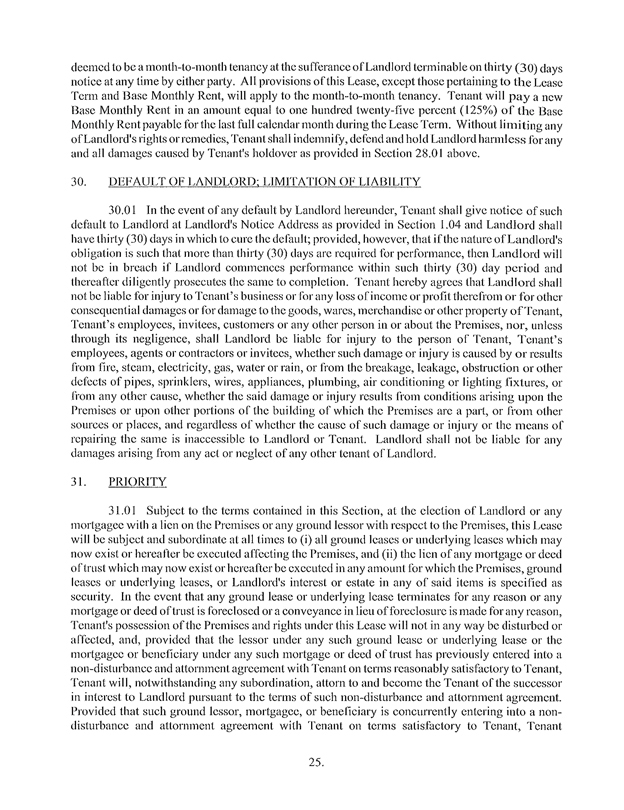
deemed to be a month-to-month tenancy at the sufferance of Landlord terminable on thirty (30) days notice at any time by either party. All provisions of this Lease, except those pertaining to the Lease Term and Base Monthly Rent, will apply to the month-to-month tenancy. Tenant will pay a new Base Monthly Rent in an amount equal to one hundred twenty-five percent (125%) of the Base Monthly Rent payable for the last full calendar month during the Lease Term. Without limiting any of Landlord’s rights or remedies, Tenant shall indemnify, defend and hold Landlord harmless for any and all damages caused by Tenant’s holdover as provided in Section 28.01 above.
30. DEFAULT OF LANDLORD; LIMITATION OF LIABILITY
30.01 In the event of any default by Landlord hereunder, Tenant shall give notice of such default to Landlord at Landlord’s Notice Address as provided in Section 1.04 and Landlord shall have thirty (30) days in which to cure the default; provided, however, that if the nature of Landlord’s obligation is such that more than thirty (30) days are required for performance, then Landlord will not be in breach if Landlord commences performance within such thirty (30) day period and thereafter diligently prosecutes the same to completion. Tenant hereby agrees that Landlord shall not be liable for injury to Tenant’s business or for any loss of income or profit therefrom or for other consequential damages or for damage to the goods, wares, merchandise or other property of Tenant, Tenant’s employees, invitees, customers or any other person in or about the Premises, nor, unless through its negligence, shall Landlord be liable for injury to the person of Tenant, Tenant’s employees, agents or contractors or invitees, whether such damage or injury is caused by or results from fire, steam, electricity, gas, water or rain, or from the breakage, leakage, obstruction or other defects of pipes, sprinklers, wires, appliances, plumbing, air conditioning or lighting fixtures, or from any other cause, whether the said damage or injury results from conditions arising upon the Premises or upon other portions of the building of which the Premises are a part, or from other sources or places, and regardless of whether the cause of such damage or injury or the means of repairing the same is inaccessible to Landlord or Tenant. Landlord shall not be liable for any damages arising from any act or neglect of any other tenant of Landlord.
31. PRIORITY
31.01 Subject to the terms contained in this Section, at the election of Landlord or any mortgagee with a lien on the Premises or any ground lessor with respect to the Premises, this Lease will be subject and subordinate at all times to (i) all ground leases or underlying leases which may now exist or hereafter be executed affecting the Premises, and (ii) the lien of any mortgage or deed of trust which may now exist or hereafter be executed in any amount for which the Premises, ground leases or underlying leases, or Landlord’s interest or estate in any of said items is specified as security. In the event that any ground lease or underlying lease terminates for any reason or any mortgage or deed of trust is foreclosed or a conveyance in lieu of foreclosure is made for any reason, Tenant’s possession of the Premises and rights under this Lease will not in any way be disturbed or affected, and, provided that the lessor under any such ground lease or underlying lease or the mortgagee or beneficiary under any such mortgage or deed of trust has previously entered into a non-disturbance and attornment agreement with Tenant on terms reasonably satisfactory to Tenant, Tenant will, notwithstanding any subordination, attorn to and become the Tenant of the successor in interest to Landlord pursuant to the terms of such non-disturbance and attornment agreement. Provided that such ground lessor, mortgagee, or beneficiary is concurrently entering into a non-disturbance and attornment agreement with Tenant on terms satisfactory to Tenant, Tenant
25 ..
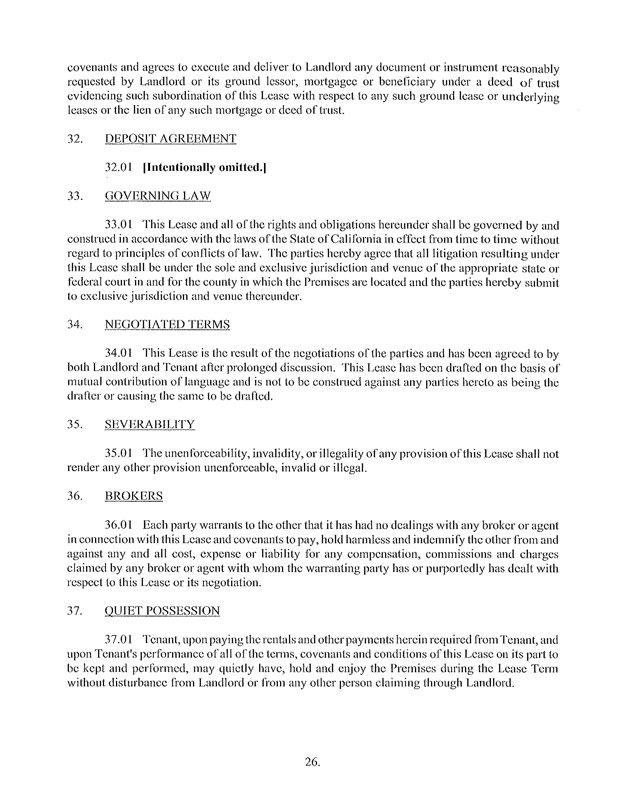
covenants and agrees to execute and deliver to Landlord any document or instrument reasonably requested by Landlord or its ground lessor, mortgagee or beneficiary under a deed of trust evidencing such subordination of this Lease with respect to any such ground lease or underlying leases or the lien of any such mortgage or deed of trust.
32. DEPOSIT AGREEMENT
32.01 [Intentionally omitted.]
33. GOVERNING LAW
33.01 This Lease and all of the rights and obligations hereunder shall be governed by and construed in accordance with the laws of the State of California in effect from time to time without regard to principles of conflicts of law. The parties hereby agree that all litigation resulting under this Lease shall be under the sole and exclusive jurisdiction and venue of the appropriate state or federal court in and for the county in which the Premises are located and the parties hereby submit to exclusive jurisdiction and venue thereunder.
34. NEGOTIATED TERMS
34.01 This Lease is the result of the negotiations of the parties and has been agreed to by both Landlord and Tenant after prolonged discussion. This Lease has been drafted on the basis of mutual contribution of language and is not to be construed against any parties hereto as being the drafter or causing the same to be drafted.
35. SEVERABILITY
35.01 The unenforceability, invalidity, or illegality of any provision of this Lease shall not render any other provision unenforceable, invalid or illegal.
36. BROKERS
36.01 Each party warrants to the other that it has had no dealings with any broker or agent in connection with this Lease and covenants to pay, hold harmless and indemnify the other from and against any and all cost, expense or liability for any compensation, commissions and charges claimed by any broker or agent with whom the warranting party has or purportedly has dealt with respect to this Lease or its negotiation.
37. QUIET POSSESSION
37.01 Tenant, upon paying the rentals and other payments herein required from Tenant, and upon Tenant’s performance of all of the terms, covenants and conditions of this Lease on its part to be kept and performed, may quietly have, hold and enjoy the Premises during the Lease Term without disturbance from Landlord or from any other person claiming through Landlord.
26 ..
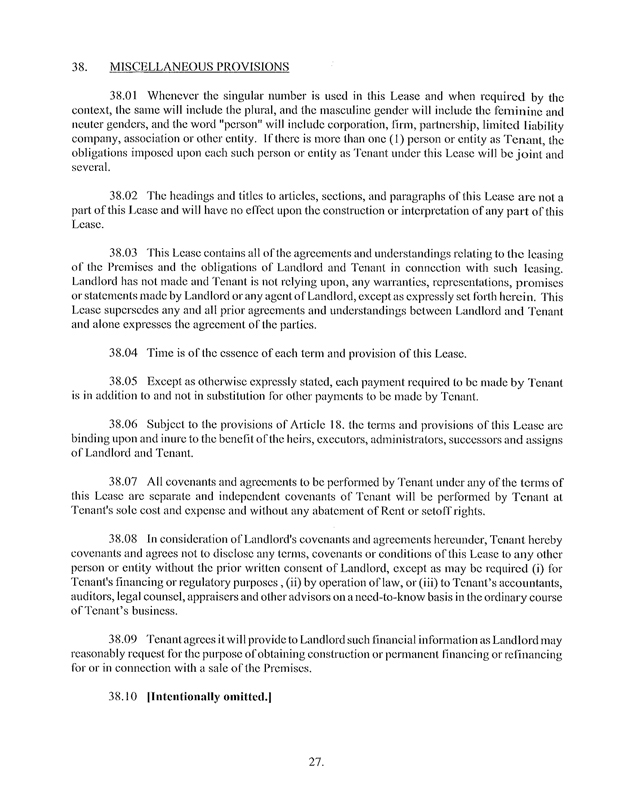
38. MISCELLANEOUS PROVISIONS
38.01 Whenever the singular number is used in this Lease and when required by the context, the same will include the plural, and the masculine gender will include the feminine and neuter genders, and the word “person” will include corporation, firm, partnership, limited liability company, association or other entity. If there is more than one (1) person or entity as Tenant, the obligations imposed upon each such person or entity as Tenant under this Lease will be joint and several.
38.02 The headings and titles to articles, sections, and paragraphs of this Lease are not a part of this Lease and will have no effect upon the construction or interpretation of any part of this Lease.
38.03 This Lease contains all of the agreements and understandings relating to the leasing of the Premises and the obligations of Landlord and Tenant in connection with such leasing. Landlord has not made and Tenant is not relying upon, any warranties, representations, promises or statements made by Landlord or any agent of Landlord, except as expressly set forth herein. This Lease supersedes any and all prior agreements and understandings between Landlord and Tenant and alone expresses the agreement of the parties.
38.04 Time is of the essence of each term and provision of this Lease.
38.05 Except as otherwise expressly stated, each payment required to be made by Tenant is in addition to and not in substitution for other payments to be made by Tenant.
38.06 Subject to the provisions of Article 18. the terms and provisions of this Lease are binding upon and inure to the benefit of the heirs, executors, administrators, successors and assigns of Landlord and Tenant.
38.07 All covenants and agreements to be performed by Tenant under any of the terms of this Lease are separate and independent covenants of Tenant will be performed by Tenant at Tenant’s sole cost and expense and without any abatement of Rent or setoff rights.
38.08 In consideration of Landlord’s covenants and agreements hereunder, Tenant hereby covenants and agrees not to disclose any terms, covenants or conditions of this Lease to any other person or entity without the prior written consent of Landlord, except as may be required (i) for Tenant’s financing or regulatory purposes, (ii) by operation of law, or (iii) to Tenant’s accountants, auditors, legal counsel, appraisers and other advisors on a need-to-know basis in the ordinary course of Tenant’s business.
38.09 Tenant agrees it will provide to Landlord such financial information as Landlord may reasonably request for the purpose of obtaining construction or permanent financing or refinancing for or in connection with a sale of the Premises.
38.10 [Intentionally omitted.]
27 ..
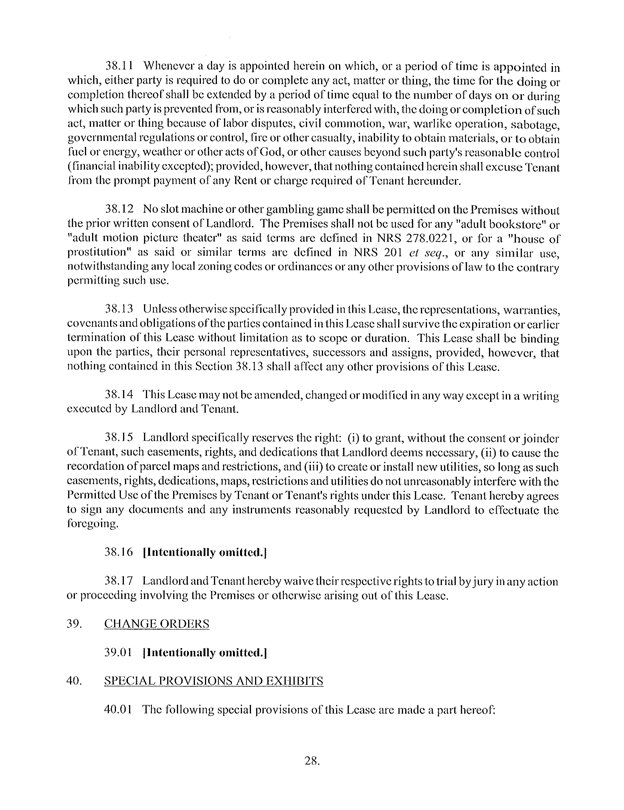
38.11 Whenever a day is appointed herein on which, or a period of time is appointed in which, either party is required to do or complete any act, matter or thing, the time for the doing or completion thereof shall be extended by a period of time equal to the number of days on or during which such party is prevented from, or is reasonably interfered with, the doing or completion of such act, matter or thing because of labor disputes, civil commotion, war, warlike operation, sabotage, governmental regulations or control, fire or other casualty, inability to obtain materials, or to obtain fuel or energy, weather or other acts of God, or other causes beyond such party’s reasonable control (financial inability excepted); provided, however, that nothing contained herein shall excuse Tenant from the prompt payment of any Rent or charge required of Tenant hereunder.
38.12 No slot machine or other gambling game shall be permitted on the Premises without the prior written consent of Landlord. The Premises shall not be used for any “adult bookstore” or “adult motion picture theater” as said terms are defined in NRS 278.0221, or for a “house of prostitution” as said or similar terms are defined in NRS 201 et seq., or any similar use, notwithstanding any local zoning codes or ordinances or any other provisions of law to the contrary permitting such use.
38.13 Unless otherwise specifically provided in this Lease, the representations, warranties, covenants and obligations of the parties contained in this Lease shall survive the expiration or earlier termination of this Lease without limitation as to scope or duration. This Lease shall be binding upon the parties, their personal representatives, successors and assigns, provided, however, that nothing contained in this Section 38.13 shall affect any other provisions of this Lease.
38.14 This Lease may not be amended, changed or modified in any way except in a writing executed by Landlord and Tenant.
38.15 Landlord specifically reserves the right: (i) to grant, without the consent or joinder of Tenant, such easements, rights, and dedications that Landlord deems necessary, (ii) to cause the recordation of parcel maps and restrictions, and (iii) to create or install new utilities, so long as such easements, rights, dedications, maps, restrictions and utilities do not unreasonably interfere with the Permitted Use of the Premises by Tenant or Tenant’s rights under this Lease. Tenant hereby agrees to sign any documents and any instruments reasonably requested by Landlord to effectuate the foregoing.
38.16 [Intentionally omitted.]
38.17 Landlord and Tenant hereby waive their respective rights to trial by jury in any action or proceeding involving the Premises or otherwise arising out of this Lease.
39. CHANGE ORDERS
39.01 [Intentionally omitted.]
40. SPECIAL PROVISIONS AND EXHIBITS
40.01 The following special provisions of this Lease are made a part hereof:
28 ..
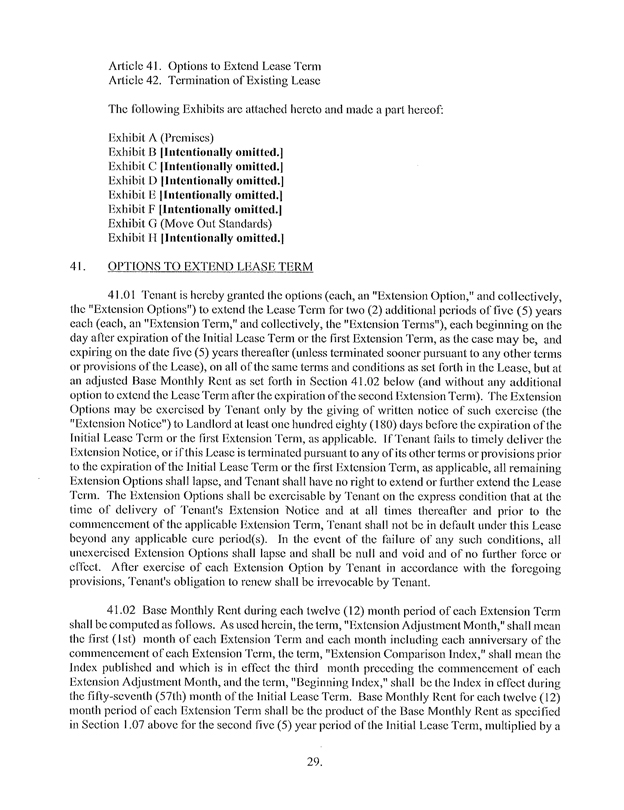
Article 41. Options to Extend Lease Term
Article 42. Termination of Existing Lease
The following Exhibits are attached hereto and made a part hereof:
Exhibit A (Premises)
Exhibit B [Intentionally omitted.]
Exhibit C [Intentionally omitted.]
Exhibit D [Intentionally omitted.]
Exhibit E [Intentionally omitted.]
Exhibit F [Intentionally omitted.]
Exhibit G (Move Out Standards)
Exhibit H [Intentionally omitted.]
41. OPTIONS TO EXTEND LEASE TERM
41.01 Tenant is hereby granted the options (each, an “Extension Option,” and collectively, the “Extension Options”) to extend the Lease Term for two (2) additional periods of five (5) years each (each, an “Extension Term,” and collectively, the “Extension Terms”), each beginning on the day after expiration of the Initial Lease Term or the first Extension Term, as the case may be, and expiring on the date five (5) years thereafter (unless terminated sooner pursuant to any other terms or provisions of the Lease), on all of the same terms and conditions as set forth in the Lease, but at an adjusted Base Monthly Rent as set forth in Section 41.02 below (and without any additional option to extend the Lease Term after the expiration of the second Extension Term). The Extension Options may be exercised by Tenant only by the giving of written notice of such exercise (the “Extension Notice”) to Landlord at least one hundred eighty (180) days before the expiration of the Initial Lease Term or the first Extension Term, as applicable. If Tenant fails to timely deliver the Extension Notice, or if this Lease is terminated pursuant to any of its other terms or provisions prior to the expiration of the Initial Lease Term or the first Extension Term, as applicable, all remaining Extension Options shall lapse, and Tenant shall have no right to extend or further extend the Lease Term. The Extension Options shall be exercisable by Tenant on the express condition that at the time of delivery of Tenant’s Extension Notice and at all times thereafter and prior to the commencement of the applicable Extension Term, Tenant shall not be in default under this Lease beyond any applicable cure period(s). In the event of the failure of any such conditions, all unexercised Extension Options shall lapse and shall be null and void and of no further force or effect. After exercise of each Extension Option by Tenant in accordance with the foregoing provisions, Tenant’s obligation to renew shall be irrevocable by Tenant.
41.02 Base Monthly Rent during each twelve (12) month period of each Extension Term shall be computed as follows. As used herein, the term, “Extension Adjustment Month,” shall mean the first (1st) month of each Extension Term and each month including each anniversary of the commencement of each Extension Term, the term, “Extension Comparison Index,” shall mean the Index published and which is in effect the third month preceding the commencement of each Extension Adjustment Month, and the term, “Beginning Index,” shall be the Index in effect during the fifty-seventh (57th) month of the Initial Lease Term. Base Monthly Rent for each twelve (12) month period of each Extension Term shall be the product of the Base Monthly Rent as specified in Section 1.07 above for the second five (5) year period of the Initial Lease Term, multiplied by a
29 ..
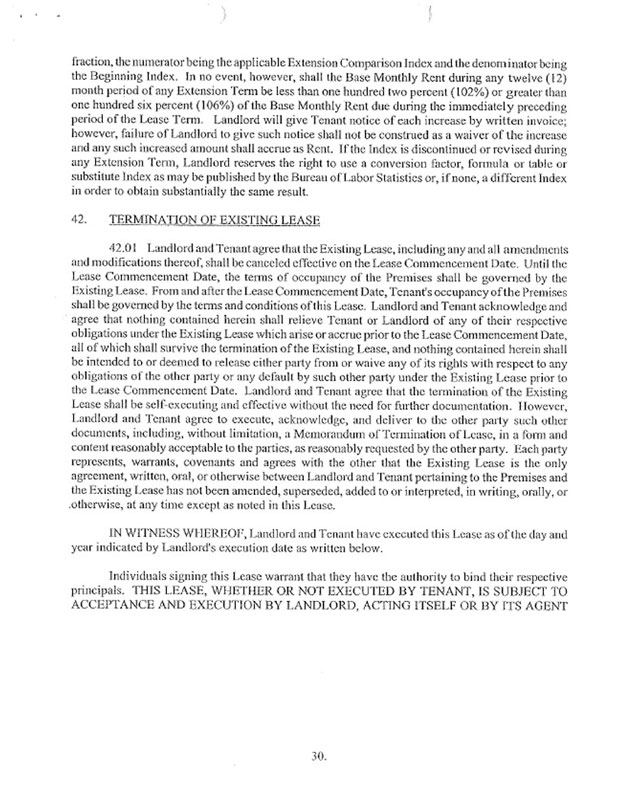
fraction, the numerator being the applicable Extension Comparison Index and the denominator being the Beginning Index. In no event, however, shall the Base Monthly Rent during any twelve (12) month period of any Extension Term be less than one hundred two percent (102%) or greater than one hundred six percent (106%) of the Base Monthly Rent due during the immediately preceding period of the Lease Term. Landlord will give Tenant notice of each increase by written invoice; however, failure of Landlord to give such notice shall not be construed as a waiver of the increase and any such increased amount shall accrue as Rent. If the Index is discontinued or revised during any Extension Term, Landlord reserves the right to use a conversion factor, formula or table or substitute Index as may be published by the Bureau of Labor Statistics or, if none, a different Index in order to obtain substantially the same result.
42. TERMINATION OF EXISTING LEASE
42.01 Landlord and Tenant agree that the Existing Lease, including any and all amendments and modifications thereof, shall be canceled effective on the Lease Commencement Date. Until the Lease Commencement Date, the terms of occupancy of the Premises shall be governed by the Existing Lease. From and after the Lease Commencement Date, Tenant’s occupancy of the Premises shall be governed by the terms and conditions of this Lease. Landlord and Tenant acknowledge and agree that nothing contained herein shall relieve Tenant or Landlord of any of their respective obligations under the Existing Lease which arise or accrue prior to the Lease Commencement Date, all of which shall survive the termination of the Existing Lease, and nothing contained herein shall be intended to or deemed to release either party from or waive any of its rights with respect to any obligations of the other party or any default by such other party under the Existing Lease prior to the Lease Commencement Date. Landlord and Tenant agree that the termination of the Existing Lease shall be self-executing and effective without the need for further documentation. However, Landlord and Tenant agree to execute, acknowledge, and deliver to the other party such other documents, including, without limitation, a Memorandum of Termination of Lease, in a form and content reasonably acceptable to the parties, as reasonably requested by the other party. Each party represents, warrants, covenants and agrees with the other that the Existing Lease is the only agreement, written, oral, or otherwise between Landlord and Tenant pertaining to the Premises and the Existing Lease has not been amended, superseded, added to or interpreted, in writing, orally, or otherwise, at any time except as noted in this Lease.
IN WITNESS WHEREOF, Landlord and Tenant have executed this Lease as of the day and year indicated by Landlord’s execution date as written below.
Individuals signing this Lease warrant that they have the authority to bind their respective principals. THIS LEASE, WHETHER OR NOT EXECUTED BY TENANT, IS SUBJECT TO ACCEPTANCE AND EXECUTION BY LANDLORD, ACTING ITSELF OR BY ITS AGENT
30.
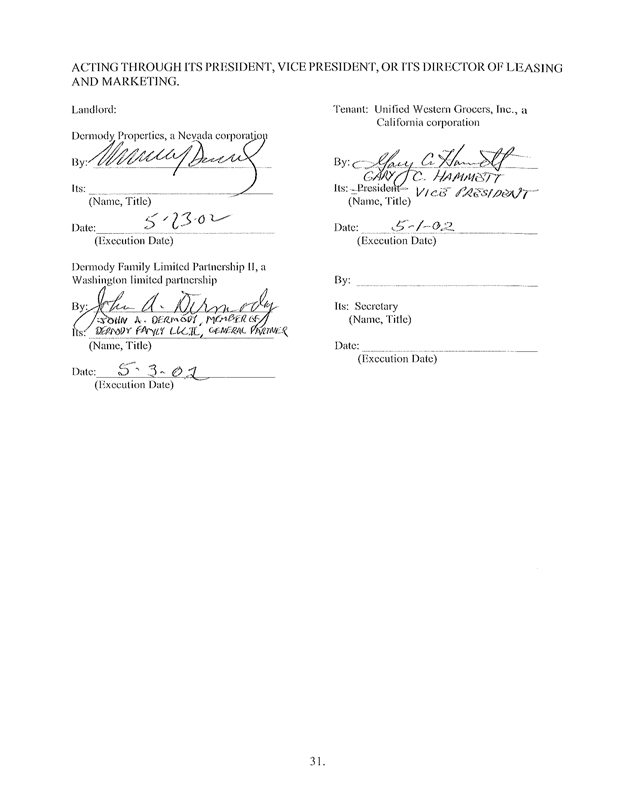
ACTING THROUGH ITS PRESIDENT, VICE PRESIDENT, OR ITS DIRECTOR OF LEASING AND MARKETING.
Landlord:
Dermody Properties, a Nevada corporation
By:
Its:
(Name, Title)
Date: 5-23-02
(Execution Date)
Dermody Family Limited Partnership II, a Washington limited partnership
By: JOHN A. DERMODY
Its: JOHN A. DERMODY, MEMBER OF DERMODY FAMILY LLC II, GENERAL PARTNER
(Name, Title)
Date: 5-3-02
(Execution Date)
Tenant: Unified Western Grocers, Inc., a California corporation
By: GARY C. HAMMETT
GARY C. HAMMETT
Its: VICE PRESIDENT
(Name, Title)
Date: 5-1-02
(Execution Date)
By:
Its: Secretary
(Name, Title)
Date:
(Execution Date)
31.
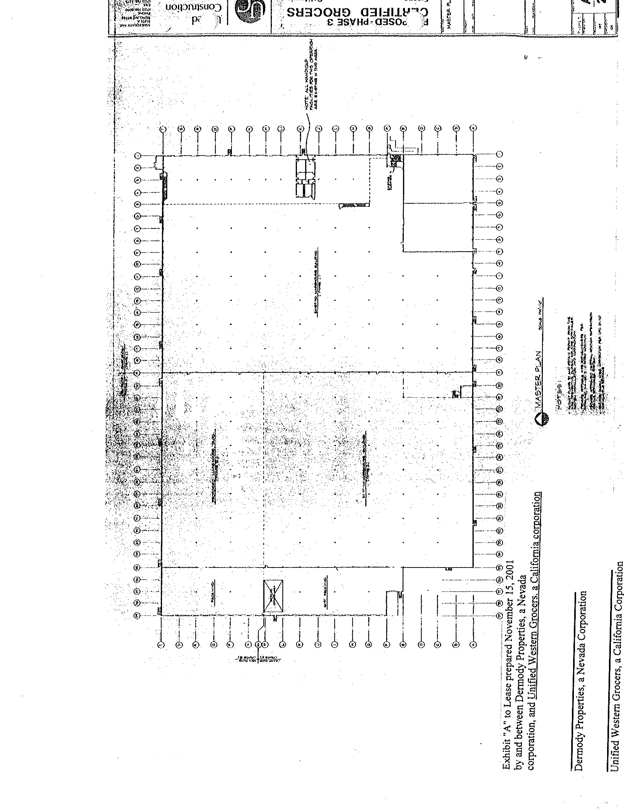
Exhibit “A” to Lease prepared November 15, 2001
by and between Dermody Properties, a Nevada
corporation, and Unified Western Grocers, a California corporation
Dermody Properties, a Nevada Corporation
Unified Western Grocers, a California Corporation
MASTER PLAN
P POSED PHASE 3
CERTIFIED GROCERS U
Construction
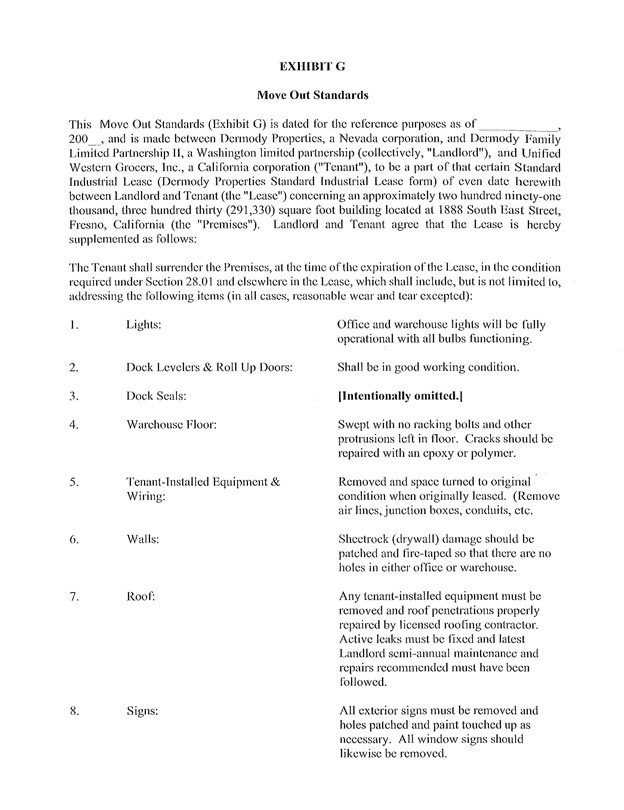
EXHIBIT G
Move Out Standards
This Move Out Standards (Exhibit G) is dated for the reference purposes as of , 200 , and is made between Dermody Properties, a Nevada corporation, and Dermody Family Limited Partnership II, a Washington limited partnership (collectively, “Landlord”), and Unified Western Grocers, Inc., a California corporation (“Tenant”), to be a part of that certain Standard Industrial Lease (Dermody Properties Standard Industrial Lease form) of even date herewith between Landlord and Tenant (the “Lease”) concerning an approximately two hundred ninety-one thousand, three hundred thirty (291,330) square foot building located at 1888 South East Street, Fresno, California (the “Premises”). Landlord and Tenant agree that the Lease is hereby supplemented as follows:
The Tenant shall surrender the Premises, at the time of the expiration of the Lease, in the condition required under Section 28.01 and elsewhere in the Lease, which shall include, but is not limited to, addressing the following items (in all cases, reasonable wear and tear excepted):
1. Lights: Office and warehouse lights will be fully
operational with all bulbs functioning.
2. Dock Levelers & Roll Up Doors: Shall be in good working condition.
3. Dock Seals: [Intentionally omitted.]
4. Warehouse Floor: Swept with no racking bolts and other
protrusions left in floor. Cracks should be repaired with an epoxy or polymer.
5. Tenant-Installed Equipment & Removed and space turned to original Wiring: condition when originally leased. (Remove
air lines, junction boxes, conduits, etc.
6. Walls: Sheetrock (drywall) damage should be
patched and fire-taped so that there are no holes in either office or warehouse.
7. Roof: Any tenant-installed equipment must be
removed and roof penetrations properly repaired by licensed roofing contractor. Active leaks must be fixed and latest Landlord semi-annual maintenance and repairs recommended must have been followed.
8. Signs: All exterior signs must be removed and
holes patched and paint touched up as necessary. All window signs should likewise be removed.
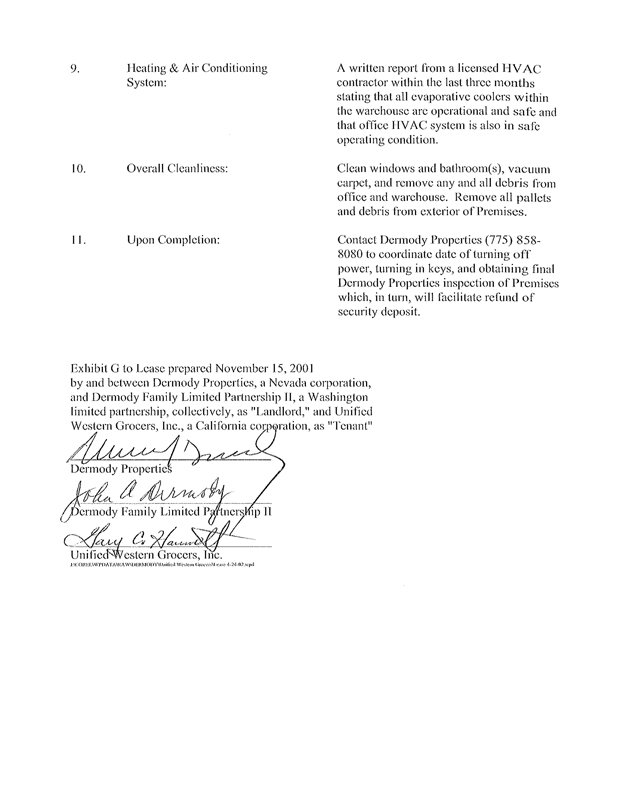
9. Heating & Air Conditioning System:
10. Overall Cleanliness:
11. Upon Completion:
A written report from a licensed HVAC contractor within the last three months stating that all evaporative coolers within the warehouse are operational and safe and that office HVAC system is also in safe operating condition.
Clean windows and bathroom(s), vacuum carpet, and remove any and all debris from office and warehouse. Remove all pallets and debris from exterior of Premises.
Contact Dermody Properties (775) 858-8080 to coordinate date of turning off power, turning in keys, and obtaining final Dermody Properties inspection of Premises which, in turn, will facilitate refund of security deposit.
Exhibit G to Lease prepared November 15, 2001 by and between Dermody Properties, a Nevada corporation, and Dermody Family Limited Partnership II, a Washington limited partnership, collectively, as “Landlord,” and Unified Western Grocers, Inc., a California corporation, as “Tenant”
Dermody Properties
John A Dermody
Dermody Family Limited Partnership II
Gary C. Hammett
Unified Western Grocers, Inc.
Exhibit 10.5.1
LEASE AMENDMENT AND EXTENSION AGREEMENT
This Lease Amendment and Extension Agreement (the “Amendment”) is entered into as of September , 2011, by and between Endsley Fresno Properties, L.P., a California limited partnership (“Landlord”), and Unified Grocers, Inc., a California corporation (“Tenant”), who agree as follows:
1.Recitals. This Amendment is made with reference to the following facts and circumstances:
(a) Landlord, as successor to Dermody Properties, is the landlord and Tenant, formerly known as Unified Western Grocers, Inc., is the tenant under that certain Standard Industrial Lease (Net-Net-Net) (Single Tenant), dated as of November 15, 2001 (together with all prior amendments thereto, if any, the “Lease”). Capitalized terms used but not otherwise defined in this Amendment have the meanings given to them in the Lease.
(b) The Initial Lease Term of the Lease is scheduled to expire on April 30, 2012, and Tenant has the options to extend the term of the Lease for two (2) additional Extension Terms of (5) years each, all as provided in the Lease.
(c) Tenant desires to extend the Initial Lease Term while retaining its options respecting the Extension Terms, and Landlord is agreeable to extension of the Initial Lease Term; and by this Amendment, Landlord and Tenant desire to set forth their agreements with respect thereto.
2.Amendments. Landlord and Tenant agree that the Lease is amended as follows:
(a) The Initial Lease Term will expire on October 31, 2012, rather than April 30, 2012. Tenant will have the option (the “Interim Extension Option”) to further extend the Initial Lease Term for one (1) additional period of six (6) months (the “Interim Extension Term”) such that the Initial Lease Term would then expire on April 30, 2013. The Interim Extension Option may be exercised by Tenant only by the giving of written notice of such exercise (the “Interim Extension Notice”) to Landlord at least sixty (60) days before the expiration of the Initial Lease Term. If Tenant fails to timely deliver the Interim Extension Notice, or if this Lease is terminated pursuant to any of its other terms or provisions prior to the expiration of the Initial Lease Term, all remaining Extension Options shall lapse, and Tenant shall have no right to extend or further extend the Lease Term. The Interim Extension Option shall be exercisable by Tenant on the express condition that at the time of delivery of Tenant’s Interim Extension Notice and at all times thereafter and prior to the commencement of the Interim Extension Term, Tenant shall not be in default under the Lease beyond any applicable cure period(s). In the event of the failure of any such conditions, all unexercised Extension Options shall lapse and shall be null and void and of no further force or effect. After exercise of the Interim Extension Option by Tenant in accordance with the foregoing provisions, Tenant obligation to renew shall be irrevocable by Tenant. The Interim Extension Term will be at the same Base Monthly Rent and otherwise on all of the same terms and conditions as are in effect under the Lease immediately preceding the commencement of the Interim Extension Term.
1
(b) In addition to the Interim Extension Option, Tenant shall continue to have the Extension Options to extend the Lease Term for the two Extension Terms as provided in the Lease. However, notwithstanding the provisions of Section 41.01 of the Lease to the contrary, Tenant’s exercise, if any, of the first Extension Option shall be by the giving of an Extension Notice at least sixty (60) days before the expiration of the Initial Lease Term, rather than at least one hundred eighty (180) days before such expiration. Tenant’s exercise, if any, of the second Extension Option shall continue to be by the giving of an Extension Notice at least one hundred eighty (180) days prior to the expiration of the first Extension Term.
3.Lease Remains in Effect. Except as amended hereby, the Lease remains unmodified and in full force and effect.
4.Miscellaneous. This Amendment constitutes the entire understanding and agreement of the parties with respect to its subject matter and it supersedes all other understandings and agreements of the parties with respect thereto.
5.Counterparts. This Amendment may be executed in counterparts, each of which is an original but all of which together constitute but one and the same instrument. Signature pages of this Amendment may be detached from any counterpart and re-attached to any other counterpart of this Amendment which is identical in form hereto but having attached to it one or more additional signature pages.
The parties have caused this Amendment to be duly executed by their respective duly authorized officers or representatives as of the date first set forth above.
| | | | | | | | |
| ENDSLEY FRESNO PROPERTIES, L.P., | | | | UNIFIED GROCERS, INC., |
| a California limited partnership | | | | a California corporation |
| | | | |
| By: | | /s/ Stephen Endsley | | | | By: | | /s/ Gary C. Hammett |
| | Stephen Endsley | | | | | | Gary C. Hammett |
| | General Partner | | | | | | Vice President |
2
Exhibit 10.6
FIFTH AMENDMENT TO EMPLOYMENT AGREEMENT
This Fifth Amendment to Employment Agreement (the “Fifth Amendment”) is made and entered into as of May 15, 2012 by and between Unified Grocers, Inc., a California corporation (the “Company”) and Alfred A. Plamann (the “Executive”).
WHEREAS, the Company and Executive entered into an Employment Agreement (the “Employment Agreement”), as of February 5, 1996, a copy of which is attached as Exhibit “A”, and further entered into the Amendment to Employment Agreement, as of August, 1999, the Second Amendment to Employment Agreement, as of April, 2001, the Third Amendment to Employment Agreement, as of August 20, 2003, and the Fourth Amendment to Employment Agreement, as of December 30, 2011, copies of which are attached as Exhibit “B”. The Employment Agreement and the amendments are sometimes referred to as the “Amended Employment Agreement”; and
WHEREAS, the Company and Executive desire to amend the terms and conditions of the Amended Employment Agreement, as set forth in this Fifth Amendment.
NOW, THEREFORE, in consideration of the foregoing and of the mutual covenants herein contained, it is agreed as follows:
1. Section 3 of the Amended Employment Agreement is amended in its entirety to read as follows:
“3.Duties of the Executive. The Executive shall serve as the Chief Executive Officer of the Company, serving at the pleasure of the Company’s Board of Directors (the “Board”). The Executive shall devote substantially all of his normal working time and his best efforts, full attention and energies to the business of the Company, the responsibilities provided for the Chief Executive Officer in the Company’s Bylaws, and such other related duties and responsibilities as may from time to time be reasonably prescribed by the Board. Notwithstanding the foregoing and with the advance approval of the Board, which approval may be withheld for any reason, the Executive may serve on the boards of directors of unrelated companies and may devote reasonable time to fulfilling his responsibilities as a member of such boards.”
2. Subsection 8(a)(iv) of the Amended Employment Agreement is amended in its entirety to read as follows:
“(iv) the Board fails to appoint the Executive as Chief Executive Officer;”
[Signature Page to Fifth Amendment to Employment Agreement Follows]
-1-
IN WITNESS WHEREOF, the parties hereto have executed this Fifth Amendment as of the day and year first above written.
| | | | | | |
| Company: | | | | Executive: |
| | |
| UNIFIED GROCERS, INC. | | | | |
| | | |
| By | | /s/ Richard E. Goodspeed | | | | /s/ Alfred A. Plamann |
| | Richard E. Goodspeed | | | | Alfred A. Plamann |
| | Chairman of the Board | | | | |
-2-
Exhibit 10.7
SEVERANCE AGREEMENT
(FOR THE COMPANY PRESIDENT)
THIS AMENDED AND RESTATED AGREEMENT (the“Agreement”) is made and entered into as of this 15th day of May, 2012, by and between Unified Grocers, Inc. (the“Company”) located at 5200 Sheila Street, Commerce, California 90040 and Robert M. Ling, Jr. (the“Executive”).
WHEREAS,the Company considers the establishment and maintenance of a sound and vital management to be essential to protecting and enhancing the best interests of the Company and its shareholders; and
WHEREAS,the Executive’s position has been determined to be an important part of the senior management team of the Company; and
WHEREAS,the Company recognizes that the possibility of termination due to Change of Control, Good Reason or without cause creates uncertainty among management personnel of the Company and may result in the departure or distraction of management personnel, all to the detriment of the Company and its shareholders; and
WHEREAS, the Company and the Executive originally executed and delivered that certain Severance Agreement, dated as of March 12, 2001, which was amended and restated as of December 30, 2010 (the“Amended 2010 Agreement”); and
WHEREAS, in connection with the Executive’s election to the position of President by the Company’s Board of Directors, effective as of June 7, 2011, the parties desire to restate the Amended 2010 Agreement with the terms and conditions set forth herein.
NOW, THEREFORE,in consideration of the promises and of the mutual covenants herein contained, the following is an agreement to provide severance benefits to the Executive in the event the Executive’s employment with the Company is terminated under the circumstances described herein.
| 1. | Right to Terminate. The Company or the Executive may terminate the Executive’s employment at any time, subject to the Company providing the benefits hereinafter specified in accordance with the terms and eligibility requirements of this Agreement. Nothing contained in this Agreement is intended to be nor should be construed to create a contract of employment for a specified period of time, or otherwise change or alter the at-will nature of the Executive’s employment with the Company. |
| 2. | Eligibility Requirements. The Executive shall be entitled to the benefits provided in Section 5 upon his termination of employment from the Company subject to the following terms and conditions: |
| | (a) | He must be employed as the Company’s President prior to the date of this Agreement; and |
| | (b) | his termination is caused: |
| | (i) | by the Company other than for Cause or Death; |
-1-
SEVERANCE AGREEMENT
(FOR THE COMPANY PRESIDENT)
| | (ii) | by Disability as defined below; |
| | (iii) | by the Executive for Good Reason; or |
| | (iv) | by the Executive within one (1) year of a Change of Control (as all such capitalized terms are hereinafter defined). |
“Cause” means termination upon (i) the willful and continued failure by the Executive to perform substantially his duties (other than any such failure resulting from the Executive’s incapacity due to physical or mental illness), after demand for substantial performance is delivered in writing by the Company to the Executive that specifically identifies the manner in which the Company believes the Executive has not substantially performed his duties, (ii) the willful engaging by the Executive in illegal or fraudulent misconduct which is materially injurious to the Company, or (iii) the willful material breach of the Confidentiality and Nonsolicitation Agreement set forth in Section 7. No act, or failure to act, on the Executive’s part shall be considered “willful” unless done, or omitted to be done, by him not in good faith and without reasonable belief that his action or omission was in the best interest of the Company.
“Disability”means the Executive’s incapacity due to physical or mental illness to perform substantially his duties on a full-time basis for six (6) consecutive months and, within thirty (30) days after a notice of termination is thereafter given by the Company, the Executive shall not have returned to the full-time performance of the Executive’s duties. However, if the Executive shall not agree with the determination to terminate him because of Disability, the question of the Executive’s disability shall be subject to the certification of a qualified medical doctor agreed to by the Company and the Executive or Executive’s legal representative, in the event of the Executive’s incapacity to designate a doctor. In the absence of an agreement between the Company and the Executive, each party shall nominate a qualified medical doctor and the two doctors shall select a third doctor, who shall make the determination as to Disability.
“Good Reason”means the first to occur of the following conditions without the Executive’s express written consent: (i) an adverse change in the Executive’s status or position(s), in effect immediately prior to the date of this Agreement, or (ii) a material reduction in the Executive’s base salary; provided, however, that the Executive will be deemed to have terminated his employment for Good Reason only if the Executive has provided the Company written notice of the existence of the Good Reason condition within ninety (90) days of its first occurrence, the Company has failed to correct the matter within thirty (30) days of such notice, and the Executive terminates his employment within ten (10) days following the Company’s failure to correct the Good Reason condition.
-2-
SEVERANCE AGREEMENT
(FOR THE COMPANY PRESIDENT)
“Change of Control”means any of (i) the acquisition by any person, entity or group within the meaning of Section 13(d) or 14(d) of the Securities and Exchange Act of 1934, of beneficial ownership of more than fifty percent (50%) of the outstanding Class A Shares of Unified Grocers, Inc.; (ii) if the individuals who presently serve on the Board of Directors no longer constitute a majority of the members of the Company’s Board of Directors; provided, however that any person who becomes a director subsequent to the commencement date of this Agreement who was elected to fill a vacancy by a majority of the Company’s members shall be considered as if a member prior to the commencement date of this Agreement; and (iii) a liquidation or dissolution of the Company or the sale of all or substantially all of the assets of the Company.
| 3. | Notice of Termination. Any purported termination by the Company or by the Executive shall be communicated by written Notice of Termination to the other party hereto. For purposes of this Agreement, a“Notice of Termination”means a notice indicating the specific termination provision in this Agreement relied upon. |
| 4. | Date of Termination.“Date of Termination” means the date set forth by written Notice of Termination or, if none, then by mutual written agreement of the parties, on which the Executive experiences a “separation from service” (within the meaning of Section 409A of the Internal Revenue Code of 1986, as amended (the “Section 409A”)) on account of an event described in Section 2(b). Notwithstanding any provision in this Agreement to the contrary, no severance benefits under this Agreement shall be paid prior to the Executive experiencing a “separation from service” within the meaning of Section 409A. |
| 5. | Benefits Upon Termination. |
| | (a) | Subject to Section 9 hereof, if the Executive’s termination of employment with the Company satisfies the conditions set forth in Section 2, then the Executive will be paid the equivalent of twenty-four (24) month’s pay based on an amount equal to the Executive’s highest annual base salary during the three year period immediately prior to the Date of Termination, plus an amount equal to two (2) times the highest annual incentive bonus paid during the three year period prior to the Date of Termination (collectively, hereinafter referred to as the “Severance Pay”). The Severance Pay shall be paid in a lump sum payment within thirty (30) days of the Date of Termination. Payments made under this subsection (a) shall not be taken into account under any other retirement plan of the Company. |
| | (b) | With respect to the Executive’s continued coverage under the Company’s health insurance plan, or successor plan, the Executive’s “qualifying event” for purposes of the Consolidated Omnibus Budget Reconciliation Act of 1985 (“COBRA”) shall be his Date of Termination from the Company. If the Executive elects to continue health plan coverage pursuant to COBRA, the Company shall pay the Executive’s COBRA premiums for a period terminating on the earlier of (i) |
-3-
SEVERANCE AGREEMENT
(FOR THE COMPANY PRESIDENT)
| | twenty-four (24) months from the Date of Termination or (ii) the cessation of COBRA eligibility and coverage for the Executive (without regard to any other COBRA qualified beneficiary). The Company’s obligation with respect to subsection (b) shall continue only if the Executive satisfies on a timely basis all of his obligations under COBRA. As applicable, continued coverage under this subsection (b) shall be coordinated with corresponding benefits that the Executive may be eligible to receive under the Officer Retiree Medical Plan. |
| | (c) | If the Executive incurs a termination of employment with the Company within one year of a Change of Control, as provided for in Section 2(b)(iv) above, then the Executive shall be credited with an additional 5 years of service for purposes of calculating the Executive’s benefits under Unified Grocers, Inc. Executive Salary Protection Plan II (the “ESPP II”). The Executive’s benefits under ESPP II shall otherwise be calculated and paid pursuant to the terms of such plan. |
| | (d) | All unpaid benefits set forth in this section shall be forfeited if the Executive violates any material provision of this Agreement including, without limitation, the Confidentiality and Nonsolicitation Agreement set forth in Section 7. |
| | (e) | If the Executive’s termination of employment with the Company does not satisfy the conditions set forth in Section 2, no payment or benefits shall be provided under this Agreement. This Agreement does not, and is not intended to, limit any rights or benefits of the Executive pursuant to any other non-severance type plan, policy or written agreement; provided, however, that this Agreement is intended to be the sole agreement governing severance-type benefits. Under no circumstances will the Executive be entitled to or eligible for any other severance type benefits from the Employer, including any obligations that existed under any prior agreements including but not limited to prior severance agreements or under the Unified Grocers’ Separation Payment Program. |
| 6. | No Obligation to Mitigate. The Executive is under no obligation to mitigate damages in the amount of any payment provided for hereunder by seeking other employment or otherwise. Subject to section 5(b), the amount of any payment provided for in this Agreement shall not be reduced, offset or subject to recovery by the Company by reason of any compensation earned by the Executive as the result of employment by another employer after the Date of Termination, or otherwise. |
| 7. | Confidentiality and Nonsolicitation Agreement. |
| | (a) | The Executive acknowledges that in the course of his employment by the Company, he will have access to and become informed of confidential and secret information which is a competitive asset of the Company (“Confidential Information”), including (i) the terms of any agreement between the Company |
-4-
SEVERANCE AGREEMENT
(FOR THE COMPANY PRESIDENT)
| | and any employee, customer or supplier, (ii) pricing strategy, (iii) product development strategies, (iv) personnel training and development programs, (v) financial results, (vi) strategic plans and demographic analyses, (vii) proprietary computer and systems software, and (viii) any confidential nonpublic information received from the Company concerning the Company, its employees, suppliers and customers. |
| | (b) | The Executive agrees that he will keep all Confidential Information in strict confidence during the term of his employment by the Company and thereafter and will never make known, divulge, reveal, furnish, make available, or use any Confidential Information (except in the course of his regular authorized duties on behalf of the Company). The Executive agrees that the obligations of confidentiality hereunder shall survive termination of his employment at the Company regardless of any actual or alleged breach by the Company of this Agreement and shall continue for one (1) year following such termination provided that such obligation shall terminate earlier (i) as to specific information that shall have become known through no fault of the Executive or (ii) as to Confidential Information which the Executive is required by law to disclose (after giving the Company notice and an opportunity to contest such requirement). The Executive’s obligations under this Section 7 are in addition to, and not in limitation or preemption of, any other obligation of confidentiality which the Executive may have to the Company under general legal or equitable principles. |
| | (c) | Except in the ordinary course of the Company’s business, the Executive has not made, nor shall at any time following the date of this Agreement, make or cause to be made, any copies, pictures, duplicates, facsimiles, or other reproductions or recordings or any abstracts or summaries including or reflecting Confidential Information. All such documents and other property furnished to the Executive by the Company or otherwise acquired or developed by the Company shall at all times be the property of the Company. Upon termination of the Executive’s employment by the Company, the Executive will immediately return to the Company any such documents or other property of the Company which are in the possession, custody or control of the Executive. |
| | (d) | In the event of the Executive’s termination of employment at the Company, the Executive agrees that he will not in any capacity, on his own behalf or on behalf of any other firm, person, or entity, for a period of one (1) year, solicit, or assist in the solicitation of, any employee of the Company to terminate his or her employment with the Company. |
| | (e) | The Executive acknowledges and agrees that a violation of the foregoing provisions of this Section 7 (referred to collectively as the “Confidentiality and Nonsolicitation Agreement”) that results in material detriment to the Company |
-5-
SEVERANCE AGREEMENT
(FOR THE COMPANY PRESIDENT)
| | would cause irreparable harm to the Company, and that the Company’s remedy at law for any such violation would be inadequate. In recognition of the foregoing, the Executive agrees that, in addition to any other relief afforded by law or this Agreement, including damages sustained by a breach of this Agreement and forfeiture of any and all compensation or benefit otherwise provided under Section 5, and without any necessity or proof of actual damages, the Company shall have the right to enforce this Confidentiality and Nonsolicitation Agreement by specific remedies, which shall include, among other things, temporary and permanent injunctions, it being the understanding of the undersigned parties hereto that damages, the forfeitures described above and injunctions shall all be proper modes of relief and are not to be considered as alternative remedies. |
| 8. | Successors; Binding Agreement. |
| | (a) | The Company will require any successor (whether direct or indirect, by purchase, merger, consolidation, reorganization or otherwise) by agreement in form and substance satisfactory to the Executive, expressly to assume and agree to perform this Agreement in the same manner and to the same extent the Company would be required to perform if no such succession had taken place. |
| | (b) | This Agreement shall inure to the benefit of and be enforceable by the Executive’s personal or legal representatives, executors, administrators, successors, heirs; distributees, devisees, and legatees. If the Executive should die while any amount would still be payable to the Executive hereunder if he had continued to live, all such amounts, unless otherwise provided herein, shall be paid in accordance with the terms of this Agreement to the Executive’s devisee, legatee, or other designee, or if there be no such designee, to the Executive’s estate. |
| | (c) | This Agreement, and all of the provisions hereof, shall be binding upon the Company and all of its affiliates, successors, transferees, or surviving or continuing entity. |
| | (a) | All payments to be made to the Executive under this Agreement will be subject to required withholding of federal, state, and local income and employment taxes. |
| | (b) | Notwithstanding anything in the foregoing to the contrary, if any of the payments provided for in this Agreement, together with any other payments which the Executive has the right to receive from the Company, would constitute an “excess parachute payment” (as defined in Internal Revenue Code §280G(b)(2) as it may be amended), so as to cause the imposition of an excise tax payment |
-6-
SEVERANCE AGREEMENT
(FOR THE COMPANY PRESIDENT)
| | pursuant to this Agreement shall be reduced by an amount sufficient to avoid the payment of an any such excise tax; provided, however, that the determination as to whether any reduction in the payments otherwise owing under this Agreement pursuant to this provision is necessary shall be made jointly by the Executive and the Company in good faith, based on then-effective final and proposed Treasury regulations, and published rulings; provided further, that an independent qualified national accounting firm selected by mutual agreement of the parties shall provide conclusive calculations in the event the parties cannot jointly agree. |
| 10. | Notice. For purposes of this Agreement, notices and all other communications provided for in the Agreement shall be in writing and shall be deemed to have been duly given when delivered by United States registered or certified mail, return receipt requested, postage prepaid and addressed, in the case of the Company, to the address set forth on the first page of this Agreement or, in the case of the undersigned Executive, to the address set forth below his signature, provided that all notices to the Company shall be directed to the attention of the Chief Executive Officer of the Company, with a copy to the Secretary of the Company, or to such other address as either party may have furnished to the other in writing in accordance herewith, except that notice of change of address shall be effective only upon receipt. |
| 11. | Validity. The invalidity or unenforceability of any provision of this Agreement shall not affect the validity or enforceability of any other provision of this Agreement, which shall remain in full force and effect. |
| 12. | Entire Agreement. This Agreement contains the entire agreement of the parties and supersedes any and all other agreements, either oral or in writing between the parties hereto with respect to the subject matter hereof and contains all of the covenants and agreements between the parties with respect to such subject matter. |
| 13. | Miscellaneous. No provision of this Agreement may be modified, waived or discharged unless such waiver, modifications or discharge is agreed to in writing signed by the Executive and the Chief Executive Officer of the Company. No waiver or any breach of any term or provision of this Agreement shall be construed to be, nor shall be, a waiver of any other breach of this Agreement. No waiver shall be binding unless in writing signed by the party waiving the breach. Unless otherwise noted, references to “Sections” are to sections of this Agreement. The captions used in this Agreement are designed for convenient reference only and are not to be used for the purpose of interpreting any provision of this Agreement. |
| 14. | Enforceability. Notwithstanding any other provision of this Agreement, to the extent that any payment to be made pursuant to this Agreement is prohibited by applicable federal or state law or regulation, or by any action of any federal or state regulatory agencies, unless the Company has obtained prior approval for such otherwise |
-7-
SEVERANCE AGREEMENT
(FOR THE COMPANY PRESIDENT)
| | prohibited payment from the appropriate regulatory authority, the Company shall not be obligated to make such payments under this Agreement. No other employee shall be entitled to severance benefits under the plan described in Section 15, and of which this Agreement is a part, unless such employee has been promised such severance benefits under a separate written agreement. |
| 15. | Agreement Part of ERISA Plan. This Agreement is made pursuant to a Company sponsored severance plan covering selected Company Vice Presidents, Senior Vice Presidents, Executive Vice Presidents and the Company President. All of the terms of the plan that relate to the Executive are contained in this Agreement. Although the plan (including the Agreement) is generally subject to the provisions of the Employee Retirement Income Security Act of 1974 (“ERISA”), the eligible employees constitute a select group of management or highly compensated employees. Accordingly, the plan is exempt from the reporting and disclosure provisions of ERISA pursuant to ERISA Regulation §2520.104-24. In the event of a dispute, the claims procedures set forth in Section 16 shall apply unless both parties agree to settle the dispute through arbitration. The Company may amend or terminate the plan of which this Agreement is a part; provided, however, that the plan may not be amended or terminated unilaterally by the Company if such amendment or termination would result in some or all benefits not being paid as the terms of the Agreement provide as of the effective date set forth below. |
| 16. | Claims Procedure. If the Executive believes that severance benefits are not being paid as this Agreement provides, he must file a claim with the Company’s Vice President, Human Resources. The parties shall attempt to resolve the matter during the 30-day period beginning on the date such claim is filed. Only after the 30-day period has expired may an action in court be filed. |
| 17. | Code Section 409A. This Agreement shall be interpreted and construed to either be exempt from or comply with Section 409A. In the event this Agreement or any benefit paid under this Agreement to the Executive is deemed to be subject to Section 409A, the Executive consents to the Company’s adoption of such conforming amendments as the Company deems advisable or necessary, in its sole discretion, to comply with Section 409A and avoid the imposition of taxes under Section 409A. Each payment made pursuant to any provision of this Agreement shall be considered a separate payment and not one of a series of payments for purposes of Section 409A. In addition, if upon the Executive’s “separation from service” within the meaning of Section 409A, the Executive is then a “specified employee” (as defined in Section 409A), then solely to the extent necessary to comply with Section 409A and avoid the imposition of taxes under Section 409A, the Company shall defer payment of “nonqualified deferred compensation” subject to Section 409A payable as a result of and within six (6) months following such “separation from service” under this Agreement until the earlier of (i) the first business day of the seventh month following the Executive’s “separation from service,” or (ii) ten (10) days after the Company receives written confirmation of the Executive’s death. Any such delayed payments shall be made without interest. |
-8-
SEVERANCE AGREEMENT
(FOR THE COMPANY PRESIDENT)
[Signature Page to Severance Agreement Follows]
-9-
SEVERANCE AGREEMENT
(FOR THE COMPANY PRESIDENT)
IN WITNESS WHEREOF, the parties hereto have caused this Agreement to be duly executed as of the date set forth below.
UNIFIED GROCERS, INC.
Agreed to this 15th day of May, 2012.
| | | | |
| By: | | /s/ Alfred A. Plamann |
| | | | Signature |
| | |
| | Name: | | Alfred A. Plamann |
| | |
| | Title: | | Chief Executive Officer |
“The Executive” Agreed to this 15th day of May, 2012.
| | | | |
| By: | | /s/ Robert M. Ling, Jr. |
| | |
| | Name: | | Robert M. Ling, Jr. |
| | |
| | Title: | | President |
-10-
EXHIBIT 31.1
CERTIFICATION
I, Alfred A. Plamann, certify that:
1. | | I have reviewed this Quarterly Report on Form 10-Q of Unified Grocers, Inc. (the “Registrant”); |
2. | | Based on my knowledge, this report does not contain any untrue statement of a material fact or omit to state a material fact necessary to make the statements made, in light of the circumstances under which such statements were made, not misleading with respect to the period covered by this report; |
3. | | Based on my knowledge, the financial statements, and other financial information included in this report, fairly present in all material respects the financial condition, results of operations and cash flows of the Registrant as of, and for, the periods presented in this report; |
4. | | The Registrant’s other certifying officer(s) and I are responsible for establishing and maintaining disclosure controls and procedures (as defined in Exchange Act Rules 13a-15(e) and 15d-15(e)) and internal control over financial reporting (as defined in Exchange Act Rules 13a-15(f) and 15d-15(f)) for the Registrant and have: |
| | a. | | Designed such disclosure controls and procedures, or caused such disclosure controls and procedures to be designed under our supervision, to ensure that material information relating to the Registrant, including its consolidated subsidiaries, is made known to us by others within those entities, particularly during the period in which this report is being prepared; |
| | b. | | Designed such internal control over financial reporting, or caused such internal control over financial reporting to be designed under our supervision, to provide reasonable assurance regarding the reliability of financial reporting and the preparation of financial statements for external purposes in accordance with generally accepted accounting principles; |
| | c. | | Evaluated the effectiveness of the Registrant’s disclosure controls and procedures and presented in this report our conclusions about the effectiveness of the disclosure controls and procedures, as of the end of the period covered by this report based on such evaluation; and |
| | d. | | Disclosed in this report any change in the Registrant’s internal control over financial reporting that occurred during the Registrant’s most recent fiscal quarter (the Registrant’s fourth fiscal quarter in the case of an annual report) that has materially affected, or is reasonably likely to materially affect, the Registrant’s internal control over financial reporting; and |
5. | | The Registrant’s other certifying officer(s) and I have disclosed, based on our most recent evaluation of internal control over financial reporting, to the Registrant’s auditors and the audit committee of Registrant’s board of directors (or persons performing the equivalent functions): |
| | a. | | All significant deficiencies and material weaknesses in the design or operation of internal control over financial reporting which are reasonably likely to adversely affect the Registrant’s ability to record, process, summarize and report financial information; and |
| | b. | | Any fraud, whether or not material, that involves management or other employees who have a significant role in the Registrant’s internal control over financial reporting. |
Dated: May 15, 2012
|
/s/ Alfred A. Plamann |
| Alfred A. Plamann |
| Chief Executive Officer |
| (Principal Executive Officer) |
EXHIBIT 31.2
CERTIFICATION
I, Richard J. Martin, certify that:
1. | | I have reviewed this Quarterly Report on Form 10-Q of Unified Grocers, Inc. (the “Registrant”); |
2. | | Based on my knowledge, this report does not contain any untrue statement of a material fact or omit to state a material fact necessary to make the statements made, in light of the circumstances under which such statements were made, not misleading with respect to the period covered by this report; |
3. | | Based on my knowledge, the financial statements, and other financial information included in this report, fairly present in all material respects the financial condition, results of operations and cash flows of the Registrant as of, and for, the periods presented in this report; |
4. | | The Registrant’s other certifying officer(s) and I are responsible for establishing and maintaining disclosure controls and procedures (as defined in Exchange Act Rules 13a-15(e) and 15d-15(e)) and internal control over financial reporting (as defined in Exchange Act Rules 13a-15(f) and 15d-15(f)) for the Registrant and have: |
| | a. | | Designed such disclosure controls and procedures, or caused such disclosure controls and procedures to be designed under our supervision, to ensure that material information relating to the Registrant, including its consolidated subsidiaries, is made known to us by others within those entities, particularly during the period in which this report is being prepared; |
| | b. | | Designed such internal control over financial reporting, or caused such internal control over financial reporting to be designed under our supervision, to provide reasonable assurance regarding the reliability of financial reporting and the preparation of financial statements for external purposes in accordance with generally accepted accounting principles; |
| | c. | | Evaluated the effectiveness of the Registrant’s disclosure controls and procedures and presented in this report our conclusions about the effectiveness of the disclosure controls and procedures, as of the end of the period covered by this report based on such evaluation; and |
| | d. | | Disclosed in this report any change in the Registrant’s internal control over financial reporting that occurred during the Registrant’s most recent fiscal quarter (the Registrant’s fourth fiscal quarter in the case of an annual report) that has materially affected, or is reasonably likely to materially affect, the Registrant’s internal control over financial reporting; and |
5. | | The Registrant’s other certifying officer(s) and I have disclosed, based on our most recent evaluation of internal control over financial reporting, to the Registrant’s auditors and the audit committee of Registrant’s board of directors (or persons performing the equivalent functions): |
| | a. | | All significant deficiencies and material weaknesses in the design or operation of internal control over financial reporting which are reasonably likely to adversely affect the Registrant’s ability to record, process, summarize and report financial information; and |
| | b. | | Any fraud, whether or not material, that involves management or other employees who have a significant role in the Registrant’s internal control over financial reporting. |
Dated: May 15, 2012
|
/s/ Richard J. Martin |
| Richard J. Martin |
| Executive Vice President, Finance and Administration and Chief Financial Officer |
| (Principal Financial and Accounting Officer) |
EXHIBIT 32.1
CERTIFICATION PURSUANT TO 18 U.S.C. SECTION 1350,
AS ADOPTED PURSUANT TO SECTION 906 OF THE
SARBANES-OXLEY ACT OF 2002
In connection with the Quarterly Report on Form 10-Q of Unified Grocers, Inc. (the “Company”) for the fiscal quarter ended March 31, 2012, as filed with the Securities and Exchange Commission on the date hereof (the “Report”), I, Alfred A. Plamann, Chief Executive Officer of the Company, hereby certify, pursuant to 18 U.S.C Section 1350 as adopted pursuant to Section 906 of the Sarbanes-Oxley Act of 2002, that to the best of my knowledge:
(1) | | The Report fully complies with the requirements of Section 13(a) or 15(d) of the Securities Exchange Act of 1934; and |
(2) | | The information contained in the Report fairly presents, in all material respects, the financial condition and results of operations of the Company as of and for the periods presented in the Report. |
Date: May 15, 2012
|
| /s/ Alfred A. Plamann |
| Alfred A. Plamann |
| Chief Executive Officer |
| (Principal Executive Officer) |
A signed original of this written statement required by Section 906 has been provided to the Company and will be furnished to the Securities and Exchange Commission or its staff upon request.
EXHIBIT 32.2
CERTIFICATION PURSUANT TO 18 U.S.C. SECTION 1350,
AS ADOPTED PURSUANT TO SECTION 906 OF THE
SARBANES-OXLEY ACT OF 2002
In connection with the Quarterly Report on Form 10-Q of Unified Grocers, Inc. (the “Company”) for the fiscal quarter ended March 31, 2012, as filed with the Securities and Exchange Commission on the date hereof (the “Report”), I, Richard J. Martin, Executive Vice President, Finance and Administration and Chief Financial Officer of the Company, hereby certify, pursuant to 18 U.S.C Section 1350 as adopted pursuant to Section 906 of the Sarbanes-Oxley Act of 2002, that to the best of my knowledge:
(1) | | The Report fully complies with the requirements of Section 13(a) or 15(d) of the Securities Exchange Act of 1934; and |
(2) | | The information contained in the Report fairly presents, in all material respects, the financial condition and results of operations of the Company as of and for the periods presented in the Report. |
Date: May 15, 2012
|
| /s/ Richard J. Martin |
| Richard J. Martin |
| Executive Vice President, Finance and Administration and Chief Financial Officer |
| (Principal Financial and Accounting Officer) |
A signed original of this written statement required by Section 906 has been provided to the Company and will be furnished to the Securities and Exchange Commission or its staff upon request.













































































































